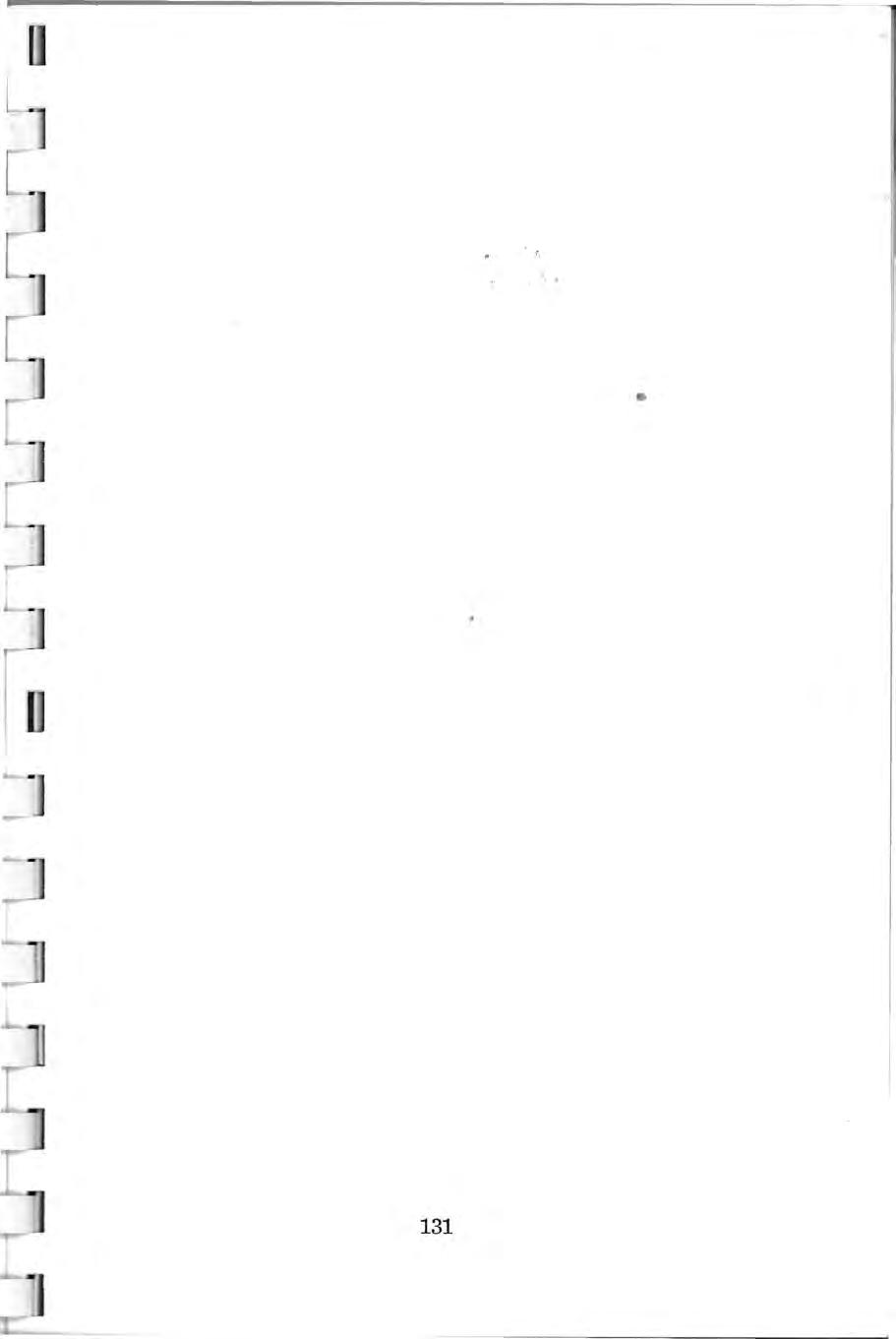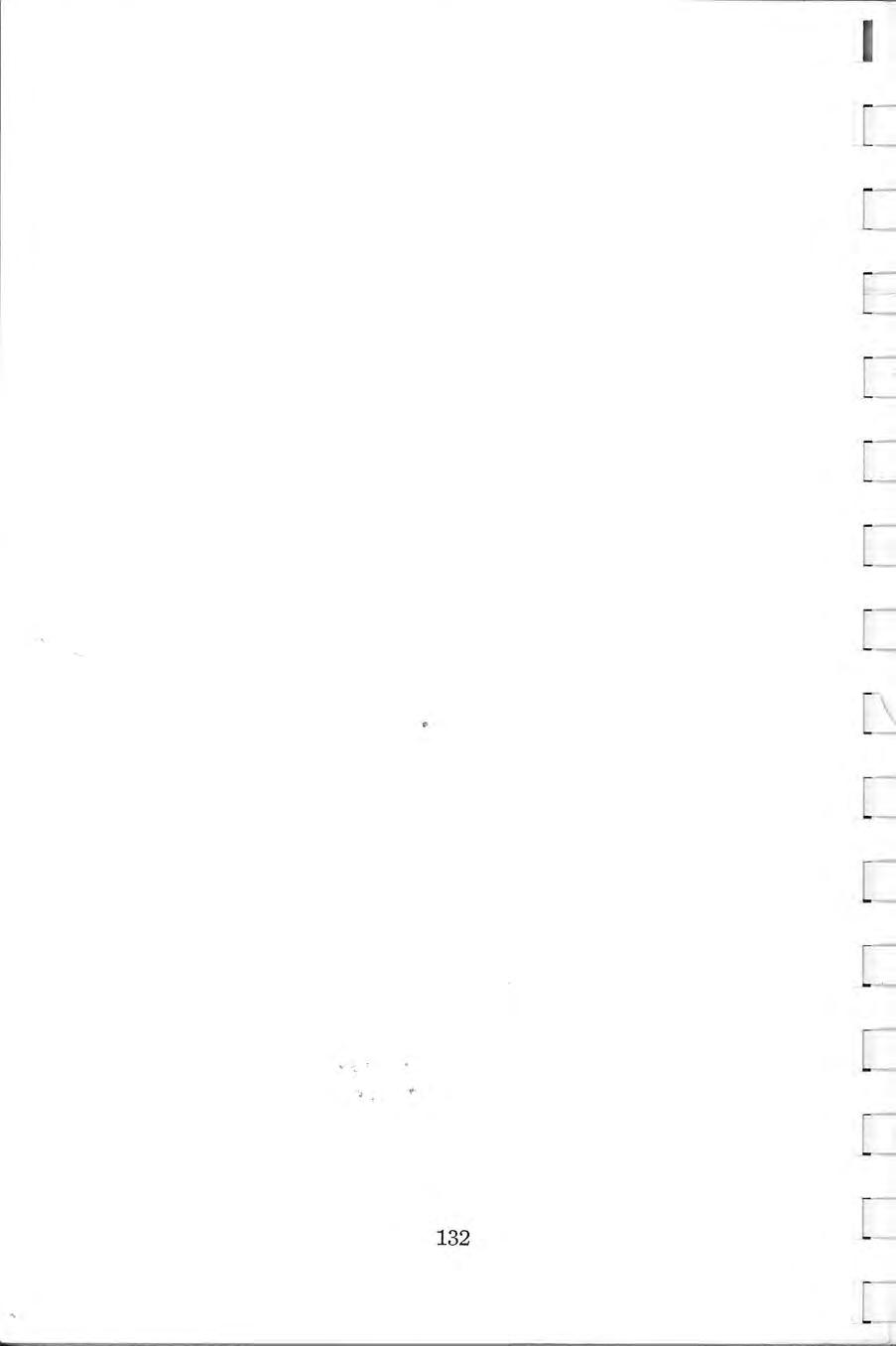pi:��¼�







1. Write Admissions Office for forms.

2. Complete in full and return all forms.
a. Personal application (a $25.00 depo sit and perso picture).
b. Housing reservation (a $25.00 deposit ).
c. Medical record and examination ( o registra • complete until these records are on file ) .
d. Official transcript (high school and if dent, transcripts from all previous co··---·
e. Confidential report.
3. American College Test scores.
The latter two forms are t o be school and college or uni versi
4. Notice of acceptance is sent
and requirements met All the college and not returned.
5. Nebraska high school graauan:~ mester hours (16 units dent applicants are subject Admissions Committee.
qualify for admission on
the General Educational
All tuition and f ees
Arrangemen ts for

Communications for specific information should be directed to the following officers at Peru State College, Peru, Nebraska, 68421:
PRESIDENT-General administrative regulations.
DEAN OF THE COLLEGE-Academic policies, program, schedules and faculty.
REGISTRAR-Admission and registration information; transcripts of credits; examinations for credit; armed forces experience evaluation; graduation and teacher certification requirements; college bulletins.
DEAN OF STUDENTS-Student services; housing for men.
DIRECTOR OF COUNSELING-Vocational and acad emic counseling ; testing.
ASSOCIATE DEAN OF STUDENTS-Housing for women students.
DIRECTOR OF PLACEMENT-Teacher, busines s and industrial placement.

DIRECTOR OF STUDENT TEACHING-Assignment of student teachers.
SPECIAL SERVICES DIRECTOR-Lite_rature on the College; news bureau and photo services; prospective students; alumni publications and services.
BUSINESS MANAGER-Fee payments ; general college finances.
FINANCIAL AIDS OFFICER-Student financial aids; scholarships; loans and employment; veterans' affairs; vo c ational rehabilitation.
As s ociate Professor of Art
Peru State is the oldest college in Nebraska and the third oldest teacher-training institution west of the Missouri river. Peru was established the same year Nebraska became a state. For more than a century thousands of young people have crossed the Campus of a Thousand Oaks and have gone fdrth to become teachers, advisors and friends to countless hundreds ·. of thousands of children throughout Nebraska and the nation.
The people of Nebraska have made the facilities of this College available to you at a minimum of personal cost. The taxpayers of the state bear a major portion of the cost of your college
education exclusive of personal expenses.
Continuing pressures of society have placed a heavy burden upon colleges and universities . Public institutions, such as Peru State, generally have an "open door" admission policy i.e., admit graduates of accredited high schools without special entrance examinations. Peru State believes every young person is entitled to a chance to succeed at the collegiate level, however, this entitlement does not include continuation beyond a reasonable time to the detriment of the student, his peers or the college program We believe a young person of average or above ability coupled with willingnesr; and work has an excellent opportunity for success at Peru State.
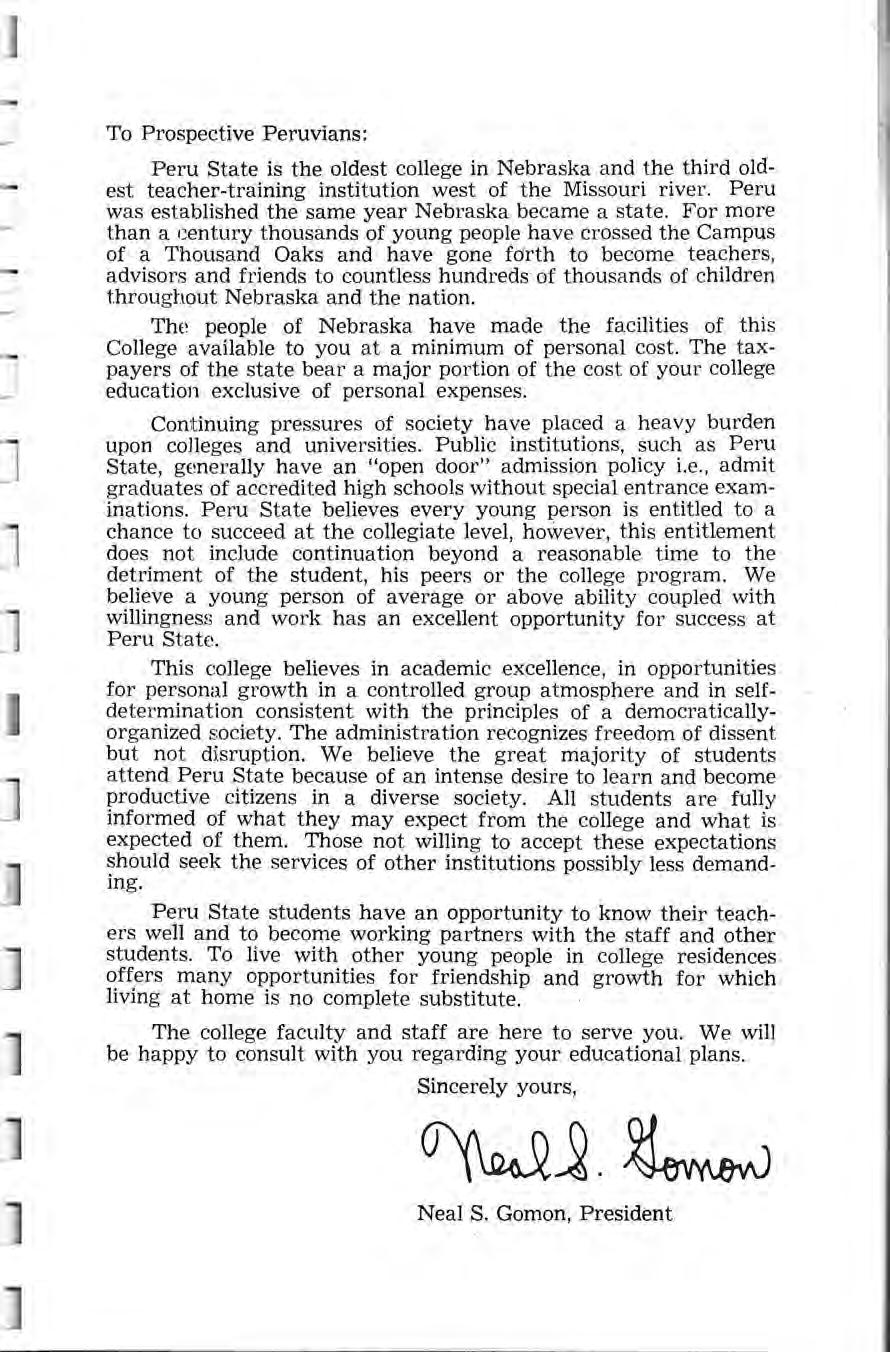
This college believes in academic excellence, in opportunities for personal growth in a controlled group atmosphere and in selfdetermination consistent with the principles of a democraticallyorganized society. The administration recognizes freedom of dissent but not disruption. We believe the great majority of students attend Peru State because of an intense desire to learn and become productive citizens in a diverse society. All students are fully informed of what they may expect from the college and what is expected of them. Those not willing to accept these expectations should seek the services of other institutions possibly less demanding.
Peru State students have an opportunity to know their teachers well and to become working partners with the staff and other students. To live with other young people in college residences offers many opportunities for friendship and growth for which living at home is no complete substitute. •
The college faculty and staff are here to serve you. We will be happy to consult with you regarding your educational plans.
Sincerely yours,
Neal S. Gamon, President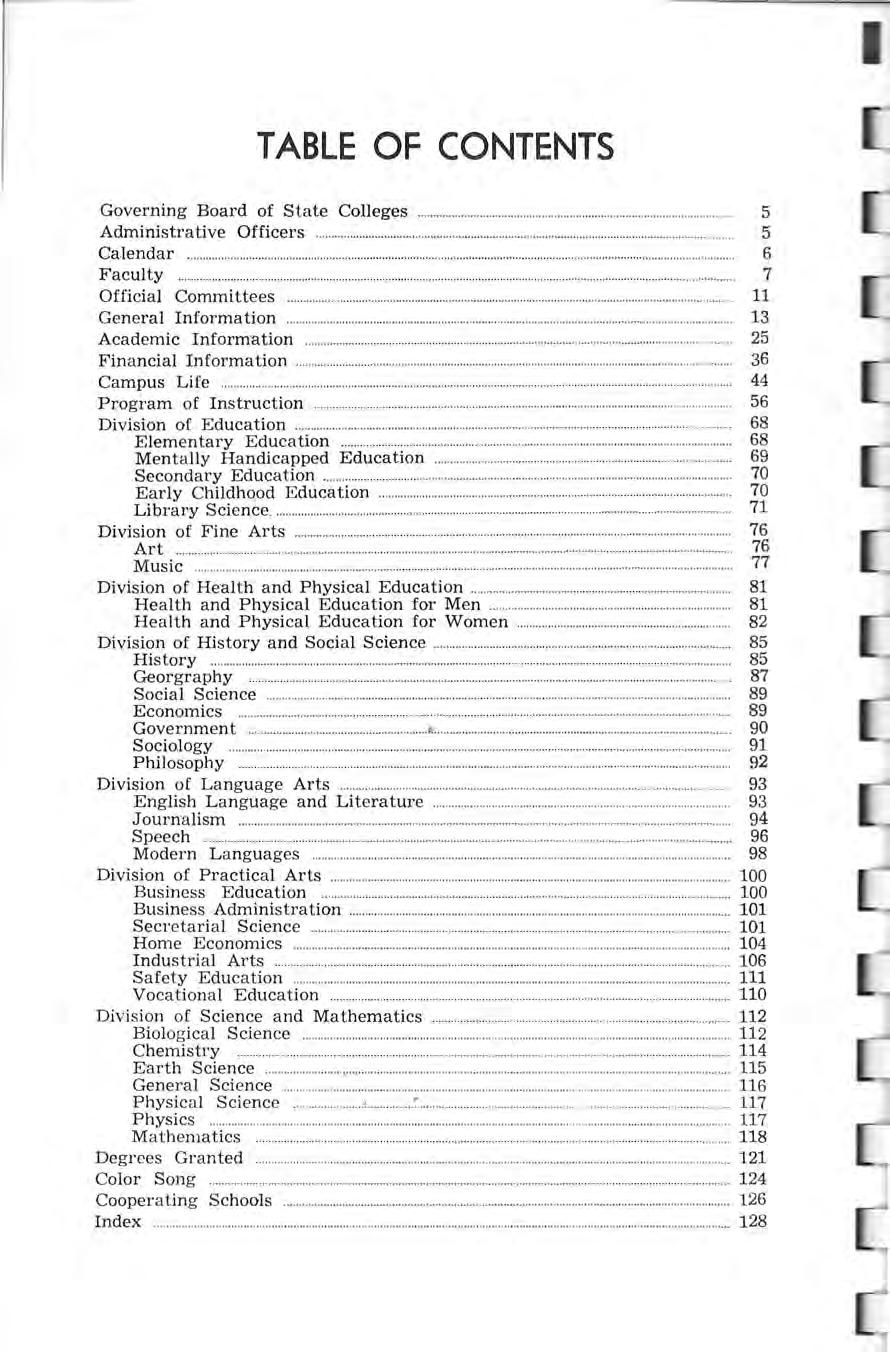
Bernard M. Spencer
James M. Knapp
Francis S . Brown
Henry I. Freed
James A. Lane
J. Alan Cramer


(Date Indicates year In which service at Peru began.)
ALMA ASHLEY (1949) Associate Professor of Elementary Education .
B.S., M .A., University of Nebraska, Lincoln. GradtJale Study, University of Nebraska, Lincoln; Teachers College, Co lumbia Universit'y, NeW York C ity.
KATHRYN AMAYO (1969) . Ins tr.u.ctor of Spanish and French
B.A., P ar k College, Parkville, Missouri. M A., University of Iowa, Iowa City. Graduate Study, University of Iowa, University of Americas , Mexico City.
CLYDE J. BARRETT (1965) Associate Professor of English
B.A., M S Peru State College, Nebrasl<a. Ed D., University of Arkansas, Fayetteville.
ROBERT BOHLKEN (1963) Associate Professor of English .
B.S., Peru State College. M.A., University of Nebraska, Lincoln. Ph.D., University of Kansas, Lawrence.
JUANITA BRADLEY (1956) Associate Dean of Students. Associate Professor of Education .
B.S ., Central Missouri Sta te Co llege, Warrensbur !,, M.A., George Peabody College for Teachers, Nashville, T ennessee. Graduate Study, University of Indiana, Bloo~ington; University of Chicago, Illinois.
ALBERT 0. BRADY (1957) Associate Professor of Biological Science.
B.S., Northern State T eache rs College, Aberdeen, South Dal{ota. M.A. , University of ~South Dal{ota, Vermillion. Graduate Study, Universities: Minnesota, Lake It asca; Southern California, Los Angeles; South Western Louisiana, Lafayette; Oregon, Eugene; North Carolina, Raleigh: Nebraska, Lincoln.

FAYE M. BRANDT (1960) Librarian Associate Professo r of Library Science.
B.A., M.A., Peru State College, Nebraska M. A .L.S., Denver University, Colorado.
EDWARD G. CAMEALY (1960) Associate Professor of Voice Director of College Choir and Orchestra.
B.S., M.S ., University of Illinois, Champaign-Urbana. Graduate Study, University of Colorado, Boulder. Doctorate pending, 1970, University of Colorado, Boulder.
DONALD K. CARLILE (1954) Director of Special Services .
B.S., Kansas State Coll~ge, Manhattan. ·
DONNELL E. CATTLE (1967) Assistant Professor of Industrial Arts
B.S., University of Missouri, Columbia M.Ed., Colorado State University, Ft. Collins. Graduate Study, Illinois State University, Normal.
JOHN C. CHRIST (1946) Head, Division of Science and Mathematics. Professor of Biology.
A.B., North Central College, Naperville, Illinois, M.A. Northwestern University, Evanston, Illinois. Graduate Study, Teachers College, Columbia University, New Yorl{ City; University of Minnesota, Minneapolis; Oregon State University, Corvallis. Ph.D., University of Bari, Bari, Italy.
JOHN W. CLARK (1965) /On leave 1969-70) Assistant Professor of History.
B.A., M A., University of Missouri, Kansas City. Doctorate pending 1970, University of Nebraska, Lincoln.
JERRY R. COX (1966) Assistant Professor of Business Education.
B.S., M.S., Kansas State College, Pittsburgh, Graduate Study, University of Nebraska, Lin co ln
ORA CRAMER (1969) Instructor of Library Science.
B.S., Iowa State University, Ames. sity of Denver, Colorado. Graduate M.A., University of Iowa, Iowa City. M.L.Sc., UniverStudy, C"r eighton University, Omaha, Nebraska.
GAVIN DOUGHTY (1969)
B.M ., M.M., University of Kansas, Lawrence. Advanced piano study with Rudolph Ganz.
TOM J. FITZGERALD (1967)
Head, Division of Fine Arts. Associate Professor of Music. Ph.D., University of Iowa, Iowa City.
Assistant Professor of Physical Education. Assistant Professor of Education
Assistant Football and Head Baseball Coach
B.S., University of Missouri, Columbia M.S., Kansas State Teachers College, Emporia. Graduate Study, Kansas State Teachers College, Emporia and Pittsburg; Univer~ity of Kansas, Lawrence, University of Nebraska, Lincoln.
NEAL S. GOMON (1950)
B.A., M.A ., Ed.D., University of Nebraska, Lincoln.
DAVID A. GUNDERSON (1967) President. Assistant Professor of Business Education.
B.S., Central Missouri State College, Warrensberg. M.B.A , University of Colorado, Boulder. Graduate Study, University of Colorado, Boulder; University of North Dakota, Grand Forks.
JOHN HAHN (1968) Assistant Professor of Political Science.
LL.B. , Chuo Univ ers ity , Tokyo, Jap a n. M.A. University of Minnesota , Minne a polis Doctorate pending, 1971, University of Cincinnati, Ohio.

WREATHEA HICKS (1968) Instructor of English.
A.B , Kansas Wesl eyan University, Salina. M.A., Univer sity of Kansas, L aw rence. M.A Kans as State Teacher s College, Emporia.
STEWART HITCH (1968) Assistant Professor of Art.
B S., M.F.A., University of Nebrasl<a, Lincoln.
LUCY HOVEY (1967) Instructor of Home Economics.
B.S., M . S., Emporia State Te ac hers Co ll ege, Kansas. Graduate Study, Kansas State Teachers College, Emporia and Manhattan.
D . V. JARVIS (1948) 1 Associate Professor of Industrial Arts.
B.A., Peru State Co llege, Nebrasl<a. M.E., Graduate Study, Co lorado State University , Fort Colli ns ; Michigan State University , East Lan s in g .
JOHN L. JENSEN (1969) Assistc)nt Professor of Elementary Education.
B.A , M .A., Co lorado State College, Gree ley. Ed.D., University of Nebraska, Lincoln.
HAROLD JOHNSON (1951) Associate Professor of Ed uc atio n. Director of Placement.
A.B., Peru State College, Nebraslca. Graduate Study, University of North M.A. , Graduate Study, University of Nebraska, Lincoln. Dal<ota, Grand Forl<s.
SAMI A. KALOTI (1967) Assistant Professor of Government and Eco nomi cs.
B A., M.A., M.S Southern Illinois University, Carbo nclale. Graduate Study, Universit y of Kansas, Lawrence.
C JAMES KECK (1966) Assistant Professor of English and Journalism
B.A., Nebraska Christian College, Norfollc. M.A., Fort Hays Kansas State Co ll ege, Hays. Graduate Study, Southern Illinois University, Ca rbondale.
VICTOR N. KINGERY (1967) Assistant Professor of Physics .
B.S., Eastern Illinoi s Univ ersity, C h ar le ston. M S., University of Mississippi, Univ ersity. Graduate Study, University o( Missouri, Rolla. Oalc Ridge Associated Universitie s, Tenne ssee.
LLOYD B. KITE (1960) Professor of Education
B.S ., Mississippi Southern University, Hattiesburg for Te ac hers, Nashville, Tenn essee.
PHIL KNISELL (1969)
Director of Student Teaching .
M.A., Ed.D., George Pe abody College
• Instructor of E n glis h a nd Journalism
B.A., M.A., Graduate Study, University of Ol<lahoma, Norman.
LOUISE KREGEL (1957) Assistant P rofessor of Home Eco nom ics.
B.A., Peru State Co llege, Nebrasl<a. M.S., University of Nebraska, Lincoln. Graduate Study, University of Nebrash:a, Lincoln.
HARLAN KREIN (1969)
Assistant Profes sor of Health and Physical Education .
Assistant Fo otba ll a nd Track Coach.
B.S., M.A., Northern State Teachers College, Aberdeen , So uth Dakota, Graduate Stud y, University of Wyoming, Laramie, University of Denver, Colorado.
PAUL KRUSE ( 1969)
B.S., Ft. H ays Kansas State College, Western Michigan University.
Ref ere nce Librarian . Ass ista n t Professor of Library Science. M S , Emporia State, Kansas Graduate Study
JAMES D. L EVITT (1948) Associat e Professor of Eng.lish and Speech .
B . Ed., Eastern State College, Charleston, Illinoi s. M.A., University of Denver, Colorado. Graduate Study, University of Nebraska, Linco ln.
KELLY LIEWER (1968) Registrar, Director of Admissions.
B.S., Peru State Co llege, Nebrasl<a. M.A., Ed.D., University of Nebraska, Lincoln .
DARYL C. LONG (1967) Assistant Professor of Science a nd Mathematics.
B.S., M.S . , Iowa State University, Ames. Ph .D., University of Nebraska , Lincoln .
JACK McINTIRE (1956) Assistant Professor of Physical Educ a tion . Head Cross Country, Basketball a nd T rac k Coac h
B.S. , M.S. , Peru State C olleg e, N.i, braslrn,, Graduate Study , University of Nebrasl,a , Lin co l n.
LYLE C. McKERCHER (1959) . Associate Professor of Mathematics.
B.S., Morningside College, Sioux City, Iowa. M S., Univer s ity of Iowa, Iowa City, Gradu ate Study. I owa State Co llege, Ames ; University of Georg ia, Athens; University of Nebraska , Lincoln ; University of Souther n Ca liforni a, Los Angeles
KEITH L. MELVIN (1956)
De an of t h e College . Professor of Education.
B A., Peru St ate Co llege , Nebraska. M.A , Ed.D., Univ ers ity of Nebraska , Lincoln.
DONALD MILLER (1969) Dir ector of Financial Aids. Instructor of Educational Psychology.
B.S., M.S., Kansas State University, Manhattan
HANFORD MILLER (1947) • Associate Professor of Chemistry.
B.A., M.A., Co lorado State Co ll ege , Montana State College, Bozeman. Gree ley. Graduate St~dy, Utah State Univ ers ity, Logan;
ROBERT D. MOORE (1937) Head, Division of Langu age Arts. Professor of English and Speech.
B.A., East Central State Teachers Co lleg e, Ada, Oklahoma. M.Ph , University of Wisconsin, Madison Graduate Study, University of Iowa, Iowa City; Co lorado State College, Greeley.
JOE PELISEK (1965) Assistant Prof essor of Physical Education. Head Footba ll Coach.
B.A., Corne ll College, Mt. Vernon , Iowa. M.A., New Mexico Highlands University , L as Vegas , New Mexico . Graduate Study, University of I owa, Iowa City: University of South Dalcota, Vermillion; Univer sity of Nebraslca, Lincoln. Kansas State Univ ersity, Manhattan. ERVIN R. PITTS (1964) H ea d, Division of Health and Physical Education. Director of Athletics. Professor of Heal th and Physic a l Education.
B.S , M.E., Ed.D., University of Missouri, Columbia. Head Golf Coach.
GUY L. ROSENBERG (1966) Dean of Students. Associate Professor of Psychology.
B.S., M.S., Western Illinois University, Macomb. Ph.D , Univer s ity of Iow a, Iowa City.
FRIEDA D ROWOLDT (1952) Assistant Professor of Business Education.
B.A , Wayne State College , Nebraska, M.A., University of Nebraska, Lincoln. Graduate Study, University of Nebraska, Lincoln.
LESTER RUSSELL (1956) Professor of Industrial Arts .
B.A , Peru State College, Nebrasl<.a. M.A., li1niversity of Minnesota, Minneapolis Graduate Study, University of Nebraska, Lincoln. Ed.D., University of Nebraska, Lincoln.
BONNIE B. RUTZ (1965) Assistant Professor of Physical Education.
B S., Peru State College, Nebraska. M.A., Uni vers ity of Nebraska, Lin co ln
*ROGER SALMELA (1968) Assist ant Professor of History.
B.A., M.A., University of Minnesota, Minneapolis. Graduate Study, St. Cloud State Co llege , Minnesota; University of Nebraslca at Omaha.
THOMAS SCHERER (1969) Director of Counseling and Testing. Assistant Professor of Education.
B.A ., M S , Central Missouri St a te College, Warrensburg. Ph.D., University of Wyoming, Laramie
GEORGE SCHOTTENHAMEL (1957) Head , Division of History and Social Sciences. Professor of History and Social Sciences.
B.A., North Central College, Naperville, Illinois . M.A ., in History, M.A. , In Education, Ph.D., University of Ill ino is, Urb ana.
REX R. SHELLEY (1967)
Head, Division of Education. Associate Professor of Education.
B .S., Colorado State University , Fort Collins. M.A., Ed D. , Univer sity of Denver, Colorado.
LELAND H. SHERWOOD (1963)
B.A., Peru State Co llege, Nebr aska. M.A , University p e nding , 1970, Indian a Univer si t y, Blooming ton

Associat e Professor of Art. of Wyoming , l'.,aramie. Doctorate 1'
ALAN F. SHIPLEY (1966) Acting Business Manager.
B S., Peru St ate College, N e br as l<a
C. VERNON SIEGNER (1961)
Head, Division of Practical Arts Professor of Industrial Arts.
B .A., Central Washington State College, Ellensberg . M.S., Or ego n State University, Corva llis. Graduate Study, Bradley University , Peoria. Illinois , Ed.D., Colorado State Co ll ege , Greeley: · Post Doctorate, Colorado State University, Ft. Collins.
BALWANT SINGH (1969)
Associate Professor of Educational · Psychology .
B.A., and B.Ed , Panjab University, Indi a. M.Ed., University of Raj as th an, India. M.A., University of London , England. Ed.D., University of Toronto, Canada.
JERO ME D. STEMPER (1950)
Associate Professor of Physical Education.
Director, Intramur a l Athletics
B.A., Kearney State College, Nebraska. M.A., University of Nebraska, Lincoln. Graduate Study, University of Nebraska, Lincoln; Peru State College, Nebrasl<a.
LYLE G. STROM (1959)
Associate Prof ess or of Social Science s.
B.A , Morningside Co llege, Sioux C ity, Iowa. M.A. , Dral{e University, Des Moines, Iowa. Graduate Study, University of Nebrasl\a, Lincoln.
SILAS E. SUMMERS (1960)
Associate Professor of English.
B.A., Western State College, Gunnison, Colorado M.A., University of Missouri, Columbia. Graduate Study, Uni ve rsit y of Iowa, Iowa City; University of Oregon, Eugene; Western State Coll ege. Gunnison, Colo rado.
EVAN S. VAN ZANT (1961)
Associate Professor of Education
Instructional Media Director
B.A., Nebraska Ce ntral College, Ce ntral City. M.A., University of Nehraslrn. Lin co ln Graduate Study, University of Nehrasl<a, Lincoln.
SCOTT J. WILLIAMS (1966)
Assistant Professor of Geography.
B.S , M.A., Graduate Study, Arizona State University, Tempe Doctorate pending, 1971. University of Nebraska, Lincoln.

GILBERT E. WILSON (1957)
Associate Professor of Instrumental Music. Director of Coll ege Band .
B.S., Southeast Missouri State College, Ca pe Girardeau. M.M., Vandercool{ Co lleg e of Music , Chicago, Illinois D.M.A., University of Missouri, Kansas City
MARY RUTH WILSON (1966) Assistant Professor of English and Speech.
B.S., Southeast Missouri State, Cape Girardeau. M .A. , Peru State College, Nebr as l{ a. Graduate Study, University of Nebraska, Lincoln. DARRELL yVININGER (1952)
B.S., M.S.. Kansas State Teachers College, Greeley. *Filling leave of absence 1969-70.
Director of Federal Programs
Professor of Business. Head Tennis Coach
P ittsburgh. Ed. D., Colorado State College.
NONA PALMER (1915-1950)
Professor of Commerce
NELLIE M. CAREY (1944-1957) Librarian.
PHYLLIS DAVIDSON (1929-1957) Professor of Women's Physical Education.
EDNA WEARE (1929-1957)
A. V. LARSON (1926-1958)
Professor of Home Economics.
Professor of Industrial Arts.
L. B. MATHEWS (1927-1961) Professor of Physics.
VICTOR H. JINDRA (1923-1961) Professor of Music .
GEORGE RATH (1946-1961) Professor of Foreign Languages .
RUTH S. BROWN (1943-1961) Professor of Education.
GEORGE R. DEVORE (1921-1962) Custodian
MARY CLARKE (1951-1964)
Assistant Professor of Education
STACY VANCE (1920 -1964), ., Superintendent of Buildings and Grounds.
ROBERT T. BENFORD (1926--1965) Associate Professor of Piano and Organ .
ALFRED G. WHEELER (1938~1965) ' Professor of Health and
HAROLD 0. BORAAS (1951-1966)
NORMA L. DIDDEL (1929-1966)
IIAZEL WEARE (1943-1966)
Physical Education
Professor of Educational Psychology. Professor of Art. Professor of Business Education.
The Administrative Council inclu des Administrative officers, the Division Heads and Faculty · Assdciation representatives . It enacts policies through its own initiative and / or through the recommendations of various committees.
The committee is essentially advisory to the Dean of the College in the area of instruction and program. The committee carries on a continuous study of the curriculum, all related aspects and is concerned with interdivisional coordination and relationships. It also recommends and carries out, to a limited extent, institutional studies and evaluates the college program in terms ·of various accrediting agency guides and standards. The committee has no administrative function or authority but recommends policies to the Administrative Council. Membership includes the Division Heads, Librarian, Registrar, Dean of the College and a student representative.

The committee has the responsibility of studying and making recommendations concerning new buildings, renovation of present buildings and the overall planning of the campus. Such planning will consider long-range plans in terms of purposes and program. Membership includes the President, Superintendent of Buildings and Grounds, Dean of the College and representatives from the areas most directly concerned.
The committee is responsible for the placement of all events on the college calendar. It will evaluate the distribution of events and activities in their relationship to the total college program. All calendar events are to be scheduled through the committee chairman.
The Graduate Council establishes policies and regulations governing all phases of the graduate program. Membership includes one representative from each of the divisions with the exception of the Division of Education which has two. The President, Dean of the College and the Director of Counseling are ex-officio members.
The committee is composed of the Librarian and a faculty representative from each of the divisions. The committee establishes policies with respect to the Library, makes suggestions related to the Library budget and recommends Library purchases
The committee is composed of one faculty representative from each of the seven divisions under the chairmanship of the Head of the Division of Education. The committee has the responsibility for: (1) coordination of the total teacher education program; (2) initiation of experimentation and / or innovative practices; (3) evaluation of existing practices, and (4) selection and retention. The committee recommends policy to the Administrative Council.
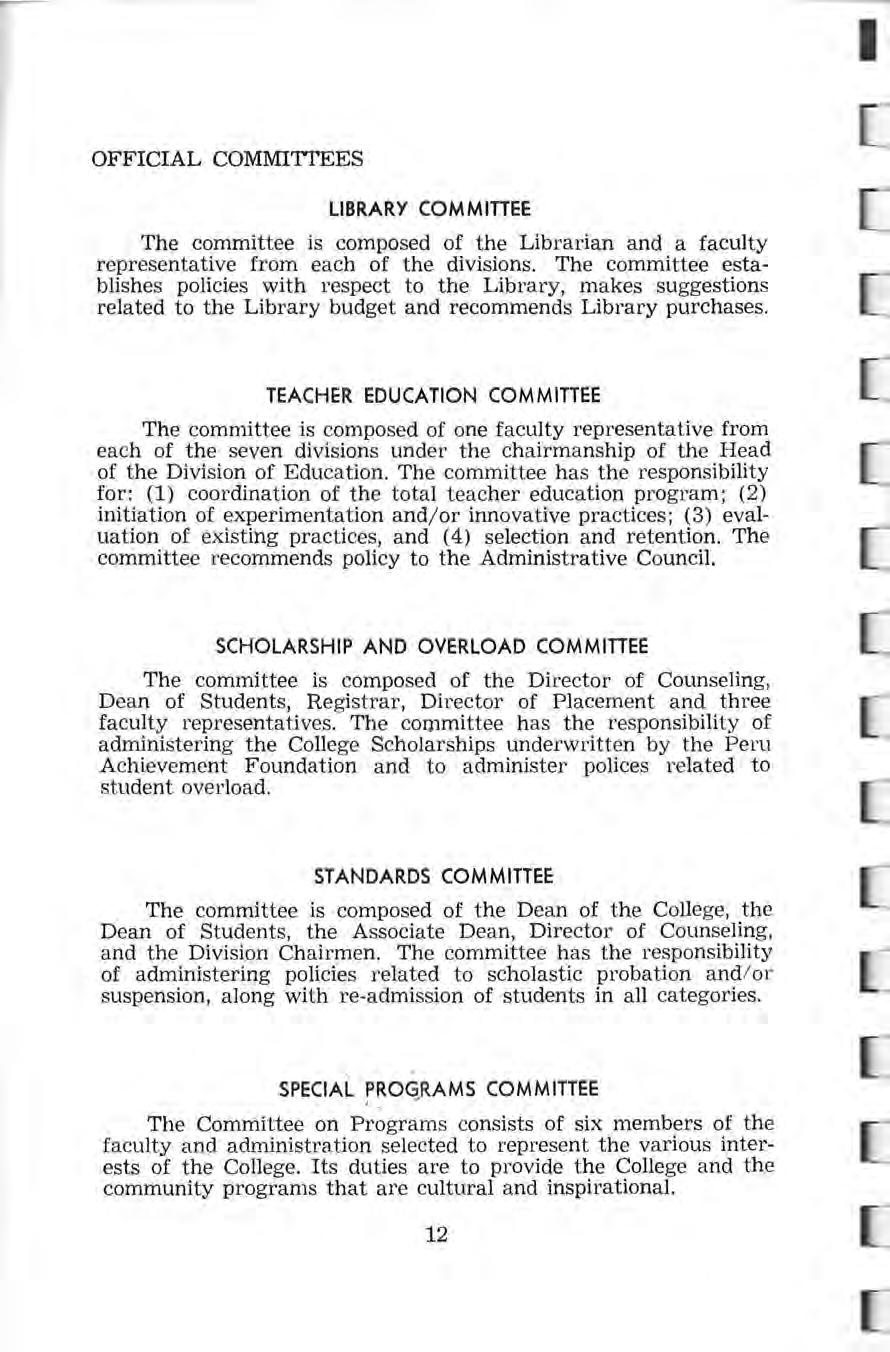
The committee is composed of the Director of Counseling, De an of Students, Registrar, Director of Placement and three faculty representatives. The committee has the responsibility of administering the College Scholarships underwritten by the Peru Achievement Foundation and to administer polices related to student overload
The committee is composed of the Dean of the College, the Dean of Students, the Associate Dean, Director of Counseling, and the Division Chairmen. The committee has the responsibility of administering policies related to scholastic probation and / or suspension, along with re-admission of students in all categories.
The Committee on Program s consists of six members of the faculty and administration selected to represent the various interests of the College. Its duties are to provide the College and the community programs that are cultural and inspirational.
The same year Nebraska became a state, the new state legislature provided for the establishment of a training school for teachers or normal school at Peru. A~ that time only two other such institutions existed west of the Missburi River--one in Kansas and one in California. The school's beginning actually dates back to December 2, 1865, when its predecessor institution, Mount Vernon College, was organized by a group of early settlers who resolved to place the school under the "care and management of the Methodist Episcopal Church."
After the church declined the offer, Col. T . J. Majors, a leader in the War Between the States and a state legislator, proposed that the school be made the state university. Although the offer was rejected, the state legislature on June 20, 1867, did accept the school as a "normal school" several months before the state university was established. For 38 years after the Peru school became a normal school, it was the only teacher education institution in the state.
As Nebraska's population increased, the legislature provided for three other normal schools-at Kearney in 1905, at Wayne in 1910 and at Chadron in 1911. The legislature extended the normal schools from two years to four in 1921 and authorized these institutions to grant the degrees of Bachelor of Arts in Education, Bachelor of Science in Education and Bachelor of Fine Arts in Education. At the sarrie time, the names of the schools were changed from State Normal Schools to State Teachers Colleges. In 1963 the name was changed to Peru State College.
When the United States entered World War II, the College offered its staff and facilities to the government for the training of officers for the armed forces. The first unit of men in the Navy V-12 program arrived on July 1, 1943 . During the time the nearly 500 trainees received college training, the College operated on an accelerated program for both civilian students and naval trainees. Since that time many of these trainees have used the hours of college credit earned at Peru for degree requirements at Peru or other institutions of higher learning throughout the nation.
In 1949, the legislature authorized the Nebraska State Colleges to confer the Bachelor of Arts degree. The Bachelor of Science degree was authorized in 1965.

Nebraska's first College has been guided through the years by these presidents:
1867-1871- J. M. McKenzie
1871-1871- Henry H. Straight
1871-1872- A. D. Williams
1872-1874- T. J Morgan
1874-1875- Azel Freeman
1875-1877- S. R. Thomp so n
1877-1883- Robert Curry
1883-1893- G. E. Farnham
1893-1896- A. W. Norton
1896-1900- James A. Beattie
1900-1904- A. W. Cl a rk
1904-1910- J. W . Crabtree
1910-1918- D. W Hayes
1918-1921- E. L . Rouse
1921-1923- A. L. Caviness
1923- 1946- W R. P ate
1946-1950- W. L. Nicholas
1950-1951- Wayne 0. Reed
1951- - Neal S. Gomon
Seat of Nebraska's oldest institution of higher education is historic Peru (population 1150) in the hills along the Missouri River in the southeast corner of the state. The picturesque Nemaha county town is 62 miles south of Omaha and 75 miles southeast of Lincoln. Peru is served by Nebraska Highway 67 which intersects U. S. Highway 73 and 75 six miles west of the campus. Auburn , county seat of Nemaha County, is five miles south, and Nebraska City, Otoe county seat, is 15 miles north of the junction of these highways. The Campus of a Thousand Oak s is on approximately the same latitude as New York City and is about 150 mil es east of the center of continental United States. About 80 per cent of Peru' s students come from Nebraska, with adjacent states well represented. Students from more distant states are also enrolled at Peru.
Daily bus service to Omaha, Lincoln , Kansas City, Topeka , with connections in those cities to more distant points, is available at Auburn, 12 miles from Peru. Persons wanting transportation from Peru to Auburn can usually find rides with students and faculty members. Students arriving in Auburn at the opening of a semester or summer session may secure transportation by informing the Director of Special Serviees in advance of arrival. College transportation will be provided to and from Auburn only at the beginning or end of a semester or summer session. Taxi service is also available through the Auburn Hotel.
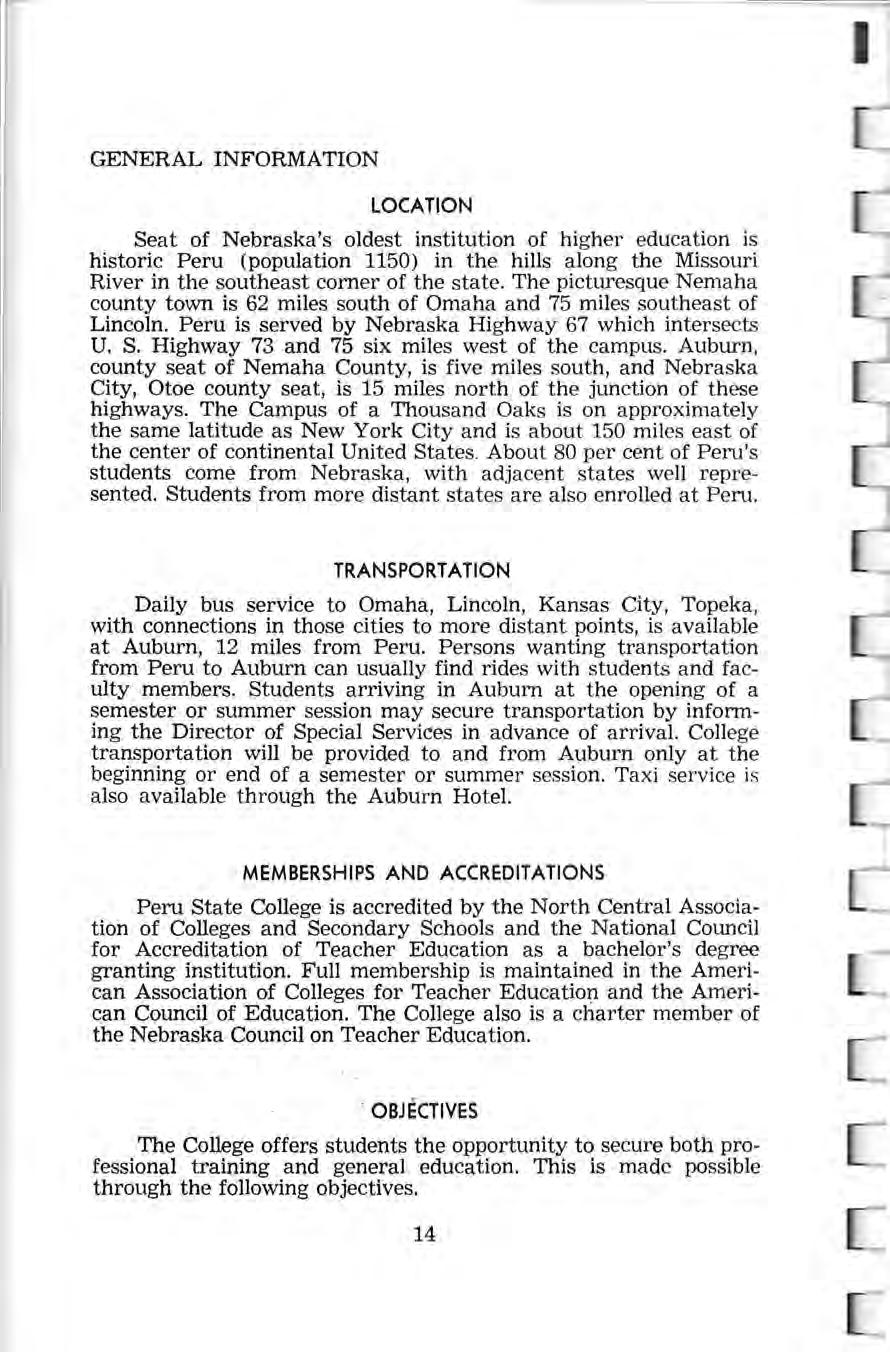
Peru State College is accredited by the North Central Association of Colleges and Secondary Schools and the National Council for Accreditation of Teacher Education as a bachelor's de gree granting institution. Full membership is maintained in the American Association of Colleges for Teacher Education and the American Council of Education. The College also is a charter member of the Nebraska Council on Teacher Education .
The College offers students the opportunity to secure both professional training and general education. This is made possible through the following objectives.

The staff believes that general education should:
1. Promote the student's understanding of his rights, privileges and responsibilities of part'icipation and leadership in a democratic society.
2. Encourage intellectual curiosity.
3. Increase the student's ability to apply abstract knowledge to particular and concrete situations.
4. Provide the opportunity to understand his interaction with his physical environment.
5. Provide the opportunity to attain emotional and social adjustment.
6. Increase the student's ability to read and listen with critical comprehension.
7. Increase his ability to convey ideas, feelings and / or experiences to others with clarity.
8. Encourage the growth of sound physical and mental health on the part of the student ~
9. Provide the opportunity to establish educational and vocational goals .
10. Encourage the growth of desirable leisure-time activities.
11. Encourage the growth of moral and spiritual values.
The staff believes that the teacher education program should:
1. Provide the opportunity for the student to become familiar with the material available for instructional purposes.
2. Provide an opportunity for the student to acquire adequate knowledge of subject matter, to develop skill in methods and techniques in teaching.
3. Improve the student's understanding of how children grow, develop and learn.
4. Encourage self-evaluation and improvement on the part of the student with regard to the criteria for successful teaching.
5. Develop an understanding and acceptance of responsibility toward the ethics of the teaching profession.
6. Develop a philosophy of education compatible with a democratic society.

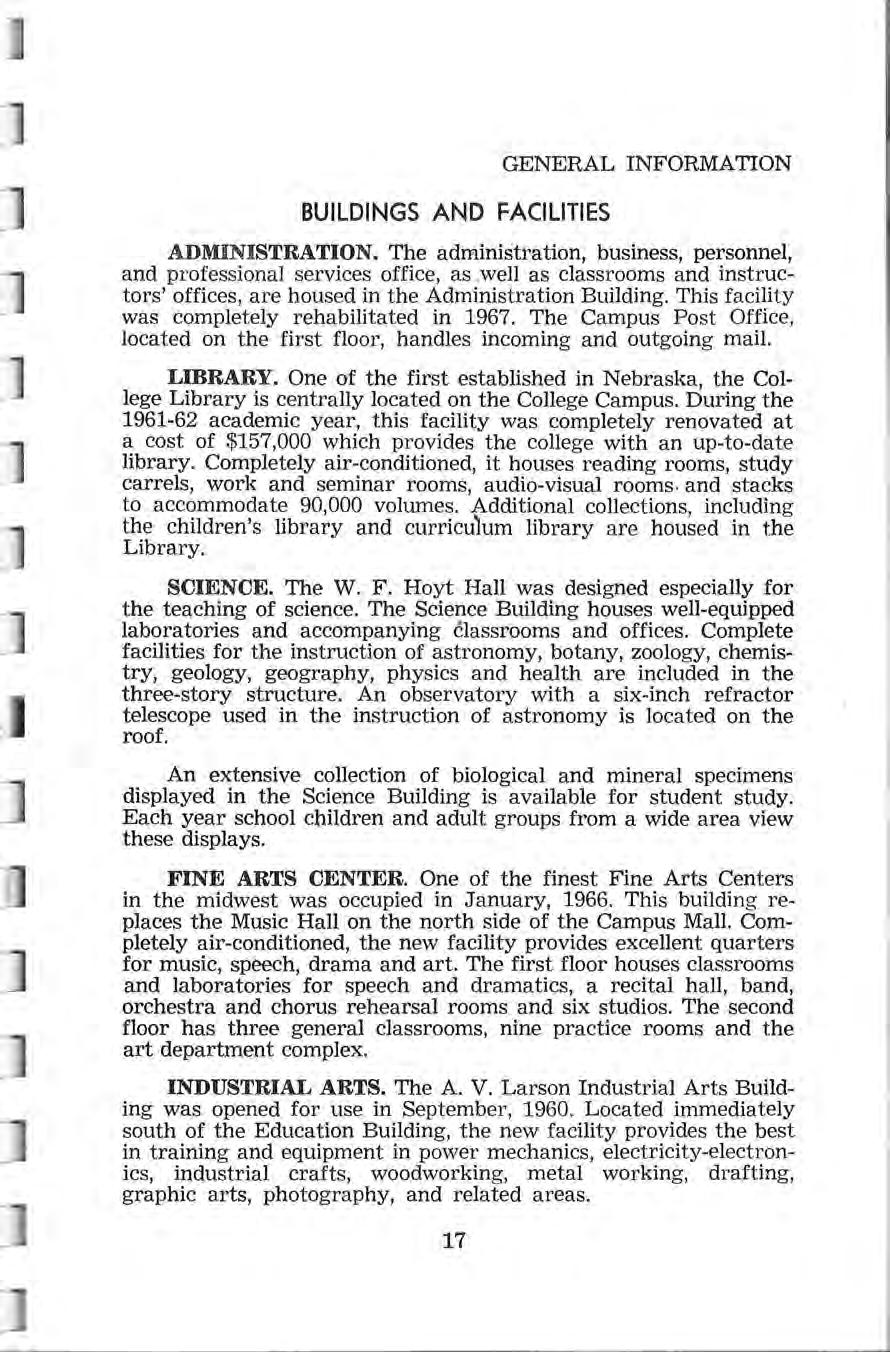
ADMI NISTRATION. The administration, business, personnel, and p r ofessional services office, as .well as classrooms and instructors' offices, are housed in the Administration Building. This facility was completely rehabilitated in 1967. The Campus Post Office, located on the first floor, handles incoming and outgoing mail.
LIBRARY. One of the first established in Nebraska, the College Library is centrally located on the College Campus. During the 1961-62 academic year, this facility was completely renovated at a cost of $157,000 which provides the college with an up-to-date library. Completely air-conditioned, it houses reading rooms, study carrels, work and seminar rooms, audio-visual rooms, and stacks to accommodate 90,000 volumes. Additional collections, including the children's library and curricu)um library are housed in the Library.
SCIENCE. The W. F. Hoyt Hall was designed especially for the teaching of science. The Science Building houses well-equipped laboratories and accompanying classrooms and offices. Complete facilities for the instruction of astronomy, botany, zoology, chemistry, geology, geography, physics and health are included in the three-story structure. An observatory with a six-inch refractor ·telescope used in the instruction of astronomy is located on the roof.
An extensive collection of biological and mineral specimens displayed in the Science Building is available for student study. Each year school cbildren and adult groups from a wide area view these displays.
FINE ARTS CENTER. One of the finest Fine Arts Centers in the midwest was occupied in January, 1966 . This building replaces the Music Hall on the north side of the Campus Mall . Completely air-conditioned, the new facility provides excellent quarters for music, speech, drama and art. The first floor houses classrooms and laboratories for speech and dramatics, a recital hall, band, orchestra and chorus rehearsal rooms and six studios. The second floor has three general classrooms, nine practice rooms and the art department complex.
INDUSTRIAL ARTS. The A. V. Larson Industrial Arts Building was opened for use in September, 1960 Located immediately south of the Education Building, the new facility provides the best in training and equipment in power mechanics, electricity-electronics, industrial crafts, woodworking, metal working, drafting, graphic arts, photography, and related areas.
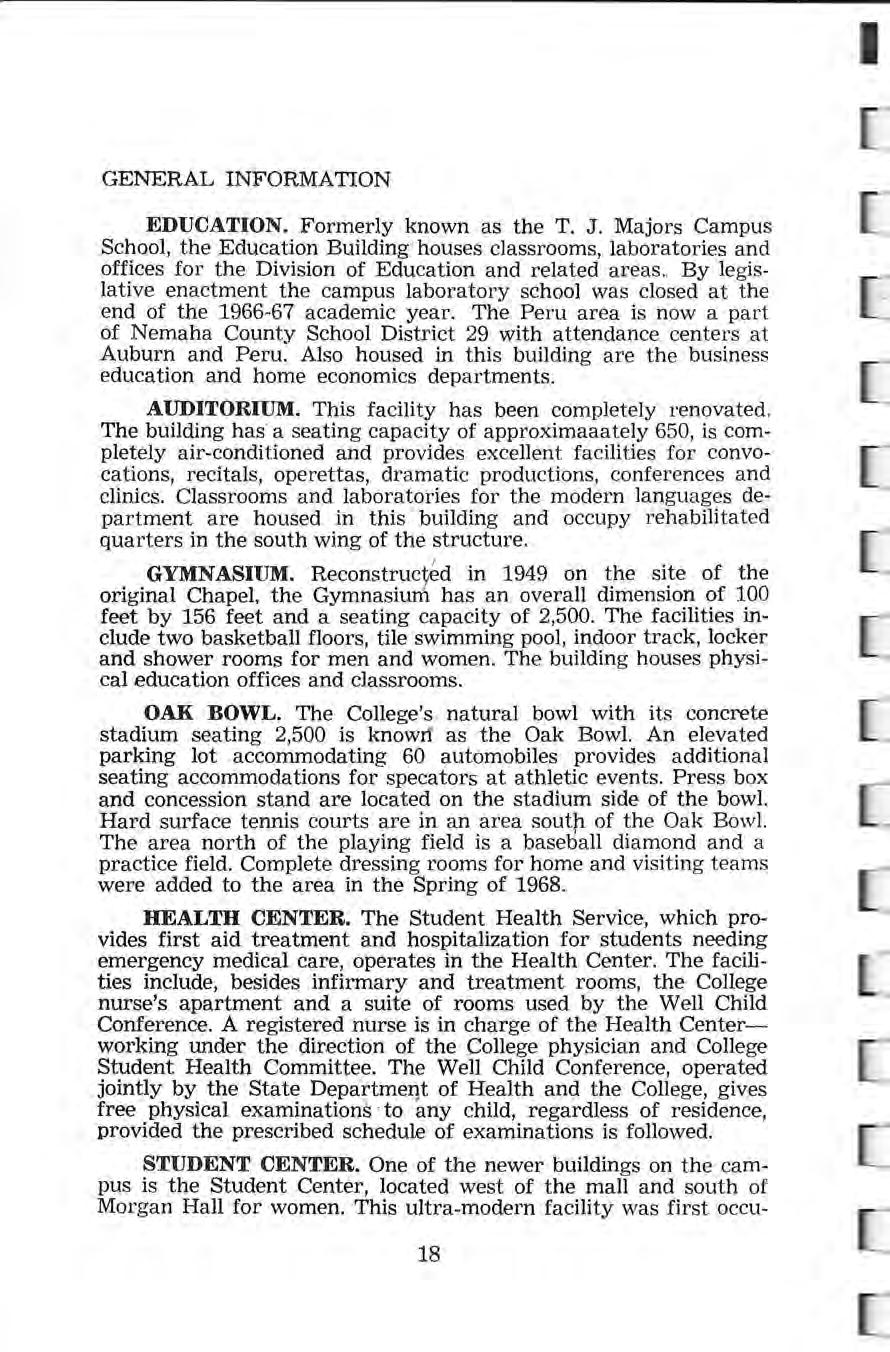
EDUCATION. Formerly known as the T. J. Majors Campus School , the Education Building houses classrooms, laboratories and offices for the Division of Education and related areas. By le gislative enactment the campus laboratory school was closed at the end of the 1966 -67 academic year. The Peru area is now a part of Nemaha County School District 29 with attendance centers at Auburn and Peru. Also housed in this building are the busines s education and home economics departments.
AUDITORIUM. This facility has been completely renovated. The building has a seating capacity of approximaaately 650, is completely air -conditioned and provides excellent facilities for convocation s , recitals, operettas , dramatic productions, conferences and clinics . Classrooms and laboratories for the modern languages department are housed in this building and occupy rehabilitat ed quarters in the south wing of the structure.
GYMNASIUM. Reconstruc ye d in 1949 on the site of the original Chapel, the Gymnasium has an overall dimension of 100 feet by 156 feet and a seating capacity of 2,500. The facilities include two basketball floors, tile swimming pool, indoor track, locker and shower rooms for men and women . The building houses physical education offices and classrooms.
OAK BOWL. The College's natural bowl with its concrete stadium seating 2,500 is knowrf as the Oak Bowl. An elevated parking lot accommodating 60 automobiles provides additional seating accommodations for specators at athletic events . Press box and concession stand are located on the stadium side of the bowl. Hard surface tennis courts are in an area soutp of the Oak Bowl. The area north of the playing field is a baseball diamond and a practice field. Complete dressing rooms for home and visiting team s were added to the area in the Spring of 1968.
HEALTH CENTER. The Student Health Service, which provides first aid treatment and hospitalization for students needing emergency medical care, operates in the Health Center. The facilities include, besides infirmary and treatment rooms, the College nurse's apartment and a suite of rooms used by the Well Child Conference. A registered nurse is in charge of the Health Centerworking under the direction of the ,College physician and College Student Health Committee . The Well Child Conference, operated jointly by the State Department of Health and the College, gives free physical examination§ ·to any child, regardless of residence , provided the prescribed schedule of examinations is followed.
STUDENT CENTER. One of the newe r buildin gs on the campus is the Student Center, located west of the mall and south of Morgan Hall for women. This ultra -modern facility was first occu-
pied in January, 1961 with additional dining and service facilities opened in the fall of 1965. The split-level building houses the main dining room, small dining rooms arid meeting rooms, a commodious lounge, a faculty room, cloak and rest rooms on the upper floor ; a g ame room, bookstore, rest rooms and the snack bar on the lower floor The building is completely air-conditioned.
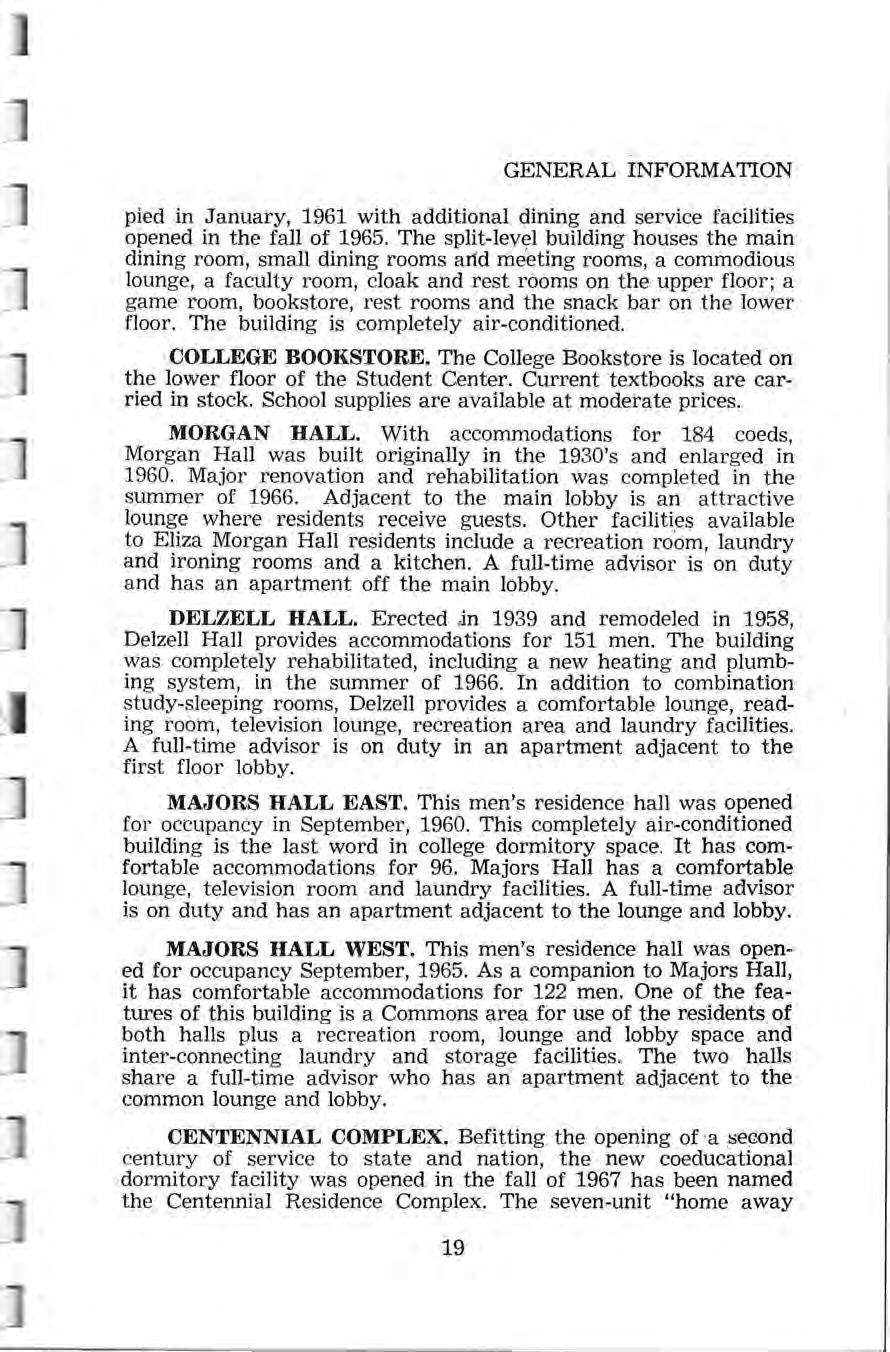
COLLEGE BOOKSTORE. The College Bookstore is located on the lower floor of the Student Center. Current textbooks are carried in stock. School supplies are available at moderate prices.
MORGAN HALL. With accommodations for 184 coeds, Morgan Hall was built originally in the 1930's and enlarg ed in 1960. Major renovation and rehabilitation was completed in the summer of 1966. Adjacent to the main lobby is an attractive lounge where residents receive guests. Other facilities available to Eliza Morgan Hall residents include a recreation room, laundry and ironing rooms and a kitchen. A full-time advisor is on duty and has an apartment off the main lobby.
DELZELL HALL. Erected .i n 1939 and remodeled in 1958, Delzell Hall provides accommodations for 151 men. The building was completely rehabilitated, including a new heating and plumbing system, in the summer of 1966. In addition to combination study-sleeping rooms, Delzell provides a comfortable loung e, readin g room, television loung e, recreation area and laundry facilities. A full-time advisor is on duty in an apartment adjacent to the first floor lobby.
MAJORS HALL EAST. This men's residence hall was opened for occupancy in September, 1960. This completely air-conditioned building is the last word in college dormitory space. It has comfortable accommodations for 96. Majors Hall has a comfortable lounge, television room and laundry facilities. A full-time advisor is on duty and has an apartment adjacent to the lounge and lobby.
MAJORS HALL WEST. This men's residence hall was opened for occupancy September, 1965. As a companion to Majors Hall, it has comfortable accommodations for 122 men. One of the features of this building is a Commons area for use of the residents of both halls plus a recreation room, lounge and lobby space and inter-connecting laundry and storage facilities. The two halls share a full-time advisor who has an apartment adjacent to the common lounge and lobby . ·
CENTENNIAL COMPLEX. Befitting the opening of ·a second century of service to state and nation, the new coeducational dormitory facility was opened in the fall of 1967 has been named the Centennial Residence Complex. The seven-unit "home away
from home" is the last word in student housing, incorporating features most conducive to study, rest and wholesome group living. Almost a community in itself, the Complex houses 342 students in six structures, each designed for efficiency and comfort.
DAVIDSON and PALMER HALLS, interconnected by a covered breezeway, houses women students. Clayburn and Mathews Halls, similarly interconnected, is men's residence hall. Each pair of buildings has quarters for a resident advisor, relief advisor, parlor, recreation area, laundry, storage room, TV lounge and commons area. Students are housed in suites to accomodate four or six persons. Each suite has two or three bedrooms, a carpeted living room and a full bath. Each bedroom is equipped with twin beds , ample closet and drawer space, study tables and chairs. Living rooms are equipped with davenports, lounge chairs, reading tables and lamps for study and/or relaxation.
The entire Complex is served by a common food service facility, housed in a centrally-located, separate building. Although not presently provided, space in the building is available for future expansion of recreational facilities as funds become available.
MARRIED STUDENT HOUSING. Five housing units for married students were completed for occupancy September 1, 1956. These housing units are located in a park-like setting east of the Oak Bowl. Two units contain (our two-bedroom apartments and three contain two one-bedroom apartments. A stove, refrigerator, automatic washer and dryer are furnished in each apartment. The apartments are heated by gas.
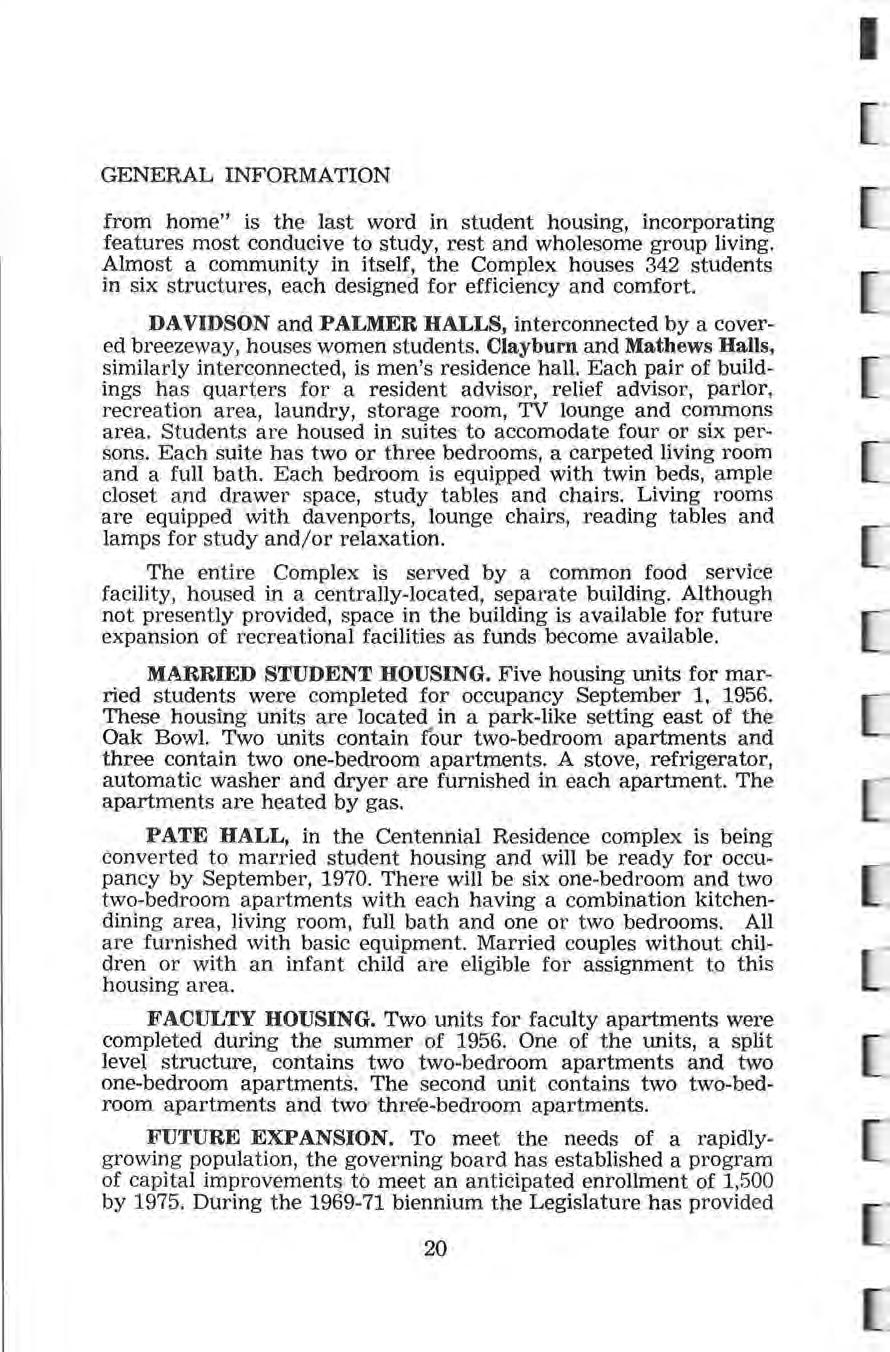
PATE HALL, in the Centennial Residence complex is being converted to married student housing and will be ready for occupancy by September, 1970. There will be six one-bedroom and two two-bedroom apartments with each having a combination kitchendining area, living room, full bath and one or two bedrooms. All are furnished with basic equipment. Married couples without children or with an infant child are eligible for assignment to this housing area.
FACULTY HOUSING. Two units for faculty apartments were completed during the summer of 1956. One of the units, a split level structure, contains ~wo . two-bedroom apartments and two one-bedroom apartments. · The second unit contains two two-bedroom apartments and two· thre e-bedroom apartments.
FUTURE EXPANSION. To meet the needs of a rapidlygrowing population , the governing board has established a program of capital improvement~: to meet an anticipated enrollment of 1,500 by 1975. During the 1969-71 biennium the Legislature has provid ed
funds for remodeling and renovation of the Science Hall and upgrading of the fire safety system. Future plans include a new physical education and health fat!ility ' · for men and women, an addition to the Library , remodeling and · renovating the Education Building including the busi ness education and home economics departments, installation of the first phase of a central air-conditioning plant, additional stadium seating and further development of recreational areas.
Abbreviations for campus buildings are used frequently in listing rooms for class and organization meetings. The first of the three-digit numbers used with the building abbreviation indicates the floor, and the second and third are the room number on that floor. For example, Ad 101 would be room number one on the first floor of the Administration Building.
A-Auditorium
Ad-Administration Building
ED-Education Building
FA-Fine Arts Center
G-Gymnasium
RC-Health Center
IA- Industrial Arts
L--Library
S-Science Building
SC- Student Center
Peru Alumni Association . membership includes all graduates and former students of Peru State College. Each academic year, luncheons, receptions and reunions are sponsored. Local alumni chapters, organized in Omaha and Lincoln in 1955, in Denver in 1957, in Berkeley, Calif ., in 1958, and in Los Angeles in 1961, sponsor activities in their areas with the assistance of the alumni office. The 50-year class reunion, a tradition at Commencement time, and the 25-year class reunion at Homecoming have been arranged through the alumni office for many years. In 1969, reunions were planned for the 60 and 70-year classes at Commencement, and a 40-year reunion at Homecoming in addition to the traditional reunions. At homecoming special invitations a re extended to all classes of five-year intervals.
The Alumni Association Executive Council, elected during Homecoming week end, is the advisory board for the executive secretary of the Peru Alumni Association. Present members, elected October 11, 1969, include:
President ............ .. ..... ... .... .... .............. Monty L . Allgood, '63, Omaha
First Vice President .... .... .. ............... Gary Schmucker, '65, Exeter
Second Vice-President Jan Beemer DeMott, '65, Bedford, Ia.
Secretary Thomas B. Yopp, '65, Plattsmouth
Treasurer ................... ..Nancy Carr Dickerson, '62, Nebraska City

Immediate past officers (1968-69) are Charles Stoner, '67, Auburn, president; Nancy Jarvis, '67, Portland, Ore., first vicepresident; Karon Rathe Estes, '66, Cook, second vice-president ; LaVerna Roos Sayer, '61, Springfield, secretary; Lucille Russell Hicks, '60, Auburn, treasurer.
Presidents of local alumni chapters are: Omaha, Ernest E . Robinson, '49, Council Bluffs, Iowa; Lincoln, Curtis D . Sederburg , '54, Lincoln; Rocky Mountain, Patricia Benford Bornemeier, '52 , Greeley, Colo.;Northern California, Gerald Clayburn, '49, Brentwood, Calif.; Southern California, Paul W. Hertz, '29, Claremont , Calif.
The Alumni Office. Located in the Services Building south of the Administration building, the office maintains a file of all students and graduates. Degree and diploma recipients are listed by classes as well as alphabetically and geographically. A collection of yearbooks, commencement programs, and alumni publications is housed in the alumni office. The office cooperates with the Library in maintenance of archival materials in the special collections room of the Library.
The Peru Stater. The College publishes The Peru Stater which is distributed in November and May to alumni, former students , faculty members and friends of the College. The staff of special services edits the publication.

As a result of the work of a group of alumni, the Peru Achievement Foundation was organized in June, 1955, and incorporated as a non-profit corporation for educational and charitable purposes May 21, 1962.
Organized for the promotion and support of Peru State College, the Foundation has as its primary purpose: "to aid, assist and promote the educational program, faculty, employees, students , and to encourage the attendance ... of worthy and deservin g students, and to grant scholarships and student loans to deservin g students."
This purpose is accomplished through the solicitation and acceptance of "gifts, grants, devises and bequests of real or personal property, or both, and to hold, administer, use and dispose of the same, both principal and income ... " from alumni and friends of the College. · ,
Since the beginning in · 1955, the Peru Achievement Foundation has provided scholarships; administered scholarships for various organizations, individuals and groups; furnished all matching funds for the National Defense Student Loan Program; provided for the furnishings of the small dining room in the Student Center ;
assisted with the presentation of information concerning the College to the legislature and in other _ways promoted the College.
Various graduating classes and other organizations have presented gifts to the College in the form of memorials. An early-day Peru group, the Fortnightly Art Club, contributed a frieze, statuary and other works of art. A statue of Horace l\fann, housed in the Auditorium with the gifts of the Fortnightly Art Club, was given by the class of 1898. The class of 1903 contributed the clock in the Alumni Office. A picture of the Shaw Memorial was the gift of the class of 1908. The campus lighting system was presented by the class of 1914, and the brick portals at the north entrance to the campus were contributed by the class of 1915. The sun dial and fountain in the formal garden east of the Administra'tion Building were the gifts of the classes of 1920 and 1929, respectively, and the walks from the campus to the Oak Bowl were given by the class of 1924. The bell system was presented to the College by the classes of 1927, 1928 and 1930 and the Philomathean Literary Society. The fans in the Auditorium were the gifts of the classes of 1931, 1932, 1933, 1934 and 1935. The drinking fountain in the Science Building was given by the class of 1936. The class of 1961 contributed an oil painting by Leland Sherwood, '57, a member _ of the Peru faculty, for the television room of the Student Center. The classes of 1962 and 1963 provided the brick wall and sign at the south entrance to the campus. Other classes have made contributions to the College Loan Fund and to the Peru Achievement Foundation.
Nebraska's oldest college library, the Peru State Library, is considered one of the best collections in the state. The facilities include approximately 88,000 volumes, including standard reference works, periodical guides and indexes, and special collections. Three hundred eighty-five periodicals are received regularly by subscription, with a large number bound for permanency. Besides current materials, valuable older material, including a number of complete bound periodicals dating back to the mid-1800's are available. The Library subscribes to metropolitan newspapers and many weekly Nebraska newspapers.

In addition, the Library receiyes publications of the U. S. Office of Education and is a depository for publications of other governmental agencies. Children's library and curriculum library collections are housed in the Library.
Teacher Placement. Peru State College maintains a central
office for the confidential recommendations of students and alumni. Each candidate is urged to provide personal information and recommendations that will assist him in securing a desirable position. This information is made available to prospective employers without cost.
Business and Industrial Placement. Assistance is given students in finding full time .employment in business, industry, and governmental services. Company literature is on file providing information on organizations of particular interest to the student. Every effort is made to bring together the student seeking employment and the prospective employer.

Sample letters of inquiry, letters of application, personal data resume sheets, etc., are available to assist the candidates. A fee of ten dollars is charged for Placement Services for a period of one year. This includes the sending of the credential file upon request as well as the use of the vacancy listings which are issued periodically.
Employment interviews are often held on campus for the convenience of students. The Placement Office maintains a library of occupational information.
Well Child Conference. Any child, from six weeks to six years, regardless of residence, whose parents will bring the child for regularly-scheduled examinations, is eligible to attend the Well Child Conference at the College. The clinic, the first and third Tuesdays of each month, is conducted by the College in cooperation with the State Department of Health. Details of the program may be obtained by writing the Well Child Conference, Peru State College, Peru, Nebraska 68421. ·
Conferences and Clinics. Nearly every month during the academic year, the College is host to various conferences and clinics for high school and adult education groups. The College offers its facilities to these groups in an effort to make the institution serve the educational needs of the entire community which the College serves. In recent years music clinics for high school choral groups, bands and individual instrumentalists; clinics in speech and dramatics; business and industrial conferences and meetings of fraternal and civic groups; women's social and educational organizations; and special interest groups, have been held on the campus.
Speakers and Entertainment Services. S9hools, civic and educational ·organizations ar.e invited to make use of speakers and entertainment made available through the College. Faculty members are available to speak throughout the year, as well as for commencement addresses in high schools. Musical and dramatic programs, demonstrations, debates and lectures also may be arranged through the College .
Students seeking admission to. the ,College should write to the Registrar for the official forms. All parts of these forms must be completed and returned not later than ·four weeks prior to the beginning of the term for which admission is sought. Failure to meet this deadline will cause a delay in registration with the subsequent problems related to the student obtaining the most appropriate class schedule. High school seniors are advised to make application for admission at the close of seven semesters of high school study. In this case if all conditions are not satisfactorily met, the applicant will be given provisional admission. It is the responsibility of the applicant to request a supplementary transcript of the eighth semester's credit to be sent , to the Admissions Office. Failur.e to do so may result in denial of admission Non-resident applicants are subject to policies administered by the Admissions Committee.

Application for admission procedure requires the following forms: (1) Personal application for admission along with a recent photo and $25.00 fee which will apply on the tuition. (2) A $25.00 room reservation fee. These fees will be refunded only to applicants denied admission. (3) Student medical record and medical examination. ( 4) Official transcript, high school as well as any previous college or university attended. (5) Confidential report. The latter two forms are to be sent directly from the high school and the college or university. All admission materials are held by the College and are not returned. No registration is complete until these records are on file.
The American College Test is required of all students seeking admission to Peru State College. This test is given at numerous centers throughout the United States. (Information regarding the availability of this test may be obtained by writing to the American College Testing Program, P. 0. Box 168, Iowa City, Iowa, 52240). Your guidance counselor may also provide information concerning the nearest testing center. Also, the test is given at announced intervals on this campus. It is advisable for a student to take the test at his earliest opportunity. ·
Full Admission. Nebraska high school graduates · may receive full admission to freshman standing with a minimum of 160 high school semester hours (16 units) from a four-year high school and the recommendation of the high school principal or superintendent. Although no specific distribution of entrance units is necessary, it is recommended that at least half of the units earned repres ent work in English, foreign language, mathematics, natural science and social sciences.
Conditional Admission. Students who have 150 high school
semester homs (15 units) or the equivalent for high school graduation, are admitted to freshman standing on condition that their work proves satisfactory during the first year in college. Appropriate college comses may be recommended in fields where the student is deficient upon admission. Matme individuals, who are not high school graduates, who are otherwise prepared and recommended for college work, may be admitted as special students. A college aptitude test and the G E D (General Education Development) tests may be administered in judging the individual's qualification for admission.
Advanced Standing. This implies attainment beyond the minimum for admission to the College. This status may be acquired by (1) presenting work completed in another college; (2) demonstrating proficiency in a certain field, thus removing the requirement of certain prerequisites. The latter may be with or without credit.

Applicants for admission from other colleges must, in addition to submitting the formal application, request each college to send an official transcript and evidence of dismissal in good standing. Only credits with grades of "C" (equivalent) and higher are accepted in transfer. Students seeking admission while under probation at the last college attended will, if accepted, be placed on probation for one semester and subject to all policies of probation in this College. Students under suspension at another college or university will not be considered •for admission until the suspension period has expired and all facts related to the suspension are known . Failure to list on the application all colleges previously attended will be cause for dismissal.
A maximum of 66 semester hours applicable toward a degree based on 125 hours, will be accepted from applicants transferring from a junior college. ·
Readmission. Students whose progress toward graduation wa s interrupted during a semester or at the close of a semester s hall apply for readmission at least two weeks prior to the term ·1or which he plans to enroll. An admission fee of $25.00 must accompany the application. If readmission is approved, the fee will be applied on tuition when the student enrolls. The fee will be refunded if readmission is denied . Forms are available throu g h the Registrar's Office.
Peru State College will acc ept only credit with "C" or higher grade in each course submitted for transfer. This condition applies also to credit earned on any interim basis at another college while essentially a student at Peru State College. ·
Admission from non-accredited colleges. Applicants transferring to Peru State College from a non-accredited college must meet all requirements of a first time ·student. Each application must be accompanied with an official transcript of all previous credit sent to the office of admission. Credits earned at nonaccredited institutions will be accepted on a provisional basis . This credit is to be validated upon satisfactory completion of 30 semester hours of degree credit at Peru State College.

A veteran of the armed forces who has received an honorable discharge from active duty will be granted credit for his military experiences in accordance with the recommendations of the American Council on Education.
Private instruction is available in art, music and speech. Music students will receive private instruction without charge, in relation to their field of concentration. Other students will pay rate per lesson as listed in Financial !Flformation section of catalog.
Evening College Courses. The College makes available in a Wednesday evening program such course offerings as seem most beneficial in meeting the needs of students who are interested. Each semester these evening classes meet once a week for seventeen weeks. Each course is usually evaluated at three hours of college credit. The two nightly sessions start at 5:00 p.m. and 7:45 p.m.
Day students interested in night classes should consult with the Dean of the College.
Off-Campus Courses. Off-campus courses are made available at study center sites within the geographical service area of the College. The best practice in organizing a study center class is to work through the office of the County Superintendent of Schools. The courses which are available depend upon priority of requests and the available instructional personnel. Such information is publicized by county school superintendents and by direct mail at the beginning of each semester. Undergraduate credit only is offered.
The ten-week summer session is divided into two five-week terms which makes it possible for a stude nt to earn a maximum of twelve semester hours of credit, six hours in each term. For the most part, the program will be of special interest to teachers. Beginning courses will be available which make it possible for a
recent high school graduate to enter college. Copies of the summer school bulletin may be secured from the Registrar.
Graduate Program. Graduate courses will be offered in the summer session for purposes of certification and / or transfer. If a student wishes to transfer credit, prior approval should be secured from the graduate school to which the credit is to be transferred. The program of studies will include elementary education, secondary education and supervision. Detailed information may be obtained by writing the Dean of the College.
College credit is expressed in terms of the semester hour, which represents the satisfactory completion of one hour of class attendance per week for dhe semester (18 weeks). The work may include any type of activity prescribed in the course-classroom work, preparation , laboratory or shop work, etc.
Students having earned less than 30 semester hours of credit are classified as freshmen; 30 to 59 hours as sophomores; 60 to 89 hours as juniors; and 90 to 125 hours as seniors. Degree students earning additional undergraduate credit are classified as post graduate students.
Students enrolling in the College, register for courses corresponding to their classification ('freshman, sophomore, etc.) unless advised to do otherwise. Courses numbered 1-99 are unclassified and open to all students. Courses numbered 100-199 are for freshmen; 200-299 for sophomores; 300-399 for juniors; 400-499 for seniors; 400G-499G for graduates and seniors; 500-599 for graduates.
The normal class load for a full time student is 12 to 16 semester hours. The maximum load without special permission is 17 hours. Students with a grade point average of 7.00 for the previous semester may apply to the Registrar for one additional hour making a total of eighteen. An excess of eighteen hours must be approved by the Overload Committee. Students with a G.P.A. of less than 7.00 the previous semester must apply to the Overload Committee for an excess of seventeen hours.
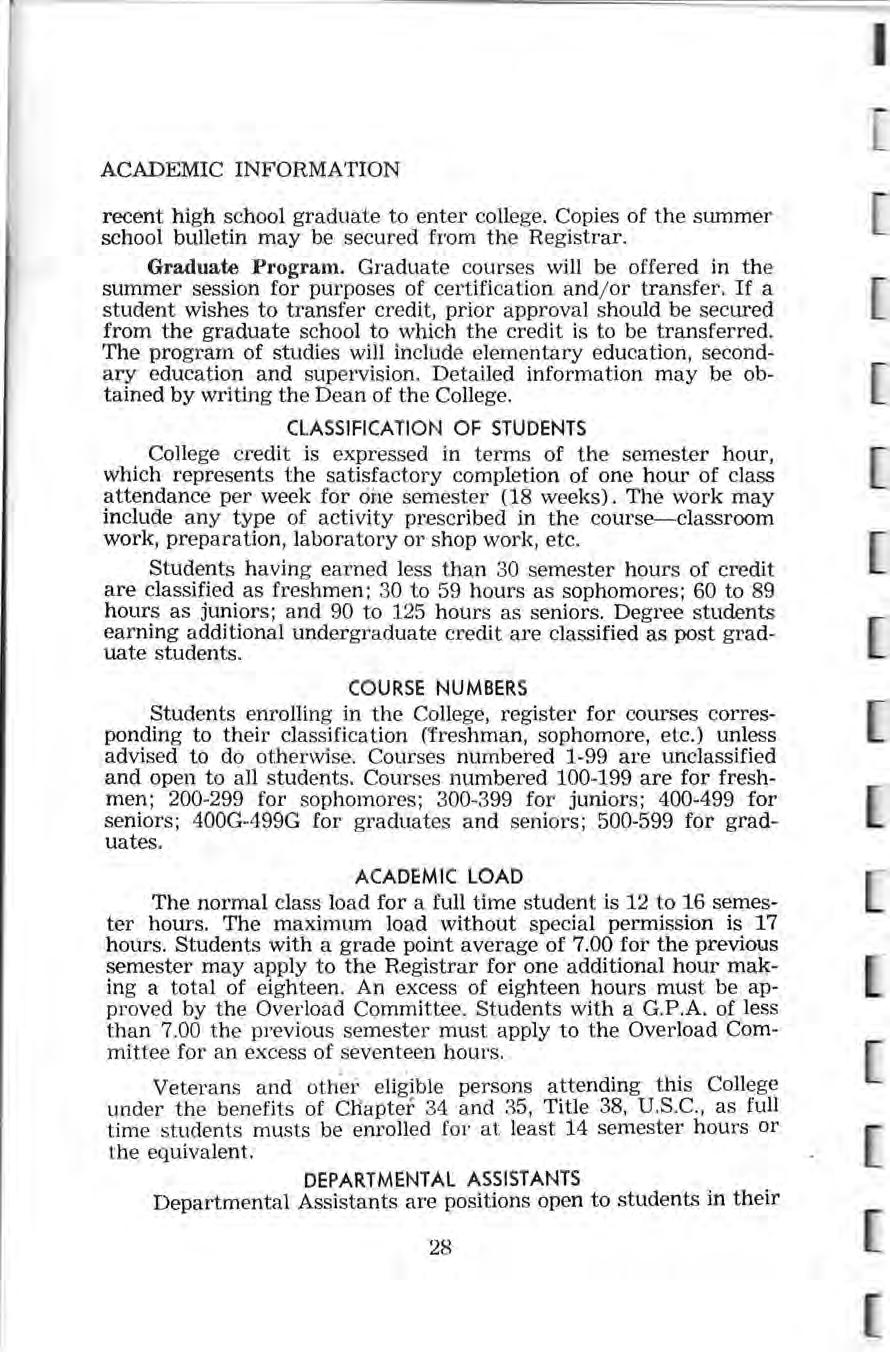
Veterans and othe1\ . eligible persons attending this College under the benefits of Cliapter 34 and 35, Title 38, U.S .C., as full time students musts be enrolled for at least 14 semester hours or the equivalent.
Departmental Assistants are positions open to students in their
field of concentration. Generally these positions are intended for students who will enter graduate study directly upon graduation from Peru. . ,.
As an Assistant, the student assists with preparation, administration and evaluation of tests in lower ·di vision classes; and assists with various other classroom activities.
The position of Departmental Assistant carries no hours of credit. However, the experience is recognized by being placed upon the student's permanent record.
Students are expected to attend classes regularly, arrive punctually and do all assi gned work in each class. The student agrees to this when he registers for a course. Attendance is a privilege and a responsibility represented not only by the student's investment but also by a considerable investment by the State.
Whenever absences or other elements of scholastic attitude reach the point of being detrimental (regardless of cause) to the student's standing in class and/ or the success of the class as a whole, the instructor may confer with the student and advise the Dean of Students. The instructor and the student may mutually agree that the registration in the course should be cancelled or the instructor may issue the student a "scholastic alert". Future conferences for the same or related reasons, most likely will resultin the student being dropped from the class. If the student requests, the Dean of Students may be asked to participate in the decision. The above is the only sanction as far as excessive absences and/or other elements of scholastic attitude are concerned .
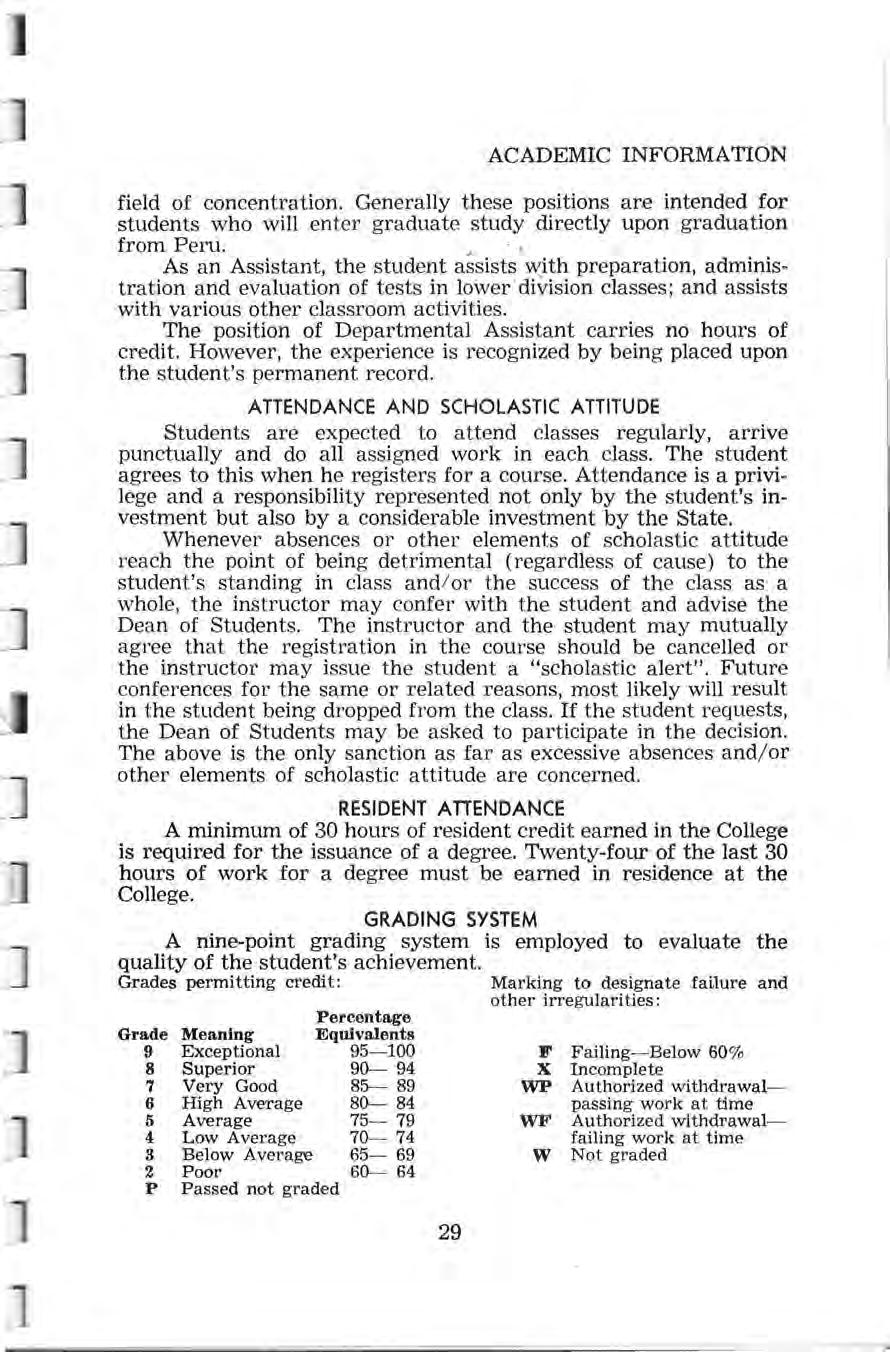
A minimum of 30 hours of resident credit earned in the College is required for the issuance of a degree. Twenty-four of the last 30 hours of work for a degree must be earned in residence at the College.
A nine-point grading system is employed to evaluate the quality of the student's achievement.
Grades permitting credit: Marking to designate fai.lure and other irregularities:
The grades in numbers indicate the value of each semester hour of credit and also become the means for calculating the student's grade point average (GPA) to compare with scholarship standards. Students are urged to calculate their own GPA from time to time and realize their own status The following two examples will be valuable in understanding the calculations:
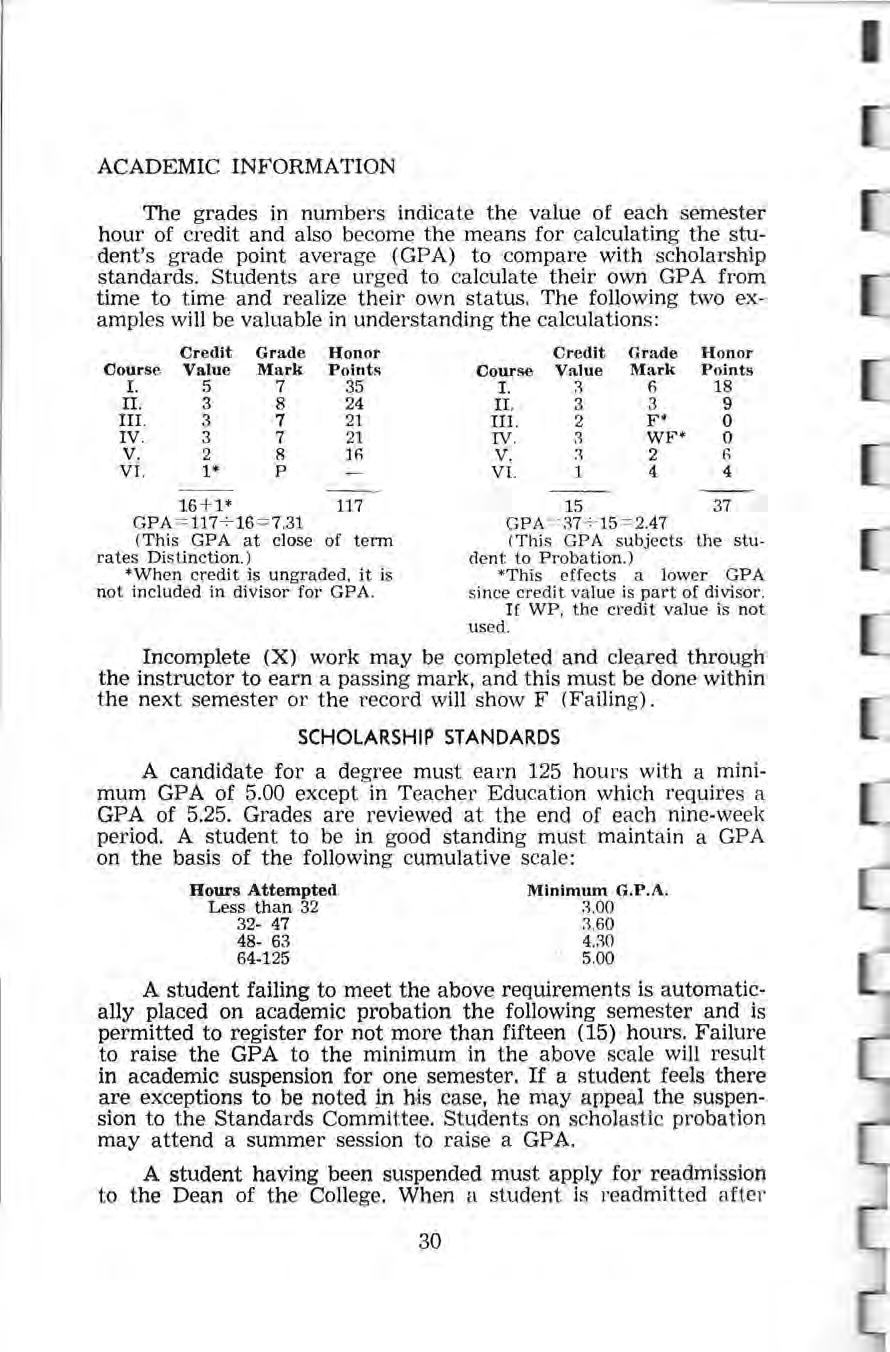
Grade Honor
3 7 21
3 7 21
2 8 1f,
16+1* 117
GPA = ll7 + 16 = 7.31
(This GPA at close of term rates Di s tinction.)
*When credit is ungraded, it is not included in divisor for GPA.
Grade Honor
GPA 0-= 37 + 15 = 2.47
37
(This GPA subj e cts the student to Probation . )
*This e ff e cts a low e r GP A s ince credit value is part of divisor
If WP , the credit v a lue is not used .
Incomplete (X) work may be completed and cleared through the instructor to earn a passing mark, and this must be done within the next semester or the record will show F (Failing).
A candidate for a degree must earn 125 hours with a minimum GPA of 5.00 except in Teacher Education which requires a GPA of 5.25. Grades are reviewed at the end of each nine-week period. A student to be in good standing must maintain a GP A on the basis of the following cumulative scale:
A student failing to meet the above requirements is automatically placed on academic probation the following semester and is permitted to register for not more than fifteen (15) hours. Failure to raise the GPA to the minimum in the above scale will result in academic suspension for one semester. If a student feels there are exceptions to be noted in hJs case, he may appeal the suspension to the Standards Committee. Students on scholasti c probation may attend a summer session to raise a GPA.
A student having been suspended must apply for readmission to the Dean of the College. When a student is readmitted afte r
a period of suspension, he must show satisfactory progress to avoid permanent suspension.
A transfer student who was suspen,~ed from the College last attended will not be admitted until the suspension period has expired When admitted, the student will be on probation for one semester . A transfer student under probation from the previous college will likewise be admitted on probation for one semester. In both cases, the maximum load will be fifteen semester hours. The conditions for removal of the probation are the same as those which apply to all other students.
Teacher Preparation. In addition to employing counseling procedures to guard against unproductive educational programs, the College maintains fixed minimum standards of schola,rship for teacher-preparation curriculums.
Students, who by reason of experience and / or personal improvement, may qualify for credit in lower division courses through the procedure of an interview and a written examination. The student must, through an interview, satisfy a faculty committee that he has had a formal or informal experience whereby the course content may have been acquired. If the committee feels the above conditions have been met, the student will be given a written comprehensive examination .

The amount of credit to be allowed; the course for which substitution, if any, is made; and the particular graduation requirements, which may be satisfied, will be determined by the division head and his committee and will be subject to all genera l graduation requirements .
The student must register for the course and pay the tuition charges before writing the examinations.
A student may and is urged to repeat any course in which he has failed. There may be occasions when a student chooses to repeat a course purely for review, to be taken on an audit basis, without a change of grade.
Honors courses are available for those students who meet the scholastic requirements. Further details may be obtained from the respective division chairman .
The accuracy of each registration as related to class periods, sections, days and other possible conflicts is the responsibility of the student. Also, the ultimate responsibility for the meeting of all requirements rests with the student. In the event a change in program is unavoidable following a registration, the student must secure the approval of the advisor and the instructor. No courses may be added after two weeks. When applicable, a refund will be made. A fee of $3.00 is collected for any change after the fifth day of classes.
A student finding it necessary to withdraw from a class at any time must secure the permission of the advisor and instructor. Students withdrawing without official approval will be graded "F".
An official withdrawal in the first six weeks of a semester or the first week of a summer session will be recorded as "W" on the permanent record. A withdrawal between the sixth and twelfth week will be graded "WP" (Withdrawn Passing) or "WF" (Withdrawn Failing). A withdrawal after twelve weeks will be graded "F" except in extenuating circumstances or under conditions beyond the student's control. An instructor may recommend that a student withdraw from a class because of absences and / or other reasons.

If it is necessary for a student to withdraw from college, he secures the appropriate form from the Director of Counseling. This form must be presented to various members of the faculty for their signatures. The withdrawal form is filed in the Registrar's Office. The reimbursement of fees is made from the Business Office according to the refund schedule.
Graduation honors are conferred on bachelor's degree candidates who have earned at least 60 hours in this College. The work of eight semesters or the equivalent will be considered in the grade point average. The scholastic requirements are as follows: ·
At the end of each semester the Dean of the College publishes the names of students who have earned a grade point average of 7.25 and higher for that term.
Alpha Mu Omega Freshma'! Aw,ard. Each year Alpha Mu Omega , honorary mathematics fraternity, presents an award to a member of the freshman class for ·excellence in mathematics.
A. V. Larson Award. The A. V. Larson Award is presented annually to the Peruvian staff member who is voted most outstanding in his contributions to the yearbook. The award is named for one of the College's retired faculty members.
B. E. Swenson, Jr., Athletic Award. The Swenson Award was established in 1925 by Bert E. and Stella Swenson in memory of their son, B. E., Jr., and their parents who made possible their early education at Peru. Juniors and seniors are eligible and no student shall receive the award more than once. Basis for judging: 100 points. General-Character and personality, 15; Scholarship, 15; Loyalty to school tradition, 20. Athletics-Must receive school letter in at least two different sports, including either major or minor sports and the two letters need not be earned in any one year, 50 points.
Business Club Award. Each year the United Business Education Association gives an award of merit to an outstanding student in Business Education.
Dramatic Club Awards. The Dramatic Club Awards are made each year to the senior man and senior woman who have contributed most to dramatics during the four years in the College.
Epsilon Pi Tau Award. The award of the local ETA Chapter of Epsilon Pi Tau, an International Honorary Fraternity in Industrial Arts, is made annually for the purpose of honoring a graduating member whose scholastic ability is outstanding.
Kappa Delta Pi Educational Award. The Beta Mu Chapter of Kappa Delta Pi, national honorary educational fraternity, annually presents a suitable award to the freshman whose scholarship and professional attitude are outstanding.
Louise Mears Geographical Medal. Miss Louise Mears, a former faculty member, has established a medal to be awarded for achievement in geography. The medal is awarded each year to the upperclassman who contributes the most outstanding original investigation of some phase of Nemaha County geography. The medal award carries with it a grant to cover the expense of the manuscript. A copy of the research material is filed with the State Historical Library.
Neal S. Gomon Award. The Neal S. Gomon Award is presented annually to the Pedagogian staff member who is voted
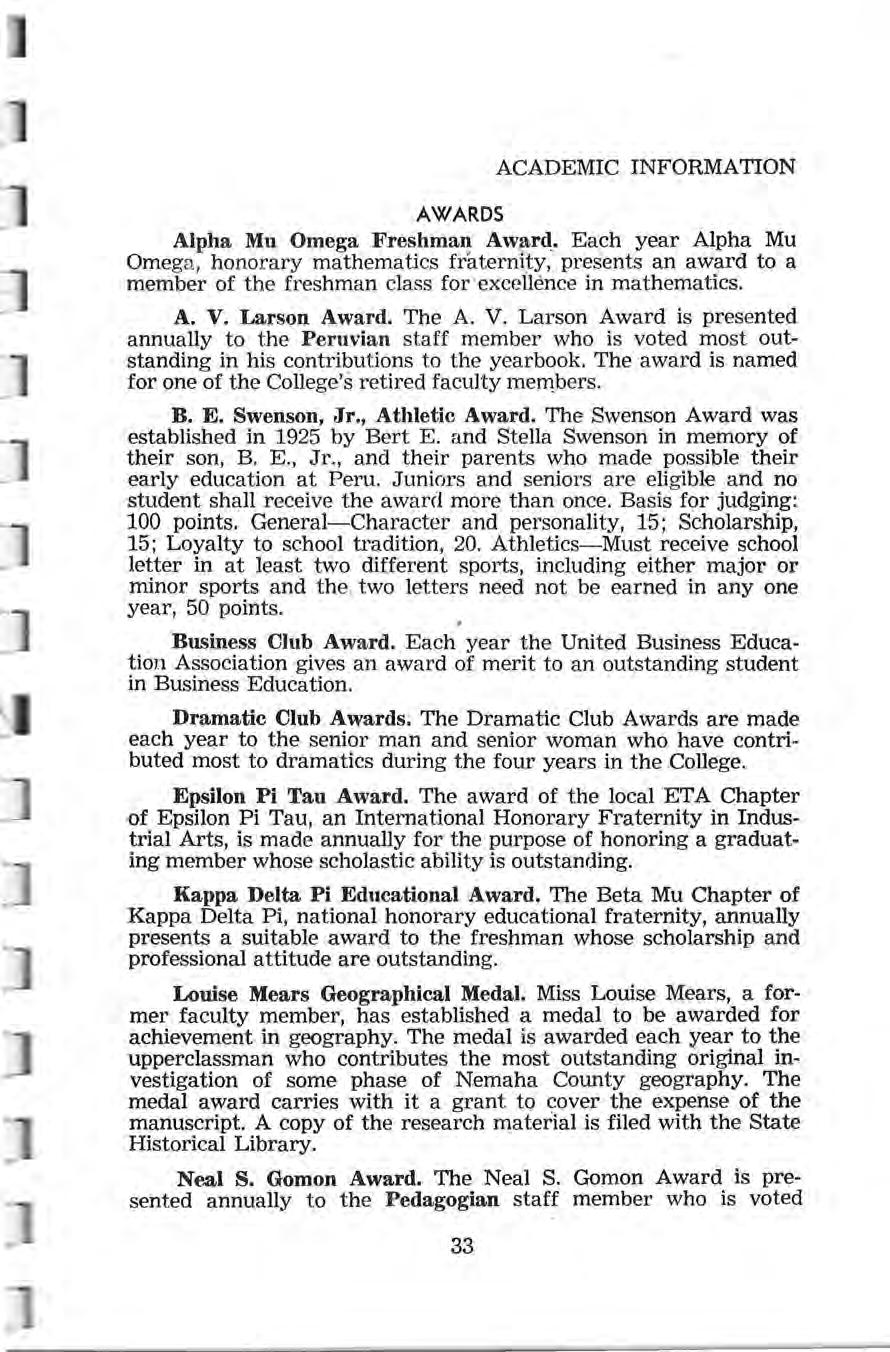
most outstanding in his contributions to the paper. The award is named for the College President, once sponsor of the Pedagogian.
Phi Alpha Theta Award. The Phi Alpha Theta Award is presented to the student whose contribution to the National and Local Historical Association is outstanding:
English Club Award. The English Club and Sigma Tau Delta, national honorary English fraternity, make an award for the best written contribution submitted each year. The type of writing is designated each year by the fraternity.
Zelma R. Wonderly Award. Established by the late Zelma R. Wonderly, elementary supervisor from 1950-59, this fund provides for an annual award of $50 to the outstanding second grade student teacher.
Pearl A. Kenton Foreign Language Award. Established by Miss Alice Kenton in memory of her sister, Miss Pearl A . Kenton, associate professor of languages from 1924 to 1944, this grant provides for an annual award of $50 to an outstanding student in the foreign languages.
Helen E. Cole Pollard Founders Award. Established by the board of trustees of the Peru Achievement as a tribute to Mrs. C . W. Pollard, a charter member arrd former secretary of the Foundation; the award will be presented at spring hc;mors convocation to the senior who during his collegiate career has demonstrated loyalty and service to the College.
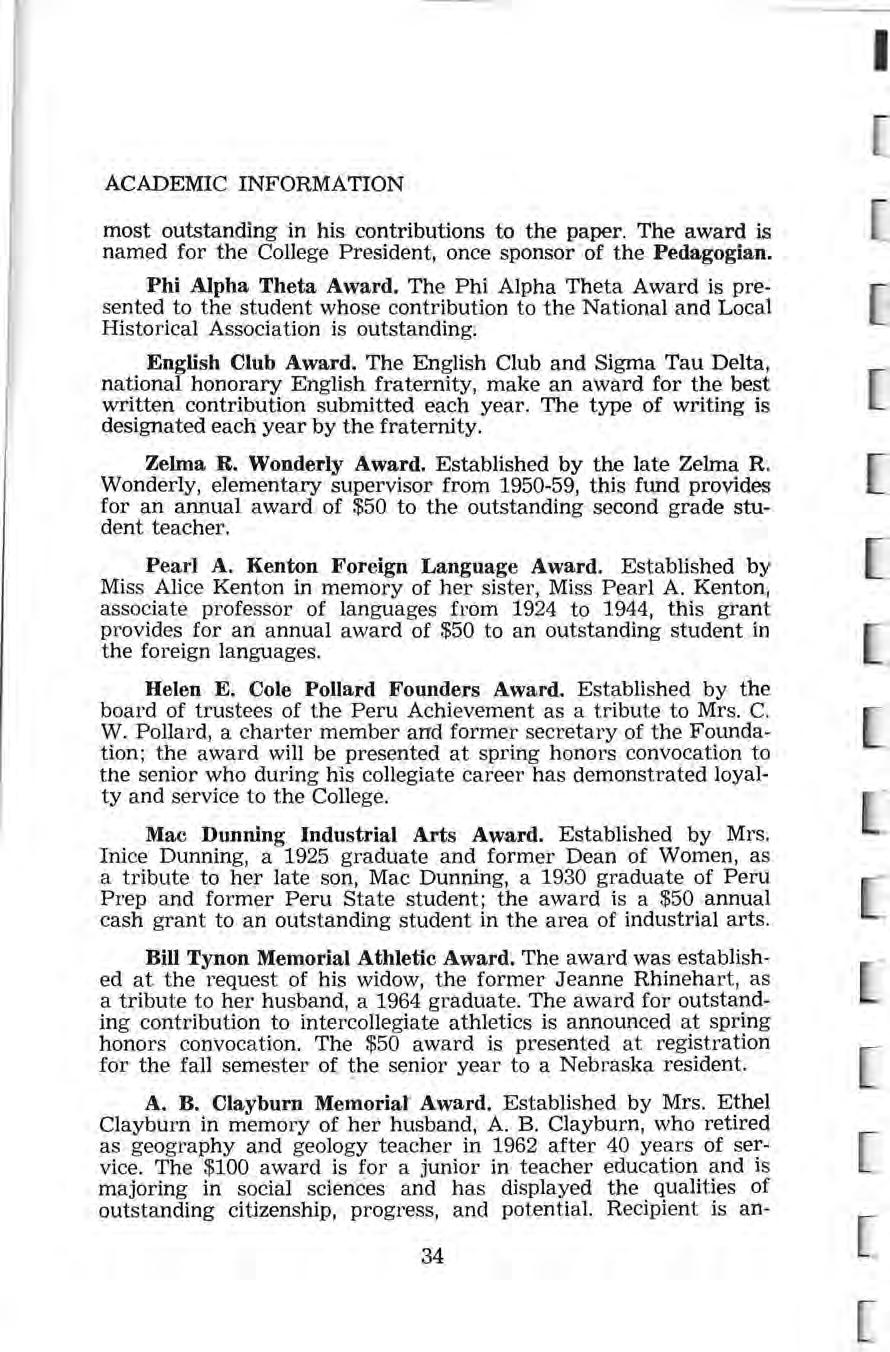
Mac Dunning Industrial Arts Award. Established by Mrs . Inice Dunning, a 1925 graduate and former Dean of Women, as a tribute to her late son, Mac Dunning, a 1930 graduate of Peru Prep and former Peru State student; the award is a $50 annual cash grant to an outstanding student in the area of industrial arts.
Bill Tynon Memorial Athletic Award. The award was established at the request of his widow, the former Jeanne Rhinehart , as a tribute to her husband , a 1964 graduate. The award for outstanding contribution to intercollegiate athletics is announced at spring honors convocation. The $50 award is presented at registration for the fall semester o( the senior year to a Nebraska resident.
A. B. Clayburn Memoriat Award. Established by Mrs. Ethel Clayburn in memory of her husband, A. B. Clayburn, who retired as geography and geology teacher in 1962 after 40 years of service. The $100 award is for a junior in teacher education and is majoring in social sciences and has displayed the qualities of outstanding citizenship, progress, and potential. Recipient is an -

nounced at the spring honors convocation and the award presented at fall registration of the student's senior year. . ,,
Lura Hendricks Eichler Memorial- Kindergarten Education Award. Presented annually to a student who has demonstrated ability, aptitude, and interest in kindergarten education. Established by F. J . Eichler as a tribute to his wife, a 1913 graduate, who had devoted 35 years to kindergarten education . The recipient is announced at spring honors convocation and the $25 award is presented at fall registration.
Each student may request and receive at any time one free transcript of his academic record. There is a fee of $1.00 for each additional transcript. No transcript will be issued if the student has not met all financial obligations to the College.
Transfer students are advised to seek reliable counsel in planning the first registration and ea€h subsequent registration thereafter at Peru State. The first semester schedule should be planned in terms of the total remaining requirements and the educational objective. Occasionally a transfer student may find it necessary to attend some part of a summer session to meet a certain graduation date.
All tuition and fees must be paid at time of registration. No provisions are made whatever for extending credit. No individual may enroll in any class, take examinations or enroll for a succeeding semester until all financial obligations to the College have been paid.

Admission Fee
An admission fee of $25.00 must accompany all applications for admission to the College. This fee will be applied on tuition when the student enrolls for the term for which he has made application. It will be refunded only if a student is not admitted
Matriculation Fee
A matriculation fee of $5.00 is paid but once by each student upon registering in Peru State College for the first time. This fee is a prerequisite to registration . This fee is non-refundable unless collected in error.
Each Semester
12 to 16 (incl.) sem este r hours (A normal schedul e) 11 semester hours or less , per hour . Each additional semester hour, above 16 .
SPECIAL FEES - AN INTEGRAL PORTION OF REGISTRATION

Student Center Fees · , Academic year (each semester, 12 h ours or more) ... ... .......... .. .. ........ $ Part time (any term or session, less than 12 hours) ...... ............ .. .. $ Student Program Fee Each semester (12 hours or more) ..... ....... $
Identification Card Fee
Paid only once unless replacement necessary
Late Registr a tion (effective first day of classes)
Change of Schedule
Placement Bureau (each year service is used)
Transcript of Records (after first free copy)
Graduation Fees
Undergraduate degree (*) Duplicate degree
Late Test or M a keup Ex a mination ............... ...... ... .. ........... .....
Validation of Courses for Credit
( *) Includes rental of academic gear.
Note: AU fees are subject to change by action of the governing board of the College at any time.
Students who are registered for at least 12 semester hours during any semester or who are registered for at least four semester hours during a summer session will be issued a certificate of registration which entitles them to admission to all college-sponsored events.
- The consolidated fee includes all charges of applied music necessary to meet the minimum requirements of a field of concentration in music. Private lessons (one-half hour each) in excess of the minimum requirements are not included in the consolidated fee. Music students are entitled to one or two lessons per week (without fee) depending upon the ex tent of concentration in music.
Art : Private lessons in drawing and painting, each
Music: Piano, organ, voice, instrumental lessons, each
Speech Education: Private instruction, each lesson
BOARD AND ROOM
Regular Sessions
Board and Room (7-day board) per semester
Board and Room (5-day board) per semester
No meals October 29-November 1; November 26-29; December 19-January 3; April 8-13.
. $ 2.00 $455.00 $390.00
(Rates apply when two or more students occupy a room. For single occupancy, when available, add $186 per semester.)
Swnmer S es sions
Room for 5-wee k se ss io n 60.00 Room for 3-wee k se ss ion 36 .00
(R a t e s ap p ly for tw o to a r oo m. Fo r s ingle occup a ncy, a vaila bl e, add $60 for 5- wee k term, $36 for 3-week term.)
Food se rvic e will be ava il a bl e in Stud e nt Center Snack B a r for a ll me a l s o n days cl ass es a r e in ses s io n a t item prices .
Note: Board and room charges are subject to change at the beginning of any semester or summer session.
MARRIED STUDENT HOUSING
Unit Rentals
On e -B e droom Units, pe r month $75.00
Tw o-Bedroom Units, p e r month ......... $90 .00
(In c lud es he a t , li g ht and w a t e r. Addi t ional fee for som e a ppliance s. J
HOUSING CONTRACTS

Every s tud e nt r es idin g in co ll ege r es id e n ce h a ll s or mar r ie d stud e nt hou sin g must e nt e r into a contrac t on form s provid e d by th e coll e ge Advance r ese r va tion s a re requir ed and a d e posit of $ 25.00 mu s t a ccomp a ny r e qu es t for r ese r v ation . This d e pos it is not re fund a bl e if th e s tud e nt fail s t o t a ke up r es id e n c e in th e dormitory or hou s in g facility fo r the full term for which a ppli c ati o n was m a d e It is r e fund a bl e , les s d e duction for dama ge to the buildin g s a nd e quipm e nt , at th e e nd of th e term pro vid e d th e s tud e n t is in r e sid e n ce for th e full t e rm or if th e s tud e nt withdr a w s from coll ege beca u s e of e ntr a nc e into the a rm ed ser v ices or for r eas on s b e y o nd hi s co ntrol as det e rmin ed b y th e coll eg e .
STUDENTS ARE URGED TO RETAIN ALL RECEIPTS ISSUED BY THE COLLEGE EXPENSES FOR ONE YEAR
The consolidated single fee plan, plus the college-operated residence halls and the low-cost food service at Peru State College, make a college education financially possible for most young people
Estimate
and
20.00
20.00
Board
TOTAL or TOTAL 38
.. . $1,620.00 $1,490.00
'''S tud e nt s m a y pay 7-day b oa rd a n d ro o m ( 20 m ea ls), St ud e n t Ce n ter and Stud e nt Progra ms fees in fo ur p ay m e nt s eac h se m ester. F ir s t se m ester , $1 30 a t regis tr a ti o n with t hre e pa ym e nt s of $115 eac h o n Octob e r 10 , Nove mb e r 10, D ece mb er 10. S ec ond se m es t er, $13 0 at reg istra ti o n w i t h th ree p aym e nts of $ 115 eac h on F ebr u ar y 25, N'Ia r c h 25 , April 25
**Stud e nts m a y p ay 5-d ay boa rd a n d roo m ( 15 m ea ls), St u dent Ce nt e r a nd Stud e nt P rogra m s fees in fou r p ayme nt s eac h sem e s t er. Fir s t semes t e r , $110 a t reg is tr a ti o n w ith t h ree p ay m e n ts of $100 ea ch o n Oc to b er 10 , Nov e mb er 10, D e ce mb e r 10 S e c ond se m es t er, $110 at reg is t ra tion w i t h th ree p a ym e nt s of $100 ea ch on F e b r u ary 25, Marc h 25, April 25 . NOT
E: C h oice o f board pl an mu s t b e m a d e a t t im e of r eg istra ti o n 7-d a y pl a n m a y not b e chan ge d at a ny tim e durin g se m este r
Fe e Refunds
Prop ortio n a t e re fund s w ill b e m a d e to stude nt s w ithd raw in g fr om t h e Coll ege wi t hin a g ive n per iod Th e m a tri c ul at io n , S tud e n t Ce n ter a n d S tud e n t
Prog r a m s f ees will not b e refund e d u n less c oll ec t e d i n e rr or . Th e fo ll ow in g sch edule will b e followed in refundin g th e r eg istra tion fee:
First week 80 % of r e gistration fe e
and third weeks 60 % of registration fee
Fourth, fifth and sixth weeks ,. .40% of registration fee
After sixth week None
Summer Session:
First week 80 % of regis t ration fee
Second week ... ....... .. .. .. .......... .. .. ... ...... ... ...... 50 % of r e gistration fee
After second week ....... ... ... .... ............. ... ..... .... ... .. ....... .... .... .. .. .. None
Night Classes:
The same perce ntages apply to night class s tudent . refunds as in the c as e of full tim e stud e nt s.

Th e re fund sc h e dul e a ppli es onl y to com p le t e w i t hdr awa l fro m co li ege
Board and Room Refunds
R e fund of board a n d room will be mad e if a st ud e n t mu s t withdraw fro m coll ege . Th e st ud e n t is obli ga t ed fo r t h e re n t of t h e r oo m sp ace for th e rem a ind e r of th e qu a rt er ( nin e wee k s ) in whi c h h e wi thdr e w , r egar dl e ss o f
whether or not the space is rented again. The student will be required to pay board charges to the end of the week in which the withdr awa l is made. Students who remain in school but move from a residence hall while under contract will not be entitled to a refund of board and room payments In case of illness, refund of board only wilJ be made providing the student has missed no Jess than ten (10) consecutive class d a ys. Adjustment for students who are off-campus as a part of their professional semester will be made on an individual basis. Refund wi.11 be prorated in accordance with unused portion.
The purpose of financial assistance is to provide students with sufficient funds to meet all costs of obtaining a college education beyond what they and their parents are able to provide. Thus, financial aid enables many students from low and middle income families to attend college who could not otherwise afford that opportunity.
Any assistance granted is awarded according to the financial need of the applicant. (Financial need is the difference between the money a student and his parents can provide for an education and the costs of that education.) To be considered for assistance, the applicant must demonstrate financial need.
In all cases, parents and student are expected to make a maximum financial contribution to the education of the applicant.
Financial assistance to qualified applicants is available in the form of loans, grants, scholarships, and college-work. A student who qualifies for one program of financial aid may not necessarily qualify for another.
"Financial packaging" permits the Financial Aids Officer to tailor a program of financial assistance to meet the monetary needs of the individual student for one academic year. A financial package is worked out on the basis of a careful estimate of the applicant's estimated resources and educational costs for the school year.
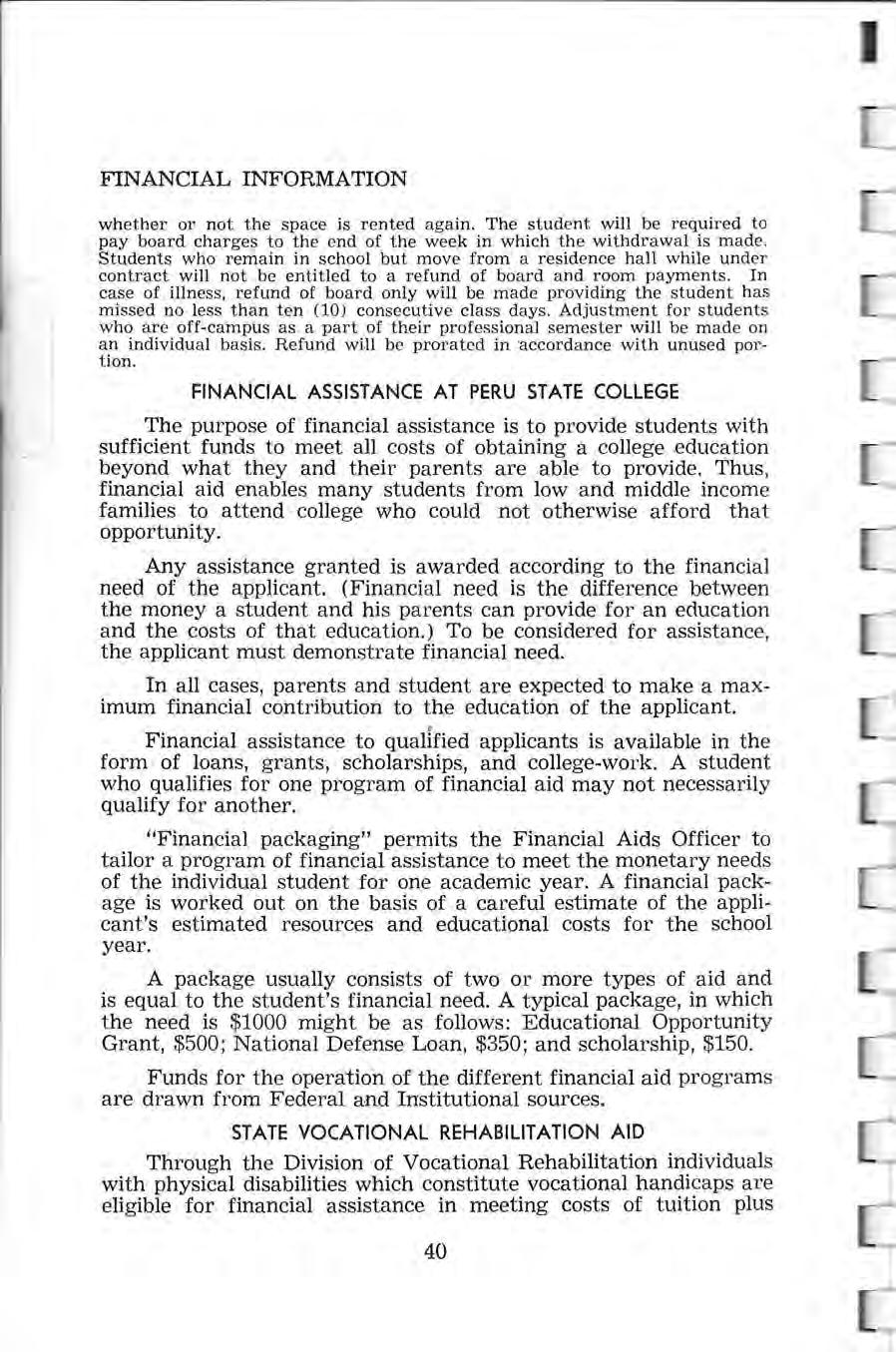
A package usually consists of two or more types of aid and is equal to the student's financial need. A typical package, in which the need is $1000 might be as follows: Educational Opportunity Grant, $500; National Defense Loan, $350; and scholarship, $150.
Funds for the operation of the different financial aid programs are drawn from Federal and Institutional sources.
Through the Division of Vocational Rehabilitation individuals with physical disabilities which constitute vocational handicaps are eligible for financial assistance in meeting costs of tuition plus
certain other financial help, depending upon the extent of their financial need.
.
Students interested in receiving thi~ aid should contact the Director of Student Financial Aids ·for ·additional information.
Educational Opportunity Grants provide for the g1vmg of grants, or gifts, of money to students who are determined to be of exceptional financial need. Students in this category will be of such need that they will be unable to attend college without financial aid of this type.
The EOG grants will range from $200 to $1000 a year, and can be no more than one -half the tot al assistance given a student. The grant is "matched" with other financial aid to equal the total of the student's financial need. Grants are awarded on a yearly basis with the maximum duration of a grant being four years.
College Work-Study is intended primarily for students from low-income families and permits •them to earn a substantial part of their expenses in order to attend college. During the time they are attending classes full time, the student can work a maximum of fifteen hours per week. During vacation periods the students may be allowed to work forty hours per week. Work-Study jobs are usually on-campus or for the City of Peru and are vital to the efficient operation of both the College and the City. College WorkStudy jobs are often used for matching purposes with a student's EOG grant.
National Defense Student Loans are made to students who need financial assistance in meeting educational expenses. To be eligible, the student must be in good standing and be registered as a full-time student. Special consideration is given to those entering the teaching profession, or who are majoring in science, mathematics, engineering or modern foreign languages. NDSL loans are also commonly used for matching purposes with an EOG.

Federally Insured Student Loans are intended primarily for students who do not qualify for the other programs of financial assistance but who, nonetheless, need financial help. Any student, regardless of his parent's income, qualifies for the Federally Insured Loan program.
College Work jobs are similar to the Work-Study jobs in pay scale, type of work performed, and hours worked.
College Loan Fund loans are generally made on a short-term basis to students enrolled in the College, who are planning to teach, and are in need of financial assistance. The College Loan Fund was established by the class of 1913 with an initial gift of $50. The fund has since been increased to nearly $7000, with gifts by the Nebraska P. E. 0. in 1929, the Anna Irwin Memorial provided by the Peru Branch of the American Association of University Women, gifts by graduating classes, and interest accumulations. Memorial Loan Funds established by various donors include: the $200 Willie Ethel Crone Loan l<~und, established in 1943 by Miss Ruth Crone in memory of her mother; the $300 Harriet Louise Lindstrom Loan Fund, established in 1946 by the late C. R. Lindstrom and Mrs. Lindstrom in memory of their daughter; the Mrs. Eva Fischer Loan Fund provid~d in 1962 by a $500 bequest by the late Mrs. Eva Fischer of Beatrice; the Towne Loan Fund provided by a $1,411.24 bequest by the late Norman L. Towne of Bozeman, Mont ., husband of the late Lola Howe Towne, class of 1906; the $250 Patricia Buethe Loan Fund, established in 1962 by friends of the late Mrs. L. Chris Buethe.
Although there is some variation in the specific requirements for these loans , the general qllalifications are the same as for the College Loan Fund: (1) be a student in the College (2) plan to teach (3) be in need of financial assi stance. Loans from the College Loan Fund and Memorial Loan Fund are generally made on a short-term basis.
Cooperating School Scholarships. These scholarships are available to graduates of Cooperating Schools in the Teacher Preparation program in the ratio of one scholarship to each five student teachers. For a resident student, the scholarship applies at the rate of $82.50 per semester for eight semesters. For a non-resident student, the scholarship applies at the rate of $152.50 per semester for eight semesters.
Nebraska Congress of Parents and Teachers Scholarships. Scholarships are granted by the Nebraska Congress of Parents and Teachers to full-time students of the Nebraska State Colleges who are Nebraska residents training to become teachers . In order to be eligible for these scholarships-which vary in number with available funds-the student must have a pleasing personality, have high moral and social standards and show an aptitude for teaching. Applications are sent to ,the College by the Nebraska Congress of Parents and Teachers shortl y after the beginning of the fall semester.
Foreign Student Scholarships. Five full-tuition, four-year scholarships are awarded annually to qualified undergraduate students who are citizens of other countries. Candidates for such
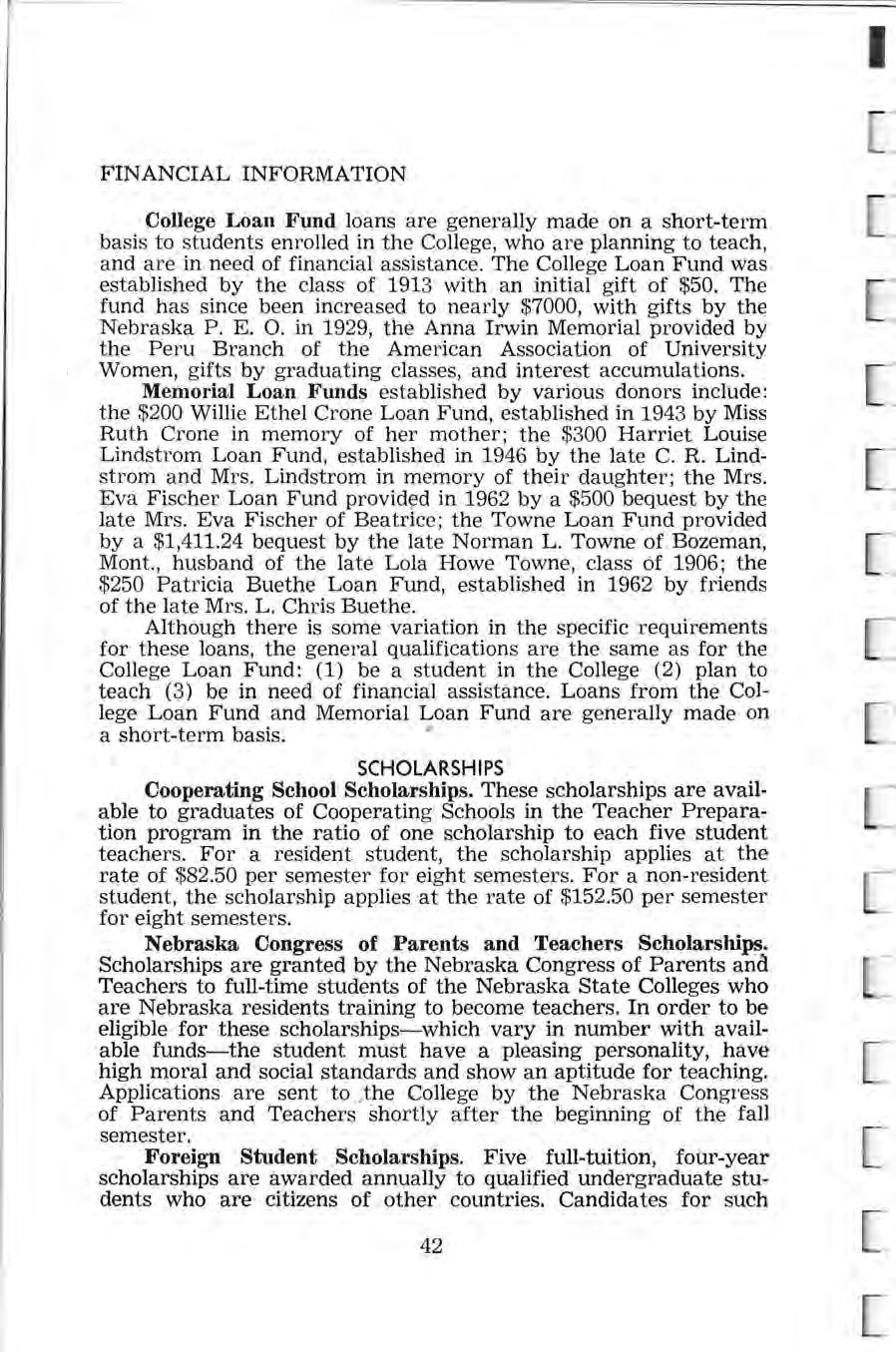
scholarships must present proof of ability to defray expenses other than tuition and fees. Applications mµst be filed with the President of the Colleg e no later than June 1 prior to fall entrance.
Peru Achievement Foundation Scholarships. Through the generosity of alumni and friends of Peru State College, the Peru Achievement Foundation, Inc., awards scholarships which have been established on a permanent basis.
These include: the E . C. and Mae Miller Beck Scholarship for a student in English; the Louise Mears Memorial Scholarship for a student in geography; the Jess Harris Memorip.l ; the Bath Family Memorial; Peru Achievement Foundation Freshman Alumni Scholarship; Charles P. Weigand Memorial ; Glenn D. Jenkins Memorial for a Richardson county re sident; Nona M. Palme r Business Education Schol a rship; Ruth Vernon Mathews Memorial; Bond Kennedy Memorial of the Peru Kiw a nis Club; Residence Hall Scholarships from the Foundation Vending Division; John Wear Memorial Scholarship for a student in pre-medical studies; Knights of Ak-Sar-Ben Scholarship for Nebraska residents; Charles E. Andrews Memorial Scholarships; Alice Jewell Warnock and Lillian Jewell B a rnes Memorial ; Oliver •J. Stevenson Memorial; Robert H. and Mytrle E. Knapp Scholarship for freshman from Nemaha or Richardson county.
Other scholarships are awarded through the Foundation ona year-to -year basis. Scholarships awarded for the 1969-70 academic year, in addition to the permanent scholarships, included: Peru Veterans of Foreign Wars; Pawnee County Education Association; Mrs. Caroline Strom Memorial; Janet Ganze! Memorial; White An gels; Andrea Grainger Memorial of Southeast High School, Lincoln; Nebraska City Chamber of Commerce Women's Division.
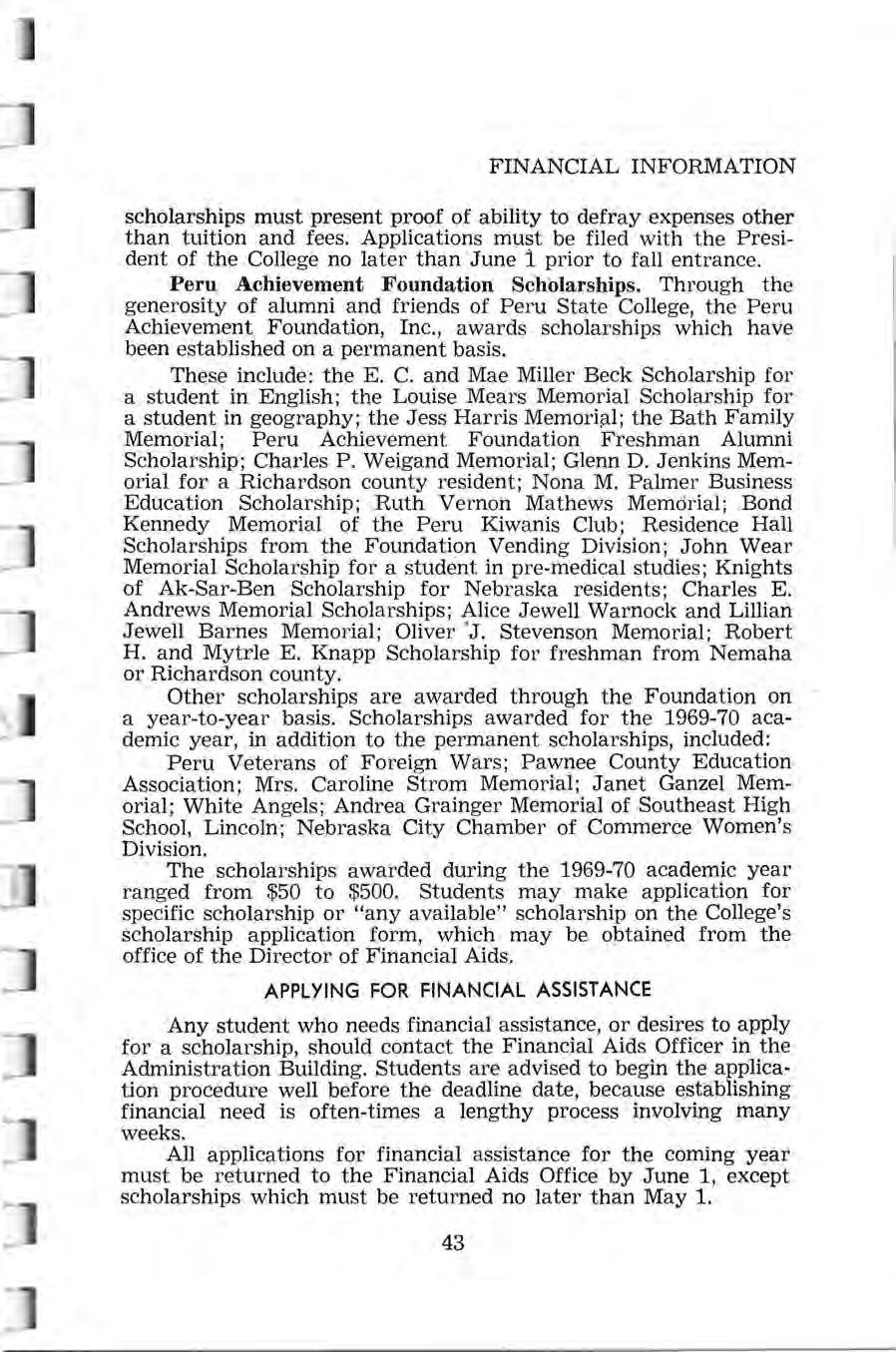
' The scholarships awarded during the 1969-70 academic year ranged from $50 to $500. Students may make application for specific scholarship or "any available" scholarship on the College's scholarship application form, which may be optained from the office of the Director of Financial Aids.
Any student who needs financial assistance, or desires to apply for a scholarship, should contact the Financial Aids Officer ih the Administration Building. Students are advised to begin the application procedure well before the deadline date, because establishing financial need is often-times a lengthy process · involving many weeks.
All applications for financial a ssistance for the coming year must be returned to the Financial Aids Office by June 1, except scholarships which must be returned no later than May 1.
The College has as its constant goal the best possible adaptation of its educational opportunities to the interest, needs and abilities of each individual student.
The student is assigned to a faculty advisor who is qualified to advise him in his field . Students needing advice before the opening of the college year are invited to arran ge a conference with the Registrar of the College by definite appointment. The student needing personal or vocational counseling should see the Director of Counseling.

Prior to the opening of classes, the College arranges a Welcome Week program , which is designed to give special attention to problems of students who are .entering the College. Both Freshmen and transfer students are required to attend. The pro g ram acquaints the student with his new environment and offers him a helpful introduction to campus life He completes tests and is assigned to a faculty advisor who is available to assist the student throughout his college career in defiqing goals to be reached in college and give information regardin g appropriate curriculums and courses . Opportunity to meet members of the faculty and other members of the student body is afforded through social events
The primary function of the Counseling Service is to help typical students make realistic decisions regarding their college careers. All entering students are encouraged to make an appointment with the counselor so that they may obtain his professional services which include: (1) counseling-educational, vocational and other personal problems; (2) testing; (3) occupational information.
Counseling. It is the policy of the College Counseling Service. to counsel with students who can be helped in a relatively ·short period of time (about one semester). It is not the intent to engage in long term and / or intensive psychotherapy, but rather to promote the adjustment of students within the College setting. A primary goal of counseling is to help maturing students accept responsibility for their own behavior.
Testing Services. Te sts of , achievement, ability, interest, and adjustment are given to all students who request them through a counselor. The data from these tests are used as a basis for counseling in educational , occupational, and personal problems. The testing service provides psychological test data for the use of counselors and faculty advisers, placement tests for various academic groups
at the College, and assistance in the preparation, administration, and scoring of subject-matter tests as requested by various departments in the College. · •·
Occupational Information Services." A' comprehensive, current collection of essential occupational information is maintained in the Counseling Service library. Current catalogs of the major universities and technical schools are also on file. These materials are available to all students seeking information about particular vocational opportunities or information about employment in general.

Each student is expected to conduct himself in accordance with the regulations of the college and such laws of the City, State and Federal Governments as apply to matters of personal conduct .
In those instances where an individual student demonstrates his inability to live according to approved codes of social behavior, the College may require him to terminate his enrollment until such time as he is able to prove his ability to adjust himself to the standards required. The College rese r ves the right to exclude at any time students whose conduct is deemed undesirable or injurious to the best interests of the College or of the student. In event of such dismissal, fees will not be refunded.
For detailed information regarding student conduct, see the Peru State College Student Agreement and the Handbook for Peru Staters.
All requests for information concerning living accommodations and requests for room reservations in one of the residence halls should be directed to either the Dean of Students (men) or the Associate Dean of Students (women). Schedule of room and board rates is listed in the Financial Information Section.
Residence Halls. The college residence halls offer attractive living accommodations near the classrooms and library. Halls are mail 1tained for both men and women students.
All unmarried women students, except those living with parents or guardians, are required to live in one of the women's residence halls .. All unmarried freshman and sophomore men students under age 21, except those living with parents or guardians, are required to live in one of the men's residence halls. Upperclassmen are strongly encouraged to live in the residence halls but may live offcampus with written permission of the Dean of Students Such written permission is to be obtained before student enters into
agreement with a landlord. No unmarried male students under 21 years of age may live off-campus in housing other than that under the immediate supervision of a resident owner.
Women-Morgan Hall and women's quarters in Centennial Complex are under the supervision of the Associate Dean of Students . In Morgan Hall all rooms are arranged as combination sleeping and study rooms Two students occupy a room except for the south wing addition where three students are assigned each room. In Centennial Complex quarters are arranged in suites of two or three bedrooms, a living room and bath to accommodate four or six students. Residents must furnish bed linen, pillows, blankets , towels and dresser scarves. Students also furnish study lamps in Morgan, bed lamps in Centennial Complex (if desired). Window drapes are furnished.
Men-Delzell Hall, Majors Hall and men's quarters in the Centennial Complex are under the supervision of the Dean of Students. Except in Centennial Complex all rooms are arranged as combination sleeping and study rooms. Two students are assigned to a room. In Centennial Complex quarters are arranged in suites of two or three bedrooms, a living room and bath for . four or six students. Occupants in all halls furnish bed linen (fitted sheets should be provided for X-long twin beds), pillows, blankets and towels. Students also furnish study lamps in. Delzell, bed lamps in Majors Hall and Centennial Complex if desired. Occupants are advised that all rooms in all men's Residence Halls are equipped with seven-foot beds. Window drapes are furnished.
Other Housing Accommodations. Lists of rooms and apartments available in private homes off-campus a r e maintained by the Dean of Students. These accommodations are a pproved and supervised by the College. Students may not live in housing other than that approved by the College. This includes students working for board, or living with relatives other than pa,rents or guardians. Students desiring to live off-campus must obtain an off-campus permit from the Dean of Students before the student enters into agreement with a landlord.
Married Student Housing. Housing facilities for married students are available in Oak Hill in one and two bedroom units. Each unit is equipped wi,th -a stove, refrigerator, washer and dryer. Utilities are included in r;entaL fee with the exception of certain appliances such as TV and air-conditioning. College-operated housing for married students is leased on a semester basis with rental payable monthly in advance. A deposit is required and is refundable at the end of the lease period provided the property is left in good condition.
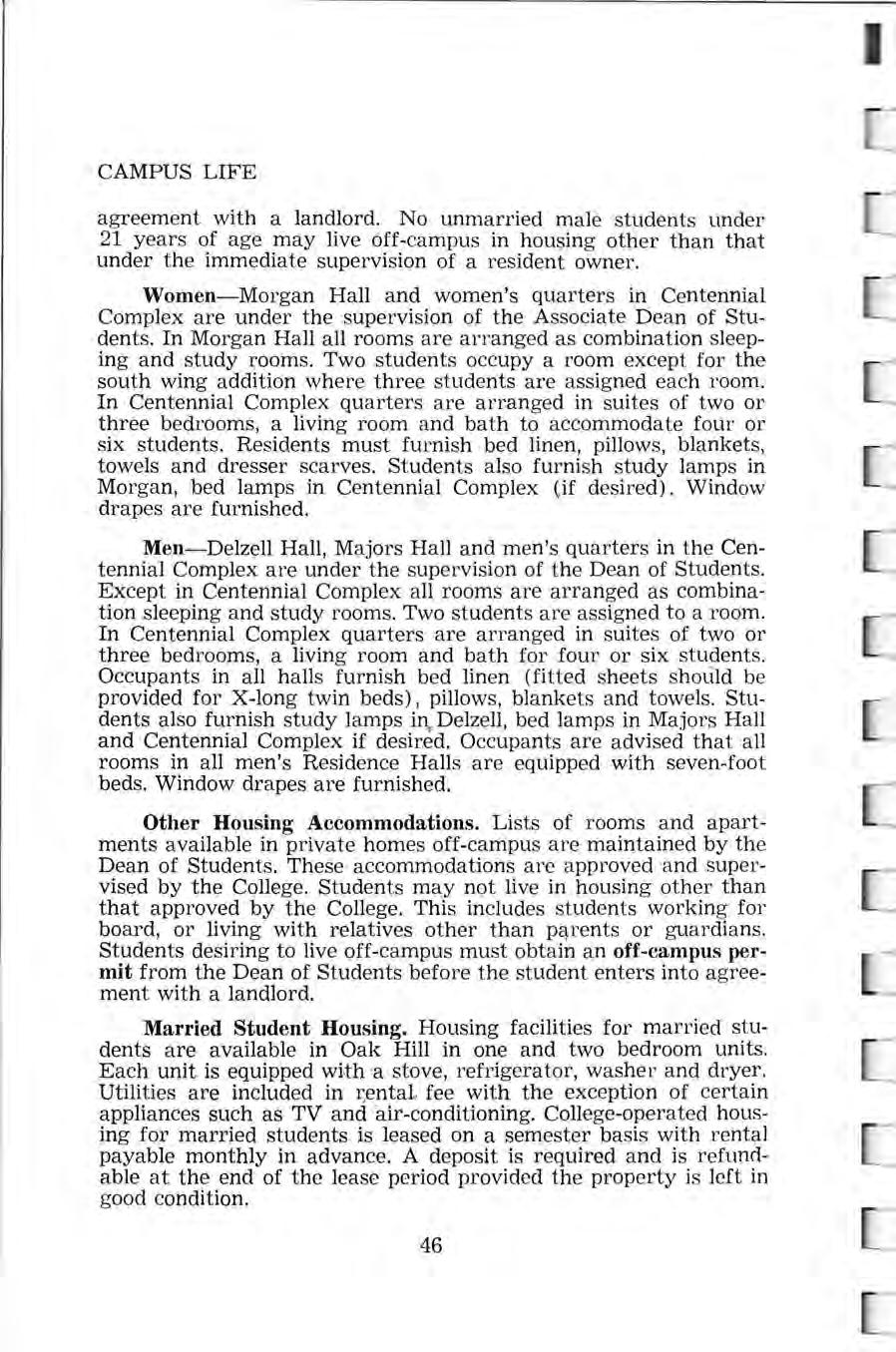
Food Service. Air-conditioned food service areas are located in the Student Center and the Centennial Resid e nce Complex. The main dining room in the Student G::enter is open for re g ular me a l service to residents of Mor ga n, Ma jors and Delzell H all s and to faculty, staff, g uests and visitors The Neal Hall dining room is op e n for regular meal se rvice to r es idents of th e Centennial Complex. Weekend service is available only in the Student Center. The Snack Bar, lo ca ted in the Student Center , is open for lunch es and sn ac k s at stated hours . Students who do not live in the resid ence halls, faculty, staff and g ue sts of the College may pu rc ha se m ea ls at individual meal rates in the Student Center food service areas.
Dress. It is not the intent of the college staff to di c tate the clothes worn by students. However, it is the opinion of the staff and the Student Governing Association that there is an obli g ation to advise students as to appropriate dress. Appropriateness of dress does not require expensive clothes. The essential requir ements are that the clothes be clean, not torn and reasonably well fitted.
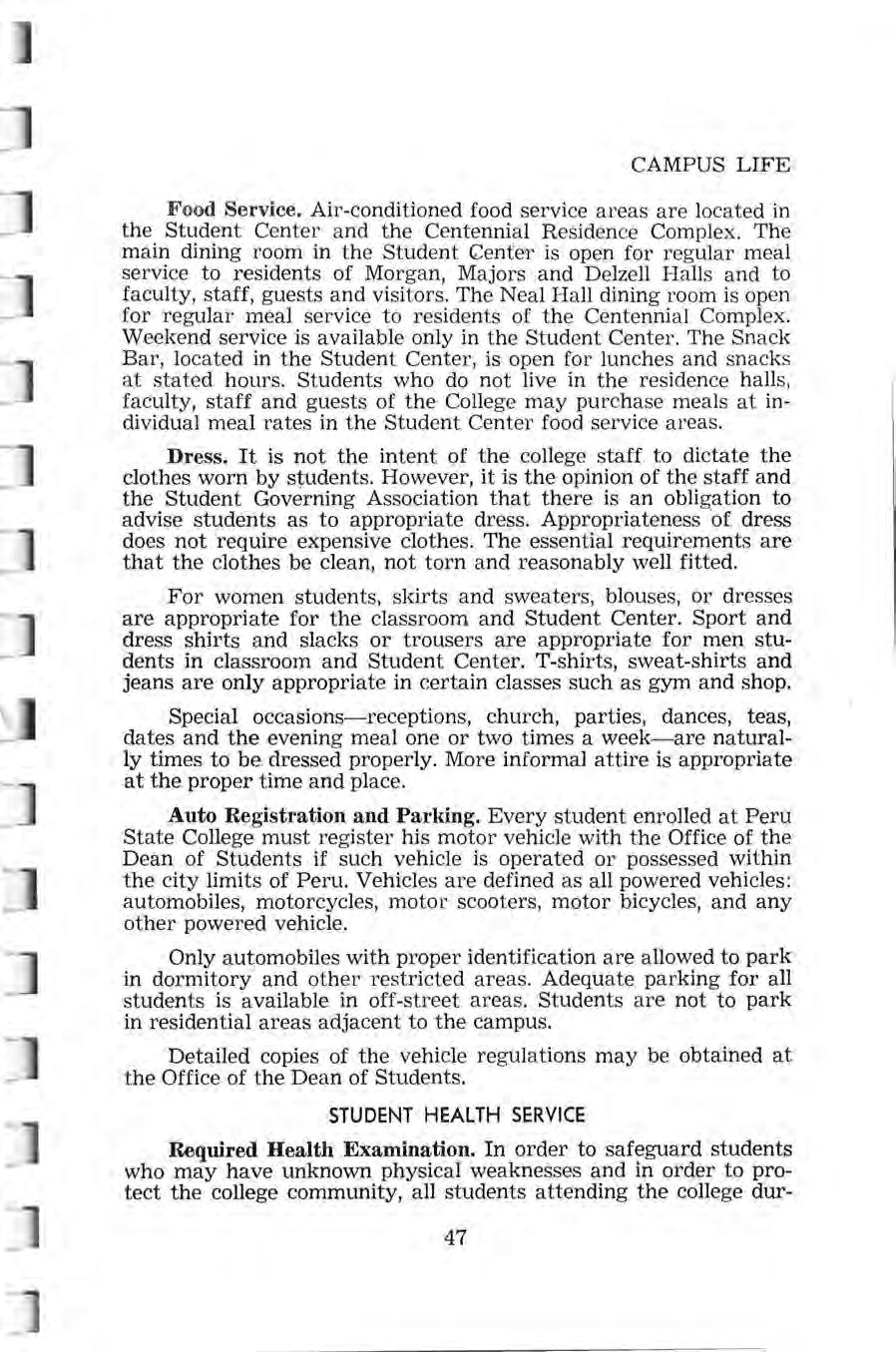
For wom en students, skirts and sweaters, blouses, or dresses are appropriate for the classroom and Student Center. Sport and dress shirts and slacks or trousers are appropriate for men students in classroom and Student Center. T-shirts, sweat-shirts and jeans are only appropriate in certain classes such as gym and shop. ._ Special occasions-receptions, church, parties, dances, teas, dates and the evening meal one or two times a week-are naturally times to be dressed properly . More informal attire is appropriate at the proper time and place .
Auto Registration and Parking. Every student enrolled at Peru State College mu st re g ister his motor vehicle with the Office of the Dean of Students if such vehicle is operated or possessed within the city limits of Peru. Vehicles are defined as all powered vehicles : automobiles, motorcycles, motor scooters, motor bicycles, and any other powered vehicle .
Only automobiles with proper identification are allowed to park in dormitory and other restricted a rea s. Adequate parking for all students is available in off-street areas. Students are not to park in residential areas adjacent to the campus.
Detailed copies of the vehicle regul a tions may be obtained at the Office of the Dean of Students.
Required Health Examination. In order to safeguard students who may have unknown physical weaknesses and in order to protect the college community, all students attending the college dur-
ing the regular academic year are required to furnish evidence of being in good health as a part of the student's application for admission and initial enrollment . A medical report, inclusive of examination by a physician, is required at the tim e of registration. This is supplemented by a audiometric test in the health center. This medical report is valid for a period of s ix years.
Students participating in physical activities such as football, basketball, baseball, cross country, track and field, swimming and tennis must be certified as physically fit by the college physician at the beginning of the activity.
Health Care. Any student may consult the Nurse at the Health Center at any time during her re gular office hours . No charge will be made for a call during office hours. For calls {o or by the Nurse outside of office hours, there will be a charge of $1.00 per call, except in the case of emergency as determined by the Nurse.

Cold tablets, aspirin, gastro-intestinal medication, first aid and dressings are provided from the Health Service free of charge. The student will pay for infirmary care, all X-ray, laboratory fees and other medication issued through the Health Service and the College Doctor's office.
A Doctor is at the Health Center between the hours of 12:00 noon to 1:00 p.m. on Tuesday and Friday. Students needing an appointment with the Doctor ~hould advise the College Nurse before 11:45 a.m. on these days.
Any visit to the College Doctor's office, unless paid for by the student, must be authorized by the Nurse before the call is made. The student may visit the College Doctor or other doctors at any time at his own expense.
When authorized by the Nurse, the College will pay for the first call to the doctor's office for diagnosis. Any follow-up or additional calls will be at the student's expense .
These privileges and benefits are in effect so long as the student abides by the orders of the doctor or nurse. Otherwise the student will assume all responsibility and cost of his own care.
The College's responsibility for medical expenses is limited to the service as listed above.. It assumes no further responsibility for any student.
Health Insurance. Blue Cross-Blue Shield hospital and medical insurance is available to all students at very reasonable group rates. Although not compulsory, it is emphatically recommended that students purchase this type of protection.
Throughout the school year Qoncerts, plays, lectures and recitals are presented at the College. by _students, faculty members and professional artists. Student-planned and student-directed productions, which give the participants valuable experience, are an important part of the College entertainment schedule.
Besides recreational facilities of the College embraced in an intramural pro g ram for both men and women, Peru's location in the rolling wooded hills offers opportunities for hikes and outings . The nearness of the Missouri River makes the College an ideal place for the nimrod and angler. Laura Neal Memorial Park, a few blocks south of the campus, is the scene of many student, faculty and alumni meetin gs. Other parks in . the area where Peruvians gather are Coryell Park near Brock, the city parks at Auburn and Nebraska City, and the Arbor Lodge State Park, also in Nebraska City. The summer months find many Peru Staters enjoying the outdoor municipal swimming pools in Auburn and Nebraska City.
The social season at the College centers around five eventsHomecoming, Thanksgiving, Christmas, Valentine's Day and May Fete--when all-colle ge dances are given. Other social activities are sponsored by various student organizations. These g roups give dances , teas, parties, receptions and picnics for their members and guests . Faculty organizations include the Faculty Women's Club and a branch of the American Association of University Women.
The STUDENT CENTER BOARD is responsible for the social and cultural activities on Peru State's Campus. Membership consists of fourteen members of which one is the Student Center Director, two are faculty members appointed by the faculty association, two students are appointed by the Student Governin g Association, and the remaining are selected by the board through personal application and interview. Memb ers must be free of social or academic probation and have at least a 5 .00 GPA.
The STUDENT GOVERNMENT ASSOCIATION, a representative organization of the student body, serves .to coordinate the efforts of the students and faculty for the best 1ri.terests of the College. The SGA evaluates the programs of other organizations, assists with some problems of student conduct and morale, provides student representation on several college committees, supports college-wide activities and sponsors certain all-college events. Its mem-
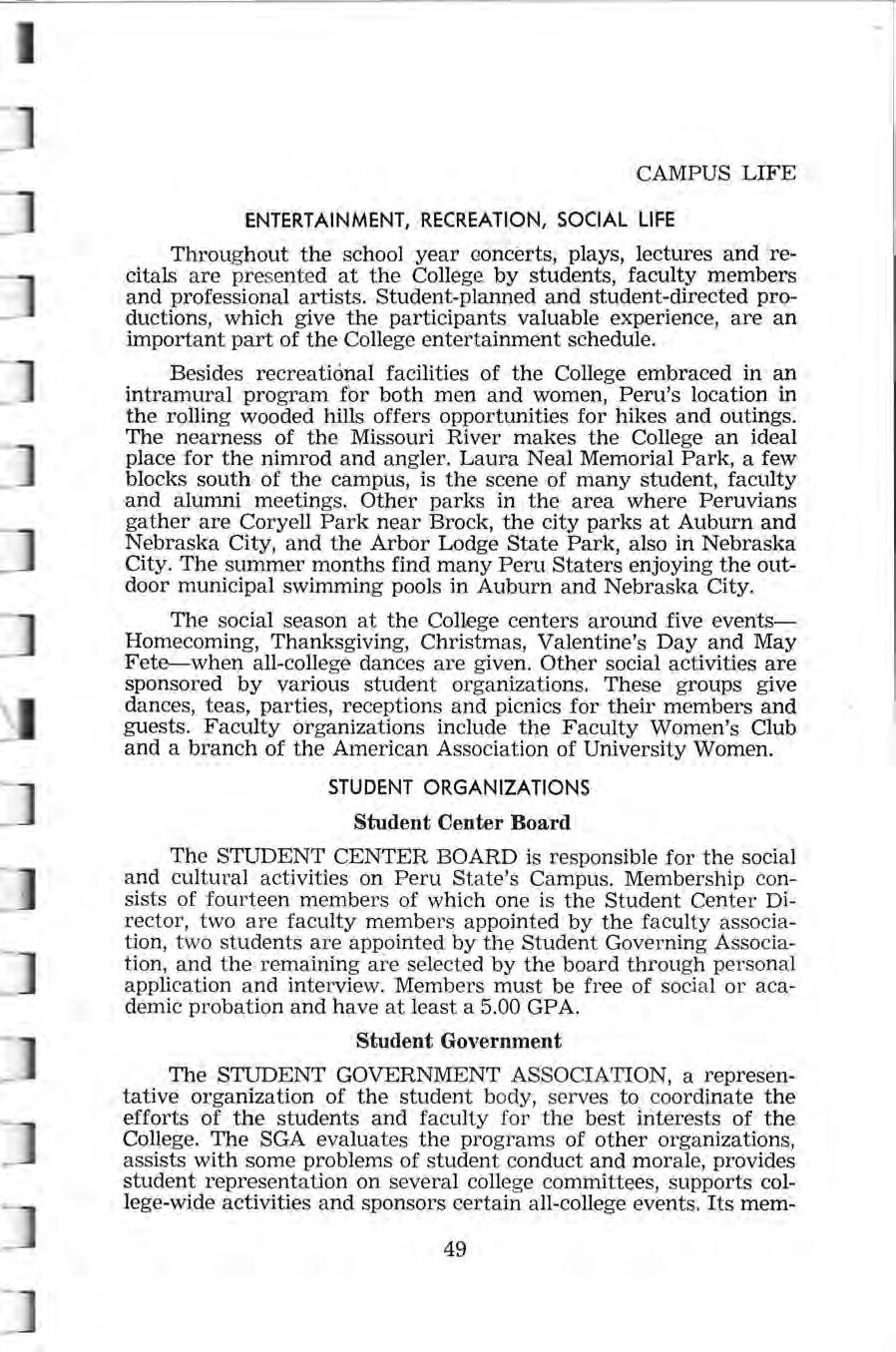
bership includes twenty-two students and two faculty sponsors. To be eligible for membership, students must maintain a minimum cumulative grade average of 5.00 in addition to possessing high qualities of citizenship, character and leadership.
SENIOR, JUNIOR, SOPHOMORE AND FRESHMEN classes are considered definite organizations. Each class is assisted with their activities by a member of the faculty who acts as sponsor during the school year.
MEN'S HALL COUNCILS AND WOMEN STUDENTS ASSOCIATION are representative councils selected by the residents of the men's and women's residence halls, respectively. The governing bodies of the halls handle problems and plan social activities for the residents.
The DRAMATIC CLUB, one of the state's oldest dramatic organizations, throughout its existence has endeavored to present to the College community the best in drama. Members are selected on the basis of interest, ability and quality of work.
FOREIGN LANGUAGE CLUB is open to all students who study foreign languages. The origin of the club goes back to the German Club organized by Professor E. A. Wittenack in 1909. Through the years this organifation under the guidance of Dr. Selma Koenig, developed into what is now known as the Foreign Language Club. The aim of the club is to give to the students and the instructor an opportunity to become better acquainted with one another, to speak the languages, to show films of foreign countries, to sing songs in different languages and to have an hour of social fellowship with one another.
HOME ECONOMICS CLUB. Young women interested in home economics are eligible for membership in the Home Economics Club. This organization offers opportunities for development of personality and for stimulation of interest in homemaking and the professional field. It is affiliated with the National Home Economics Association.
INDUSTRIAL ARTS CLUB is devoted to promoting interest in the Industrial Arts and Vocational Education. Affiliated with the American Industrial' Arts Association, the organization's members receive the national "P.Ublication, "The Industrial Arts Teacher," published five times yea.cly.
STUDENT EDUCATION ASSOCIATION is an organization for potential teachers. It;r is1affiliated with the Nebraska State Education Association and1 the National Education Association. The

activities of the association are devoted to the improvement of education in the United States. Membership is open to those students who expect to enter a teacher preparatibn curriculum.
Religious ·
In September of 1956, the chapters of the Young Men's Christian Association and the Young Women's Christian Association, along with the Studept Fellowship Club, were combined into one religious club which is now known as the Student Christian Fellowship. This group includes Christian, Baptist and other denominations.
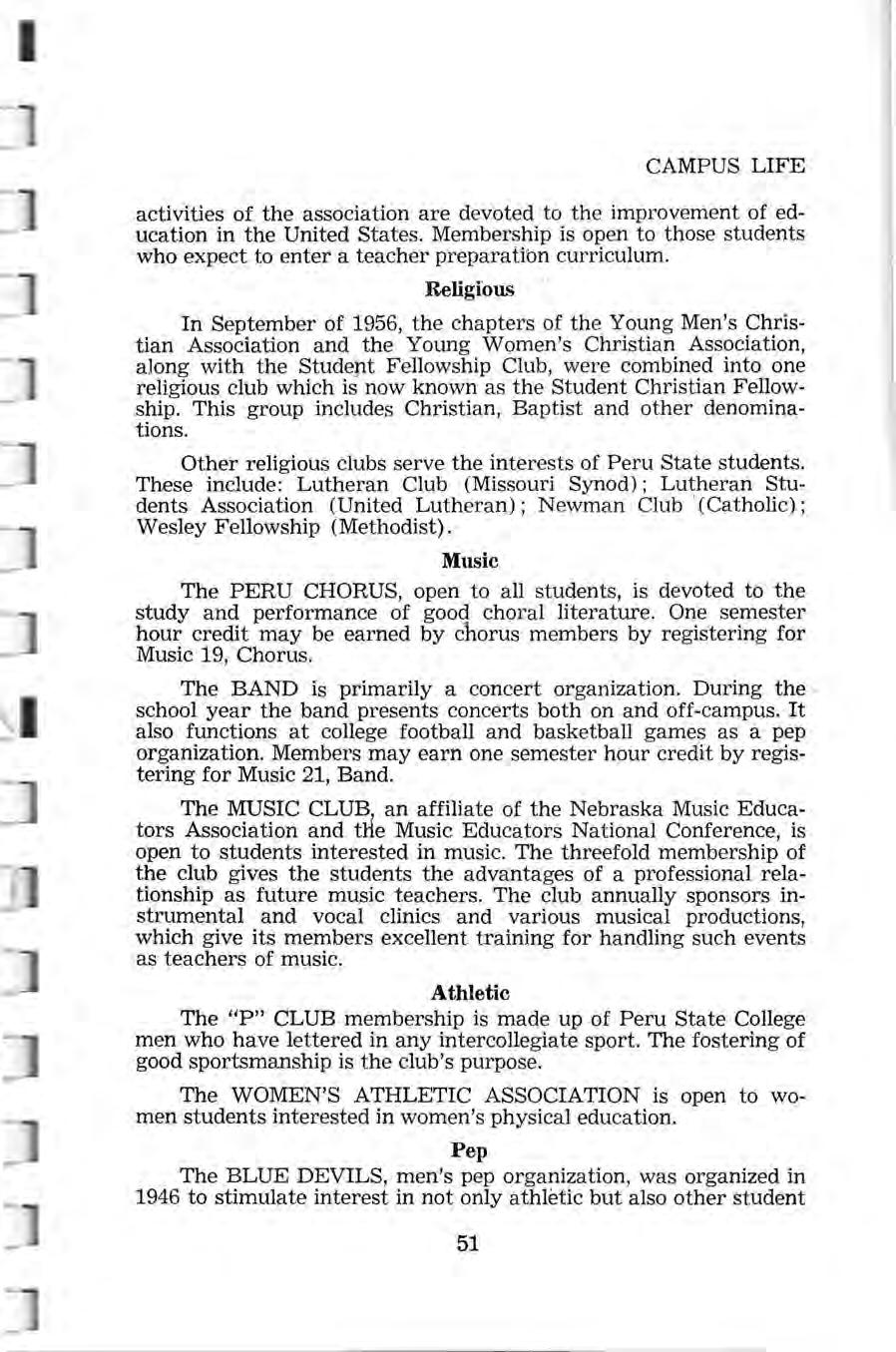
Other religious clubs serve the interests of Peru State students. These include: Lutheran Club (Missouri Synod); Lutheran Students Association (United Lutheran); Newman Club ' (Catholic); Wesley Fellowship (Methodist).
The PERU CHORUS, open to all students, is devoted to the study and performance of good choral literature. One semester hour credit may be earned by chorus members by registering for Music 19, Chorus.
The BAND is primarily a concert organization. During the , school year the band presents concerts both on and off-campus. It also functions at college football and basketball games as a pep organization. Members may earn one semester hour credit by registering for Music 21, Band.
The MUSIC CLUB an affiliate of the Nebraska Music Educators Association and ttte Music Educators National Conference, is open to students interested in music. The threefold membership of the club gives the students the advantages of a professional relationship as future music teachers. The club annually sponsors instrumental and vocal clinics and various musical productions, which give its members excellent training for handling such events as teachers of music.
The "P" CLUB membership is made up of Peru State College men who have lettered in any intercollegiate sport. The fostering of good sportsmanship is the club's purpose.
The WOMEN'S ATHLETIC ASSOCIATION is open to women students interested in women's physical education.
The BLUE DEVILS, men's pep organization, was organized in 1946 to stimulate interest in not only athletic but also other student
events. The group honor s the football and basketball sq u ads and their coaches with b a nquets following each season. Second semester freshmen or above may pled ge membership into the organization. In cooperation with the White Angels, women's pep organization, the Blue Devils purchase varsity awards and provide scholarships with the revenue from the concessions at athletic events.
The WHITE ANGELS, women 's pep organization, was organized in 1948 to promote good sportsmanship and school spirit on the campus. Only women with a grade point average of 5 are eligible. A branch club, the CHERUBS, sponsored by the White Angels, was orga nized in 1958 for the same purpose except that all women on the campus are eligible for m embers hip.
ALPHA MU OMEGA, honorary mathematics fraternity, aims to develop and promote interest in the study of mathematics. Students who have or are currently enrolled in analytical geo metry with above average gra des in mathematics are eligible for membership. The monthly meetings, planned and conducted under student leadership, include investigations of subjects of mathematical interest not presented in the classroom. The fraternity is officially reco g niz ed as a branch of th e National Council of Ma thematics Teachers .
EPSILON PI TAU is a na t ional honorary professional industrial arts education and vocational education fraternity. It has as its purpo se to recognize the place of skill, to promote social efficiency, to foster, counsel and reward research in the fields of interest. Members are selected from students of junior or senior standing who have a grade point ave rage of 6.40 in the industrial arts a nd an average gra de of 5 in other fields.
KAPPA DELTA PI, nation a l honorary education fraternity, is open to men and women of junior standing ranking in the upper quintile of the class a nd who sh ow ev idence of a continued interest in the field of education. The organization promotes the hi ghest education ideal s a nd professional spirit among its members.

MU EPSILON NU is a national undergrad uate fraternity in e ducation . The primary purposes of the fraternity are to: bu~ld mor a le amo n g male st udents .who plan to become teachers; bwld meaningful relatio n s hip s ·_ betwfe n st udent s a nd professional e ducators and teachers; provide additional teaching experiences for the members; and stimulate recruitment of co mpetent men to enter the teaching profession.
PHI ALPHA THETA, national honor a ry history fraternity, is open to those of high sc holastic standing who have more than
twelve hours of history. It is dedicated to the promotion of scholarship and professional spirit in the fie)d of ,history.
SIGMA TAU DELTA, national , hondrary professional English fraternity, promotes the mastery of written expression, encourages worthwhile reading and fosters a spirit of fellowship among students specializing in the English language or literature. Membership is open to students concentrating in EJhglish with high scholastic standing. ·
BETA BETA BETA, professional honorary biology fraternity, is open to juniors and seniors whose field of concentration is biological science. Candidates for membership must be above average in scholarship and must plan to make biology their permanent interest. The fraternity promotes the study of biological problems and creates an interest in the field of biology as a profession.
GAMMA THETA UPSILON, international honorary geographical society, is open to students who hav e hi g h scholastic standing in three membership classes; regular, honorary or associate. The purpose of the society is to: • further professional interest in geography, strengthen student a nd professional training, advance the status of geography and create and administer funds for furthering graduate study and / or research.
WHO'S WHO Among Students in American Universities and Colleges annually determines the number of students with senior standing in the College, who may be selected for this honor. These honorees are selected by a committee of students and faculty on the basis of scholarship; leadership and participation in academic and extracurricular activities; citizenship and service to the College; and promise of future usefulness in business and society.
The Pedagogian is the official college newspaper. It is published weekly during the academic year under the supervision of the journalism instructor. Although contributions are welcomed, the majority of the writing and editing is done by the students in journalism classes. The purposes of the Pedagogian are to print the school news and to serve as a laboratory for journalism students. Emphasis is placed on training that will enable students to manage school newspapers. Much of the work leading to a field of concentration or a related field in journalism is done on the newspaper and the yearbook.
The Peruvian is the college yearbook. It is published in May by the Peruvian staff under the direction of the faculty adviser. Although any student may serve on the staff, most of the work is
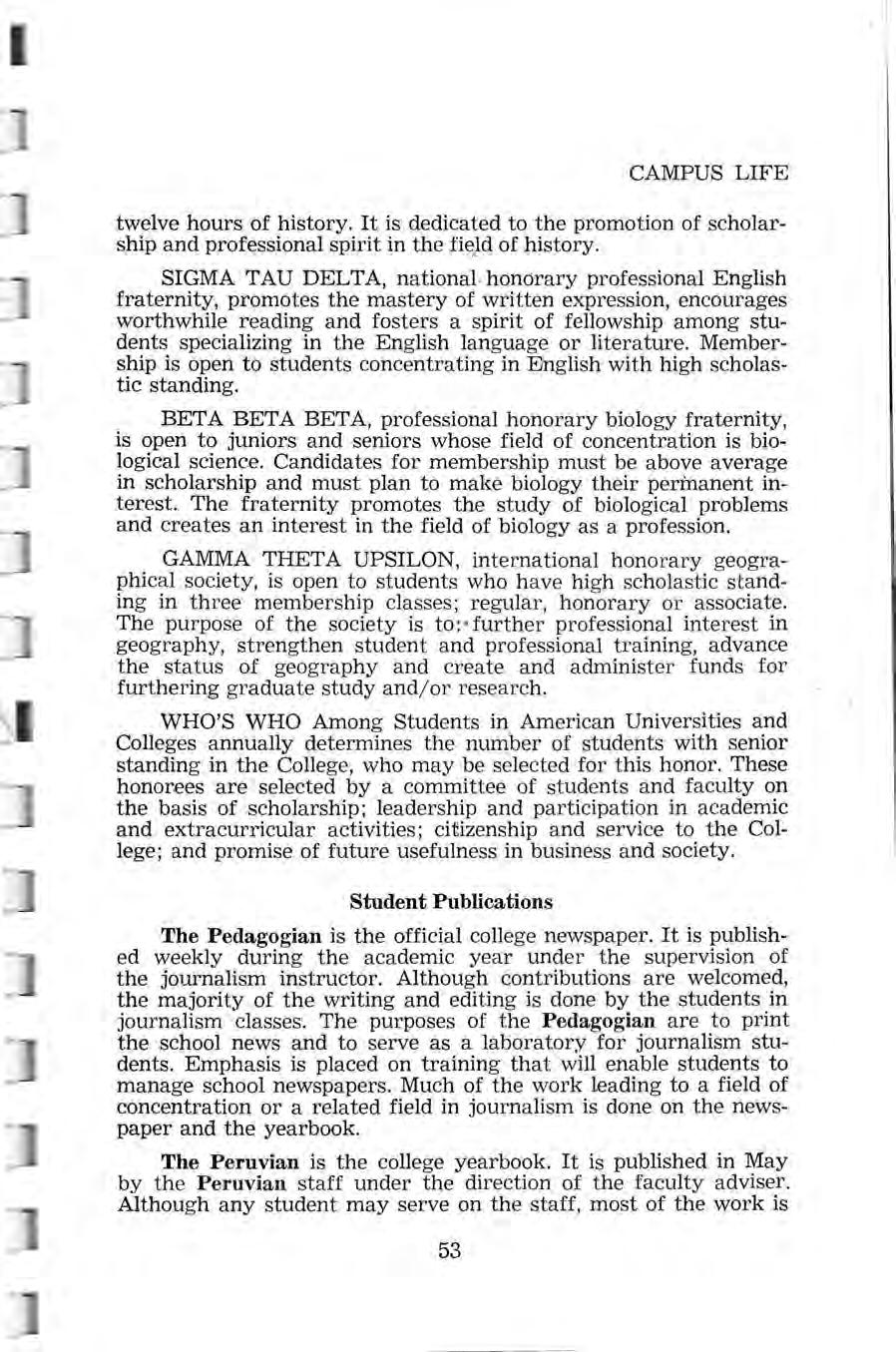
done by st udents e nroll e d in ye a rbook ed iting. Th e Peruvian attempts to g ive a fait hful r ec ord of the year in pi ct ures and print. The Peruvian also serves as a labo r atory for journ a li s m students and for those wishing to learn yearbook man age ment.
Handbook for Peru Stat.ers is published in lat e s ummer by the Student Governin g Association und er the dir ection of the Offi ce of Special Services. The publicat ion serves as a g uid e to ca mpu s livin g for all freshmen a nd othet n e w students.
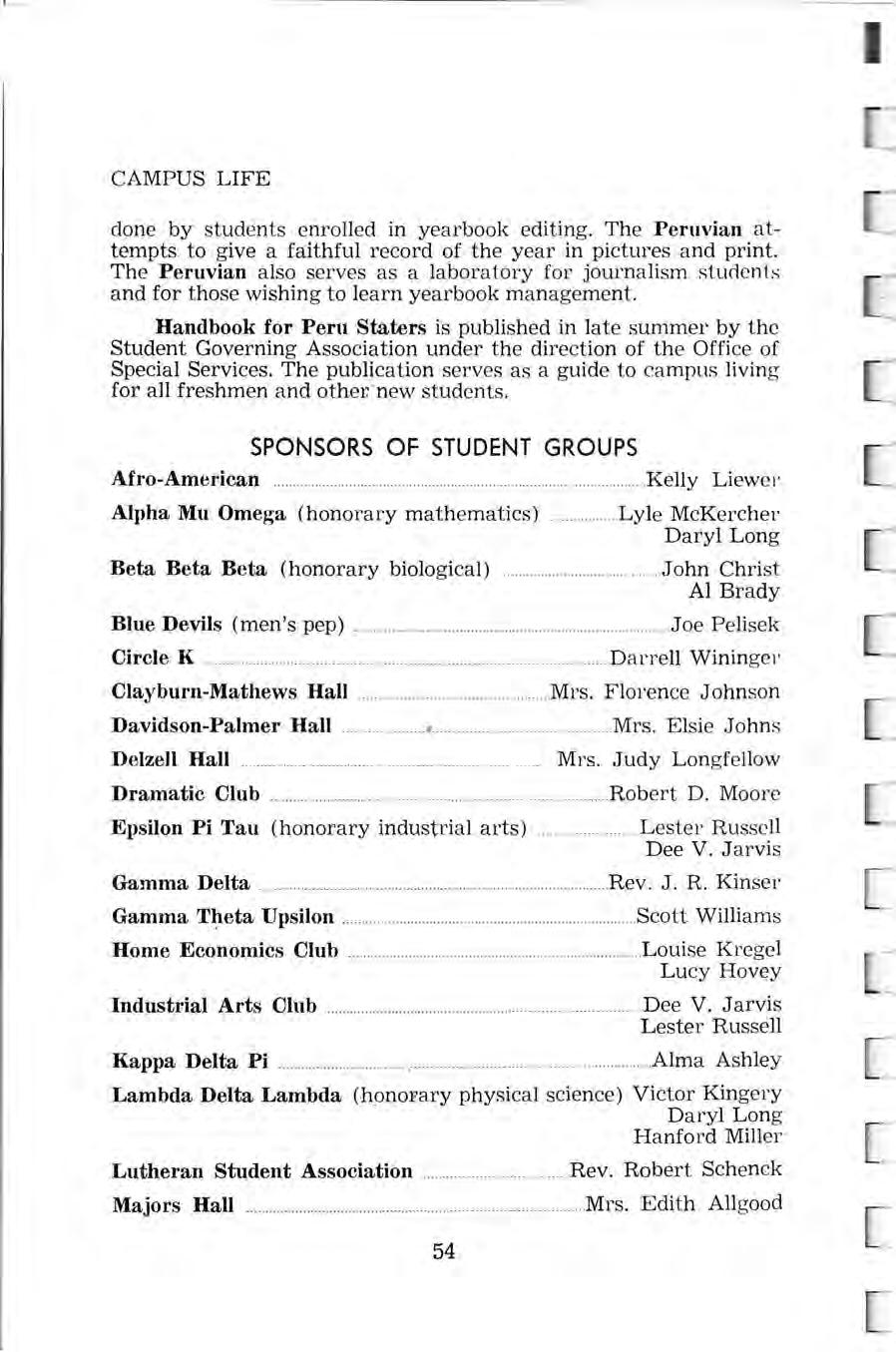
Afro-American ..... .Kelly Liewer
Alpha Mu Omega (honorary math e matics) Lyl e McK e rcher
Daryl Lon g
Beta Beta Beta (honorary biological) .. ... ...... .. John Christ Al Br a dy
Blue Devils (men's pep) ...... Joe Pelisek
Circle K . . D arre ll Wininger
Clayburn-Mathew s Hall
Davidson-Palmer Hall
Florence J ohn so n
Elsie Johns
Delzell Hall Mrs. Judy Lon g fellow
Dramatic Club
er t D . Moor e
Epsilon Pi Tau (honorary industrial ar ts) Lester Russell Dee V . J arv is
Gamma Delta
Gamma TJ:ieta Upsilon
Home Economics Club
Industrial Arts Club
Kappa Delta Pi
J. R. Kinse r
Scott Williams Loui se Kregel Lu cy Hovey D ee V J arv is Lester Russell .... Alma Ashley
Lambda Delta Lambda (h 9 n0 Far y physical scie nc e ) Victor Kin ge ry
Daryl Lon g
H a nfo r d Miller
Lutheran Student Association
Majors Hall
Rev. Robert Sch e n c k
Mrs. Edith Allgood
Morgan Hall . . Mrs. Marie Beckley
Mu Epsilon Nu (education fraternity for men) . .... .. Rex Shelley
Music Educators National Conference •- Gilbert Wilson
Newman Club.
Peru Social Science Society
Peru State Education Association
. Jerome Stemper
. George Schottenhamel
Lyle Strom
Harold Johnson
Lloyd Kite
Phi Alpha Theta (honorary history) George Schottenhamel
Phi Beta Lambda (honorary business)
Sigma Tau Delta (honorary English)

Student Center Board .. ... . ,:a ·
Student Governing Association .. .. ... .. ..
United Christian Campus Ministries
Lyle Strom ..... . . David Gunderson
Jerry Cox
Silas Summers
Donnell Cattle
.. Darrell Wininger
Tom Fitzgerald
... .. .. Father McCabe
Rev. James Arnot
Rev. James Bragan
Rev. Robert Linder
White Angels and Cherubs (women's pep) _____ Frieda Rowoldt
Women's Athletic Association
Senior Class
Junior Class
Sophomore Class
Freshman Class
. Bonnie Rutz
George Schottenhamel
.. Sarni Kaloti
. . Donald Miller
Thomas Scherer
.
The College is supported by the State of Nebraska for the purpose of meeting the educational needs at the college level of the citizens of the state. Its chief purpose is to prepare men and women to serve in the elementary and secondary schools as teachers and for hi g her study in preparation as supervisors and administrators. The College also provides a general liberal education, pre-professio n a l education or terminal vocational education, culminating in a Bachelor of Arts or Ba c helor of Science de gree.
The instructional programs of the College consist of seven interrelated divisional programs under the captions of:
Division of Education
Division of Fine Arts
Divi s ion of Health and Physical Education
Division of Hi sto ry and Social Science
Division of Language Arts
Division of Pract ical Arts
Divi s ion of Science a nd Mathematics
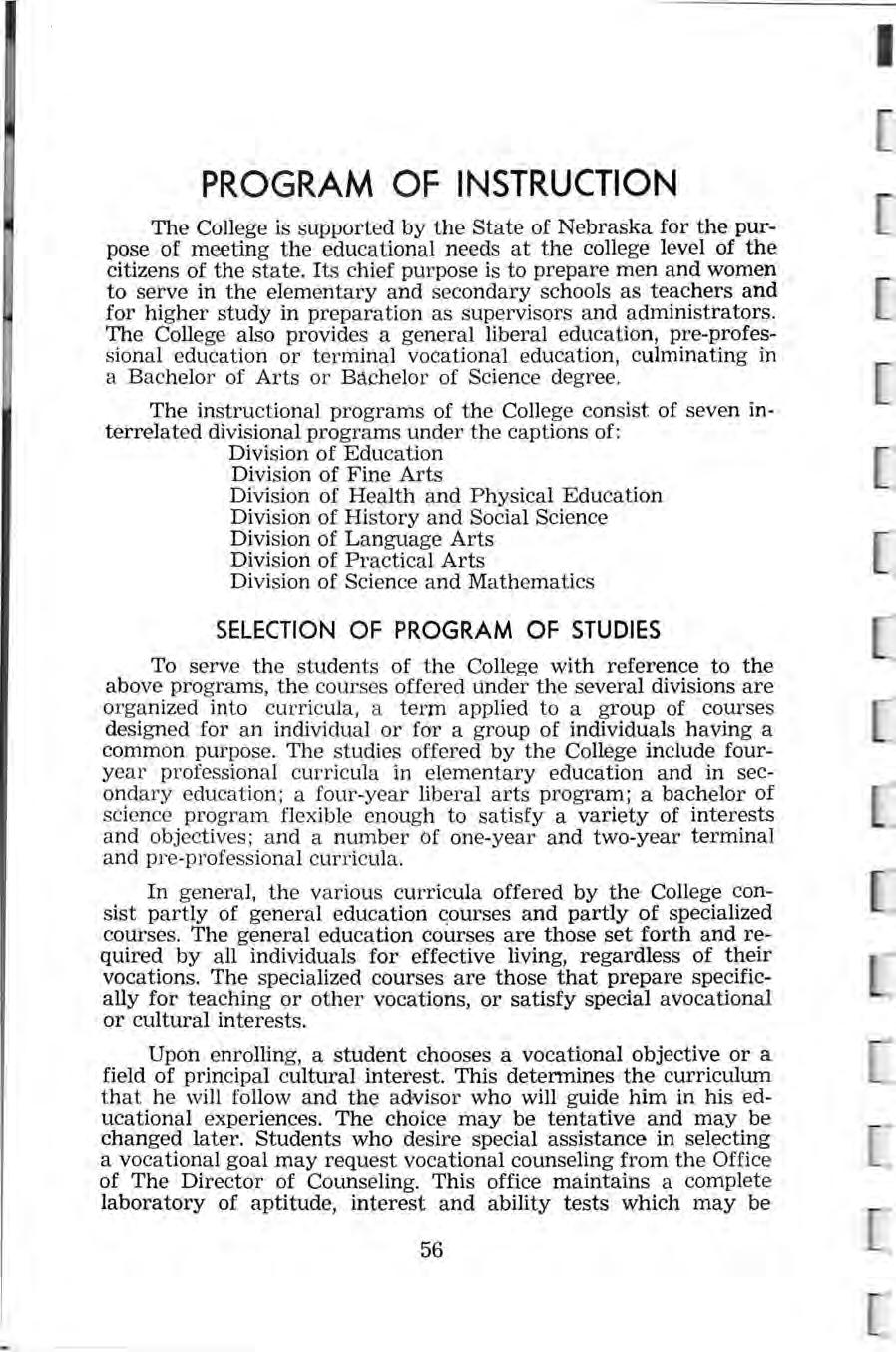
To serve the students of the College with reference to the above programs, the co ur ses offered under the several divisions are organized into c u rricu la, a t erm applied to a group of courses design ed for an individual or for a gro up of individuals having a common purpose. The studies offered by the College include fouryear professional curricul a in elementary education and in secondary education; a fo ur- year liberal arts program; a bachelor of scie n ce program flexible e nou g h to satisfy a variety of interests and objec tiv es; and a numb er bf one-year and two-year terminal and pre-professional cur r icula .
In ge neral, the various curricula offered by the College consist partly of general education courses and partly of specialized courses. The general education courses are those set forth and required by all individuals for effective living, regardless of their vocations. The specialized courses are those that prepare specifically for teachin g or other vocations, or satisfy special avocational or cultural interests.
Upon enrolling, a student chooses a vocational objective or a field of principal cultural- intetest . This determines the curriculum that he will follow and fae advisor who will guide him in his educational experiences. The choice may be tentative and may be changed later. Students who desire special assistance in selecting a vocational goal may request vocational counseling from the Offi ce of The Director of Counseling. This office maintains a complete laboratory of aptitude, interest and ability tests which may be
administered to a student. Students may find the interpretation of the results of these tests extremely vaJuable in making a vocational choice. ' ' ·
Students who are undecided in rega~d to a vocational and/or educational goal may register in a general category. These students are urged to use the Guidance and Counseling services during the first semester to assist in the above decisions.
Students who elect to change a field of concentration at a point beyond the sophomore year should be aware of the probability of their graduation date being extended. Also, \t may be necessary for the student to follow the requirements in the current bulletin rather than the one in effect at the time of matriculation.
It is imperative that Academic Progress forms be maintained to guide and record the student's progress toward his graduation. Two copies are to be maintained : one by the Registrar's Office and the second by the student and his counselor. This is necessary for effective advisement, registration, plus the mutual protection of the student and the college. The accuracy of each registration and the checking of all requirements are the final responsibility of the student.
In general, students will follow the graduation requirements as outlined in the bulletin current at the time of matriculation. Students whose progress toward a degree has been irregular or interrupted to a point of five years or more since the date of matriculation will meet the requirements of graduation in the most recent bulletin. Students for whom a progress sheet has been made and who are making normal progress toward a degree will continue in their original bulletin.

This is a comprehensive eight-hour examination required of all students seeking endorsement for a teaching certificate from the College. It evaluates the prospective teacher's preparation in the field of general education, professional education and major area of concentration.
The College is authorized by law and rules of the Governing Board of State Colleges to issue the following degrees:
Bachelor of Arts in Education (A.B. in Educ.) This degree is given to candidates whose field of concentration is in one of the following divisions: Fine Arts, History and Social Science or Language Arts.
Bachelor of Fine Arts in Education (B.F.A . in Educ.) Art and / or Music.
Bachelor of Science in Education (B.S. in Educ.) This degree is given to candidates whose field of concentration is in one of the following divisions: Health and Physical Education, Practical Arts, Mathematics and Science, Elementary Education or Library Science.
Bachelor of Arts (A.B.) This degree is given to candidates without regard to field of concentration and without the professional education requirements .
Bachelor of Science (B.S.) This degree is given to candidates without the professional education and / or the modern language requirement.
Total Hours. A candidate for a degree must earn 125 semester hours of course credits.
Upper-Division Credit. The student must have earned at least 40 hours of upper-division credit (300 and 400 series) All 400 courses with a suffix of G carry either graduate or undergraduate credit .
Grade Point Average. A grad e average of 5.25 is required for all degre es in Te ac her Education An average of 5.00 is required for other degrees.
Resident Credit. A student who has not been enrolled in on-campus classes within the ten y ea rs prior to application for graduation, must earn a minimum of nine hours of on-campus credit in order to qualify for a degree. The resident credit must be to the extent of 24 hours of the last 30 hours for a degree This resident requirement may be waived in cases where any of the required resident credit is earned in any one of the four State Colleges.
Professional School Resid ~11ee Credit. Und er certain circumstances in which a pre-professional stud ent has successfu lly complet e d three years of training at P eru State College in a specific, approved program, h e m a y transf e r to an accre dited profess ional sc hool during his fourth ye a r, and qualify for the bacca laureate degr ee, provid ed he meets all other graduation req uir em e nts
Correspondence and Extension Credit. Not more than one-fourth of the total requirements for a degree. may be satisfied through correspondence study and extension classes, and of tl'\is nuri;1 ber the correspondence study alone cannot exceed one-ei ghth of the t o tal hours Study center or off-campus classes will be honored as r es ident cre dit if conducted by this College.
Fl!lldi, of Concentration. Each candidate (except degrees in elementary educat ion) must complete in addition to the general education requirements, a field of concentration along with supporting study in terms of th e educational objective.

Application for Degrees. Each candidate upon enrolling for the final course requirements in a semester or term, shall complete an application through the Registrar's Office setting forth the degree, fields of concentration, status as to scholarship, upper-division hours, counselor approval and payment of fee for graduation. This application must be completed within the first six weeks of the semester or within the first three weeks ·of the first summer session.
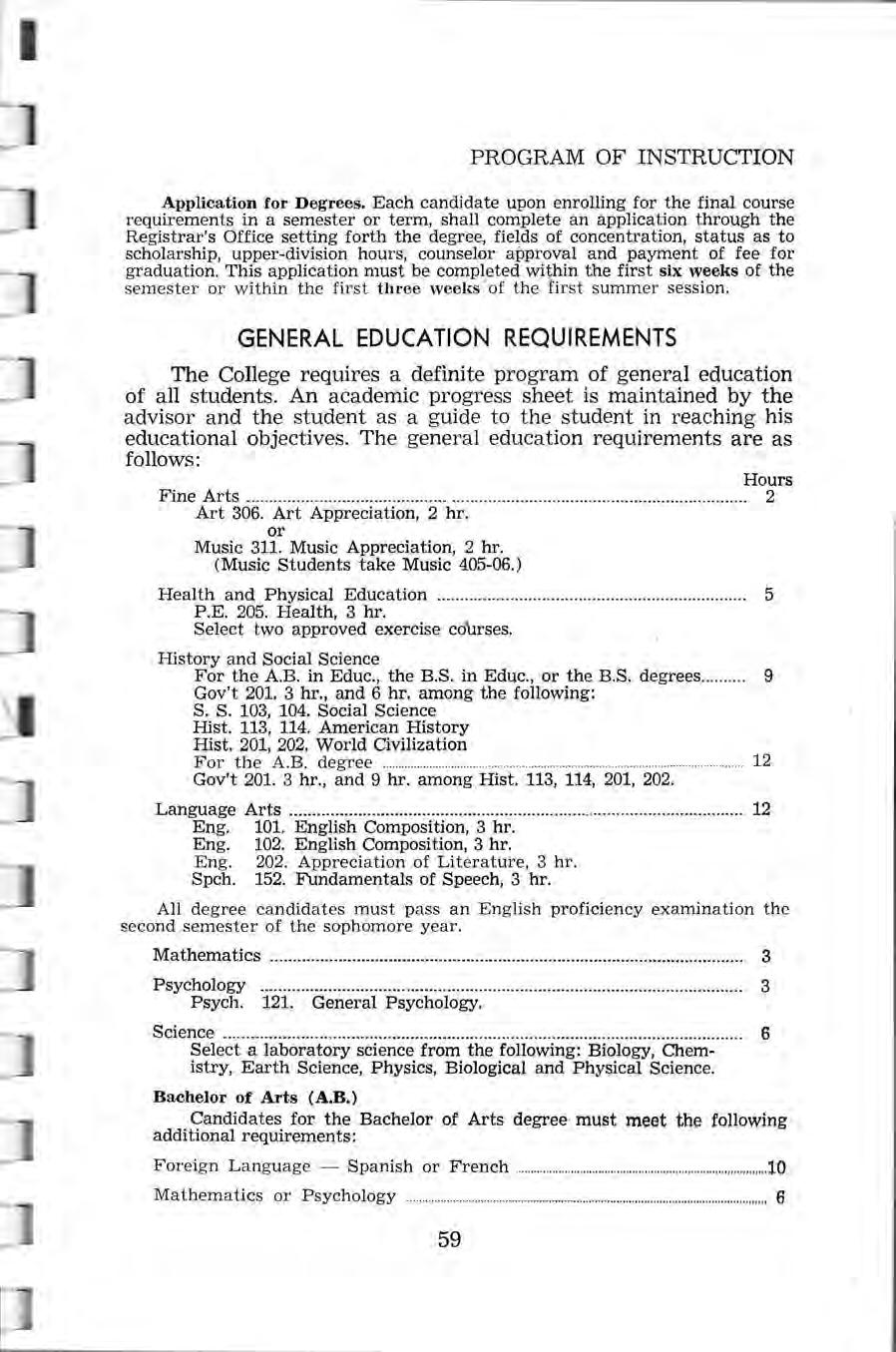
The College requires a definite program of general education of all students. An academic progress sheet is maintained by the advisor and the student as a guide to the student in reaching his educational objectives. The general education requirements are as
Upon completion of the recommended curriculum including general education, professional education, a field of concentration , supporting study in terms of the educational objective plus completion of the National Teacher Examinations the student will earn a Bachelor of Fine Arts, a Bachelor of Arts or a Bachelor of Science in Education and upon recommendation of the College , will qualify for a Teaching Certificate.
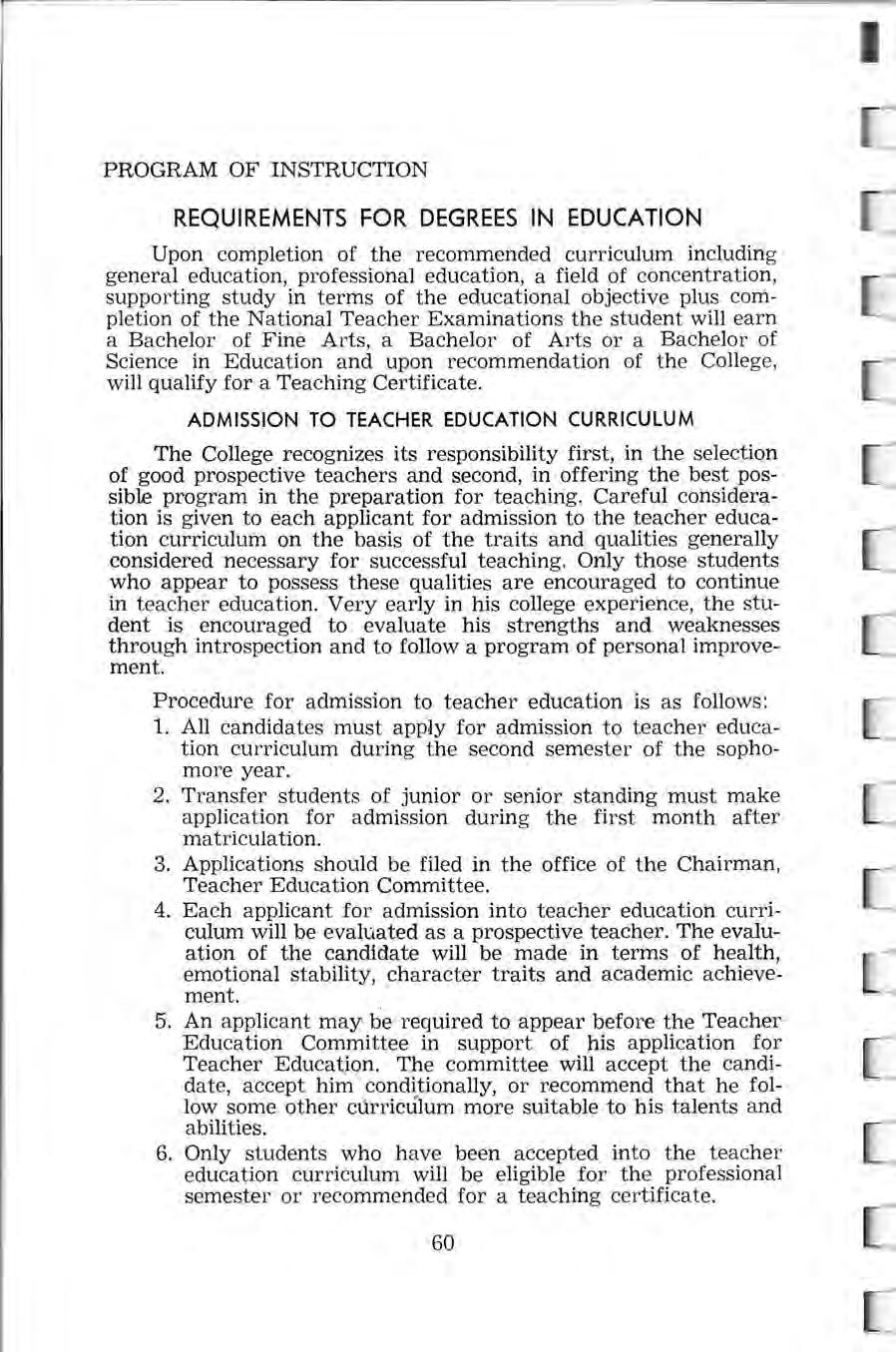
The College recognizes its responsibility first, in the selection of good pmspective teachers and second, in offering the best possible program in the preparation for teaching. Careful consideration is given to each applicant for admission to the teacher education curriculum on the basis of the traits and qualities generally considered necessary for successful teaching. Only those students who appear to possess these qualities are encouraged to continue in teacher education. Very early in his college experience, the student is encouraged to evaluate his strengths and weaknesses through introspection and to follow a program of personal improvement.
Procedure for admission to teacher education is as follows:
1. All candidates must apply for admission to teacher education curriculum during the second semester of the sophomore year.
2. Transfer students of junior or senior standing must make application for admission during the first month after matriculation.
3. Applications should be filed in the office of the Chairman , Teacher Education Committee.
4. Each applicant for admission into teacher education curriculum will be evaluated as a prospective teacher. The evaluation of the candidate will be made in terms of health, emotional stability, character traits and academic achievement. ·
5. An applicant m a y be required to appear before the Teacher Education Committee in support of his application for Teacher EducatJon. The committee will accept the candidate, accept him · conditionally, or recommend that he follow some other curriculum more suitable to his talents and abilities.
6. Only students who have been accepted into the teacher education curriculum will be eligible for the professional semester or recommended for a teaching ce r tificate.
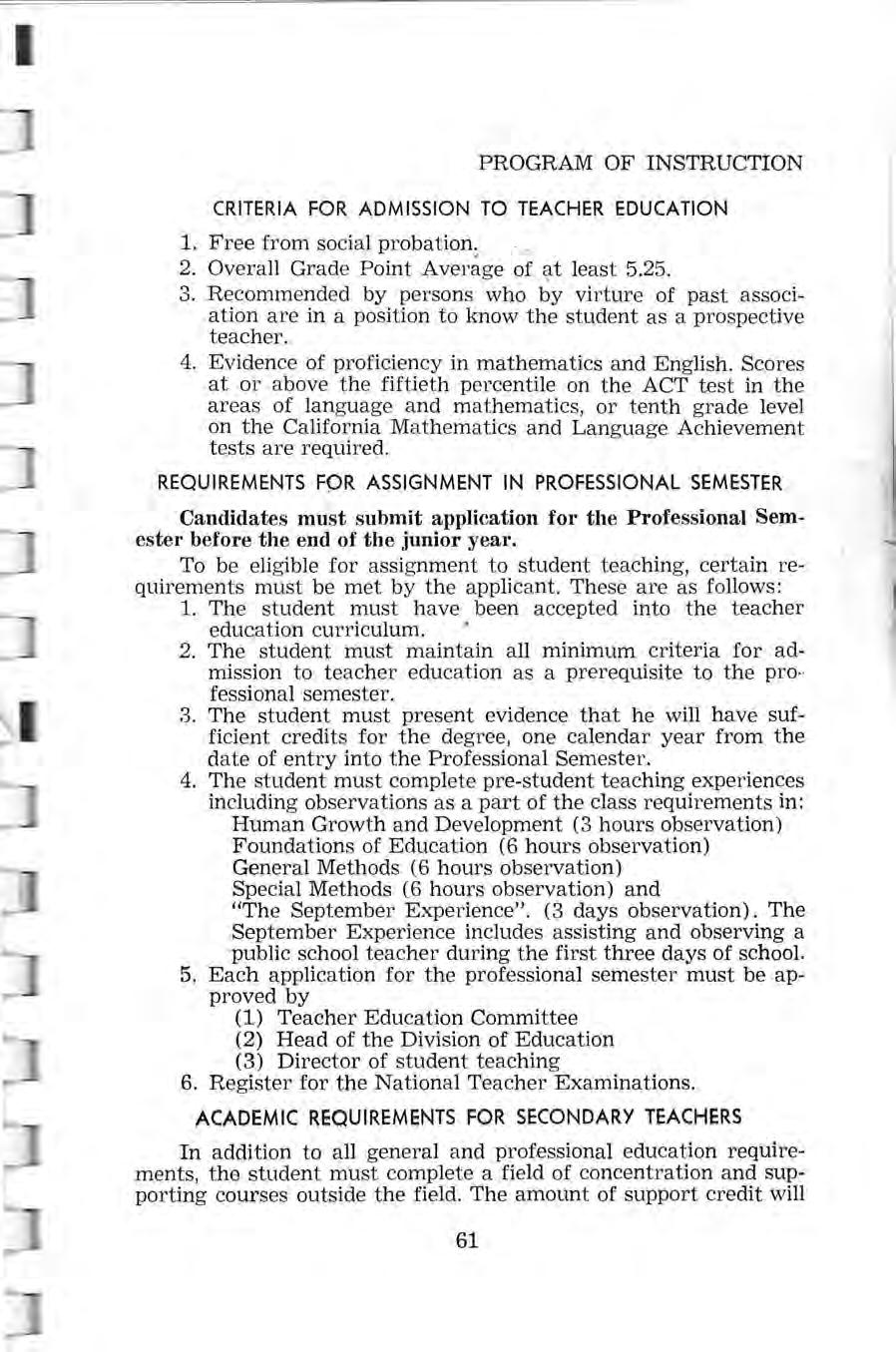
1. Free from social probation. ,
2. Overall Grad e Point Aver a ge of. at least 5.25.
3. Recommended by persons . who by virture of past association are in a position to know the student as a prospective teacher
4. Evidence of proficiency in mathematics and English. Scores at or above the fiftieth percentile on the ACT test in the areas of lan g uage and m a thematics, or tenth grade level on the California Ma them a tics and Language Achievement tests are required.
Candidates ml~st submit application for the Professional Semester before the end of the junior year.
To be eli g ible for assignment to student teaching, certain requirements must b~ met by the applicant. These ar.e as follows:
1. The student must have been accepted into the teacher education curriculum. •
2. The student must maintain all minimum criteria for admission to teacher education as a prerequisite to the pro- • fessional semester.
3. The student must present evidence that he will have sufficient credits for the degree, one calendar year from the date of entry into the Professional Semester.
4. The student must complete pre-student teaching experiences including observations as a part of the class requirements in:
Human Growth and Development (3 hours observation)
Foundations of Education (6 hours observation)
General Methods (6 hours observation) Special Methods (6 hours observation) and "The September Experience". (3 days observation). The September Experience includes assisting and observing a ·public school teacher during the first three days of school.
5. Each application for the professional semester must be approved by
(1) Teacher Education Committee
(2) Head of the Division of Education
(3) Director of student teaching
6. Register for the National Teacher Examinations.
In addition to all general and professional education requirements, the student must complete a field of concentration and supporting courses outside the field. The amount of support credit will
depend upon the credit hours available beyond the field requirements.
Degree candidates seeking a teaching endorsement at the secondary level are further advised that, to teach in a field out s ide the field of concentration in a school accredited by the North Central Association, twenty-four hours are required in most fields. This latter condition does not imply that the candidate will qualify for a second endorsement

The following are fields of concentration at the secondary le vel offered at Peru State College:
Art Biology
Business Chemistry
Coaching
Driver Education
Earth Science
Economics
English
Geography
History
Homemaking
(General)
Industrial Arts
Instrumental Music
Journalism
Library Science
Mathematics
Music (General)
Physical Education
Physical Science
Science (General)
Social Sciences
Sociology
Speech
Vocal Music
.
In addition to all general and professional education requirements, students must complete the following academic requirements in order to provide a broad general education necessary for elementary teachers. The candidate must earn 15 hours in three areas and 24 hours in one additional area commonly taught in the elementary schools. These "areas" represent the various divisions of the College .
Students who pursue an area of concentration in Elementary Education may, by careful selection of their pro gram, receive endorsement in (1) School Librarian, (2) Educable Mentally Handicapped, or (3) Trainable Mentally Handicapped.
During the Professional Semester the student's time is divided between study in professional courses and full-time student teaching. It is imperative that the pro g ram of studies for all sophomore and junior students be made with the greatest ca r e and consideration for the time that these students will be in the Profe ssional Semester of their senior year. Cou r ses in the Professional Semester are to be taken only in the senior year.

The Professional Semester at the elementary level consists of the following program:
The Professional Semester at the secondary level consists of the following program:
(Adjustments will be made in the board and room charges for · the period the student teacher is off-campus.)
Information regarding teaching certificates may be obtained in the Registrar's Office or from the Director of Teacher Certification, State Capitol, Lincoln, Nebraska, 68509.
All applicants are hereby advised that meeting academio or 63
graduation requirement s does not automatically complete requirements for institutional endorsement.
According to Nebr aska Te ac her Certification, the College h as the respo nsibility of e ndorsin g qualified persons for certi fic a te s. This responsibility has been delegated to the Administrative Council. An endorsement indi cates the grade level, subject field or area of specia lization for which the teacher was especially prepared and implies that the applicant h as met appropriate sta nd a rds of scholarship, sound mental and physical he a lth, good citizenship a nd moral character.

In order to facilitate the action of the Administrative Council it is n ecessay that all applications be submitted not le ss than three ( 3 ) weeks prior to the end of the term and the applicant must have completed the Nation a l Te ac h er Examinations.
The Bachelor of Arts degree is conferred on ca ndid ates following a four year curri culum in lib era l arts without regard to the field of concentration. Candidates must complete the general education requirements plus a field of co ncentration .
The Bachelor of Science degree is conferred on candidates following a four year pro g ram other than liberal arts or teacher education. Candidates must comp lete the general education and field of co ncentration requirements.
Most professional schools require for entrance two or more years of college credit in ge n eral education or basic liberal arts courses which vary only slightly from one profession to another. Since such work is required for the professional curr icu la in training teacher s, this Co ll ege offers a var ie ty of courses that serv e as pre-professional education. Suggested among these are those for prospective doctors, de ntists, pharmacists, optometrists, nurs es, veterinarians, law yers, eng ineers, agriculturists, foresters, mortici a ns, business executives, journalists and others. It is almost impossible to list all of the many pre-professiona l curr icu l a. Thi s do es not preclude the availability of other preprofessional courses at Peru State A student following a pre-professional progra m is urged to secure a bulletin from the institution to which he intends to transfer in order that specific requirements will be met. The following are some pre-profe ss ional cur r icula. ,
It should be remembered that there are various programs within agricultur e, and therefore the program must be planned to me et l ater n eeds. Consult the catalog of the professional school you plan to attend to make certain you meet the pre-agriculture requirements : Grades of less than average will generally not transfer to professional schools. The following program is suggested for the first sixty hours:
The requirements for different forestry schools vary. Early in the preforestry program the student should consult the catalog of the college he plans to attend later. Grades of below average will probably not transfer. The plan below is quite general.
Students interested in the study of law should examine carefully the requirements for admission into the law college to which they expect to transfer. Some law colleges require the baccalaureate degree for admission, some require three years of general college, and oth rs require only two years for admission.
The following program of studies is designed to meet the above various requirements. Following the completion of three years at Peru and the successful completion of one year in an accredited law college, a student may be awarded the A.B. degree.
Tqe pre-medical student should plan to become a candidate for the liberal arts degree with a general science major. He is also advised to sample all the humanities and obtain a well rounded program. Only superior students may hope to be accepted by medical schools. Personality and reputation are important factors which may be more significant than merely meeting minimum requirements. Few candidates are accepted without the A.B. degree. What is said regarding pre-medicine is also true with pre-dental programs except that the A.B. degree at present is not an absolute prerequisite. Below is a suggested program for both programs, but the student is advised to secure a catalog from the professional school he expects to attend, as individual schools vary in requirements. Admission tests are required of all applicants, and are administered by the Educational Testing Service at least one year before application is made.

Some colleges of nursing require two years (60 semester hours) of prenursing, others require less. Students following a pre-nursing curriculum should know the requirements of the particular school of nursing to which they will transfer. The program below, based on two semesters and one summer, will meet the requirements to enter the University of Nebraska School of Nursing.
This
Restricted electives from the following areas: business, economics, English, fine arts, foreign languages, history, philosophy, psychology and speech. Examine the catalog of the college you expect to attend.
This program is in cooperation with the Veterans Administration Center Hospital at Wadsworth, Kansas . Following graduation with a Bachelor of Scil:)nce in Education degree with a field of concentration in Industrial Arts, the student spends ten weeks at the hospital for their affiliation with free board and room. Upon successful completion of the internship, the student would be eligi ble for G.S. 6 Civil Service rating. Details of the program may be obtained from , the Head of the Division of Practical Arts. 0 ,
'
Students who are unable to attend college four years or more and wish to prepare for vocations requiring less time in preparation will find a variety of educational opportunities in this College. There are increasing opportunities today for young people in the occupational area classified as semi-professional Examples of these are Medical Technology and X-Ray Technology which are described below A student interestedAn an occupation in the above classification should know the requirements of the particular professional or technical school to which he will transfer. It will then be possible for a counselor to assist him in making a parallel program of the required formal college courses.
To qualify for admission to a college of ' technology, students are required to earn 60 semester hours of .college .credit. The program for the first two years as outlined below meets the above requirement. Also, a student may wish to qualify for a degree in which aa!le M should follow the suggested program for the third year. This, however, should be approved and cleared with the Registrar before following a degree program.


Th e following program is recommended for students who may wish to be X-Ray Technicians a nd also earn a Bachelor of Sc,ience degree. Upon completion of the program s ug ges t e d below, the student may transfer to a college of radiology.
Students who are interested in a secretarial position may follow either the one or the two year program. These programs are described in detail in the Practical Arts instruction section of this Bulletin
Other Terminal Courses
With the assistance of counselors, students may elect courses which will prepare them in one or two years for the following fields of work:
Each teacher should be prepared to employ teacher behaviors which will help the learner:
1. Acquire the greatest possible understanding of himself and an appreciation of his worthiness as a member of society.
2 Acquire understanding and appreciation of persons belonging to social, cultural, and ethnic groups different from his own
3. Acquire to the fullest extent possible for him mastery of the bas ic skills in the use of words and numbers.
4 Acquire a positive attitude toward school and toward the learning process.
5. Acquire the habits and attitudes associated with responsible citizenship.
6. Acquire good health habits and an understanding of the condition necessary for the maintenance of physical and emotional well-being.
7. Acquire opportunity and encouragement to be creative in one or more fields of endeavor.
8. Understand and appreciate human achievement and interdisciplinary nature of the natural sciences, the social scienc e s, the humanities a nd the arts.
9. Understand the opportunities open to him for preparing himself for a productive life and should enable him to take full advantage of these opportunities.
10. To prepare for a world of rapid change and unforeseeable demand s in which continuing education th'i' oughout his adult life should be a normal expectation.
Upon completion of the recommended curriculum , the student will earn a Bachelor of Science in Education degree and upon recommendation of the College, he will qualify for the Nebraska Elementary Certificate

First Semester Eng. 101 English Composition
S.S. 103 Social Science
Geog. 101 Principles of Geography
P E. (Exercise Course)
Speh. 152 Fundamentals of Speech
Requirements
]'Ing. 202 Appreciation of Literature ,,
201 Human Growth ai1d
The following course of study is designed to prepare teachers with an academic major or area of concentration to teach in grades 4, 5, or 6 in schools which incorporate department a lization, team teaching, modul a r scheduling, and/or differentiated staffing patterns Career objectives should be oriented to teaching in town or urban areas.

1. General education requirements .
2. Area of concentration as determined by the field.
3. Profession a l education requirements as stated for elementary education students. (27 hours)
4. Selected electives from the academic field requirements for elementary educ a tion majors These requirements will b e determined on an individual basis.
By meeting the following requirements students may select an area of concentration in Elementary Education with endorsement for teaching the Educable or Trainable mentally handicapped.
This course of study may be elected in lieu of the 24 hour block ordinarily required in elementary education.
423G
Psych. 430 Psych. 431G Psych. 435G
Speh. 152
353
*Twelve hours of elective s which support training in special education must be selected from offerings in Psychology, speech, Physi ca l Education. and/or Practical Arts. Contact th e chairman of the Division of Education or your advisor for specific courses which may be approved as e lectives in this field.
The program for secondary t e achers includes all requirements in general education , an area of concentration, and professional education. The following courses are required of all s tudents preparing to become teachers on the secondary level.
The following curriculum consists of a two year program in Early Childhood Education lea ding to a "Certificate of Competence". The primary purpose of this course of s tudy is to provide supplementary training for personnel in the Head Sta rt program The secondary purpose is to train persons to serve as para-profes sion a ls or teachers a ides in nursery schools and primary grades in elementa ry schools •
The Progra m for E a rly Childhood Education is open to all fu ll o r part time students in the College with the approval of the instructor. All courses carry full credit toward t he Bach e lor of Science in Education degree. The two year course of study prepares p e rsonnel for specific job responsibilities under the direction of a fully qualified teacher. Students are encouraged to set an ultimate career goal of at least the baccalaureate degree.

1. To stimulate and encourage students t; develop lif elong library habits .
2 . To prepare teacher libr aria ns t0 organize a nd ad mini ster a sc hool medi a center.
3. To give young people a better und e rst and in g of the basic library needs and interests of young people.
4. To familiarize st ud ents with basic reference sources, library techniques and sk ill s so that they wil.l be ab l e to satisfy their own needs in higher education.
5. To give fundamental knowledg e of special bibliographic tools and aids us ef ul as guides in selecting media for special readers.
Principles of C l assificatio n and Cataloging
Selection of Library Materia ls
Refer e n ce
Administration of School Libr ar ies
Selection and Preparation of No n Boal{ Materials Library Reading Guidance
e n's Literature
Developmental Reading and Study Skills. 3 hr. On dem an d. A course d esig ned for college students needing improvement in d eve lopin g their reading ability a nd study sk ill s. Emphasis will be placed on im- . proving both comprehension and increased speed of re ad ing Attentionwill be given to remedying weaknesses of individu a l students.
Foundations of Education. 3 hr. Each semester a nd summ er. Pr erequisites: Psych. 121 and 201. The historical and philosophical background and development of educational thought and practice in American public education. Attention is given to contemporary issues and trends along with problems ofj the teaching profession. Pre -student teaching experiences begin in this course
The Disadvantaged Child. 3 hr. An interdisciplinary seminar designed to interpret the influences of culture in regard to the institution of family, school, govern ment , a nd religion. C haracter istics of the disadvantaged child in regard to le arn in g problems a nd lan guage developm ent, he a lth, self-concept, and psychological constructs.
Elementary School Curriculum. 3 hr The elementary school curriculum and its place in meeting the needs of children. Actual experience in planning units of instruction and in examining and eval uating various courses of study and textbooks.
Principles of Early Childhood Education. 3 hr. Theory a nd pr'.3-ctice of early childhood education in the nur sery sc hool a nd primary grades. The course deals with curriculum, program planning, us e of m ater ials and equipment, role of t eac h er, techniques of classroom management, a nd meeting the needs of individual children in the group situation.
Practicum. 1-4 hr. On demand. Pr erequ isi te: Approval of chairman of division. ( Open to lower cl assmen.) Offered as n eeded to provide practical classroom experience of ben efit to prospective teachers, tho se students wishing to serve as teacher aides, stude nts preparing· to serve as assistant teachers or para-professionals.
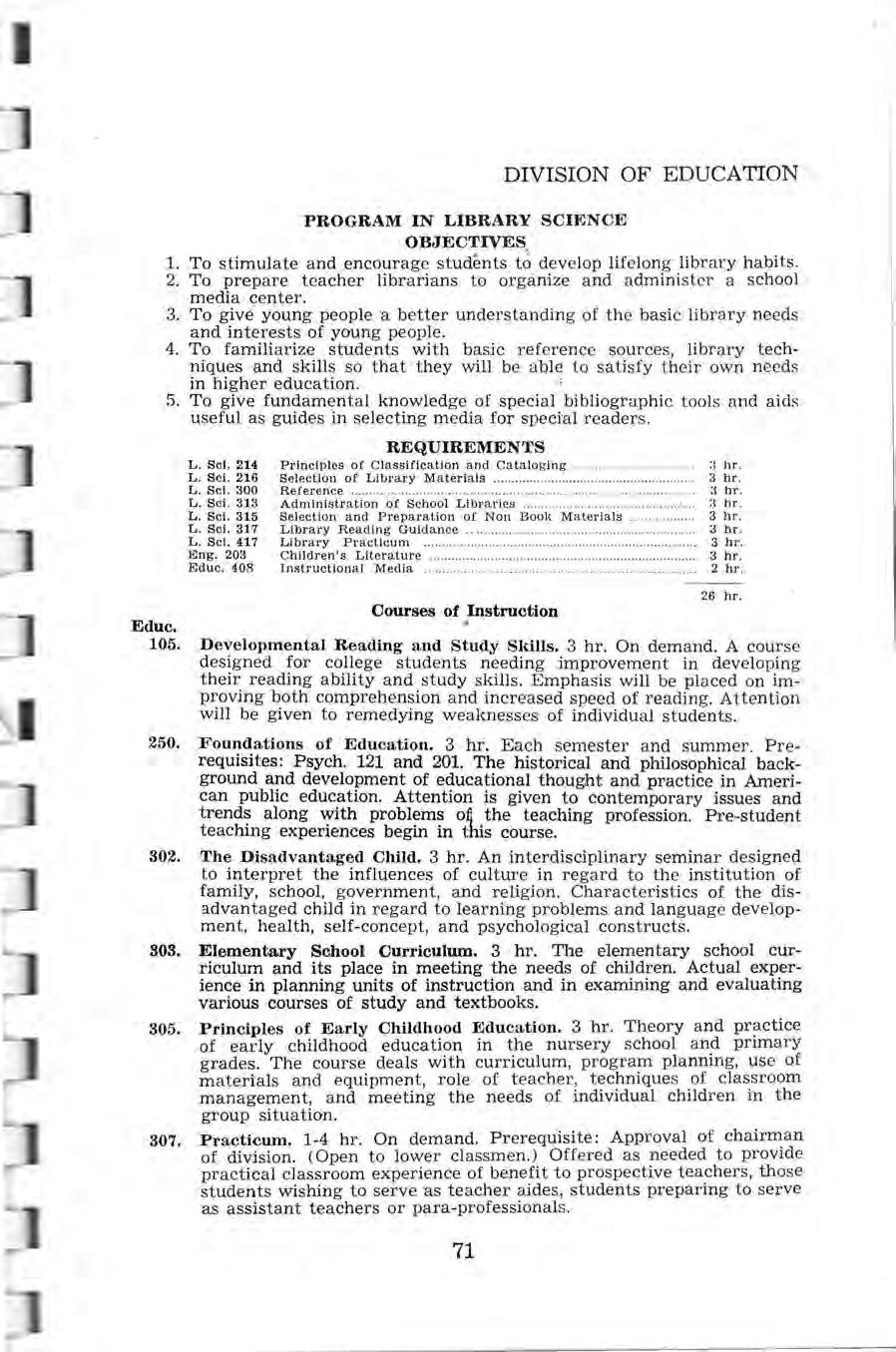
310. Kindergarten Education. 3 hr. Modern methods and study of materials that are us ed in the kindergarten program.
335. Problems in Reading Seminar. 3 hr. Prerequisites: Psych. 121 and 201. A seminar designed to give a mutual understanding of the problems in reading, grades 1 to 12 inclusive.
336. Diagnostic and Remedial Reading. 3 hr. Prerequisite: 15 hours professional education or instructor's permission. Techniques of recognizing and classifying reading problems Laboratory experiences in remedial instruction.
350. The Junior High School. 3 hr. Each semester a nd summer. Prerequisites: Psych . 121 and 201. Emphasis is given to the history, philosophy, purpose, function, organization, management, curriculum developments, administrative problems of the junior .high and the nature and ne eds of junior high pupils.
404. Preparation for Secondary Education. 2 hr. Prerequisite: Approval for professional semester. Emphasis is given to developing knowledge, skills ,and techniques for s uc cessf ul teaching in the second ary schools. A co u rse concer ned with the common elements in secondary ed uc at ion including planning for instruction, classroom control and motivation, seco ndary c urriculum , and problems associated with entering the teaching profession.
405 /Teaching in the Elementary School. 8 hr . Prerequisite: Approval for professional semester. Students will have an opportunity to consider approac h es to in structio n including most subjects commonly taught in the e lementary school. Concurrently, stude nt s w ill be engaged in developing sk ills and techajques of teaching in the Clinical Teaching Laboratory. (Educ. 406) ·
406. Clinical Teaching Laboratory. 2 hr. Pr ere quisite: Approved for professional semes ter Testing of educational theory a nd techniques und er carefully contro lled conditions. Students h ave an opportunity to develop a nd refine te:aching sk ills, through the use of si mulation, microteaching and v id eotapi n g, teacher self-appra isal mod e ls , technical skills of teaching labor atory, and preparation of in str u ct ional materials.

In s tructional Media. 2 hr. Each semester and summer. Demonstration and l aboratory pract ic e wit h In structio n al Media used in the classroom a nd school system includin g: motion picture, film strip, slide and opaq ue projectors; a lso tape recorders, record players,
Gclosed circuit television a nd video tape recorder.
Preparation of Instruction~! Materials. _2 h~. On demand. Prerequisite: Educ. 408. Advanced techniques a nd skills m th e preparat10n of classroom in str u ctio nal materials including (1) 35 mm -~sijdes, (2) super 8 mm motion pictures, (3) film strips, (4) a udiot apes keyed to visual materials, (5) mqd ~ mock-ups, and diaramas a nd (6) c.losed--Gircuit
TV videotaping. ,~ , ·
410. Student •reaching. s' hr. Each semester. Prerequisites: Psych. 121, 201 and 401; Educ. 3b0 and 405. A practic a l application of principles of le a rning in the classroom. Progress ive induction into full teaching responsibility at the elementary level. Students teach full time for nine weeks. Application for student teaching must be made to the Head of the Divi s ion of Education one semester prior to the semester in which th e st udent de s ires to teach.
410s. Seminar in Student Teaching (Elementary). 4 hr. Summer only. Prerequisites: Two years of successful teaching experience anu 45 hours of co ll ege credit. One of the two years exp~rience must h ave been durin g the past five years or 'two years 'within the past ten years This experience must be certified by the city ··or county f .perintendent of schools with whom the candidate has worked. Thi~ r irse may be substituted for four hours of student teaching credL t • meet the certification requirement. Application should be made .o the Head of the Division of Education 18 weeks prior to registration . .
411. Student Teac-hing. 8 hr Each semester. Prereq ui sit$s: P syc h 121, 201 , 401 and 430; Educ. 404 and 408. Experience in the qpplic" ~ion of sound educational · theory by actually teaching students, in the secondary sc hool. All st ud e n ts w h o in tend to be certified as :seco nd ary teachers a re cautioned that th e courses in the Profe ssion a l S e mester are integrated with st ud e nt teaching and should not .be taken in previous semesters . Application for st udent teaching mu s t be mad e to the Head of the Divi sio n of Education one semester prior to the semester in which the student desires to teach. ·
415. Workshop. 1 to 6 hr. Summer only Work on practical educational pro• blems of special interest to the students. The individual or group is expected to make a written report of his finished project which will be duplicated and made available to other members of the Workshop.
440G. School Law for Teachers. 3 hr .• On demand. This cou rse includes a st udy of the origin a nd development of scho6;1 l aw. Emphasis is given to school laws a nd· thej.r app lic a tion .as th ey pertain to classroom teachers in Nebr aska · ·
445G. Principles and Techniques of Supervising Student Teache·rs. 3 hr. On demand. Prereq uisit e: Permission of instructor. A -co u rse designed to prepare teachers to act as supervisors of student teachers. Consideration of new mod el s and practices in teaching will en ab le the teacher to provide l ead ers hip for student teachers and incorporate these techniques in their own classroom.
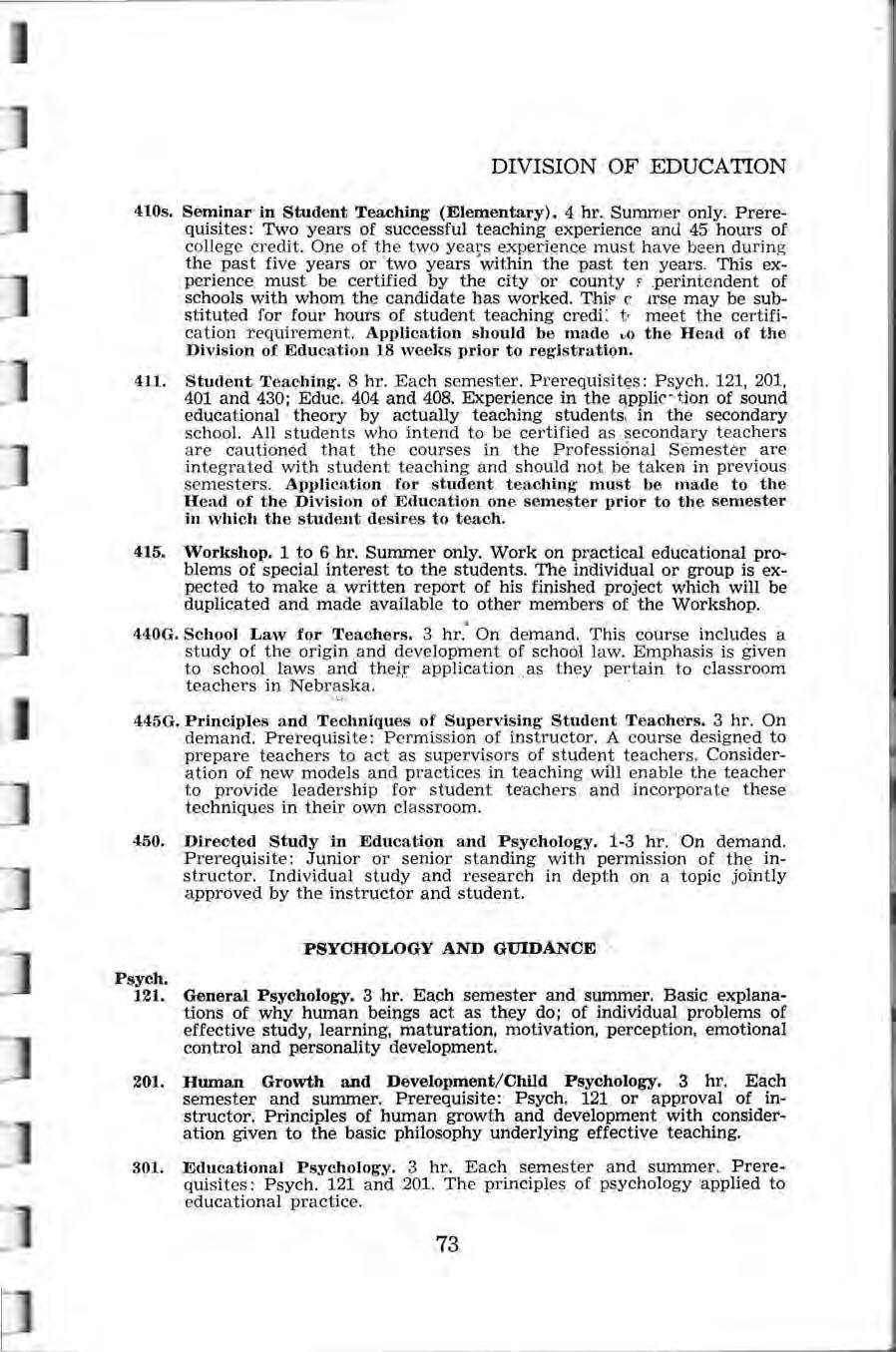
450. Directed Study in Education and Psychology. 1-3 hr : ' On demand. Prerequisite: Junior or senior standing with permission of the instructor. Individu a l study and research in depth on a topic jointly approved by the instructor and student.
121. General Psychology. 3 hr. Each semester and summer. Basic explanations of why human beings act as they do ; of individual problems of effective study, learning, maturation, motivation , p erception, emotional control and personality development.
201. Human Growth and Development/ Child Psychology. 3 hr. Each semester and summer. Prerequisite: Psych . 121 or approval of instructor. Principles of human growth and development with consideration given to the basic philosophy underlying effective teaching.
301. Educational Psychology. 3 hr . Each semester and summer. Prerequisites: Psych. 121 a nd 201. Th e principles of psychology applied to ed ucational practice.
305. Social Psychology. 3 hr. A study of psychological principles applied in social situations, including human interactions, social needs, values, cultural relativism and the effects of group conditions on judgments and attitudes.
325 . Applied Psychology. 3 hr. Prerequisite: Psych 121. Facts and principles from the study of hum a n behavior applied to busin ess, industry, society, professional lif e a nd group processes.
330. Educational Measurements. 2 hr Each semester. Prerequisites: Psych. 121 and 201. Tests with experience in constructin g, administering, interpreting and making use of various evaluative devices.
420G. Introduction to Mental Retardation. 3 hr. Prerequisite: Psych. 201. A study of the social, emo tional, physical and m e nt a l characteristics of the · mentally retarded child. Methods of classifying, diagnosing and treating mentally retard ed children will be discuss ed from the psychological, sociological and educational points of view
421G. Mental Health Hygiene in Education. 3 hr. Prerequisites : Psych. 121 and 201. Home, school and community factors in the hy gie nic adjustment of individuals.
423G. Methods and Materials in the Education of Exceptional Children. 3 hr . Prer:equisite: Psych. 401. A s tudy of the evaluation techniques, characteristics, objectives, curricula, specia l materia ls, facilities a nd techniqu es of in str u ct io n, a long with the development of integrated experience units at the primary, inter mediat e , and pre-vocational le ve ls , Section 1- Th e Educab l e IVfentally Handicapped; Section 2 The Train ab le Mentally Handicapped; Section 3- The Gifted; Section 4The Visually Handicapped .

431G . Psychology of Exceptional Children. 3 hr. Prerequisites: Psych. 121 and 201. A survey course covering the types, characteristics , problems and needs of children who are in some way exceptional.
432G. Principles and Practices of Guidance. 3 hr. Prerequisites: Psych. 121 and 201. A genera l overview of the total guidance program. Principles and techniques employed in establishing and maintaining a n effective guidance program are ~mphasized.
435G. Practicum in the Education · of Exceptional Children. 2-6 hr . Upon demand. Prerequi site: Permission of Instructor a nd/o r Educ. 410, Psych. 407, 420, or 431. Obs e rv at ion, laboratory and teaching exper ience in the following areas of spec ialization; Section 1- Th e Educa ble Mentally Handicapped ; Section 2- The Trainable M e ntally Handicapped; Section 3- The Gi{t~d; S ec tion 4-The Visually Handicapped .
437G. Techniques of Counseiing. 3 hr. Prerequisites: Psych. 121 and 201. Various techniques of counseling and experience in using these techniques .
439G. Administration of a Guidance Program. 2 hr. On demand. Prerequisite : Psych. 330. This course includ es the setting up of a ·g uid ance progrnm and the selecting and directing of the guidance personnel.
The following courses are offered to prepare students to become teacherlibrarians in public schoo ls. Upon completion of' the prescribed program, students may b e endorsed for certification as s.choo) librarians.
214. Principles of Classification and Cataloging. 3 hr. Clas sification according to the Dewey Decimal System and the use of Sear's List of Subject Headings, AL.A. Cataloging Rules and Library of Congress Rul es for D escriptive Cataloging.
216. Selection of Library Mate rial s . 3 hr . Surv ey of aids, principles and standards in se lect ion of books for a school libr ar y, culminating in a b as ic collection eith er elementary or secondary.
300. Reference. 3 hr. Principles and problems in organizing reference sources and materials with special emphasis on the n at ur e, preservation, availability and reference use of primary a nd secondary sources
313. Administration of School Libraries. 3 hr. Principles and procedures involved in the administration of elementary and secondary school libr a ries.

315. Selection and Preparation of Non-Book Materials 3 hr. Th e course will cover the selection, preparation, eva lu at ion , organization, a nd utilization of non-print material s. (Pictures, maps, films, fil mstrips, mic ro-materia l s, recordings, and tra n ~p arencies) .
317. Library Reading Guidance. 3 hr. Principles and practices in reading, characteristics of appropriate books for children of average or exceptional ability, individual and group guidance, development of reading interests.
417. Library Practicum. 3 hr. Each semester a nd summer. Pr e requi sites : L . Sci. 214, 300, 313. A fi e ld of conc entration for teacher- librari ans wit h practicum in circulation, technical processes and reference work,
The history, theory, and practice of art and music are the concerns of the Departments of Art and Music in the Division of Fine Arts.
The Division of Fine Arts endeavors to develop active participation in creative pursuits, which in turn will deve,lop sensitivity and concern for human values, and interest in understanding intellectual, spiritual, and aesthetic ideals.
Courses in Art are designed to:
1. Give the student fundamental knowledge of the History and Theory of Art.
2. Give adequate experiences in• studio techniques to insure some competency in drawing, painting, design , sculpture, ceramics, crafts, and printmaking.
3. Give knowledge of the present-day curriculum and the objectives for teaching in elementary and secondary schools. Methods and techniques for obtaining these objectives are stressed.
4. Give the undergraduate students a background for study on the graduate level.
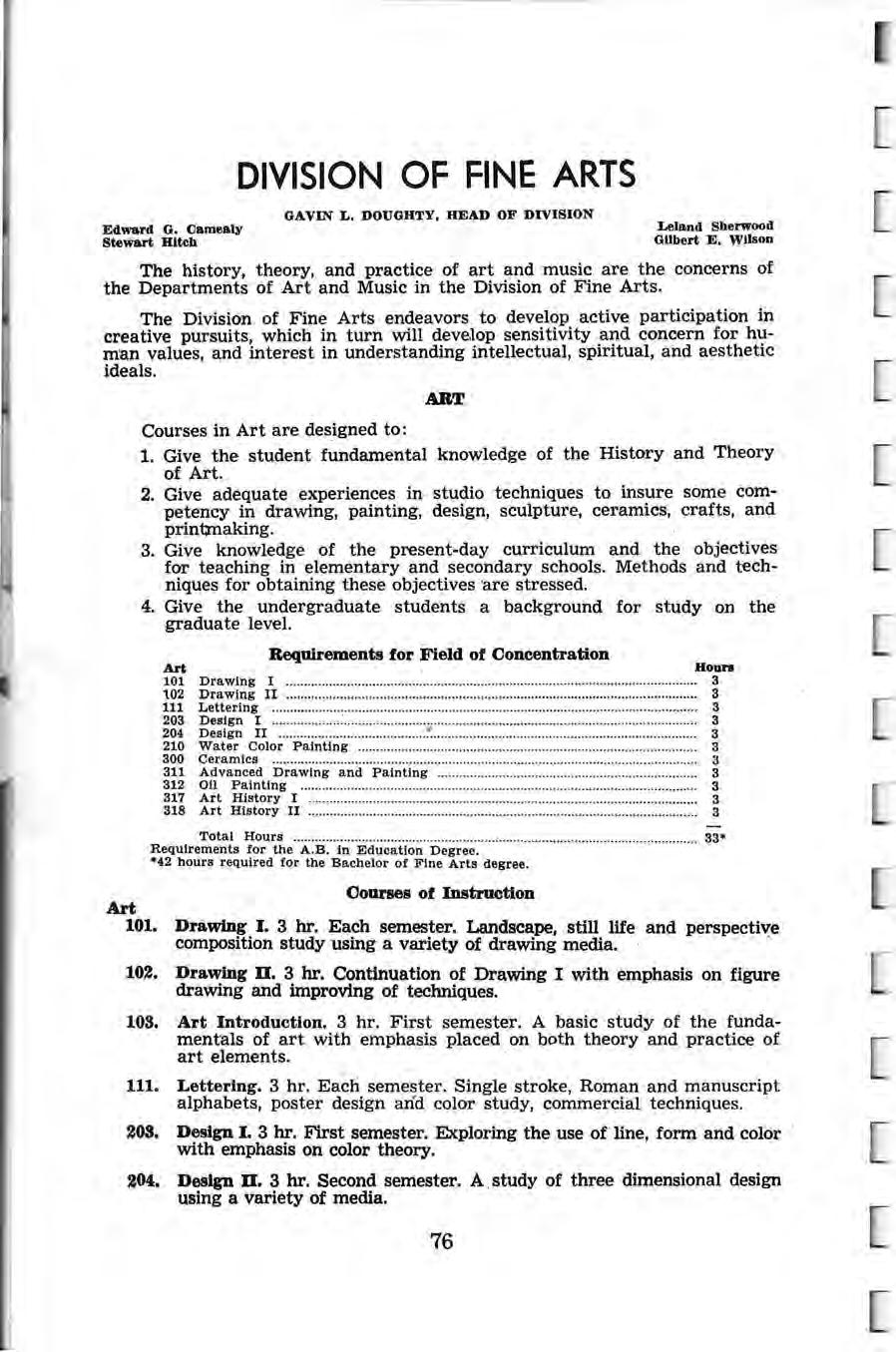
101. Drawing I . 3 hr. Each semester. Landscape, still life and perspectiye composition study using a variety of drawing media. 102. Drawing n. 3 hr. Continuation of Drawing I with emphasis on figure drawing and improving of techniques.
lOS. Art Introduction . 3 hr. First semester. A basic study of the fundamentals of art with emphasis placed on both theory and practice of art elements. 111. Lettering. 3 hr. Each semeste r. Single stroke, Roman and manuscript alphabets, poster des ign and color study, commercial techniques
208. Deslgn I. 3 hr First semester. Exploring the use of line, form and color with emphasis on color theory. 204. Design n. 3 hr. Second semester. A .study of three dimensional design using a variety of media.
210. Water Color Painting. 3 hr. Second semester. Prerequisites : Art 101, 102, 203 a nd consent of instructor. Compositions in color, using opaque and transparent water color.
221. Print Making. 1 hr. Second semester. Hii;tory of th e graphic arts of block printing, etching, lithograph y and ·silk screen printing. Reading on the techniques of each process followed by the making of prints in three or more of the methods.
300. Ceramics. 3 hr. Second semester. Experiences in coil, sla b, and thrown projects. Includes a bas ic study of g l aze preparation a nd clay ana lys is.
305. Methods and Supervision. 2 hr. First semester. Prerequisites: Art 101, 103, and 203 or 204. Study of relation of art education to other school subjects; methods for teac hin g drawing and crafts in the grades a nd the pl a nning of ~rt lessons.
306. Art Appreciation. 2 hr. Each semester. Planned to give some standards of measurement for art. Study of art principles in conn ec tion with crafts, painting, sculpture and architecture.
308. Art Exploration. 3 h r . A s u rvey of the hi story and philosophy of art in t h e e leme nta ry schoo l. Projects are designed to help the elementary teach er become fami li ar with contemporary m ed ia and method s.
310. Sculpture. 3 hr. Prerequisites: Art 203 and 300. Experiences in three dimensional ~orm using a variety of materials such as clay, wood and stone. '
811. Advanced Drawing and Painting. 3 hr. First semester Prerequisites: Art 101, 102, 203, 210.
812. Oil Painting. 3 hr. By arrangement. Prerequisites: Art 101, 102, 203, 210, 311. Painting still life, figure and landscape compositions, using several different oil techniques.
817, Art History I. 3 hr. First semester. A study of painting, sculpture , architecture and minor arts from ancient times through the Renaissance.
818. Art History U. 3 hr. Second semester. A study of eighteenth, nineteenth and twentieth century art in the western world.
Courses in Music are designed to:
1 . Gi v e the st ud e nt fundamental knowled ge of the hi story and theory of music.
2. Give a dequ ate knowledge of the lite ratu re of the areas in which there ls student Interest.

3. Give thorough training in one instrument or voice, as evi denced by the ability to givlc! a senior recital.
4. Give training in secondary instruments in preparation for teaching endorseme nt.
5, Give knowledge of the present-day music curricula and of the objectlvei'l for teaching in elementary and secondary schools, along with the methods a nd t!'lc hniqu es for attaining these objectives.
6 Give the und ergraduate st ud ent l:)ac kground for st udy on the graduate l evel,
Note: All students who elect music as their field of concentr ati on are required to be enrolled In one or more of the ensemble groups each semester. Two hours of applied strings m a y be substituted for class st rings.
*Music 403, Choral Conducting, is required for all music students expecting to teach choral music.
Music students are required to attend recitals and concerts as a partial fulfillment of the graduation requirement.
Music students working toward° the B.A . degree in Education are required to give at least one half of a recital. Music majors working toward the Bachelor of Fine Arts degree in Education are required to give a full recital.
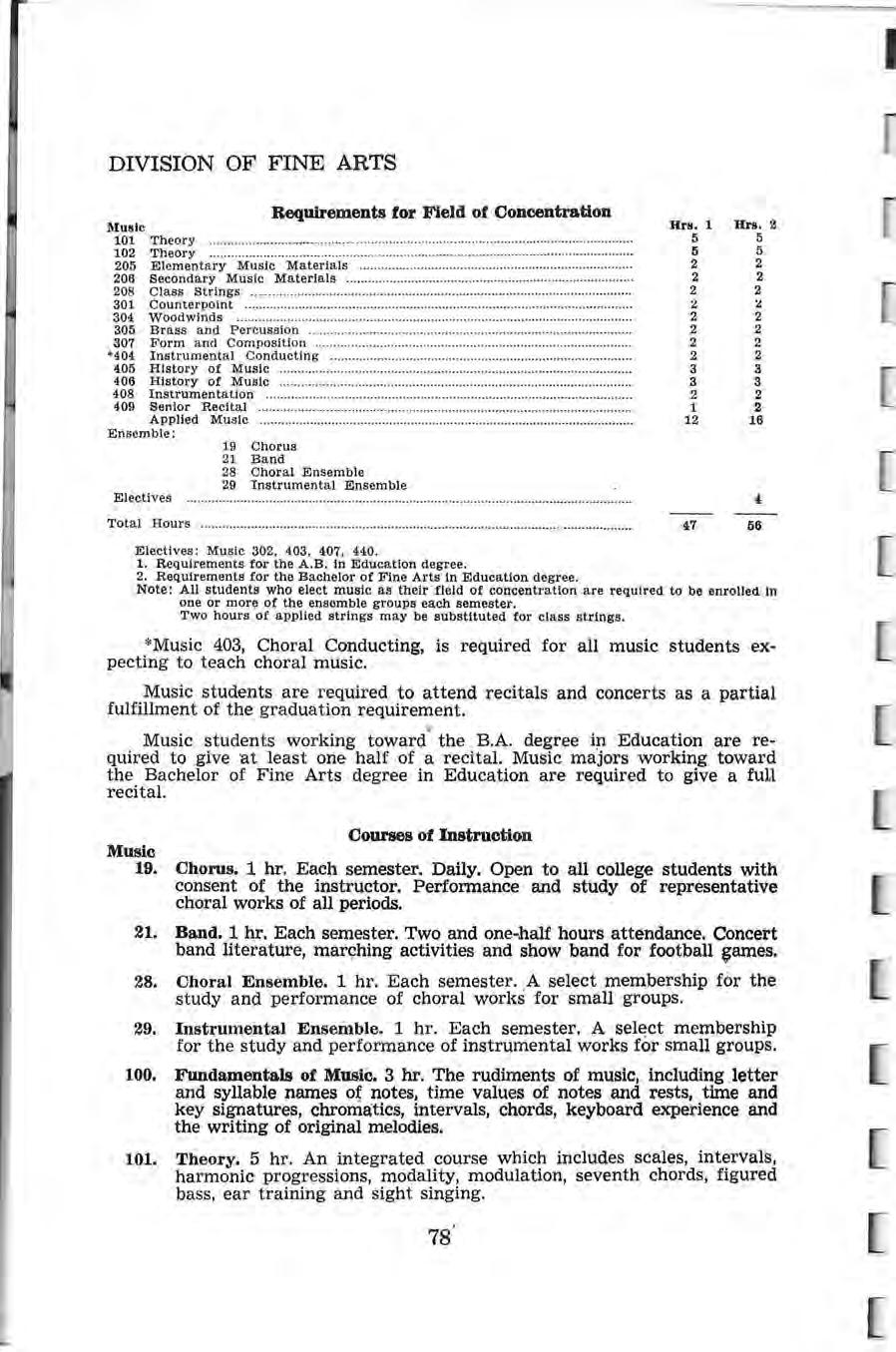
Chorus, 1 hr. Each semester Daily. Open to all college students with consent of the instructor. Performance and study of representative choral works of all periods. ·
Band. 1 hr. Each semester. Two and one-half hours attendance. Concert band literature, mar~hing activities and show band for football ~runes. Choral Ensemble. 1 hr. Each semester A select membership for the study and performance of choral works for small groups. ·
Instrumental Ensemble. 1 hr. Each semester. A select membership for the study and performance of instrumental works for small groups.
Fundamentals of Music, 3 hr. The rudiments of music, including Jetter and syllable nrunes of notes, time values of notes and rests, time and key signatures, chromatics, intervals, chords, keyboard experience and the writing of original melodies.
Theory. 5 hr. An integrated course which includes scal~s. intervals , harmonic progressions, modality, modulation, seventh chords, figured bass, ear training and sight singing.
102.
T heory. 5 hr . Prerequisite, Music 101. Irregular resolutions, diminis h ed sev enths, secondary domin a nts, ninth, el eve nth and thirteenth chords, altered chords, chromatic har111ony a nd cr e at iv e work. . ,,

107. Class Piano. 1 hr. Each semester. Limited to students having no prior study of the piano. Development o'f ability to read music and to play pieces and songs.
108. Class Voice, 1 hr. Each semester. Tone production, placement, group a nd individual performance of songs requiring basic technique. Applied Music. 1-2 hr. Each semester. Private instruction in voice, piano, organ, strings, woodwinds, brass and percussion Th e re 1s no charge for private l essons to students within the department. Those outside the department may register for lessons at the rate as indica t cd in the Financi a l Section. Music st ud e n ts are re quired to show a proficiency in pi ano to meet the dem a nd s of their classroom acti v it ics. At leas t one semes t er of private voice in struct io n is required of ma,iors.
120. Piano, voi ce , woodwind, brass, string, percussion, and organ. Instrument st udy o n the freshman leve l. May be repea t ed.
205. Elementary Music Materials, 2 hr. Prerequisite: Music 100 or 101. Study of re a ding, children's music literature, tonal and rhythmic problems.
206. Secondary Music Materials. 2 hr. Voca l and instrumental problems of secondary schools, methods and •materials.
208. Class String s .' 2 hr. Alternate years. Basic study of th e v iolin , viola, v iol oncello a nd string bass.
220. Piano, \'oic e , woodwind, bra ss s tring, per c ussion, and organ. In s trum ent study on the sop homore l eve l. M ay be repeated.
301. Counterpoint. 2 hr Two and three part eighteenth century style, descant and invention.
302. Advanced Counterpoint. 2 hr. Canon and fugue, creative work.
304. Woodwinds. 2 hr Second sem este r, alternate years. A study of woodwind instrum e nts, with actual pl ay ing experience.
305. Brass and Percussion. 2 hr. Second semester, alternate years. A study of brass and percussion instruments with actual playing experience.
307, Form and Composition. 2 hr. First semester, alternate years. Prerequisites: Theory 101, 102, 203, 204. Analytical study of the different forms and styles in music and their application in composition .
311. Music Appreciation. 2 hr. Each semester. Various forms and styles of music, ranging from folk song to opera, oratorio and symphony, analyzed and discussed through the use of records This course requires reference reading and record listening .
320 Pi1ano, voice, woodwind, brass, string, percussion, and organ. Instrum f nt study on the junior lev e l. May be r epea ted.
403. Choral Conducting. 2 hr. First semester. Study and practice of the art · of directing choral groups. Discussion of the problems of intonation, tone, balance and work with music from the various sacred and secular schools.
404, Instrumental Conducting. 2 hr. Second semester. Baton technique for band and orchestra directors and the reading and interpretation of bandandorchestralscores.
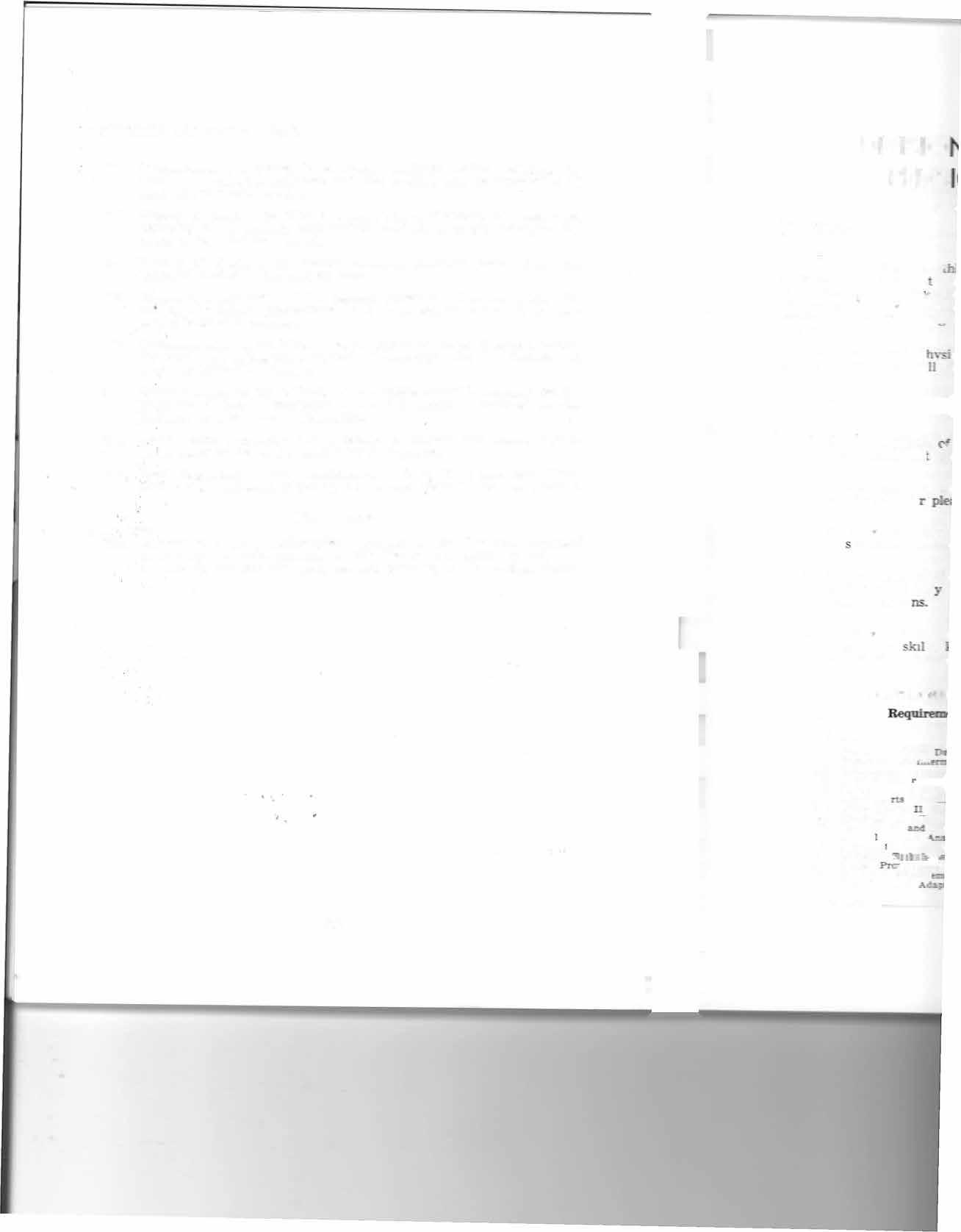
405. History of Music. 3 hr.Firstsemester.Thedevelopmentofmusicfrom antiquitytothepresent, withstylistic analysisofmusic examples. Extendsto the ClassicalPeriod.
406. History of Music. 3 hr. Second semester, alternate years. From the ClassicalPeriodtothepresenttime.
407. Advanced Composition. 2 hr. Second semester, alternate years. The writing oforiginalcompositions, both vocalandinstrumental. Arranging'.forbandandorchestra.
408. Instrumentation. 2 hr.Firstsemester,alternateyears.Practicalscoring for band and orchestra. Required of candid<1ites for the Bachelor of Music in Education degree.
409. Senior Recital. 1-2hr.Athirtyminutepublicrecitalisrequiredforthe Bachelor of Arts in Education, and a full recital is required for the BachelorofFineArtsinEducation.
420. Piano, voice, woodwind, brass, string, percussion, and organ. Instrumentstudyontheseniorlevel.Mayberepeated.
440. Band Organization and Administration. 2 hr. First semester. Techniques and problems, planning shows and otber public appearances.

Fine Arts
350. Aesthetics. 3 hr. A philosophic approach to the fine arts, intended to develop an understanding of the theory and nature of art, and to seek its fundamental purpose and meaning in the variousforms.
Th e inte rcoll egia t e at hletic pro gra m at Peru State College is designed, conducted an d administered for the love of the sport, the general welfare of the player, the enjoyment of the st ud e nt body a nd the specific training of the young me n w h o expect to enter the teaching profession. Th e main emp hasi s is on producing better teachers and citizens to build a stronger n at ion.

The Health and Physic a l Education Divi sion attempts to oontribute to the education of the college men and women in the fol .lowing ways:
1. By providing a well-rounded program of activities usable by the student in commanding the optimum and maximum functions of the body.
2. By the emphasis of sound health habits, the need for sleep, exercise, proper food, rest and relaxation . .
3. By developing in each student specific neuromuscular skills which will be adequate for pleasure, for relaxation and safety.
4. By providing opportunities for the dev e lopment of emotional control, perseverance, courage, leaders hip and loyalty.
5. By providing a laboratory for the development of constructive attitudes toward play, health, recreation, relaxation, sportsmanship and human relations.
6. By providing prospective teachers with experiences enabling them to acq uire the skills, knowledge a nd techniques needed to teach Health a nd Physical Education in modern elementary and secondary schools.
The following program is provided for those students interested in the coaching of interscholastic sports. It is designed to fit the needs of the high school coach. Students participating in this program are required to meet the r
nts for an endorsement in a n a dditional teaching field.
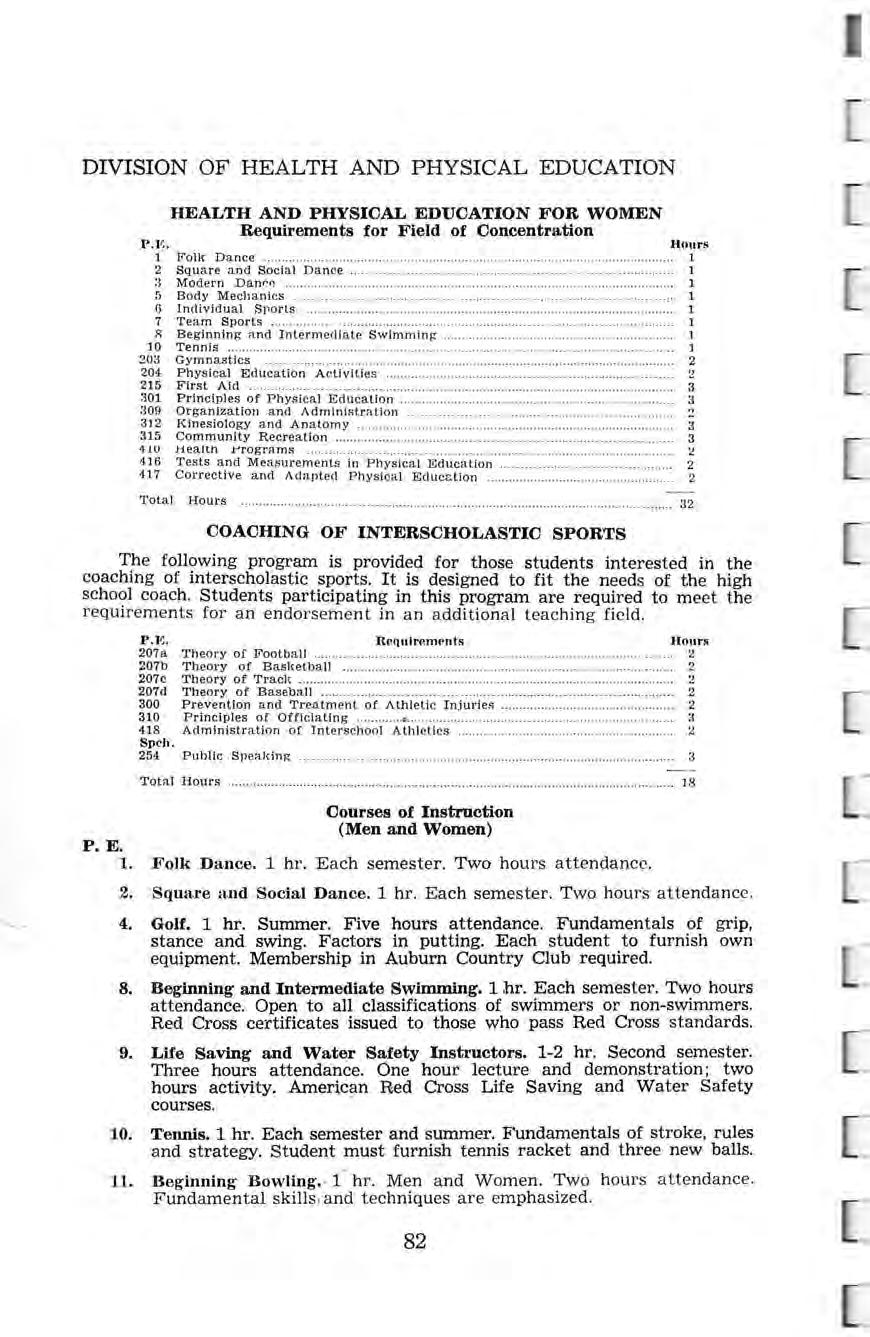
1. Folk Dance. 1 hr. Each semester. Two hours attendance.
2. Square a.nd Social Dance . 1 hr. Each semester. Two hours atte ndanc e.
4 . Golf. 1 hr. Summer. Five hours attendance. Fundamentals of grip, stance and swing Factors in putting. Each student to furnish own equipment. Membership in Auburn Country Club required.
8. Beginning and Intermediate Swimming. 1 hr. Each semester. Two hours attendance. Open to all classifications of swimmers or non-swimmers Red Cross certificates issued to those who pass Red Cross standards
9. Life Saving and Wat~r Safety Instructors. 1-2 hr. Second semester. Three hours attendance. One hour lecture and demonstration; two hours activity. Amertc ;m Red Cross Life Saving and Water Safety courses.
10. Tennis. 1 hr. Each semester and summer. F'undamentals of stroke, rules and strategy Student must furnish tennis racket and three new balls.
11. Beginning Bowling. - f hr. Men a nd Women. Two hours attendance. Fundamental skills i a nd t ec hniques are emphasized.
203. Gymnastics ( tum b lin g, re b ound tumblin g a nd a pp arat u s). 2 hr. Three hours attendance. Instruction in tumbling, trampoline, mini-trampoline, side horse, vaulting box, high ba_r , pa-n,illel bar and balancing. Uniform requir ed.
204. Physical Edu c ation Activities . 2 hr. E a ch sem es t er a nd summer. Game s , st unt s, r hy t hm s, d a n ces a nd m ove m e nt ex plor a tion.
205. Health. 3 hr. E a ch sem este r and summer A study of the function and c a re of the hum a n body in he a lth and dis eas e, and th e h a rmful effects of stimulants a nd harcotics .
21 5. First Aid. 3 hr . Eac h semes t e r and s umm e r. Am erica n R e d Cross Firs t Aid cour se a nd Me di cal S elf Help co u rse. ·
301. Principles of Physical Education. 3 hr. Each semester. Scope of the field of physic a l education and its relation to mod ern educational theory; history, principles of physical education furnished by the basic sciences and philosophies of physical education. Study of the principles which should govern the instructional, interscholastic, intramural, play day and corrective programs.
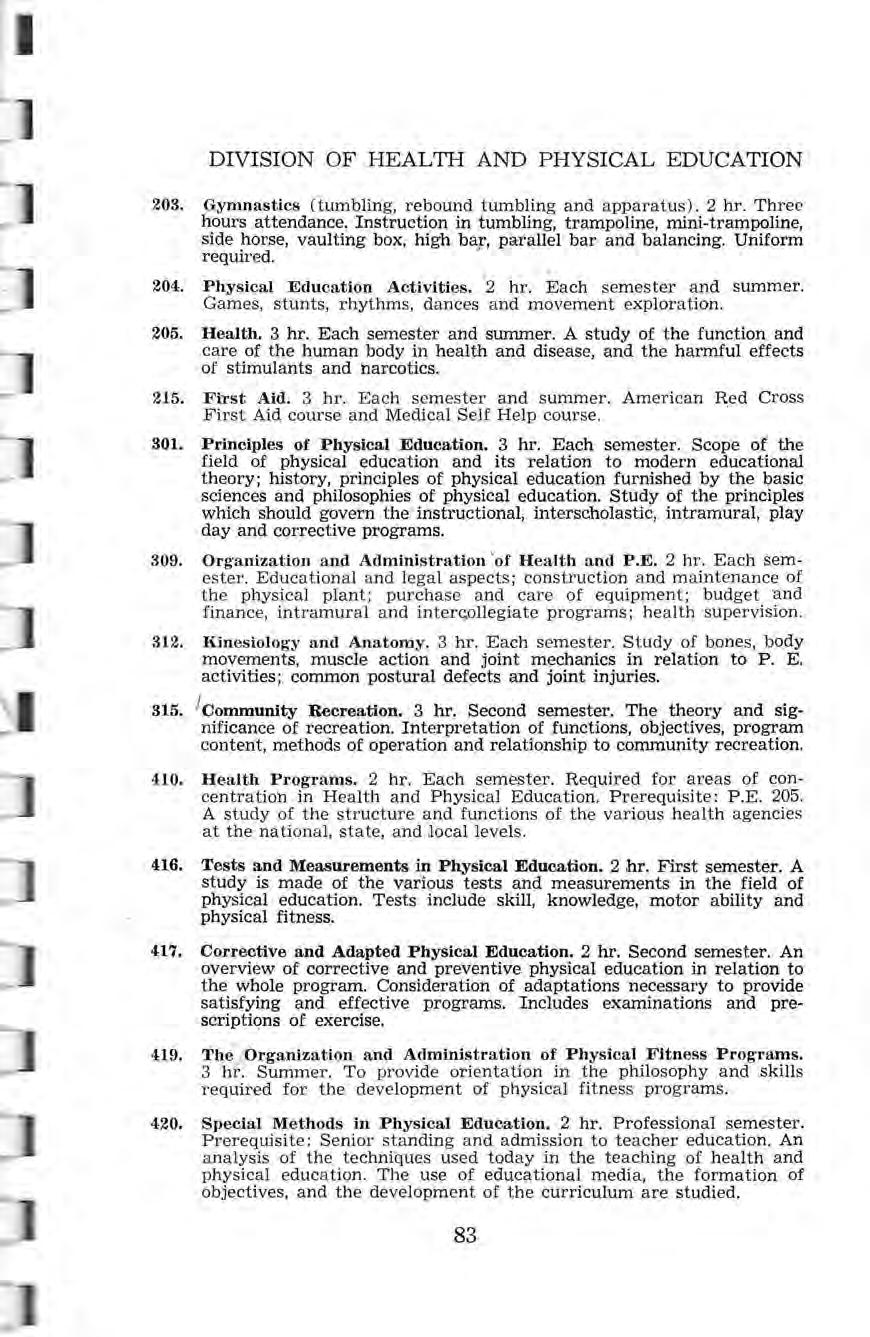
309 Organization a nd A dmini s tr a tion ' of Health a nd P.E . 2 h r . E a ch semeste r. Edu cat ion a l a n d l egal aspec t s ; co n s t r u cti on a nd ma int en a nc e o f the ph ysica l p l a n t; p u rc h ase a nd ca r e of eq uipm e n t; bud ge t a nd fi n a nc e, int ra mu ra l a n d in te n ;olle g iat e p rogra m s; h ea lth sup e r vis ion .
312. Kin e siology a nd An a tom y. 3 hr. Each sem es t e r Stu dy o f b on es , body movements, muscle action and joint mechanics in relation to P. E . activities; common postural defects and joint injuries.
315. I Community Recreation. 3 hr. Second semester. The theory and significance of r e creation. Interpret a tion of functions , objec t ives, program content , methods of operation and relationship to community recreation
410. Health Programs. 2 hr E a ch se m e ste r. R e quir e d fo r a r eas of concentra tioh in H ea lth a n d Physical Educ a ti on Pr ere qui s it e : P E. 205. A stud y of t h e s t r u c tu re a nd functi on s of t h e var iou s h eal th ag encie s a t the n a ti on a l , state, a nd .local lev el s.
416. Tests and· Measurements in Physical Education. 2 hr. First semester. A study is made of the various tests and measurements in the field of physical education. T ests include skill, knowledge, motor ability and physical fitness.
417. Corrective and Adapted Physical Education. 2 hr. Second semester. An overview of corrective and preventive physical education in relation to the whole program. Consideration of adaptations necessary to provide satisfying and effective pro grams Includes examinations and prescriptions of exercise.
419 . Tbe -Organization a nd Adminis tration of Phys ica l Fitne s s Programs. 3 hr. Summ er . T o pro vid e ori e nta tion in .th e phil osoph y a nd skill s re qui re d fo r th e deve l op m ent of phys ic a l fi t n ess pro g r a m s .
420. Specia l Method s in Ph ys ical Education. 2 hr. P r of e s sion a l seme s ter . Prere qui si t e: Se ni or sta ndin g a nd a dmi ss ion to t eac h e r e duc a tion. An a n a ly s is o f t h e tech ni q u es u se d tod a y in th e t eac hin g of h ea lth a nd p hy s ica l edu cation. Th e u se o f educati on a l m e di a , t h e formation of obj e ctive s , a nd th e deve l opm e nt of th e cur r iculum a r e studi e d
90. Varsity Sports. 1 hr Requires successful participation in a varsity s port
.101. Physical Education for Men. 1 hr First semester. Two hour s at t e ndance required. Uniform r e quired. Activities: Archery, badminton, a nd wrestling.
102. Physical Ecluca.tion for Men . 1 hr. S eco nd semester. Two hour s attendance req ui red. Uniform requi re d. Activit ies : T1,.1mbling, w e ig ht t ra ining, and golf.
207a. Theory of Footb~tll. 2 hr. First seme s ter. Two hour s cl ass a tt e nd a n ce .
207b. Theor~• of Basketball. 2 hr . First semester . Two hour s class atte nda nc e.
207c. Theory of Track. 2 hr. Second semester Two hours class attendance.
207d. Theory of Baseball. 2 hr. Second semester. Two hours class attendance.
216. Minor S ports I. 2 hr. First semester. Three hours atte nd ance req ui red. A study of th e history, strat eg y, and techniques involved in arch er y, b a dmint o n, and wrestli n g.

21.7. Minor S ports II. 2 hr Second semeste r Three h ou rs a ttendance r equired. A study of the hi story, str a tegy, and t ec hnique s involved in tumb lin g, we ig h t tr a inin g, and golf.
300 . Prevention and Treatment of Athletic Injuries. 2 hr. Second semester. Nature an d causes of injuries incide nt to the physical activities of c hild re n and ath letes . Infec tion s , their care and prevention: first-aid tr e atm e nt for h emorrhages , bruises, strains, sprains, dislo ca tions , fractures a nd us e of protective eq uipment.
310. Principles of Officiating. 3 hr. First semester. Two hours class attenda nce, two hours of lab Officiating t echniqu es in football and baske tball. Study of rules Each student required to register with the State Activity Associ a tion.
4 00. A dvan ce d T ec hniqu es in Physical Education. 1 h r. Eac h sem ester. Required of a ll m e n w ith areas of concentratio n in Health a nd Phy s ica l E duc a tion. Prereq ui s ite s : P.E 216 and P E 21 7. A pr ac ticum invo lv in g laboratory exper iences in P.E. 101 a nd P.E. 102.
418. Administration -of Interschool Athletics. 2 hr Second semester. Includes a history of the development of athletic pro gra ms, a study of the various n a tional a nd state athletic organizations, the role of at hl etics in e ducation and t h e r espo nsibilities of the athletic director.
3. Modern Dance. 1 hr Second s e mester. Two hours attendance. Fundam en tal rhythmic techniques and their application in creative dance.
i5. Body Mechanics. 1 h r: Fi fs t semester. Tw o hours atte nd a nce. Tumblin g, apparatus, trampoline, a nd po s ture. E mphasis on efficient u se of bod y in a ll movements.
6. Individual Sports. 1 hr Second semest er Two hours a ttendance Arche ry, badminton, paddle tennis and shuffleboard.
7. Team S ports . 1 hr. Fir s t semester. Two h o u rs attenda nc e. Volleyba ll, s oftball, ba s k et ball, fi e ld h ockey and soccer.
The Division of History a nd Social Science offers courses in the following subjects: Economics, government, history, sociology and composite courses in t h ese areas. The offerings in this division are designed to furnish students the information and techniques requisite for teaching social science in the elementary and secondary schools, to create an understandin'g of and respect for our democratic way of life, and to develop a capacity for sound scholarship, community leadership and useful citizenship.
Fi e lds of concentration for the A.B. or B .S . in Education or A.B. degre es are offere d in geograp hy, hi story, social science, eco nomi cs, and sociology .
Students intendin g to do graduate work in the social sciences should acquire a reading knowledge of a forei g n langua ge, and should plan their under gra duate work with the assistance of their counselors in order to prepare as carefully as possible for such advanced work.
Students who int end to enter a Graduate School of Social Work or the welfare field as a case work e r in the State Department of Assistance a nd Child Welfare should pl an to take at least 40 semester hours in social and biological sciences.

Courses in History are d es igned to:
1. Give a n in s ight into m a n's achievements a nd fail ur es with an app licatio n to the contemporary world.
2. Develop critica l thinking which enab l es one to researc h, proc ess a nd ana ly ze historical data.
3. Give adeq u ate subject matter, background for teaching and an understanding of the effective techniques in teachi n g.
4. Give an adequate background for grad u ate st udy. R
114. History of the U. S. since 1865. 3 hr. Second semester. Reconstructio n, the last frontiers, the rise of big business, imperialism and the role of th e U. S. in two World Wars and their aftermaths.
201. World Civilization to 1500. 3 hr First semester. The cultural and political growth of man from prehistoric times to A. D. 1500.
202. World Civilization since 1500. 3 .hr. Second semester. The rise of European civilization from the Reformation and the discovery of the New World to the present day.
311. English History since 1688. 2 hr. England from the establishment of parliamentary supremacy to modern times.
312. Twentieth Century Russia. 3 hr . The development of the Union of Soviet Socialist Republics and its foreign relations
325. The American Frontier. 3 hr. The importance of the frontier in American history from colonial times to the 20th Century.
326 History of Colonial Latin America. 3 hr. Discovery, exploration and colonization of Latin America, with emphasis upon its institutions and culture and the events leading to its w a rs of independence
327. History of Independent Latin America. 3 hr. The evolution of the states of modern Latin America following their independence, their political a nd economic development and their international relations.
402 . Methods in History and Social Science. 2 hr. Each semester. Prerequisite: sen ior stand in g, with a concentration in hi s~ory or social science. Instruction in the m et hod s of t eac hin g high school hist ory and social sciences.
407. Nineteenth Century Europe. 2 hr. From the Congress of Vienna to the alignment of powers that prefaced World War I, with emphasis upon the formation of the German Empire and the unification of Italy.
420G. American Colonial History. 3 hr. Colonial rivalry between the Spanish , French, En glish and Dutch in North America ; the Revolution, and U. S . history to 1823.
421G. The United States in the Nineteenth Century. 3 .hr. The U. S. from 1823 through Manifest D es tiny and the Civil War down to the War with Spain.
422G. The United States in the Twentieth Century. 3 hr. The U. S in mod ern times, with emphasis upon the changing social and economic theories of the period, and the internal and external forces that influenced its development.
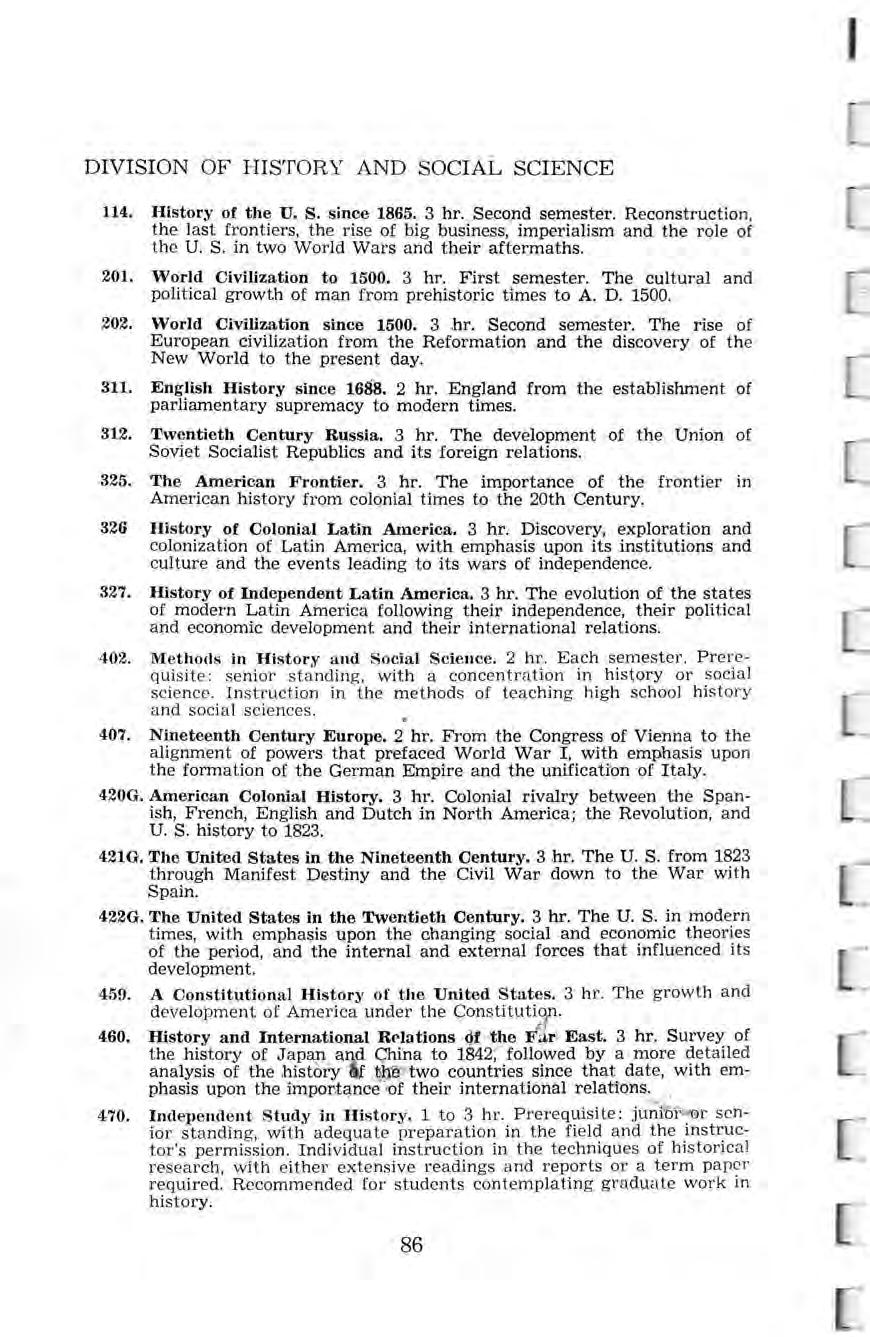
459. 460. 470.
A Constitutional History of the United States. 3 hr. Th e growth and d eve lopme nt of America under the Constitutit. '
History and International RPl:itions qf 'the F • r; East. 3 hr. Survey of the history of Japan aq,d <;hina to 1842';' followed by a more detailed analysis of the .history ·1t .~-e-11- two countries since that date, with emphasis upon the impor.tf!,nce ,of their international relations , Independent Study in History. 1 to 3 hr. Prerequisite: juni-or r senior standing, with adeq uate preparation in the field a nd the in structor 's permission . Individu a l inst r uction in the techniqu es of hi s tori ca l r esea rch, with e ither exte nsi ve readings and reports or a term pap er required. Recommended for s tud en ts contemplating graduate work in hi sto ry .
Courses in Geography are designed to:
1. Emphasize the major systematic -and pra'Ctical fields.
2. Develop an understanding of the relationship between man and his environment.
3. Give an adequate background for teaching and understanding of effective teaching techniques.
4. Give background for employment by various governmental agencies.
*Required of Secondary Teachers who are planning to teach Geography. NOTE-Non-teachers should take Field Geography in place of the methods course as a requirement for concentration in Geography.

Courses of Instruction
Principles of Geography. 3 hr. An introductory study of the relationships of man and environment with emphasis placed upon climatic regions of the world . Two hours lecture, two hours laboratory.
Cultural Geography. 3 hr. The study of ithe cultural elements of the landscape with emphasis on the origin o'f man, migration, settlement and the economics of man. Two hours lecture and two hours laboratory.
General Geology. 4 hr. First semester. An introduction to the theories of the earth's origin, the study of the earth's structure and materials with special emphasis on rocks and minerals and .Jandforms. Three hours lecture and two hours laboratory ;
Geography of Nebraska. 2 hr. Prerequisite; Geog. 101. A correlation of the physical and historical base of the state!s present agriculture, manufacturing and . service industries. '
Wo'rld Regional Geography. 3 hr Prerequisite: Geog. 101 and 103. A study of the major regions of the world with particular attention to how man has utilized the earth's resources from area to area. This course is particularly designed for the teacher who cannot enroll in a complete geography program.
Physiography of the United Sta.tes. 4 hr. Prerequisite: Geog. 101 and 103. A regional study of landform provinces with special emphasis on the relationship between landforms, climate, soils, vegetation and mineral resources. Three hours lecture and two hours laboratory .
300. Geography of Asia. 3 hr. Prerequ isite : Geog. 101. A regional study of th e maj or countries of Asia with emphasis upon relief, climate, re s ources , gover nm ent a nd industri a l development.
304. Meteoro logy and Climatology. 3 hr. The physical factors influ e ncin g the c limate with practical work in int erpret in g m eteoro lo gica l r e cords a nd forecasting. Two hou rs l ect ure, two hours labor atory.
305. Economic Geography. 3 hr. Pr e r e qui s ite: Geog. 101 and 103. An analysis of wor l d l and reso u rces, agr icu l tural produ c ts, fore st and m ar in e resource s, b as ic mining indu s trie s, manufacturin g , trade pattern s anrl transport. a tion r6u tes.
310. Geography of Africa. 3 hr. Prerequisite : G eog. 101. A geographical a nalysis of the continent. Emphasis is pl aced upon rec e nt spirit of n atio n a lism a nd the economic and physical base of selected nation s.
311. U rban Geography. 3 hr. Study of t h e or ig in , di s tribution, internal st ructur e and funct ions of urban d eve lo pm ents with e mphasi s on loca ti on features of econom ic a nd cu l tura l phenomen a
312. Geography of Anglo-America. 3 hr. Prerequisite: Geo g. 101 or senior stand in g . A study of the United Stat es and Canada by natural regions. In eac h case an evaluation of the physical and eco nomic base will be made in th e light of present economic development.
313. Geography of South America. 3 hr. First semester. Prerequisite: Geog. 101. The geographic r egions of South America a n a ly ze d in their n at ural , political and economic settings. The eco nomic relations betwee n South America a nd th e United States.
326. Conservation of Natural Resources. 3 hr. An evaluation of soil, water, mineral, forestry, fish, air and recreation r eso urc es in order to develop a n ap preciation of their importance and the seriousness of the problem. Wh en possible, act ual examples will be studied in the field.
403G. Special Problems and Techniques in Geography. 2 hr. D es igned to pro vide an opport un ity for students to ex p e riment with a nd l ea rn new t ec hnique s in Geog raphy in s truction b as ed upon the individual needs and interest of each student. Offered the first nine weeks of the second professional semester in each academic year.
404G. History and Philosophy of Geography. 2 hr Prere quisite: Geog. 101 and 103. A study of the basic philosop hi es of geog raphy in c ludin g the st udy of the hi s to ry of geogra phic thought from a n cie nt to modern times.
411G. Field Geography. 2 hr. Prerequisit e: Geog. 101. An intensive course of training in th e geographic fi e ld m et hods a nd in the dir ec t a pplication of geographic principles to important problems in selected districts . Two hours l ecture, la boratory by arrangement.

470. Ind e p e nd e nt Study in Geography. 1 to 3 h r. Prerequisite: junio r or senior sta n ding, w ith adequate preparation in the field and the ins tructor' s 1wrmission. Indi vidua l instruction in t h e techniques of geograph ic researc h , w ith either extensive readings and reports or a term paper requ ired. , :ffi g hly recomme nd ed for st ud ents contemplat- .r in g grad u ate work in geograp h y.
494. C urr e nt Topics in Geograph~•. 3 hr . A geograp hic study of current topics g en e r a lly involving such s ubj ec ts as pollution, space geograp hy , agricultura l geog r a phy, geogra phy of tr a n spo rtation, geograp hy of pr im ary production, ;ind ro c ks a nd minerals. These courses to b o given o n rlcm,111cl but> only on e t op ic 494)._!:o be g iv en each semes ter.
495. Regional Topics in Geography. 3 hr. A study of world areas by physical divisions with emphasis on the interrelationship between cultural and physical features of each region , Course . topics selected from the following regions: Middle East, Southe~St Asia, U.S.S.R. , Asia, Middle America, South America, Australia ' and the Islands, Eastern Europe and Western Europe. Only one topic course 495 offered each semester.
499G. Political Geogtliphy. 3 hr. Prerequisite: Geog. 101 and 102. Geography as a factor in' the differentiation of political phenomena in various parts of the world. The modern state in relation ·to its environment and the interrelationship of nations as a result of their geographical strengths and weaknesses.
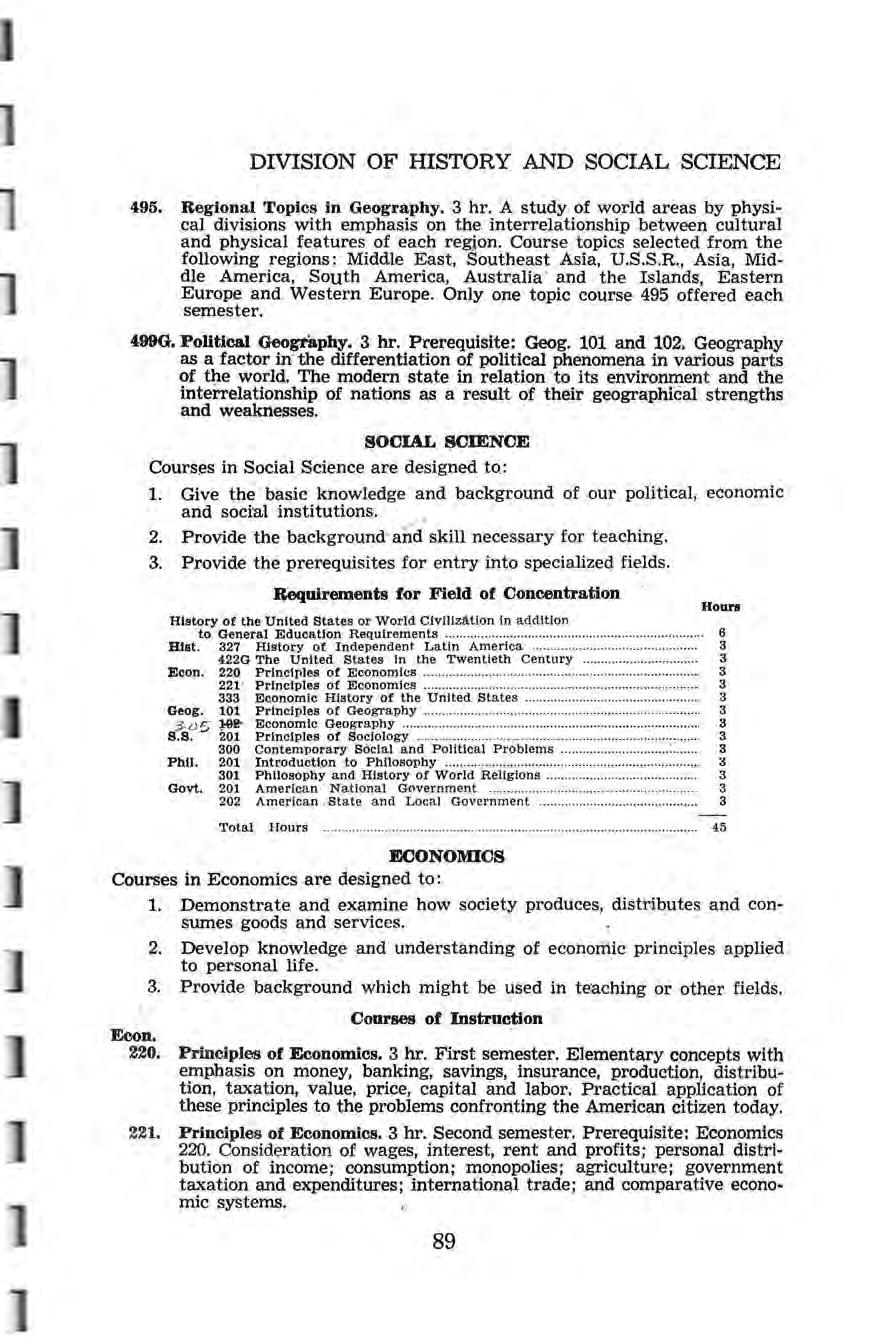
Courses in Social Science are designed to:
1. Give the basic knowledge and background of our political, economic and social institutions.
2. Provide the background ·and skill necessary for teaching.
3 Provide the prerequisites for entry into specialized fields.
for Field
Courses in
are designed to :
1 Demonstrate and examine how society produces, distributes and consumes goods and services.
2. Develop knowledge and understanding of econoirlic principles applied to personal life . ·
3. Provide background which might be used in te:aching or other fields. Courses of Instruction Econ.
220. Principles of Economics. 3 hr. First semester. Elementary concepts with emphasis on money, banking, savings, insurance, production , distribution, taxation, value, price, capital and labor. Practical application of these principles to the problems confronting the American citizen today
221. Principles of Economics. 3 hr. Second semester Prerequisite: Economics
220. Consideration of wages, interest, rent and profits; personal distribution of income; consumption; monopolies; agriculture; government taxation and expenditures; international trade; and comparative economic systems.
222. Contemporary Economic Problems. 3 hr. Second semester. Prerequisites; Economics 220 and 221. Analysis of major economic problems relating to wage and income distribution, money and credit, business cycles, domestic and international trade and tariffs.
333. Economic History of United States. 3 hr. U. S. economic history from colonial times to the present.
:{:'iO. Puhlic Financ·P. 3 hr. Second semester. PrcrequisitPs, Econ. :220 and 221 A critica l analysis of the capitalistic eco nomic sys t ems followed by a survey and crit ica l analysis of socialism and communism. Speci,11 emphasis is g iven to the thcoriPs upon which eac h is !Ja Sl'd and the' method of sol\ ·ing e conomic problems.
375. Lahor and Industrial Relations. 3 hr Prerequisites: Econ 220 and 221. Labor, management and government as they arc interrelated involvin g collective bargainin~, labor laws and wage theories .
470G. Special Problems in Eo1,nomics. 1-4 hr. Prerequisites : Econ. 220 and 221 Designed to provide an opportunity for a student to do advanced ind epe ndent study in eco nomics based upon his individu a l needs and interests.
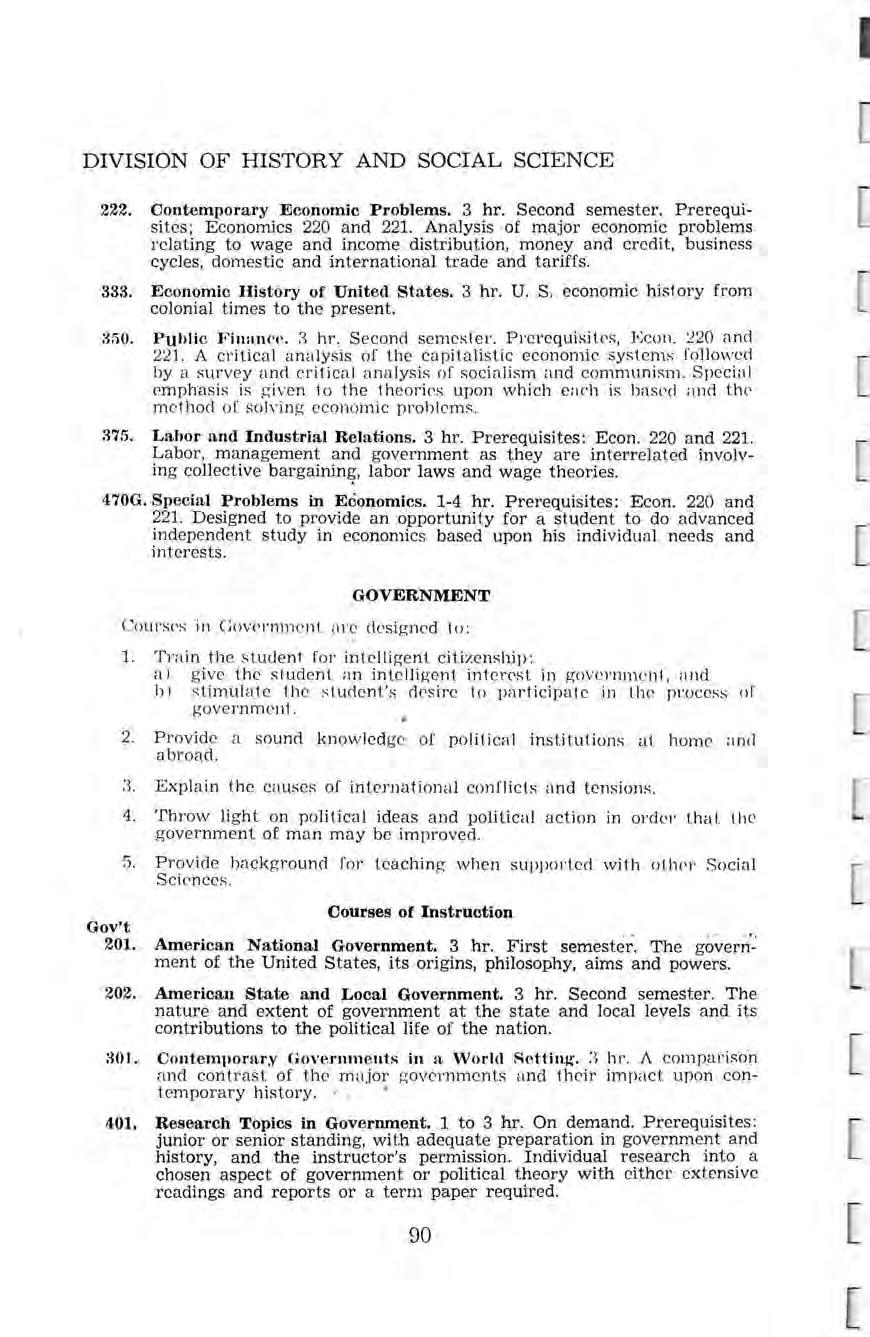
Courses in Govprnment ar ~ designed to:
1. Train the student for intelligent c iti ze nship : al give the student , in intelligent interest in government, , 111d hi stimu lat e the s tuct c nt' s clC'sire to participate in Uw process or governme nt.
2. Provide a sou nd knowledge of political insti tu tions at home ancl abroad.
3. Explain the causes of international co nfli cts and tensions.
4. Thr ow light o n political ideas and political action in order that. tile government of m an may be improved.
5. Provide hackgrouncl for t eac hin g when supportecl wi th ollwr Social SciPnccs
Gov't
Courses of Instruction
201. American National Government. 3 hr. First semester. The.. government of the Unit e d States, its origins, philosophy, aims and powers.
202 . American State and Local Government. 3 hr. Second semester . The nature and extent of government at the state and local levels and its contributions to the political life of the nation .
301. Contemporary Go\'e rnments in a World Set.tin!{. :\ hr. A comparison and contrast of the major governments and their impact upon contempor ar y hi story. , •
401. Research Topics in Government. 1 to 3 hr On demand. Prerequisites : junior or senior standin g, with adequate preparation in government and history, and the instructor's permission . Individual research into a chosen aspect of government or political theory with either extensive readings and reports or a term paper required.
Soc.
Obj ect iv es Courses in Sociology a re des ign e d t o :
1. Pro v id e a n und ers tanding of tlic irit ~t'r e la tionship between soci ety. culture a nd persona lit y.
2. Give an un derstand ing of th e s cientific attitude a nd meth od s o f sociolo g ica l r es earch.
3. P rov ide an understanding of self and to a dju s t to the environmen t .
4. Give background for teac hin g and ot h er close ly related field s .
103. Social Science. 3 hr. First semester An integrated survey, course in t h e social sciences desi gned to stimulate the st ud e nt's ability to interpre t the interrelat e d problems confronting Am erica n institutions and to arrive at his own reasQned conclusions. Th e hi story of culture, soci al change, human ri g hts, the unequal r ates of change in t echn ology, in eco nomic life, in family life, in education, in religion, etc., are a n a ly zed.
104. Social Science. 3 hr. S eco nd semester. Objectives are the same as Social Sci ence 103. Careful scrutiny is made of th e changing function s of our institutions as joint interdepe nde nt activities. Emphasi s is placed on the modern economic order a nd international relations with their numer ous topical subdivisions.
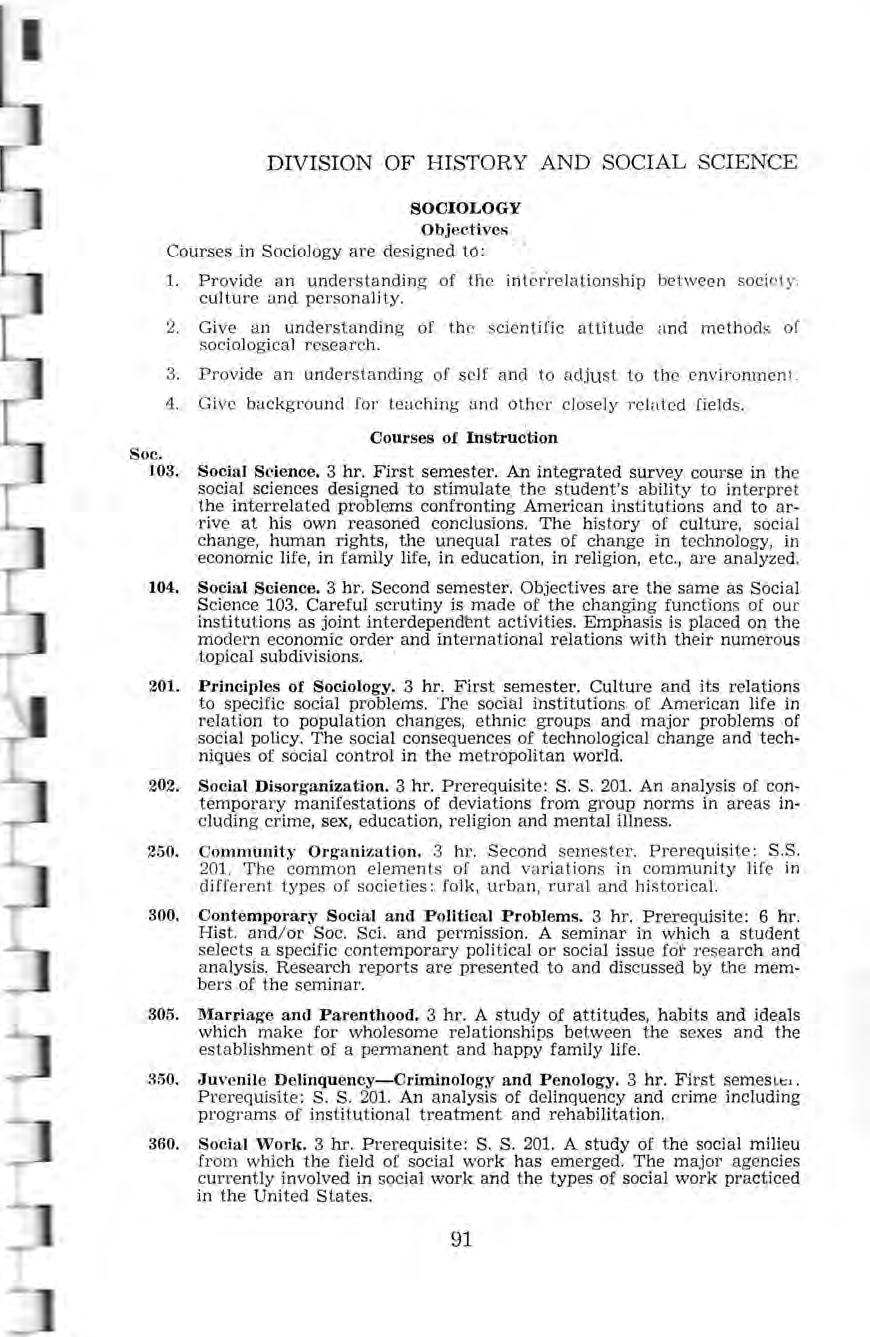
201. Principles of Sociology. 3 hr . First semester . Culture a nd its relations to specific social problems. Th e social institution s of American lif e in relation to population changes, et hni c groups and major probl ems of social policy. The social consequences of technological change and techniqu es of social control in the m etropol itan world.
202. Social Disorganization. 3 hr Prerequisite: S. S 201 An analysis of contemporary manif esta tions of deviations from group norm s in areas including crime, sex, e duc atio n , religion and mental illn ess.
250. Community Organization. 3 hr. Second se m ester Prereq uisit e: S.S. 201. Th e common e l eme n ts of a nd va riation s in commun it y lif e in diff e rent typ es of so ci eties: folk, urb a n, rur a l a nd hi st orical.
300. Contemporary Social and Political Problems. 3 hr Pr er equ isit e: 6 hr. Hist. and / or Soc. Sci. a nd permission. A seminar in which a student selects a specific contemporary political or social issu e fo'r researc h a nd analysis. Research reports are pr esent ed to an d discusse(l by the m embers of the seminar.
305 . Marriage and Parenthood. 3 hr. A study of attitudes, habits and ideals which make for wholesome relationships betw ee n the s exes and the estab lishment of a permanent and happy family life.
350. Juv e nil e Delinquency-Criminology and Penology. 3 hr First semeSLt:1 Pr ere quisite: S. S. 201. An analysis of delinquency and crime including programs of institutional treatment a nd r eh a bilitation.
360 Social Work. 3 hr Prerequisite: S S. 201. A study of the social milieu from which the fi eld of social work has emerged. Th e major agenc ies currently involved in social work a nd t he types of social work practic ed in the United Stat es.
430. Field Work Practicum. 3 hr. By permission of division head Supervised experience in Soci a l Work.
470. Independent Study in Sociology. 1-3 hr. Individual inst r uction in the techniques of re s earch.
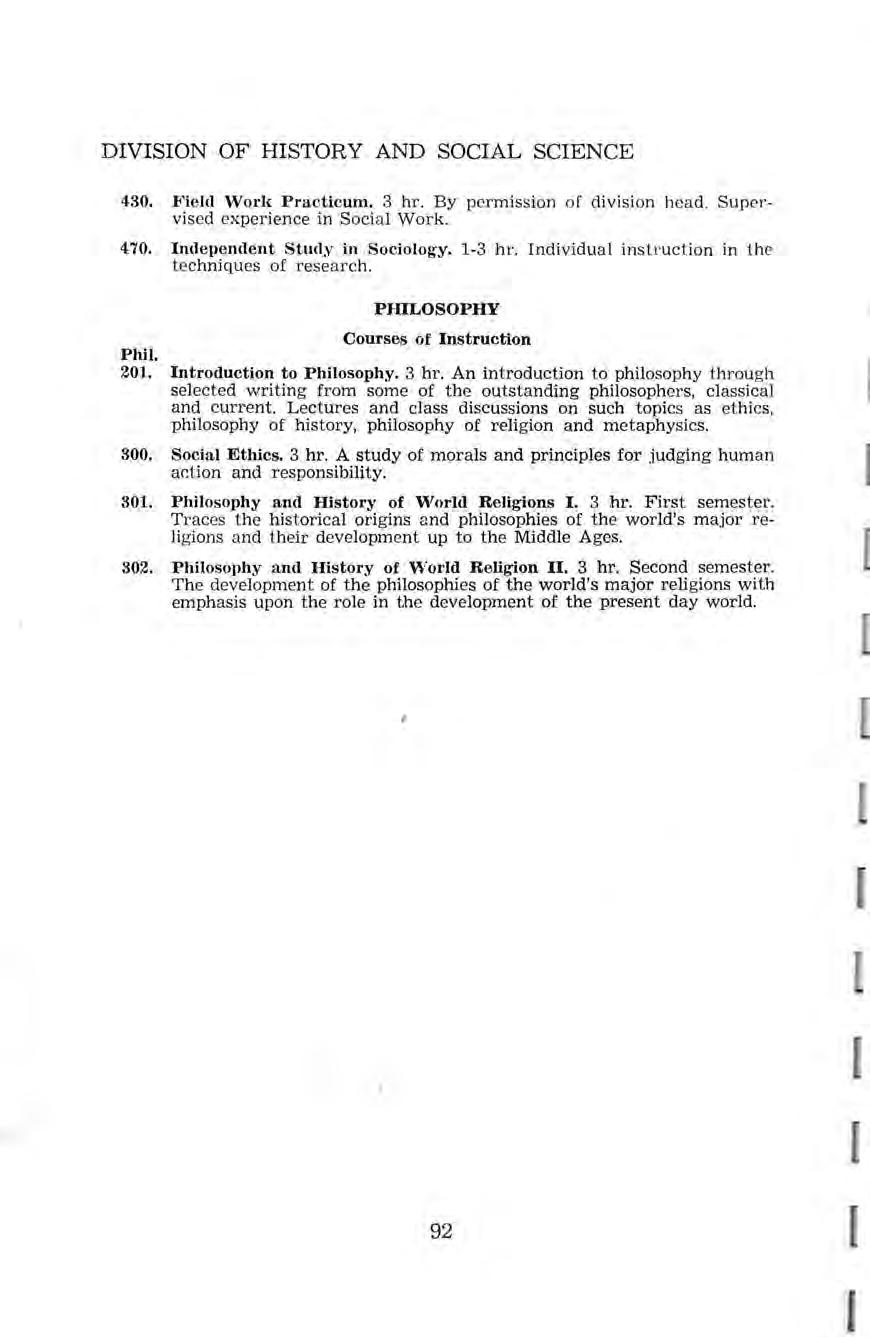
Courses of Instruction
Phil.
201.. Introduction to Philosophy. 3 hr. An introduction to philosophy through selected writing from some of the outstanding philosophers, classical and current. Lectures and class discussions on such topics as ethics, philosophy of history, philosophy of religion and metaphysics
300. Social Ethics. 3 hr. A study of morals and principles for judging human ar.tion and responsibility.
301.. Philosophy ancl History of World Religions I. 3 hr. First semester. Traces the historical origins and philosophies of the world's major religions and their development up to the Middle Ages.
302. Philosophy ancl History of World Religion II. 3 hr. Second semester . The development of the philosophies of the world's major religions with emphasis upon the role in the development of the present day world
l\a (hr:, 11 Armt~ n Clyde B a rrett Ro lw r t Bohlken
ROU E R 'L' D . :\IOOR E, HE A D OF Ul\' I S IO N \\'r eatha Hicks C. ,Ja m es l\ ec k Ph ii l{ni;;e ll
Th e Divis ion of L a n g u age arts inc lu c;les Erlg,lish lang uag e and literat ur e, j ourna li sm, s pe ec h ed u catio n and modern languag es.
ENGLISH LANGUAGE AND LITERATURE
Co u rses in Eng li s h L a n g uage a nd Litera ture are designed to:
1 T eac h st ud e nt s to us e th e E n g l ish lan g u age as a n effectiv e m ea n s of oral and writt en co mmuni cation.
2. Ass is t in c ul tivat in g t h e d es ire to r ea d literat ur e w ith µnde rs t a ndin g a nd apprec iation.
3. Fam ili arize st ud e n ts w i th m a ny of th e g r eat books that co nstitute the lit era ry h e rit age of mankind.
4. Discove r a nd foster the d eve lopment of individual literary sk ill s and t a l e nts.
5. Provide spec ia l d irec tion a n d in s truction for stude nt s who plan to teach.
6 . Pro v ide a basic un dersta n ding of the lang u age ar ts for t h ose s tudents whose vocatio n a l intere sts are qt h er than t eac hing .
7. Prov id e a so und basis for grad u a te st udy in the a reas of t h e l a nguag e arts.
R equ ire d : Eng. Spe h.
*2 04 Jntroclu c lion to Literature
*418 Shal\espeare
* 152 Fu ndamentals of Speech
*35 7 Interpretative Reading
Tota l Hours
E le ct. six: h ours from thr following: Eng.
*2 0 8 A ctvanced -Writing
"' 425 E n g lish Gram m ar ancl
*44 0 History of the En g li sh 234 Beginning- Journalism 435 Advanced Journalism
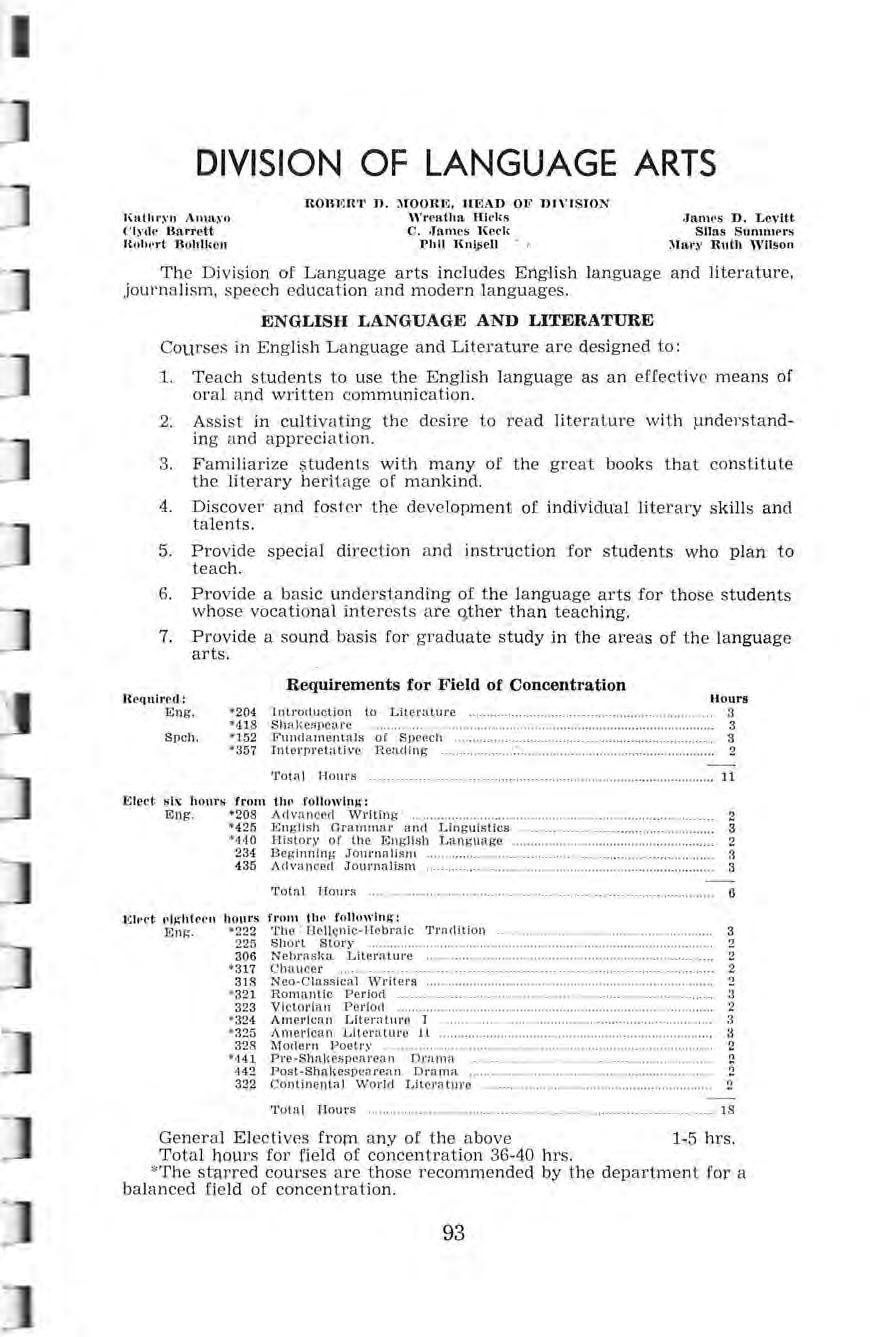
Tota l Hou r s
El~ct rl~htl'en hours from tl rn following ; Eng. *222 The Heltqnic-Hebra ic Trndition 225 S h arl Slo r y
306 Nebrasl(a L it e r a tur e
*3 17 C h auce r
318 Neo-C lassica l \Vriters
*321 Romftn tic Period
323 Vic t orin n Pe riod
*32 4 American Literatu11e I
*32 5 Amer ican Literature l.L
32 8 lvTodern Poetry
*4 41 Pre .- Sha \\espea rean Drama 44 2 Post-S h n l\.espe a rean DrUJ)Ht 32~ Continenta l \¥arid Lit e r a ture
Tota\ Hours
Genera l El ec ti ves from a ny of the a bove 1,5 hr s.
Tot a l hours fo r fie ld of conc e ntr at ion 36-40 h rs
'''T h e s t arre d co u rses are t h ose recomme nd ed by the d epartment for a bal anced fie ld of concentrat ion.
,James D. L evit.t SIias S un11nrr s :uar y Ruth WilsonCourses in Journalism are designed to :
1. Emphasize the struggle for, and the importance of, freedom of the press.
2. Concentrate on highlights in the history of the press in the United States.
3. Analyze contemporary problems in the field of journalism.
4 Cultivate the journalistic style.
5. Stress communication through the printed word.
Eng, 100, English Laboratory. 2 hr. Each semester . Two hours attendance. This laboratory is designed for freshmen who are unable to make a satisfactory showing in the general proficiency examination. Special instruction is given in the fundamental skills of written English, including a study of basic grammar, sentence elements, punctuation and spelling. Required for all freshmen deficient in the basic skills of English.
101. English Composition, 3 hr. Each semester. Prerequisite: successful completion of English Lab. for those required to take it. A study of the principles of clear and effective expression as applied to the sentence, paragraph and the -whole composition. A review of grammar, mechanics and correct usage. Training in organization, and the writing of short and long papers. Required course for all freshmen.
(Note: An exception may be made for those students who show sufficient ability in the entrance tests. Such students may be excused from this course by the head of the Language Arts Division.)
102. English Composition. 3 hr. Each semester. Prerequisite: Eng. 101. Further training in the writing of short and long papers with particular emphasis on research projects. Practice in the use of the forms of discourse and logic. Readings in the various forms of literature. Required course for all freshmen.
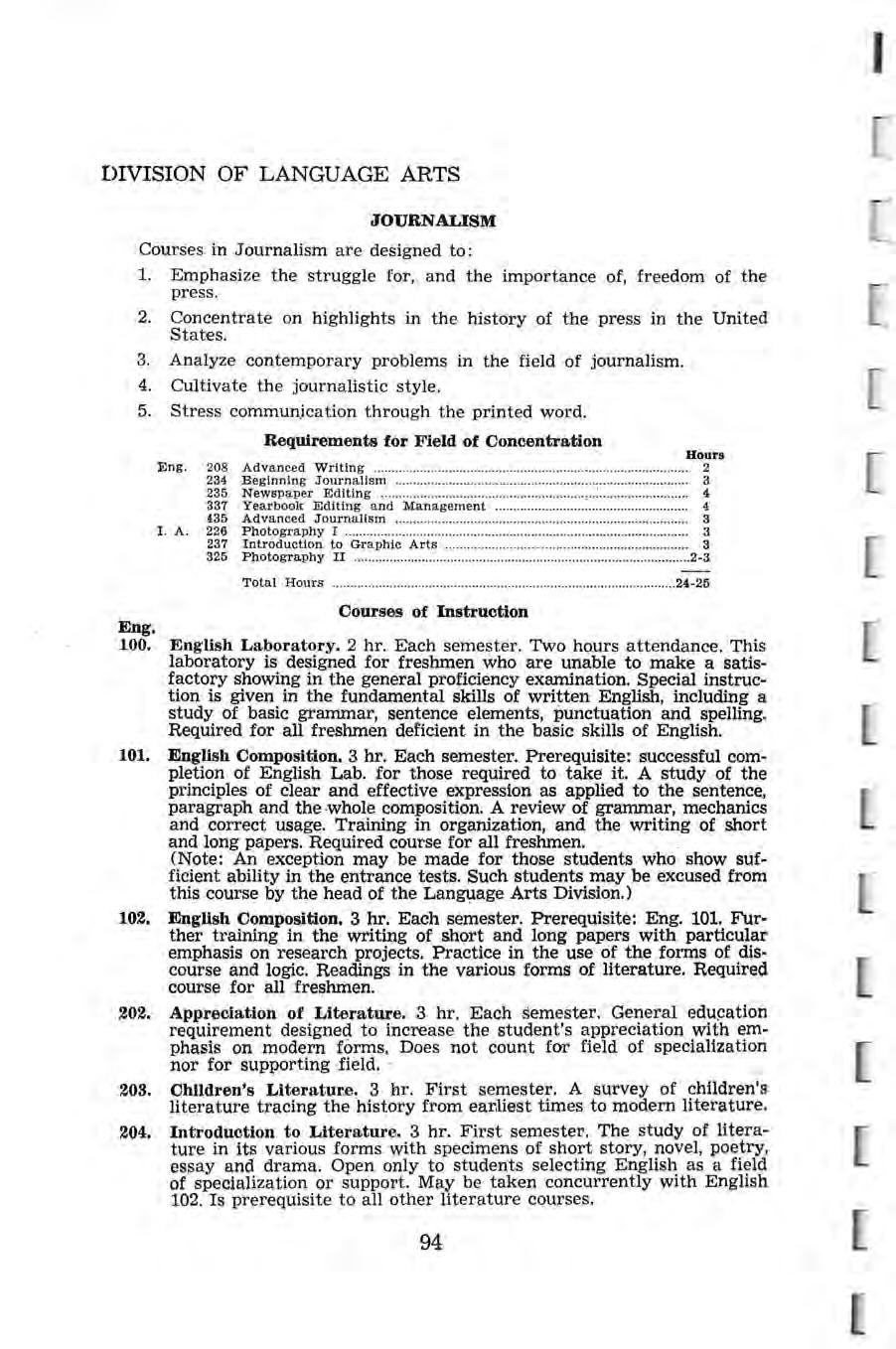
202. Appreciation of Literature. 3 hr. Each semester. General edu~ation requirement designed to increase the student's appreciation with emphasis on modern forms. Does not count for field of specialization nor for supporting field. ·
208. Children's Literatur.e. 3 hr. First semester. A survey of children's literature tracing the history from ear,liest times to modern literature.
204. Introduction to Literature. 3 hr. First semester. The study of literature in its various forms with specimens of short story, novel, poetry, essay and drama. Open only to students selecting English as a field of specialization or support. May be taken concurrently with English 102. Is prerequisite to all other literature courses.
208. A d va nce d Writing. 2 hr. Second se mest er 1971-72. Special projec t for third hou r. Adv a nc ed s tudy of the t h eor ies of co mpo s iti o n a nd th e app li cation of these theories through lon ger writings. Emphasis on the trad itional forms of writing With sb me atte nti on g iven to creat ive writ in g.
222 . The Hell e nic~H e brai c Tradition. 3 h r. Second semester 1971 -72. An in trod ucti on to the roots of Englis h Lit erature in Greek, Roman ancl H ebrew li terature Prerequ isite, E ngli s h 204.
225. Short Story. 2 hr. First se mester. Majo r e mpha s is on the deve lopm ent of t h e short story in Amer ica.
234 . B eg inning Journ a lism. 3 hr . Each semester. A practical course in th e writing a nd editing of n ews copy, coverin g minimum essentials. M emb ers of t h e class do the r eportin g for th e college n ewspape r, Th e Pedagogian . A b asic cours e for those interested in journ a lism a s a v oca tion. Open to those of sopr-omor e sta ndin g or a bove.
235. Newspaper Editing. Credit not to exceed two hour s in any se m ester or four hours in the aggregate may be allowed to ap poin ted editor or editors of the college n ewspaper, Th e Pedagogi an.
306 . Nebras ka Literature . 2 hr. Second semester. Prere quisit e : consent of t h e departme n t. An introduct ion to the works of Nebraska wr iter s and lite ratu re abo ut Nebraska.
317. Chaucer. 2 hr . First se m ester 1,.<l 71-72. Th e fo urt eent h century as revea led by C h aucer and hi s con temporaries .
318. Neo-Classical ' Writers. 2 hr Seco nd se mest er Th e philosophy and esthetics of th e e ightee nth ce ntu ry as re flect e d in t h e m ajo r wr iters
321. Rom a ntic Period. 3 h r. Fir s t semester 1971-72 Romanticism as reflect e d in Wordsworth, Col e ridg e, Byron, Sh elly and Keat s.
322. Continental World Lit eratur e . 2 hr Second semester. (From the Ren a iss ance to t h e present). Emphasis on a few majo r pi eces of contin e ntal lit er atur e (ch iefly fiction ) from the Renaissa n ce to th e pr ese n t. A study of the wr it er as think er and the litera tur e as a mirr or of t h e tim es. Cerva nt es, P asca l, Voltair e, Go et he, Blazac, Dostoi evs ki , and Ma nn a r e amo n g the au thor s st udi e d
323. Victorian Period. 2 h r . F irst semester 1971 -7 2. Nineteenth ce ntury En g la nd as see n by h er m a jor poets; some atte nti on to prose writer s
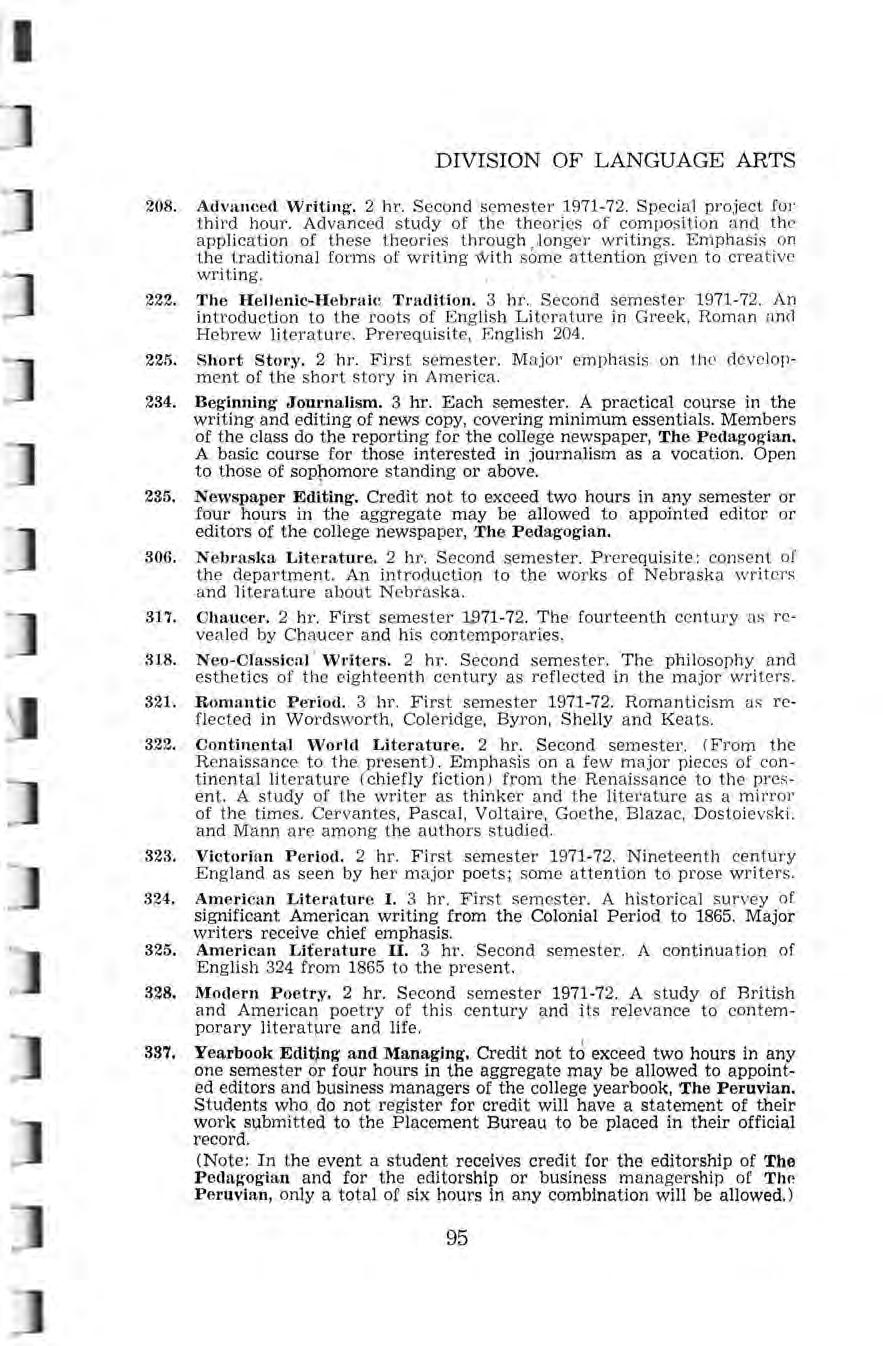
324. Am e ri ca n Literatur e I . 3 h r. First se m es ter A hi s toric a l s ur vey of significant American writing from the Colonial Period to 1865. Major writers re ce ive chief emphasis.
325. American Liter a tur e II. 3 hr. Second se m es ter . A continuation of Englis h 324 fr 9m 1865 to th e pr ese n t
328. Mod e rn Poetry. 2 h r . Second semes t er 1971-7 2. A st ud y of Briti s h a nd America11 po e tr y of thi s ce n t ur y a nd its re leva n ce to co n tempor ary lit e ratµr e and life.
337. Yearbook Edit;.ng and Managing. Credit not t d exceed two hours in any on e semeste r or four hours in the aggre ga te may be allow ed to appointe d ed itors a nd busine ss mana g ers of the college yearbook, The Peruvian. Students who _ do not r eg iste r for cr edit will h ave a statement of their wo r k submitted to th e Placement Bureau to be placed in their official record.
(Note: In t he event a st udent receives c re dit for the editorship of The Peclagogi a n and for t h e editorship or busin ess m anagership of Thr. P e ruvian, on ly a total of six hours in any combination will be allowed .)
405. Teaching English a nd Speech. 2 hr Prerequisite: Senior stan din g. This course is a study of the a ims , object iv es and scope of English and speec h in th e curriculum. Resources such as textbook s, film li s t s, special equipment, records, c h arts and tests are examined and eva luated. R e cent teac hin g techniques are explored.
418. Shakespeare. 3 hr . Second semester. A study of representat ive plays and sonnets. (Credited as either English or Speech.)
425. English, Grammar and Linguistics . 3 hr. First semester. An introduction to hi s torical, descript ive a nd structura l l in g ui s tic s as a n a id to the und e r s tanding of modern concepts and philosophie s of gra mm ar.
435. Advanced ,Journalism. 3 hr. Each semester. Two hours attendance, two hours l a boratory. Prerequisite: Eng. 234. Continuation of practical exper ienc e in writing and editing news copy Special emphasis on techniques in sponsorship of high school publications and school n ews publicil. rele ases. Major position s on staff of college new s pa per, The Pedagogian, filled from membership in this cl ass.
440. History of the English Language . 2 h r. First semester. A study of the growth of modern Engli s h throu g h exam in ation of changes in the sounds, forms, a nd syntax that h ave occurred in the l a ngua ge a nd the development of vocab ul ary
441. Pre -S hak es pearean Drama. 2 h r. Firs t semester 1971-72. The d eve l opm e nt of drama a nd theatre throu g h cl ass ical and native chan n els to their culmination in E li zabethan dram a (C r e dit e d as either Eng li sh or Spe e ch.)
442. Post-Shalrns pea rean Drama. 2 hr. Second se mester 1971-72. Focus is on the major dr a m a ti s ts since Shak es peare . (Credited as e ith er E n glish or Speech.) •
450. Directed St udi es in English. Eac h semester. Open only to se niors with an over -a ll G .P.A. of 7 in the fi e ld of Eng li sh. Must be in e xc e s s of the minimum (36) hours r e quired for field of s pecialization. Desi g n e d to enable g i fted st ud e nt s to inve s ti gate ind e pend e ntly an area of int erest, particularly w h e n the area is not cov e red by one of the formal cours e s.
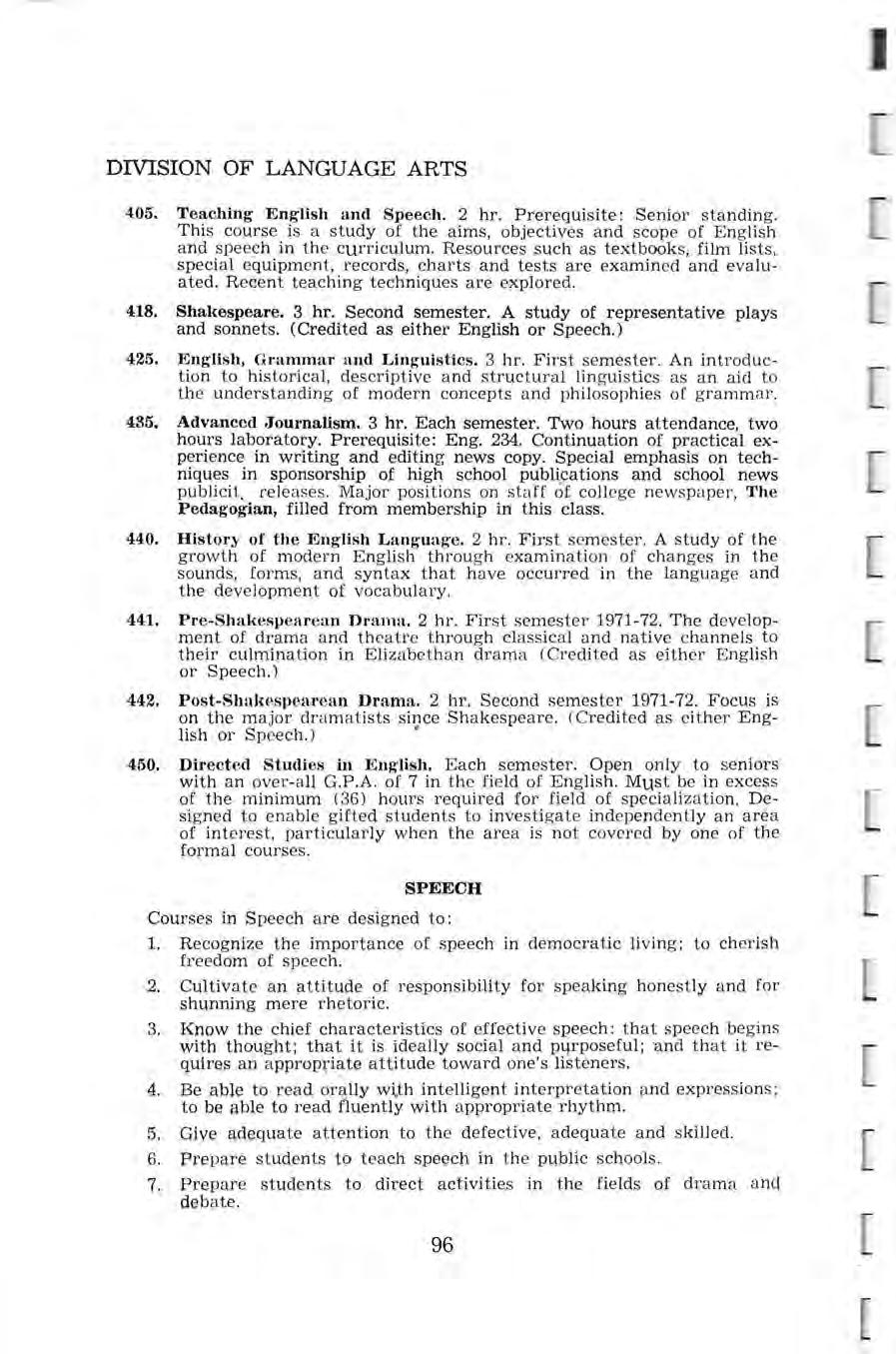
Courses in Sp eech are designed to:
1. Recognize th e importance of speec h in demo c ratic li ving; to cheris h freedom of speech.
Cultivat e a n attitude of responsibility for speak in g hon estly an d for shunning mere rh e toric. ·
4.
Know the chief characteristics of dfective speech: t h at s peech begins with thou g ht ; that it is ideally social a nd p4rposeful; and that it requires an a pprop r i~ te att itud e toward on e ' s li ste n e r s, Be ab le to read oral)y wtth int elli gent inter pr e tation and e xpre ss ion s; to be able to read ti11e ntly with appropriate rhythm.
5. Give adequate at t ention to th e d efective, adequate and s killed.
6 . Prep c1 re stud ent s to t eac h speech in the public schools.
7. Prepar e st udents to direct 1;1.ctiviti es in t h e fields of dr a m a a nd d ebate.
2. 3,152. Fundamentals of Speech. 3 hr. Each semester and summer •The principl es of speech. Development of bodily freedom, distinct utterance and improv ed oral communication. Includes fundamental processes of speech correction and development with emphasis on the development of excellent speech habits and the diagnosis and treatment of elementary speech defects. Required course for a ll freshmen.
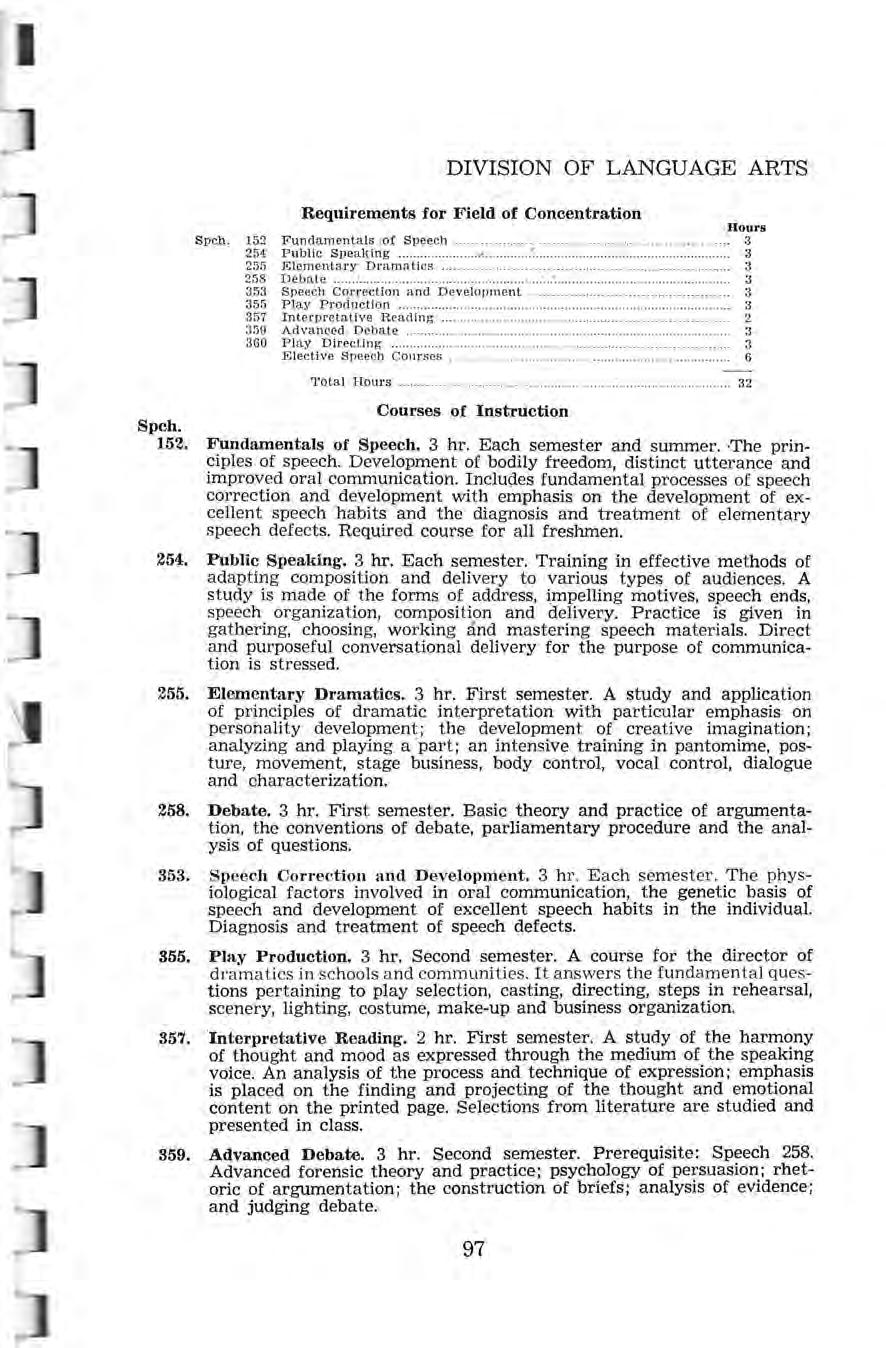
254. Public Speaking. 3 hr. Each semester. Training in effective methods of adapting composition a nd delivery to various types of audiences. A study is made of the forms of address, impelling motives, speech ends, speech organization, composition and delivery. Practice is given in gathering, choosing, working a nd mastering speech materials. Direct and purposeful conversational delivery for the purpose of communication is stresse d.
255. Elementary Dramatics. 3 hr. First semester. A study and application of principles of dramatic interpretation with particular emphasis on personality development; the development of creative imagination; analyzing and playing a part; an intensive training in pantomime , posture, movement, stage business, body control, vocal control, dialogue and characterization.
258. Debate. 3 hr. First semester. Basic theory and practice of argumentation, the conventions of debate, parliamentary procedure and the ana lysis of questions.
353. Speech Correction and Development. 3 hr . Each semester . The phy siological factors involved in oral communication, the genetic basis of speech and development of excellent speech habits in the individual. Diagnosis and treatment of speech defects.
355. Play Production. 3 hr. Second semester. A course for the director of dramati cs in s chools a nd communities It answers the fundamental qu estions pertaining to play selection, casting, directing, steps in rehearsal, scenery, lighting, costume, make-up and business organization
357. Interpretative Reading. 2 hr. First semester. A study of the harmony of thought and mood as expressed through the medium of the speaking voice. An analysis of the process and technique of expression; emphasis •is placed on the finding and projecting of the t hou ght and emotional content on the printed page. Selections from literature are studied and presented in class.
359. Advanced Debat,e. 3 hr. Second semester. Prerequisite: Speech 258 Advanced forensic theory and practice; psychology of persuasion; rhetoric of argumentation; the construction of briefs; analysis of evidence; and judging debate.
360. Play Directing. 3 hr. First semester. Prerequisite: Speech 355. A study and application of the theories of play direction.
362. Psychology of Speech. 3 hr. Second semester. An inv es tigation into the process of speec h as a form of co mmunication. Attention will be given to th e psychological field , socionomy, general semantics and group dynamics.
401. Teaching Speech in the High School. 2 hr Prerequisite: senior standing. In this course we study aims, objectives a,nd scope of speech in the curriculum. Resources such as textbooks, film lists , special equipment, supplies , records, charts and tests are examined and evaluated .
415G. Speech Composition. 2 hr. First semester 1971-72. Prerequisite: sen ior standing. Th e speech purpose; th e division s of the speech; th e vocal u se of words; the form of a ddr ess.
,rn-i. Make-up. 2 hr First semester Instruction and pra ctice in make-up for the stage.
Co ur ses in Modern Language arc de sig n e d to:
1. Provide students with a valuable an d useful linguisti c tool.
2. Furnish collateral cu ltu ral under sta ndin g for st udent s spec iali zi n g in other fields.
3. Gain a knowledge and unders ta ndin g of th e literatur e, culture a nd civili zat ion of a foreign country.
4. Pr epare prospective language teachers .
Requirements for :Field of Concentration
Hours
Spanish ·26
Spanish
101. E l ementary Spanish . 5 hr Beginners' Cours e Fundamentals of gramm ar an d pronun cia tion are st udi ed. Ground work for the acquisition of a vocabulary is laid. Reading, translation, oral drill, and conversation for beginners .
] 02. E lementary Spanish. 5 hr. Prereq ui s ite: Spanish 101 or equivalent. Thi s is a continuation of Spanish 101. It widens th e gra mm ar, improv es pronunciation, aids reading and conversation. I
201. Spanish Reading and Composition. 3 hr. Pr r, requisite: one year of Spanish or its eq uivalent. The purpose of this course is to g ive t he s tud ent a fa i r reading knowledge in modern SJ?anish, but conver sa tion is a l so stressed. The reading m ateria l is c ho~en so as to make the students become acquainted with the civilization of Spain, Centra l and South America. '
202. Spanish Reading a iHi Compos ition. 3 hr. Prerequisite: Spanish 201. A continuation of Course 201 . The a uth ors to be read are chosen from Spain, Central a nd South America.
30 1. Third Year of Spanish. 3 hr Pr ereq ui si te: two years of Spanish. The cla ss ical period of Spani s h literat ur e. A synopsis of the st udy of the picaresque novel al}d dr ama of the Go ld en Age. Intensive re ad in g of Don Quixote of Cervantes, Lazarillo de Tormes and dramas of Lope de V ega, Calderon, and others. Class discu ss ion of these works .

302. Third Year of Spanish. 3 h r. Prerequisite: Spanish 301. The Spanish novel of th_e 19th century. Continuation of Course 301. A sy nopti c s tudy of the outstanding figures ..i n th e-, evo lution of the Spanish no ve l durin g the 19th century with spec ial .a tt e ntion to Alarcon, Galdos, Valdes, Pereda, and Blasco Iban e'z · '
401. Fourth Year of Spanish. 2 hr. Prerequisite: thr ee years of Spanish. Survey of Spanish lyri cs Lecture s on Spanish lyrics beginning with folklore, through the Golden Age, a nd Romanticism till the present day.
402. Fourth Year of Spanish. 2 hr. Prerequisite: Spanish 401. Survey of Spanish dr ama of the 19th century and 20th century. Based es p ecia lly on dramatical prod uction s of Perez, Galdos, Los Quinteros, M a rquin a, Oliver and others. Discussions, outside readings and c las s papers.
405. Methods of Teaching· Modern Language. 2 hr. Thi s course is a study of the a ims, objectives, an d scope of Modern Language in the curriculum. Resources such as textbooks, film li sts, s pecial eq uipm e nt, supplies, record s, charts, and tests are examined and eval u ate d. Attention is given to special techniques for teaching the subject.

101. Elementary French. 5 hr Be g inners' Course It comprises the fundamental phases in th e s tudy of the Fr enc h languag e as: gram m a tic a l form, pronunciation, vocabulary. Work is don e in reading, translation, and conversation.
102 . Elementary French. 5 hr. Prerequisite: Fr. 101 or e quival e nt. This is a continuation of Course 101 Here also stress is laid on gra mmar, sy ntax, oral drill, and conversation. Easy reading in modern French is given.
Donnell Cattle
C. VERNON SIEGNER, HEAD OF DIVISION Lucy HoveyJerry Cox Dec V.
David Gunderson
,Jarvis Louise J{regcl Frieda Rowoldt Lester Russell Darrell \VlningerPractical Arts is concerned with areas of study which emphasize practical activities and understanding typified by Industrial Arts, Business and Home Economics. The major objective is to enable individuals to prepare for personal living needs through practical activities. Courses are designed to give students theknowledge, habitsandskillsnecessaryfor teaching and to providesufficient preparation for vocational use.
ThecoursesinBusinessaredesignedtoaccomplishthe following objectives:
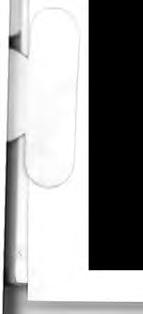

1. Toprovideprospectiveteacherswithabackgroundenablingthem to developtheknowledges, skills, attitudesandtechniquesneeded toteachin modern secondary schools.

2. Togiveup-to-date trainingenablingmenandwomento advanceto positions of responsibility andleadershipin the business world.
3. Toprovidea background inbusiness practices and policies to enable the student to make intelligent decisions.
4. To prepare students for graduate work in Business. Business Education or Business Administration may be selected as a field of concentration for the Bachelor of Science in Education degree enabling one to qualify for a Nebraska Secondary School Certificate. Either one of the Business Education curricula may be selected as a field of concentration for the Bachelor of Science in Education degree enabling one to qualify for a Nebraska Secondary School Certificate.
Secretarial may be selected as a fi e ld of concentration for th e Bachelor

or Bach e lor of Arts degree, enabling one to qualify for many
one-year or two-year program in Business may be selected enabling one to qua lify for m any clerical, secretarial or bookkeeping positions.
123. Introduction to Business. 3 hr. Every semester. A study of busin ess and the environment in which it is conducted ; types of business firms, functions they perform, problems confronting th em and possible solutions for these problems are considered.
131. Elementary Shorthand. 3 hr. First se mester. Prerequisite: Bus 121 or eq uiv a lent or being enrolled in Bus. 121. Five hour s attendance. A study of reading a nd writing shorthand, and a n int ro duction to dictation and transcription. A student having one unit of hi g h school credit in shorthand will not be allowed to t a ke this course for credit.
132. Intermediate Shorthand. 3 hr. Every semester. Prerequisite: Bus. 131 or one unit of high school credit in shorthand. Four hours attendance. A continuation of Bus. 131, emphasizing the development of skill in dictation and transcription.
215. Personal Business Finance. 3 hr. First semester. Fund ame ntal s of personal fin a nc e. Budgeting; banking; life insurance ; accident, h ea lth, a nd cas ualty insura nc e; inv es tm e nts; trusts ; taxes; in come taxes a nd social security.
220. Intermediate Typewriting. 3 hr. Eve ry se mest er. Prere quisit e Bus. 121 or one unit of high school credit in typewriting. Stresses spee d a nd acc uracy in typ ew ritin g lett ers, m a nuscript s, tabulations a nd other forms.
231. Principles of Accounting. 3 hr. First semester. Prerequisite : Bus. 123. Four hours attendance. An introduction to the process of recording financial data and preparing periodic financial statements and special reports for the sole proprietorship and partnership.
232. Principles of Accounting. 3. hr. Second semester. Prerequisite: Bus. 231. Four hours attendance . A continuation of Bus. 231, considering the accounting process in the corporation; the student is introduced to accounting theory, financial statement analysis and cost accounting
235. Business M achines. :i hr First semester. Three hour s at tend ance with individu a l labo rat ory w9rk arra nged . Basic calculating m ac hine operations, care of the m ac hines, and business application problems are stressed .
237. Principles of Management. 3 hr. First semester. Prerequisite : Bus. 123. A study of the planning, organizing, directing and controlling functions of man age ment; the student is introduced to production, mark e ting, financial, personnel and office management.
240. Office Machines. 2 hr Second semester. Prerequisite: Bus. 121 or equivalent. Mac hine s used in the present day business office other than ca.Jcul a ting m ac hin es are studied. Th ese include a st udy on the various duplicating machines, posting machines, simulated k e ypunch, transcribing machines, and oth er machines ava ilabl e for demonstration.
324. Business Correspo~deuce. 2 hr. Second semester. Prerequisite: Bus. 220 and Eng. 102. A study of the composition and typewriting of the m a jor forms of business letters.
325. Secretarial Procedures. 3 hr. Second semes ter . Prerequisite: Bus. 123, 132, a nd 220. Secret ar ial responsibilities in the modern offir important personal qualities of the secretary, a nd r ecords m ana1-· ment are studied.

328. Principles of Marketing. 3 hr. First semester. Prerequisite: Bus 123. A study of the buying, selling, transporting and storing functions involved in marketing; the studen t is irl.troduced to retailing, wholesaling and marketing management.
329. Advertising. 2 hr. Second se me ster . Prerequisite: Bus. 328. A study of the planning and preparation of advertisements, the selection of appropriate advertising media and agencies and the role of advertising in the total marketing program
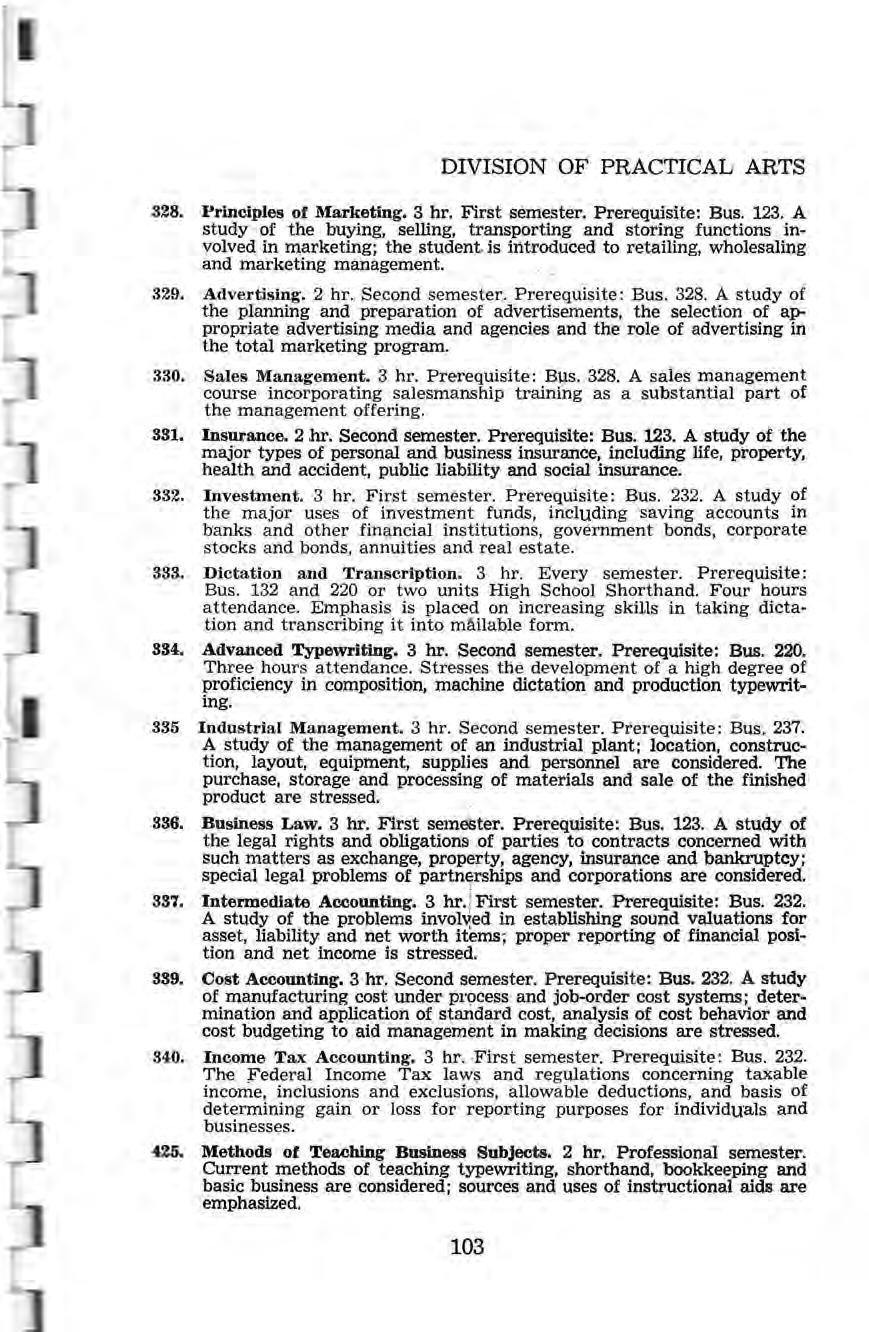
330. Sales Management. 3 hr. Prerequisite : Bi,is . 328. A sales management course incorporating salesmanship training as a substantial part of the manageme nt offering.
381. Insurance. 2 hr. Second semester. Prerequisite: Bus. 123. A study of the major types of personal and business insurance, including life, property, health and accident, public liability and social insurance.
332. Investment. 3 hr. First semester. Prerequisite: Bus. 232. A study of the major uses of investment funds, including saving accounts in banks and other financial institutions, gove rnment bonds, corporate stocks and bonds, annuities and real estate.
333. Dictation and Transcription. 3 hr. Every semester. Prerequisite: Bus. 132 and 220 or two units High School Shorthand. Four hours atte ndance Emphasis is placed on incre as ing skills in taking dictation and transcribing it into m Ailable form.
884. Advanced Typewriting. 3 hr. Second semester. Prerequisite: Bus. 220. Three hour s attendance. Stresses the development of a h ig h degree of proficiency in composition, machine dictation and production typewriting.
335 Industrial Management. 3 hr. Second semester. Prerequisite: Bus . 237. A study of the management of an industrial plant ; location, construction, layout, equipment, supplies and personnel are considered. The purchase, storage and processing of materials and sale of the finished product are stressed.
836. Business Law. 3 hr. First seme!ster. Prerequisite : Bus. 123 A study of the legal rights and obligations of parties to contracts concerned with such matters as exchange, property, agency, insurance and bankruptcy; special legal problems of partnerships and corporations are considered. ;
387. Intermediate Accounting. 3 hr. / First semester. Prerequisite: Bus. 232. A study of the problems invohied in establishing sound valuations for asset, liability and net worth it~ms; proper reporting of financial position and net income is stressed.
889. Cost Accounting. 3 hr Second semester. Prerequisite: Bus. 232. A study of manufacturing cost under process and job-order cost systems; determination and application of standard cost, analysis of cost behavior and cost budgeting to aid management in making decisions are stressed.
340. Income Tax Accounting. 3 hr . ,First semester. Prerequisite: Bus. 232. The ;Federal Income Tax law'!;i and regulations concerning taxable income, inclusions and exclusions, allowa ble deductions, and basis of determining gain or loss for reportin g purposes for individuals and businesses.
425. Methods of Teaching Business Subjects. 2 hr. Professional semester. Current methods of teaching typewriting, shorthand, bookkeeping and basic business are considered; sources and uses of instructional aids are emphasized.
426. Advanced Dictation and Transcription. 3 hr. Second semester Pr erequisit e: Bus. 333 Four hours att e ndance Greater increase in th e sp ee d and accur a cy in takin g tim e d dictation. More emphasis in improving quality and quantity of transcribed product
428. Problems in Business Education. 2 hr. On demand. Research, di scu ss ion a nd writing on probl ems not previously studied. Independ ent study by a rran ge ment.
431. R e tail Manage1Jient. 3 hr. Se c ond seme s ter. Pre requi s ite: Bu s 328. A study of the management of retail stores; location, construction, layout, equipment, supplies and personnel are considered. The purchase, storage and promotion of merchandise are stressed
432. Business Finance. 3 hr Second semester. Prerequisite: Bus. 232 and Econ 220. A study of th e us es of funds to fin a nce a ss e ts, int e rnal a nd external sources of funds and the cost of funds obtained from altern ativ e sources under various conditions.
433. Office Management. 2 hr. On dem a nd. Prerequisite : Bus. 237. A study of the management of an office; location, layout, equipment, supplies and personnel are considered. The efficient handling of information is stressed.
434. P e rsonn e l Management. 3 hr. S e cond se mest e r Pre r e quisit e : B us. 23 7 , A study of the management of labor; selection, training, compensation and supervision are considered. The human relations element is stressed .
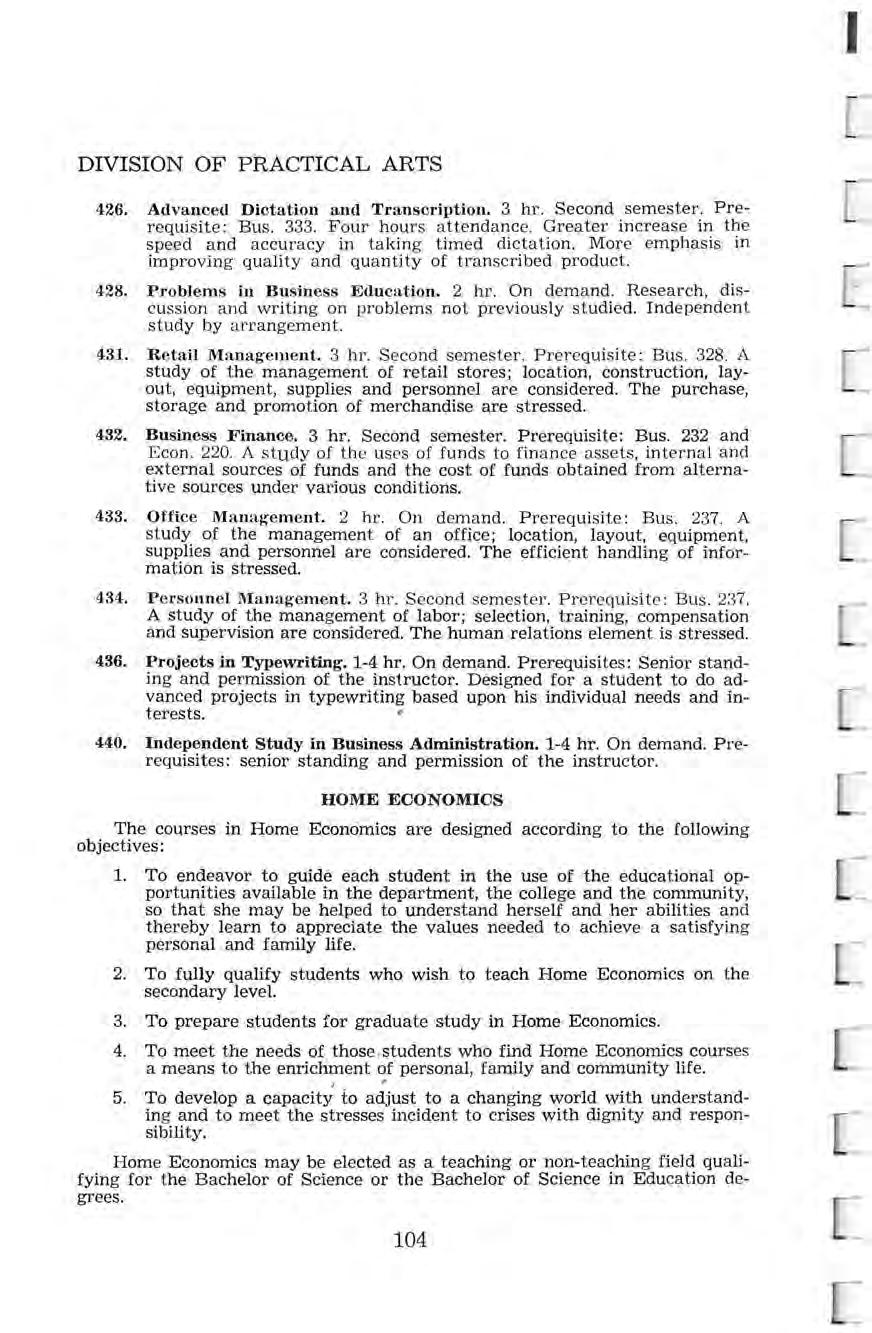
436. Projects in Typewriting. 1-4 hr. On demand Prerequisites: Senior standin g and permission of the instructor. Designed for a student to do advanced projects in typewriting based upon his individual needs and interests. •
440. Independent Study in Business Administration. 1-4 hr. On demand. Prerequisit es: senior standing and permission of the instructor.
The courses in Home Economics are designed according to the following objectives:
1. To endeavor to guide each student in the use of the educational opportunities available in the department, the college and the community, so that she may be helped to understand herself and her abilities and thereby learn to appreciate the values needed to achieve a satisfying personal and family life.
2. To fully qualify students who wish to teach Home Economics on the secondary level.
3. To prepare students for graduate study in Home Economics.
4. To meet the needs of. those students who find Home Economics courses a means to the enrichment of personal, family and community life . . , ,
5. To develop a capacity to adjust to a changing world with understanding and to meet the stresses incident to crises with dignity and responsibility.
Hom e Economics may be elected as a teaching or non-teaching field qualifying for the Bachelor of Science or the Bachelor of Science in Education d egrees.
133. Beginning Foocls and Nutrition. 3 hr. First semester. Two hours lecture a nd discussion; thre e hours laborat ory. Funda m ental principles of food selection and preparation; food composition in r elation to h e alth.
134. Mea l Planning and Food Preparation. 3 hr Second semester. Two hours l ectu re and discussion; three hou rs laboratory. Prerequisite: H E 133. Th e purch as in g of foods; plannin g and serving m ea ls for family gro ups using the basic four plan.
141. B eginning Clothing Selection and Construction. 3 hr First semester. Six hours l a boratory. Selection •of wearing apparel based on principles of design a nd color, line, texture, fabric, style, purpose, personalityinterpretation a nd us e of commercial patterns in clothing construction a nd simple problems in renovation.
205. Sel ection, Use and Car e of Household Equipment. 3 hr. Fi rst semester. Two hour s lecture; three hou rs l abo r atory A course covering the fund a mental principl es of ca re a n d operat ion of equipment to give m aximum servic e in re l a tion to operation and service cost; und e rstandin g of common rep a ir problems.
232. Hom e Planning. 3 h r. On dem a nd. A course designed to serve those who wish to b u y, build or r e mod el and w h o need to know abo ut prop e rty a nd h ou ses to m a ke 3; l arge investm e nt.
302. Child Dev e lopment. 2-3 hr. S e cond semeste r. Scope of course covers from pren a tal throu gh pre-school ages. The third hour credit will involv e a t er m pa per and more extensive study of pre-schools. Pre-school l abo ratory of four we eks.
310. Principles of Home Economics D emonstration . 3 hr. Second semes t er. Six hour s l a boratory . Prerequisite: H. E. 1 33, 1 34, a nd 141. Fundam e ntals in home eco n om ic d emonstration u sed by the teach e r, 'hom e econom i cs age nt, and co mmerci a l demon s trator.
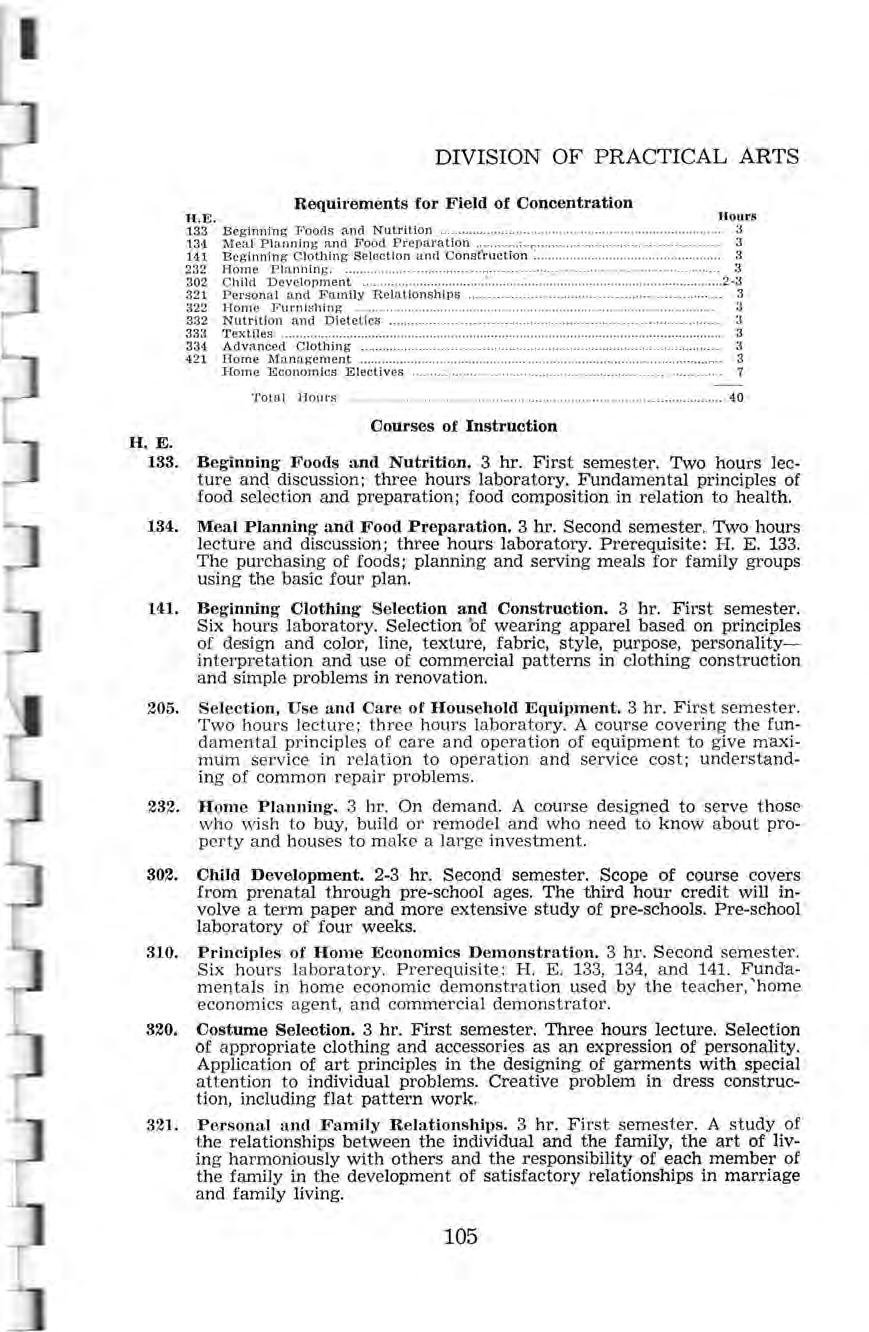
320. Costume Selection. 3 hr. First semester. Three hours lecture Selection of app ropriate clothing a nd acc essor ies as an expression of personality Application of art principles in the designin g of garments with special atte ntion to individual problems. Creative problem in dress construction, including flat pattern work.
321. Personal a nd Famil y Relationships. 3 hr First semester. A stu dy of the relationships between the individual and the family, the art of livin g h armonio usly with others a nd the r esp onsibility of each member of the family in the development of s a t isfactory relationships in marriage and family living.
322 . Home Furnishing. 3 h r. Second se me ster. A st ud y of today's h c;, us in g problems and factors to be considered in building, buying or r ent ing a house; the selection a nd arrangement of furnishing from the standpoint of comfort, beauty and ec onomy
323 Cos tum e History. 3 hr Second semester. Aspects of cult ur e of various countries and periods of history as refl ec ted in costume.
325. Costume Design-Flat Pattern. 3 hr . Second semester. (1 hr . l ec tur e, 3 hr. lab.) . Pre requisite : H.E . 33 4. Some basic problem s are prese nt ed in fl at pa ttern m a king. A pe rsonal master pattern is develop e d for each student. Creative problems are planned to develop s kill in th e app li cation of a rt princip les to costume.
332. Nutrition and Dietetics. 3 hr. Second semester. Fundame nt a l principl es of hum an nutri t ion a nd its de velopment through r esearc h as related to the _ dietary n eeds of individuals acco rding to their age, sex a nd / or occupation .
333. Textiles. 3 hr. First semester. Lecture and recitation . A study of weaves, yarns, fibers a nd finishes with r efe renc e to the selection a nd care of fabr ics for clothing and for the home
334. Advanced Clothing. 3 hr . Second semester. One hour lec ture, five hour s laboratory. Prerequisit e: H. E. 141. This course is d es ign ed to m eet the student's n ee d for the more difficult co nstruction problems which are enco untered in tailoring a nd renovation .
4 00. Sp!lcial Problems in Home Economics. 1, 2 or 3 hr On dem a nd. Speci a l resel!-rc h or study as n eede d by the individual.
421. Hom e Management. 3 hr. Firs t semester. Ma nag ement prob lems of th e hom ema k er in relation to effieiEnt mana gement of income, time, energy a nd eq uipment. Good mana ge ment practices in homemakin g problems through projects.
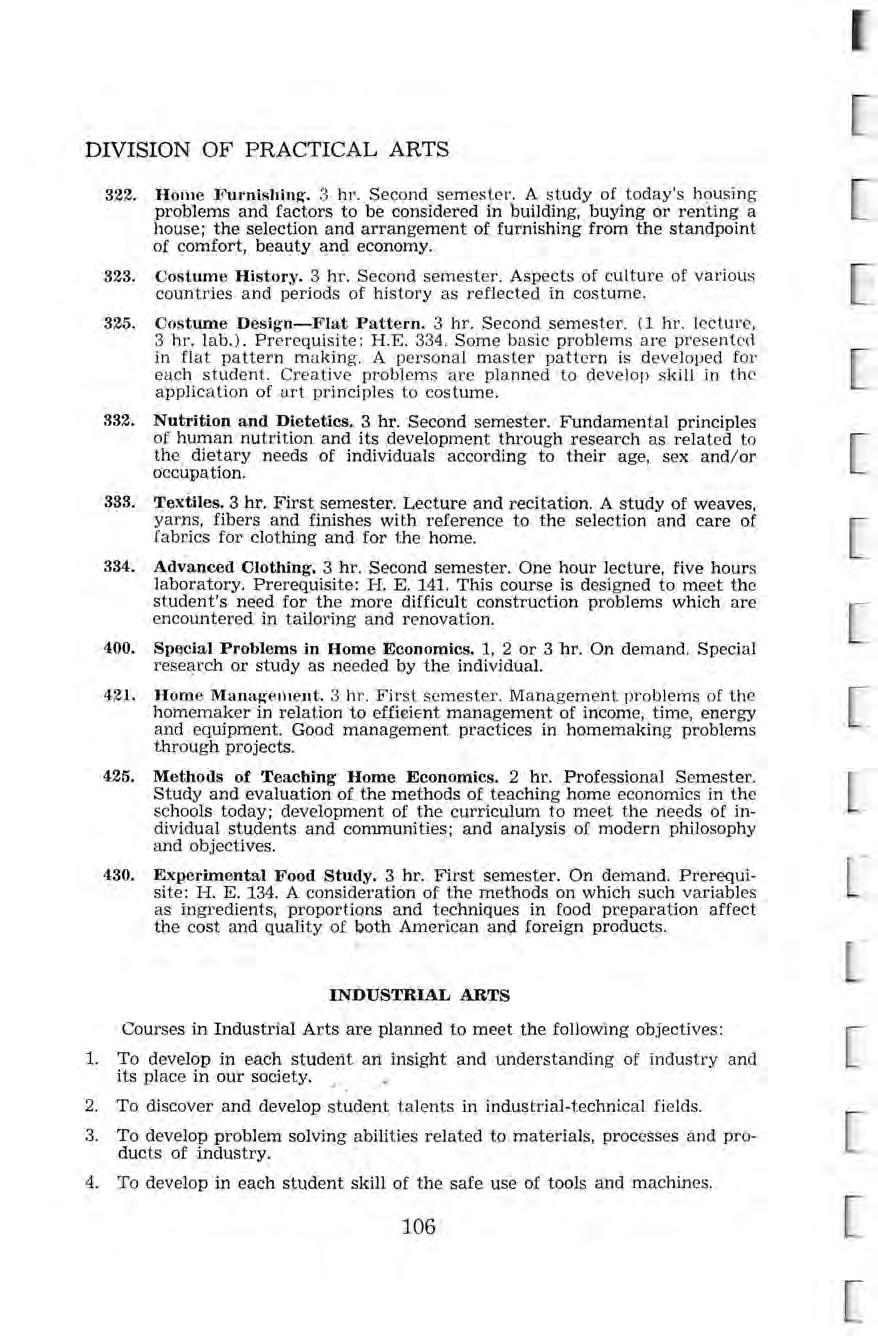
425. Methods of Teaching Home Economics. 2 hr. Profession a l S emester. Study and evaluation of the methods of teaching home eco nomi cs in the schools today; development of th e curriculum to meet the n ee ds of individual students and co mmunities ; and analysis of modern philosophy a nd objectives.
430. Experimental Food Study. 3 hr . First semester. On d eman d Prerequ isite: H. E. 134. A consideration of the methods on which such variabl es as ingredients, proportions and techniques in food preparation affect the cost an d quality of 'both American and foreign products
Courses in Industrial Arts are pl a nned to meet the following ob jec tives:
1. To develop in each student arr ins ight and und ers tandin g of industry a nd its place in our society.
2. To discover and develop student t a lents in industrial-technical fields
3. To develop problem solving ab ilities r elated to m ate ri a ls, processes and products of industry. ·
4. To develop in each student skill of the safe use of tools and m ac hin es.
Students in Industr ia l Arts T eac h er Education mu s t ha ve s ix credits in at least four of the following seven areas: draftin g, electricity-electronics, woodworking, pow er mechanics, metal-working, graphic arts, and cra fts.
The curriculum for the bachelor of science degree in Industri a l Manag ement Technology is designed for st ud e nt s whose m a in objective is pre paration for technician a nd managerial positions in industry. The curriculum ha s been developed to includ e a judiciou s c,ombination of t ec hnic al and business courses in order to prepare th e g r ad u ate for employment in a n industrial enterprise.
Job opportunities in this field include industri a l purchasing, m ate rials control, quality control, production control, methods a nalysis, a nd position s as foremen a nd production mana ge m e nt tr a inees.

Peru State College is one of the thirty-seven institutions approved by t h e Veteran's Administration in the field of manual arts therapy. The College ha s a clinical affil i ation program with the Veteran's Administration Center at Wadsworth, Kansas. See departmental chairman for curriculum requiremen ts .
121. Technic,al Drawing I. 2 hr First semester, Four hours labor a tory A cour s e concerned with the fundamentals of the graphic lan g u age The course includes sketching, orthographic, auxiliary, sectionin g a nd pictori a l drawing and the proper use a nd care of instruments.
123. Woodworking Technology I. 2 hr. First semester. Four hours laboratory. The development of basic skills in the use of both hand tools and elementary machine work. Emphasis is on the study of wood characteristics , orde rly procedure, safe working practices and the care of equipment.
124. Woodworking Technology n. 2 hr. Second semester. Prerequisite: I. A. 123. Four hours laboratory. Techniques and procedures in wood finishing using both traditional and new types of materials. Also the design and construction of furniture with emphasis on the use of special setups, jigs and fixtures.
132. Metals Technology I. 3 hr. Second semester. Six hours laboratory. Fundamental instruction in the areas of sheet metal, bench metal, forging and heat treatment, foundry welding and elementary machining.
222. Technical Drawing II. 3 hr. Second semester. Prerequisite: I.A. 121. Six h ours laboratory. The preparation of working drawings , in te rsections and developments, machine drawings, charts, diagram s a n d the use of diagrams and the use of drafting machine.
226. Photography I. 2-3 hr. Each semester. Two hours classwork and two hours of laboratory per week. Theory and practice in the basic fundamentals of photography including composition, exposure, lighting, developing, contact printing and enlarging. The third hour credit gained by additional assignments. Each student must have a camera.
227. Metals Technology n. 3 hr. Ind. Arts elective. Prerequisite: I. A. 132. Six hours laboratory. A second course in metal work with emphasis in the areas of heat treatment, foundry machine tool operation, and ba s ic metaHurgy.

231. Industrial Crafts I. 3 hr. Every semester . Six hours laboratory . Op en to all st ud e nt s. Basic experiences in working with a variety of cra f t media; including plastics, art metal l apidary, jewelry and leather .
233. Electrical Technology I. 3 hr. First semester. Six hours laboratory. Basic principles of and practice in the applications of electricity including theory in industry a nd the home. Areas of instruction includ e the production of electricity, magnetism, theory and basic ci r cuits, residential wiring, motors and generators, automotive electricity , a ppliance repair, electrochemis'try and elementary radio.
237. Graphic Arts. 3 hr. Second semester. Six hours laboratory. Study and practice in basic processes of printing and allied industries, including work in letterpress , silkscreen printing, bookbinding, rubberstamp making and goldleaf stamping. Also beneficial for those interested in journalism.
321. Shop Maintenance. 2 hr. First semester. Four hours laboratory Instruction in the use and care of equipment commonly found in the industrial arts laboratory. Practice will be given in the conditioning and repair of both hand tools and power tool~ and power equipment. Also covered is shop planning and its relationship to the ,proper function of industrial arts fac::ilities.
322. Hanif Crafts. 3 hr. Second semester. A course d es igned to give indust't-ial arts experiences through learning ac tivitie s with such materfals and problems in g lass ornamentation, ceramics, mosaics, metal work, plastics , and woodworking. Includes the st udy of materials, their cost, where they can be purchased, and the planning of projects
325. Photography II. 2-3 hr. First semester. Lens testing, infra-red photography, high speed photography, portraiture, use of negative and positive color films, color printing and oil coloring of prints.
326. Upholstery. 3 hr. Second semester. Prerequisite: I.A. 124 or by spe cial permission. Designed to give experience in and information about various methods of construction in upholstery both with and without use of springs.
327. Woodworking Technology m. 2 hr. First semester. Prerequisite: I. A. 124. Four hours laboratory. Emphasis on construction problems related to the building trades Also items related to the teaching of woodworking will be covered. •
328. Electrical Technology II. 3 hr. Second semester. Prerequisite: I. A . 233 or by special permission Six hours laboratory. A study of the principles and application of electronics and their applications in circuits, test equipment, vacuum tubes, transistors, radio and television.
329. Industrial Crafts. II. 3 hr. Second semester. Prerequisite: I. A. 231. Further exploration in one or more craft areas with emphasis on design and function. Also development of special problems and techniques.
330. Industrial Arts Design. 2 hr. First semester, alternate years. A study of the principles of design as applied to problems of construction, drawing and sketching of projects for the major areas of Industrial Arts.
331. Welding. 3 hr . First semester. Prerequisite: I.A. 132 or by specia l permission. , Four hours laboratory . Instruction and practice in the use of electric welding machines and the oxy-acetylene torch in welding and cutting. •

332. Power Mechanics I. 3 hr. Second semester. The study of the sources of power ·i'\n'ifof the machines used in its development with emphasis upon "' the) nterrial combustion engine
333 ; ·:Po~•er M:~cha-nlcs II. 3 hr. On demand. A study of the application of · , --' pow~r tD transport at ion and industry, its development, transmission rip¢! control.
334. Lapicla-ry and Jewelry. 3 hr An introduction to the b asic process of ,jewelry construction a nd l ap idary principles involving si.lver soldering, sawing, f!ling, rin g co n s truction, and setti ng of s ton es
335. Survival Preparedness. 1 hr. A study of facts related to survival in time of local , state or national disaster.
337. Driver, F)ducation and Traffic Safety I. 3 hr . First semester. Prerequisite: Twenty thousand miles or two years driving experience free of repeated chargeable accidents and movin g violations. This course w ill include presentation of materials and methods of traffic safety a nd driver training with emphasis upon attit ud e, development, orga ni z ation and administration, driving regulations a nd safe motor c a r operation.
338. General Safety. 3 hr. Second semester. This course is designed to familiarize the student with problems of accident prevention and conservation of human life and limb. Emphasis will be placed in the following areas: occupational, transportation, farm and the home and school. Instructional materials will be developed and studied.
340. Driver Education and Traffic Safety II. 3 hr. Second semester. Prerequis ite: Driver Education I. This course will provide an opportunity to construct materials re l a ting to and expe rime nt with m e thod s of pres e n ti ng lesso ns in traffic safety and behind-the-w:heel driving. Each student will be expected to teach a beginning driv e r
400. Indivichial Studies in Industrial Arts. 1-3 hr. Prerequisite : Approval by department. Ind ependent study of Industri a'I Arts to meet the needs of the st ud ent . For m ajors on ly.
425. Industrial Arts Methods and Observation. 2 hr. Professional Semester. The course will emphasize teaching methods and aids, course construction, testing, shop discipline, grading, safety and other problems pertinent to the teaching of the industrial arts. · 1
427. Architectural Drawing. 3 hr. First semester, a ltern ate years. Prerequisite: I. A. 222. Four hours laboratory. The principles of planning a dwelling to fit modern needs. Drawings will include: a plot plan, floor plan, four elevations, sections and details. Specifications will be determined by the student for the dwelling.
341. History and Philosophy of Vocational Education. 3 hr. Origins and philosophy of vocational education and the relationship to the school curriculum. Required for vocational certification and recommended as an elective for school a dmini st r a tors.
342. Organization and Administration of Vocational Education. 3 hr. A study of the principles and policies governing the administration of vocational educational programs in high schools, technical sc hool s, junior colleges, a nd adult education programs. Emphasis on the administ r a tion of Federally aided programs o f vocational education.
343. Coordination Techni'ques fn Vocational Education Programs. 3 hr . Analysis of Vocation a l Cooperative Programs and their relationship to the high sc hool, junior college , and adult vocational programs. Emphasis on the organization and s upervision of cooperative programs, duties and responsibilities of the coordin ator, selection and placement of students, a nd evaluation of students, training stations and the cooperative program.

Must h ave a minimum driving record of two years and 20,000 miles ( State and local) free from chargeab le accide nt s and moving traffic violations. A teaching certificate with a teaching major or endorsement, in a ddition to driver e ducation is required
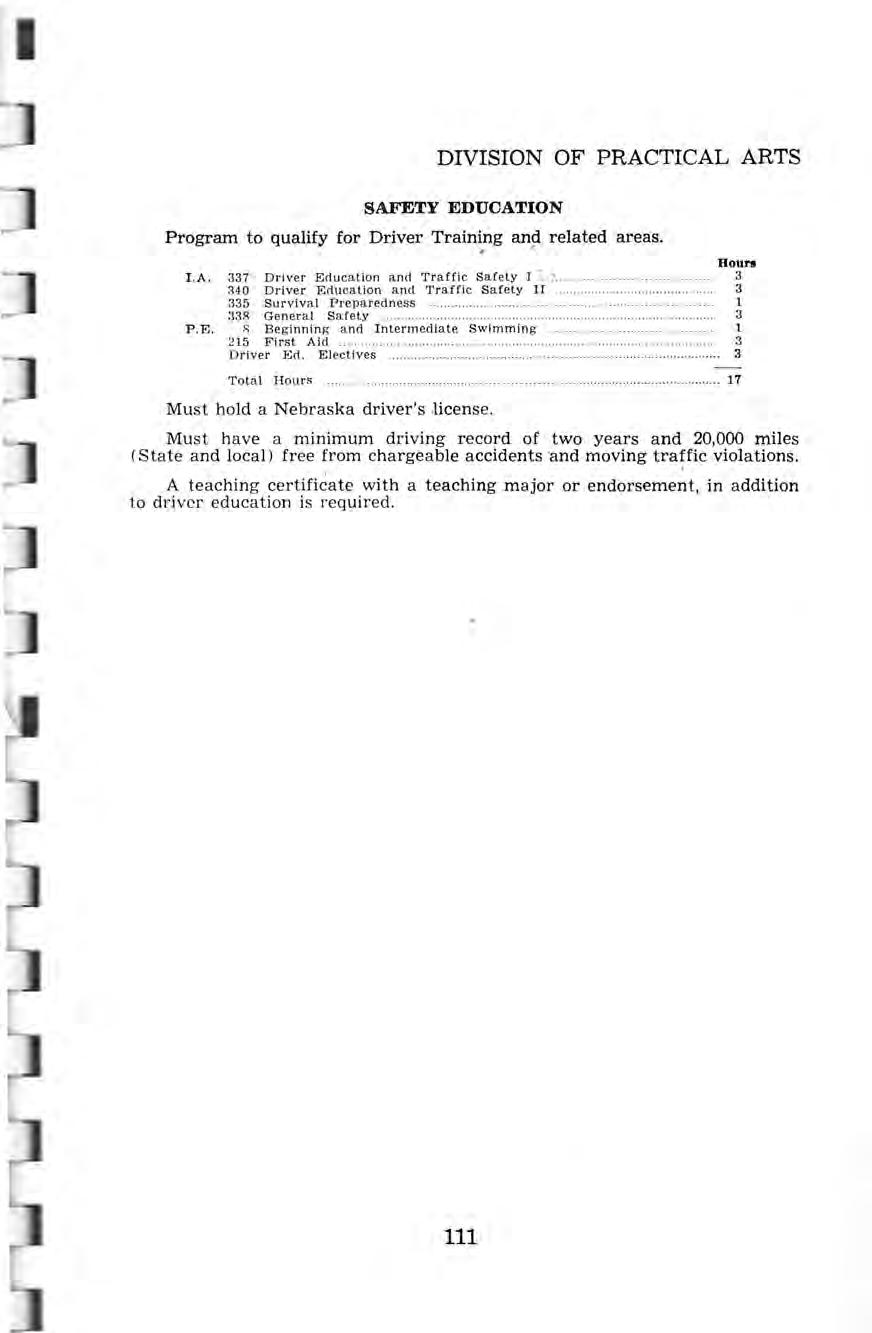
The Division of Science and Mathematics aims to provide for the needs of students in teacher preparation, pre -professional areas and general education. In each of these, mathematics and science are regarded both as an organized body of knowledge and as a method of investigation. Open-mindedness and a genuine appreciation of our environment are encouraged. The relation of these subjects to current affairs, the dependence of modern society upon the sciences, the research features of industry, medicine and government , as well as vocational opportunities in the various fields are included in the program.
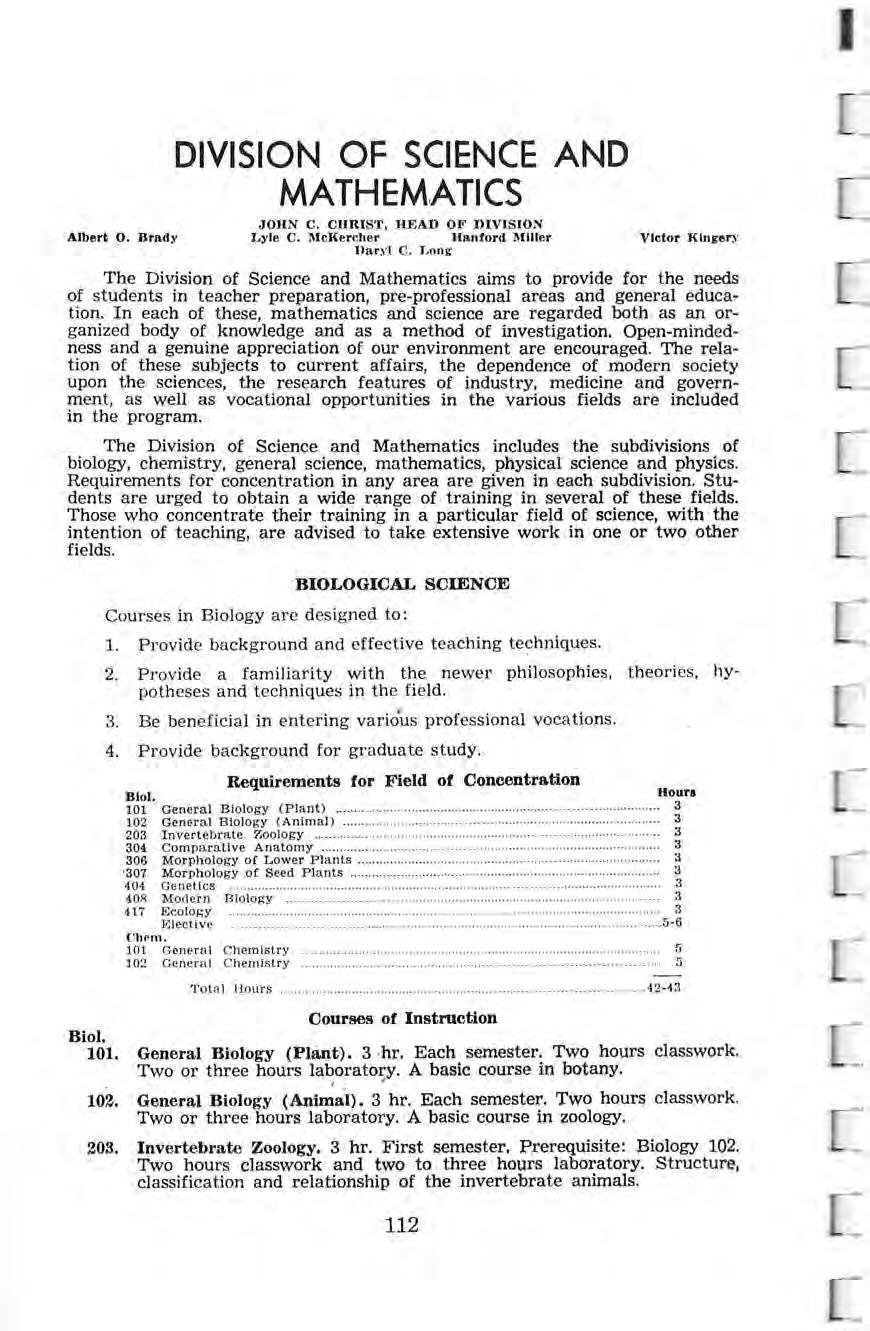
The Division of Science and Mathematics includes the subdivisions of biology, chemistry, general science, mathematics, physical science and physics
Requirements for concentration in any area are given in each subdivision. Students are urged to obtain a wide range of training in several of these fields. Those who concentrate their training in a particular field of science, with the intention of teaching, are advised to take extensive wprk in one or two other fields.
Courses in B iology are d es igned to:
1. Provide background and effective te ac hing techniques
2. Provide a familiarity with the newer philosophies, theories, hypotheses and techniques in the field.
3. Be beneficial in enteri ng various profess ional vocations
4. Provide background for graduate study.
204. Vertebrate Zoology. 3 hr. On demand. Prerequisite: Biology 102. Two hours classwork and two to three hours of laboratory. The anatomy, development and phylogeny of th~ vert~brates.
301. Microbiology. 3 hr. On demand. P.rerequisites: Biology 101, Chemistry 101 and 102. Two hours classwork and two to three hours of .laboratory per week. An introduction to microbiology.
804. Comparative Anatomy. 3 hr. Second semester. Prerequisites: Biology 102 and 203 or permission. Two hours classwork and two to three houl)S of laboratory per week. The anatomy of the shark, salamander and cat.
306. Morphology of the Lower Plants. 3 hr. First semester. Prerequisite: Biology 101. Two hours classwork, two to three hours laboratory. Structure, anatomy and form of the lower plants, and their effects on man.
807. Morphology of the Seed Plants. 3 hr. Second semester. Prerequisites: Biology 101 and 306. Two hours classwork, two to three hours laboratory. Form and structure of the seed plants and their economic value.
310. Biological Readings. 1-3 hr By arrangement only. Prerequisite: 12 hours of science. Work is done under the guidance of the instructor through a series of written reports and conferences. May not be used to meet science requirements. •
402G. Independent Study in Biology. 1-3 hr. On demand. Permits student to do advanced work in various fields of biology. Prerequisite: The background to do the work and the ability to do extensive, individual study. Permission of the instructor required for registration.
404G. Genetics. 3 hr. Second semester alternate years. Prerequisite: 15 hours of biology. Three hours classwork. The principles of heredity.
405G. Histology. 3 hr. On demand. Prerequisite: 15 hours of biology. One hour classwork and at least 4 hours of laboratory per week. A detailed study of the microscopic anatomy of mammalian organs.
406G. Embryology. 3 hr. On demand. Prerequisite: 15 hours of selected biology courses. Two hours classwork and three or more hours of laboratory. Embryology as exemplified by the frog, the chick, the pig and man.
407G. Human Physiology. 3 hr. On demand. Prerequisite: At least two courses in animal biology. A detailed study of functions of the human organs.
408G. Modern Biology. 3 hr. Second semester alternate years. Three hours classwork and demonstrations. Prerequisite: 15 semester hours of biology. A course designed to acquaint advanced students and graduates with BSCS biology and other recent developments in this and related fields.
415G. Taxonomy. 3 hr. First semester alternate years. Two hours classwork and two to four hours of laboratory work and field study. The classification and identification of plants. Of considerable value to teachers of biology.
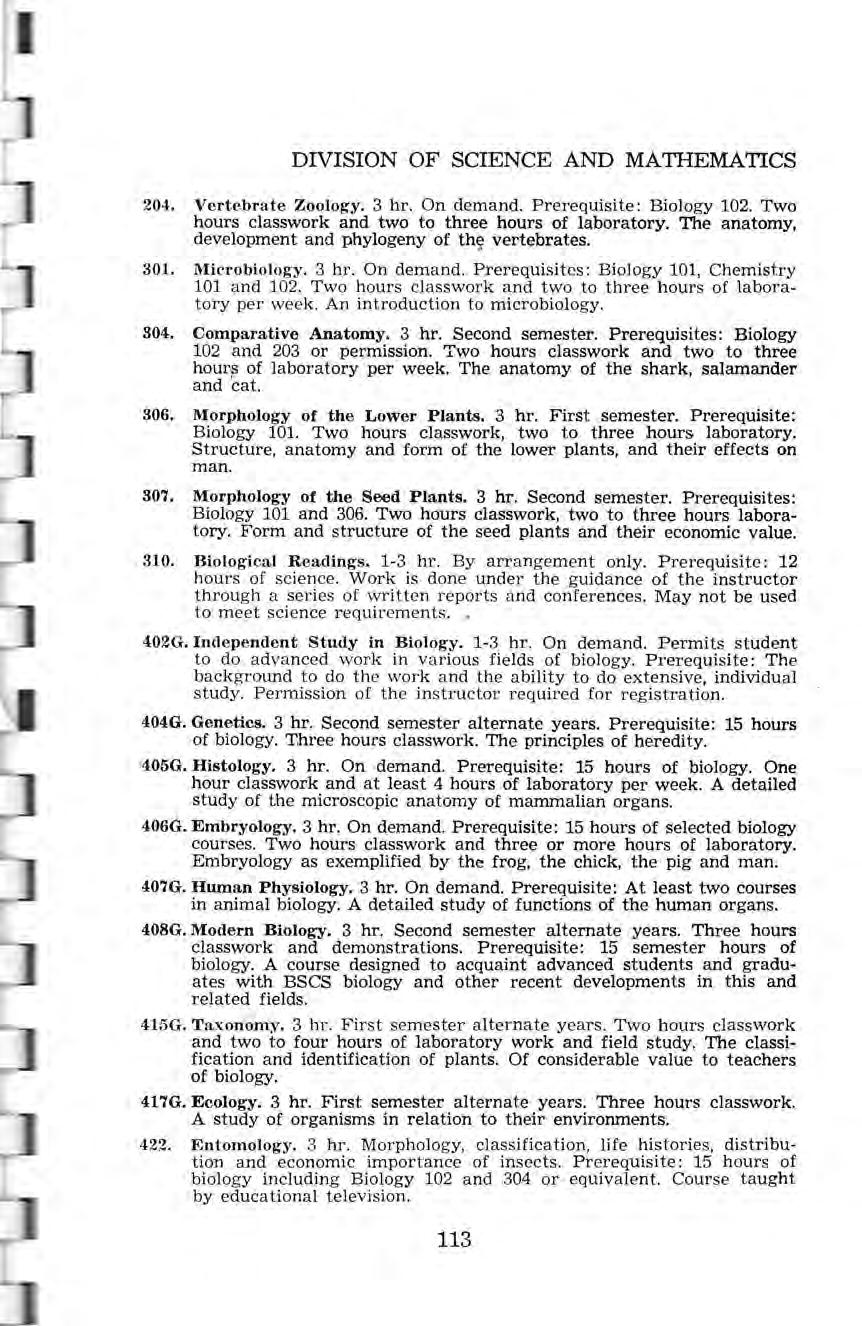
417G. Ecology. 3 hr. First semester alternate years Three hours classwork. A study of organisms in relation to their environments.
422. Entomology. 3 hr Morphology, classification, life histories, distribution and economic importance of insects. Prerequisite: 15 hours of biology including Biology 102 and 304 or equivalent. Course taught by educational television .
Course s in Chemistry are des igned to :
1. Provide preparation for teaching.
2. Provide background for entry into fields in industry a nd the government.
3. Give pre-professional preparation for medicine, dentistry, nursin g, e tc.
4. Provide the n ecessary background for enteril)g graduate s tudy
101. General Chemistry. 5 hr. First semester. Three hours classwork and six hours laboratory. The fundamentals of chemistry. Non-metals and their compounds. For those who have not had high school chemistry.
General Chemistry. 5 hr. Second semester. Prerequisite: Chemistry 101. Three hours classwork, six hours laboratory. Application of the fundamentals of chemistry, metals- and their compounds and an introduction to organic and analytical chemistry.
Principles of Qualitative Analysis. 4 hr. First se mester , alternate years. Prerequisites; Chemistry 102. Two hours classwork, six hour s laboratory. Principles of qu a lit ative a nalysis a nd their app lic at ion in the laboratory.
Principles of Quantitative Analysis. 4 hr. Se~ond semester, alternate years. Prerequisite: Chemistry 205. Two hours classwork, six hours laboratory. Principles of quantitative analysis and their application in the laboratory.
Introductory Organic Chemistry. 3 hr. On demand. Prerequisite: C h em istry 101. Tw o hour s c lasswork, three hour s laboratory. The fundamentals of organic chemistry, covering both aliphatic and aromatic chemistry with emphasis on those phases of the course which may be applicable to nursing and home economics.

303. Organic Chemistry. 4 hr. First semester alternate years. Prerequisite : Chem istry 102 . Three h ours classwork, tlir e e h our s laboratory. Compounds of the , aJiphatic series.
304. Organic Chemistry. 4 hr. Second semester alternate years Prerequisite: Chemistry 303. Three hours of classwork, three hours of laboratory. A continuation of Chemistry 303 with further intensive study of aromatic series, dyes, hormones, vitamins and drugs.
305. Organic Preparations. 2 hr Second semester alternate years. With the consent of the instructor, the student may take extra laboratory work in the synthesis of organic compounds.
308. Biochemistry. 4 hr. On demand. Prerequisites: Chemistry 102, 303, and 304 Two hours classwork, six hours laboratory A prese ntation of the more important facts ci f • bioch e mistry as related to the animal body, with emphasis on the physiological reactions of all food e leme nts and enzymes, a lso digestion, meta bolism and special glandular functions.
309. Biochemistry. 4 hr. On demand. Prerequisites: Chemistry 102, 304 and 308. A continuation of Chemistry 308 dealing with th e chemistry of biological systems.
310. History and Literature of Chemistry, 1-4 hr. By arrangement. Prerequisite: thirteen hours of approved chemistry. The work to be done under the guidance of the instructor through a series of conferences and reports.
812. Physical Chemistry. 3 hr. On demand. Prerequisites: Physics 201 and 202, Chemistry 102 a nd 206. Physical l aws of chemistry and their application in the l aborato ry. Two hours classwork, three hours laboratory.
401. Independent Study in Chemistry. 1-4 hr On dem a nd. Prerequisites: Chemistry 101, 102, 205, 206, 303 an d 304 . A laboratory course in which the student, with the guidance of the advisor, selects and conducts a research project culminating in a prepared p a per .
Courses in Earth Science are designed to:
1. Provide students with a familiarity of their physical environment.
2 . Provide a b ac kground for teaching general science.
3 Provide a background for further study in the field
Er. Sci.
101. Principles of Geography. 3 hr An introductory study of the relationships of man and environment with empha!$is placed upon climatic regions of the world Two hours lectur e, two hours laboratory.

103. Cultural Geography. 3 hr . Th e study of th e cultural elements of landscape with emphasis on the origin of man , migration, settlement and economics of man. Two hours lectur e and two hours laboratory.
201. General Geology. 4 hr . First semester. An introduction to the theories of th e earth's origin, the study of the earth's structure a nd materials with special emphasis on rocks, minerals and landforms. Three hours lecture and two hours laboratory.
210. Physiography of the United States. 4 hr . Prerequisite : Geog. 101 and 103. A regional study of landform provinces with special emphasis on the relationships of landforms, climate, soils, vegetation and mineral resources Three hours lecture and two hours laboratory.
301. Earth Science. 3 hr . Prerequisite: Junior or senior standing, 6 hours of laboratory science. A course dealing with the physical aspects of our environment, including astronomy, climatology, meteorological records and forecasting.
306. Astronomy. 3 hr On demand. An elementary course of value to prospective teachers of general science and mathematics and others who want a broad science experience.
326. Conservation of Natural Resources. 3 hr. An evaluation of soil, water , mineral, forestry, fish, air and recreation resources in order to develop a n appreciation of their importance and the seriousness of the problem. When possible, actual examples will be studied in the field.
404. Independent Study in Earth Science. 1 -3 hr. Junior or senior standing, with adequate preparation in the field and the instructor's permission. Individual in s truction in the techniques of research with either extensive readings a nd reports or a term paper are required.
Courses in General Science are design e d to:
1. Provide the broad background for teaching general courses in scienc e in the elementary a nd secondary schools.
2 . Provide supporting courses for specialization in a specific science .
3 . To provide the broad background for certain vocations where th is training is required.
201. Biological Science. 3 hr. Each semester Two hours classwork and two to three hours of laboratory per week. An integrated course covering the various phases of natural science.
202. Physical Science. 3 hr. Each semester Two hours of classwork and two or three hours of laboratory per week. An integrated course covering the various phases of physical science.
205. The Principles of Biological Science. 3 hr. Each semester. An i ntegrated course specifically design e d for the non-science stud e n t , covering the various phases of man's biotic world, by a variet y of learning ex periences• in· deiilonstrations, experimentation and v isua l aids. Does not apply on, ~he n;i.ajor concentration or support in biology .
206. The Principles of Physical Science. 3 hr. Each semester. An integra ted course specifically designed for the non-science student, covering the various phases of man's physical and chemical world. Experience s in a variety of learning situations, such as demonstrations, experiments , instructional television and other visual aids. Does not apply o n the major concentration or support in physical science.


301. Ea.rth Science. 3 hr. Pr ereq uisite: Junior or senior standing, 6 hours of laboratory science. A course dealing with the physical aspects of our environment, including askonoiny, climatology, meteorology, geology and oceanography
331. Elementary School Science. 3 hr. Three hours attendance Objectives, content and methods of teaching science in the elementary grades.
343. Concepts in Modern Science. 3 hr. A course designed to provide basic information on the recent trends of the various scientific disciplines. Of special value to persons who want to keep abreast of modern developments in science.
476. Methods of Teaching Science and Mathematics. 2 hr. First a,nd second semester. Objectives, content and methods of teaching science and mathematics in the high school.
498G. Process Ai>proach to Science. 3 hr A course d esig ned to dev elop techniqu es in presenting science through b as ic processe s such as time / space relationshi ps , classifying, communicating, predicting hypothesis, experimentation a nd interpretin g d a ta.
499G. Aerospace Science. 3 hr. A workshop designed to provide an understanding of aerospace developments which are vital to our social, economic and political environment.
Courses in Phys ical Science are desi g n e d to:
l. Give the preparation to t eac h both Chemistry and Physics in the schools of the area.
2. Provide the mor e ge ner a l backg round for certain vocations other than tea c hing.
It is recommended that additional work be taken in either Chemistry or Physics to assure admission to graduate study.
Courses in Physics are designed to:
l. Meet the needs of those who will teach Physics.
2 Provide a basis for certain vocations other than teaching
3. Provide a basis for further study in the field.
Phys. 201.
Courses of Instruction
General Physics. 4 hr. First semest e r. Prerequisit e: Mathematics 105. Three hours classwork, three hours l a boratory. Mechanics, sound and heat
General Physics. 4 hr . Second semester. Pr e requisite: Physics 201 or permission Three hours classwork , three hours laboratory. Light, electricity and magnetism.
302. 304-.
Analytical Mechanics. 3 hr Prerequisite : Physics 202 and Math 310. The development of the principles of mechanics by the use of calculus a nd vector a nalysis .
Elements of Optics. 4 hr. Pr e requisite : Physics 202 Three hours classwork, three hours laboratory Geometrical optics, physical optics, quantum optic s , optic a l instruments, and polariz a tion .
805. Solid State Physics. 3 hr. Prerequisite: Physics 201 Three hours classwork. Crystalography, defects of metallic crystals, specific heats, semiconductors, band theory, luminescence, color centers, conductivity, mechanical properties and alkaline metals.
306. Astronomy. 3 hr. On demand. A basic course dealing with a study of the heavenly bodies, the solar system and the universe. Telescopic observation is a part of this course. Of considerable value to science teachers.
307. Introduction to Modern Physics. 4 hr. Prerequisites: Physics 202 and Ch e mistry 101. Three hours classwork, three hours la bor a tory. Atomic and nuclear relativity, Bohr atom theory, quantum theory, X-rays, nuclear instrum e nts, radioactivity, nuclear reactions ,and element a ry particles.
•
810. History and Literature of Physics. 1-2 hr Each semester and summer. By arrangement. Work to be done under the guidance of the instructor through a series of reports and conferences.
328. Electronics. See I. A. 328. Prerequisite : Physics 202.
341. Electromagnetic Theory: 3 hr. Prerequisite : Physics 202 and Math 309. Electric and magnetic theory, wave propagation, A.C. a nd D.C. circuit theory, magnetic induction, dielectrics, Gauss' law, and Maxwell's equations.
400. Thermodynamics. 3 hr . Prerequisite: 15 hours of physics and Math 310._ A study of temp e rature a nd thermometry, the laws of thermodynamics and their applications and an introduction to kin e tic theory.
401. Independent Study in Physics. 1-3 hr. Individual projects of a laboratory a nd ~ibrary n a ture for qualifi e d physics students. By spe cial p e rmission only.
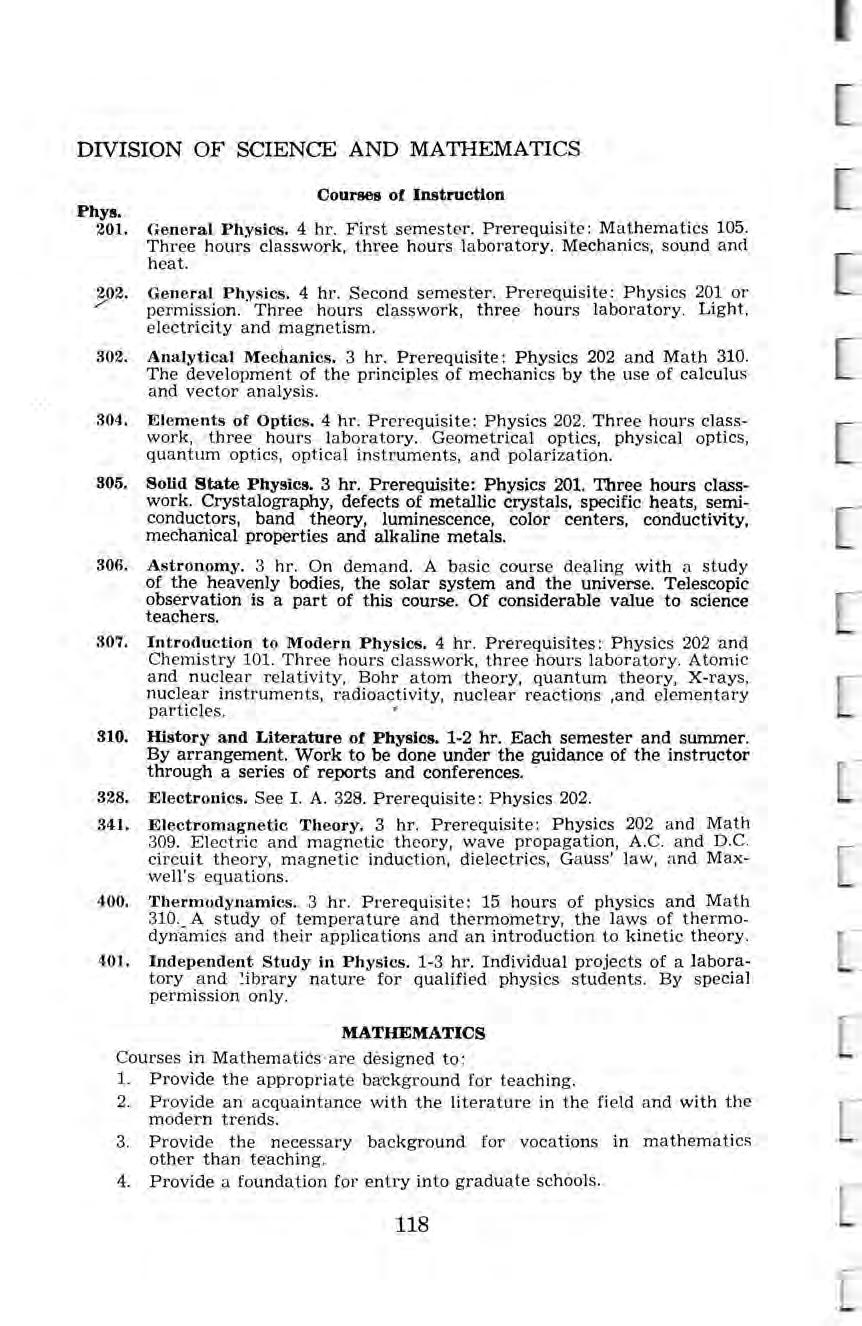
Courses in Mathematics a re de si g ned to:
1 Provide the appropriate ba'C kground for teaching.
2. Provide an acquaintance with the literature in the fi eld a nd with the modern tr e nds.
3. Provide the n e cessary background for vocations in mathematics other than teaching.
4. Provide a foundation for entry into gradu a te schools.
Math.
100. Basic Mathematics. 3 hr. Each term. R equired of all students who are deficient in basic mathematical skills as revealed by a standa rdized test , given during the fre shman year. The course take s up the fund a m e nt al processes including algebra and the application thereof; do es not apply in m a th ematics field of concen t ration ·

101. College Algebra. 3 hr . First semester. Prerequisite : one year of high school algebra. For term inal students or thos e who specifically ne e d al gebra in certain pre-professional programs. Fundamental a lg ebraic pr in cipl es a nd s u bseq ue nt a lge bra ic processes. Thi s co u rse n ot to be ta k e n for cre dit b y st ud e n ts w h o have co mpl e t ed Ma th . 105 .
104. S lide Rul e a ncl Lo ga rithms. 2 br. Fir s t se m e st er. T w o h ou rs pe r wee k. This cou rse g iv es t h e s tud en t s kUJ in t h e us e of t h e s lid e rul e a n d l oga rithm s . Rec omm e nd e d for s ci e nce m a jo rs.
105. Fundamentals of Mathematics . 5 hr. First semester. A course intended for the student who plans to pursue a college program requiring a substantial amount of training in mathematics The content of this course includes an introduction to symbolic logic and set theory of applications, a study of th e number system, elementary theory of groups and fi elds, an introdu c tion to the function concept and study of algebraic functions Various aspects of mathematics are combined to make it practical in solving modern problems.
106. Fundamenta ls of Mathematics . 5 °hr. Second semester. Prerequisite : Math 105 Content includes the study of trigonometric, exponential and logarithmic functions, and introduction to analytic geometry and some calculus.
200. Ba s ic Con ce pts of Mat h e matics . 3 hr . Se cond se m es ter a n d s ummer . An introdu ction t o t h e va ri ou s num ber ba se s a nd the d evelopment of conc ept s fund a m e nt a l to eac h. Oth er topic s included a r e: e l ement a ry s e t th eor y, a lge bra, geom e t r y a n d p robl em s r e l a t e d t o t h e fi e l d of busin ess ; d oes n ot app ly o n t h e m at h e m a tic s fi e ld of c onc e nt ra tion
218. Surveying. 2 hr. On demand . Prerequisites: Mathem a tics 105 and 106 or equivalent. Two hours classwork, six hours of field work during first quarter. Fundamental theory and practice, use of transit, U . S . Public Land Surveys and field office work.
800. Algebraic ~nd Geometrical Conce pts. 3 h r. S ummer. Prerequisite: Math . 200 or permission A course dealin g w ith algebraic and geometrical concepts. Specific topics include: logic, sets, positive and negative numbers, equations and inequalities. Geometric phases include : Measurements, space, plane, line and properties of such closed curves as the triangle, rectangl e and circle as well as other figures with their properties developed intuitively; does not apply on the m a th ematics field of concentration grades 9-12.
304. Modern Geometry. 3 hr. First semester. Pr e requisite : 10 hours of m a thematics. A course designed primarily to prepare mathematics t e achers for de a lin g with a modern hi g h school mathematics program A point s e t appro a ch to g eometry.
305. Statistics. 3 hr. First semester. A study of the approach to and the tools needed for dealing with the collection, analysis, interpretation and presentation of data. Highly recommended for those who expect to enter graduate school. Students in non-mathematical fields consult with advisors.
309. Calculus with Analytic Geometry. 5 hr. First semester. Prerequisites: Math. 105 and 106 or equivalent. The course includes the study of analytic geometry, functions, limits, continuity, velocity, differentiation, inverse of differentiation, second derivatives, maxima and minima, as well as other related topics.
310. Calculus with Analytic Geometry. 5 hr. Second semester. Prerequisite: Math. 309 or equivalent Topics include trigonometric functions, antiderivatives, the definite integral, three-dimensional figures, translation and rotation, exponential functions, hyperbolic functions, integration, polar coordinates and related topics.
311. Ind e pende nt Study in Mathematics. 1-2 hr. Prerequisite: 15 hours in math e m a tics . By p e rmission only . Special assignments, projects a nd r ea din g to be arran ge d .
312. Calculus III. 3 hr. S econd sem e ster. Prerequisites: Math. 309 a nd 310 or equivalent. Desi g n ed to give th e student a review of c a lculu s a nd a pplyin g it to compl e x probl e ms in mathematics .
342 Concepts and Techniques •of Modern Mathematics. 3 hr On demand
Prerequisite: Math. 200 or permission. A seminar course designed to give basic information in the teaching of modern mathematics in the el e mentary schools and to incorporate the latest concepts and techniques in this instruction. This course does not apply toward mathematics specialization at the secondary level and is open only to those who are pursuing an elementary program.
406. Modern Algebra. 3 hr. First semester. Prerequisites: Math 105, 106, 309 and 310 or equivalent. A study of various algebraic systems arising in mod e rn mathematical computations Content includes a study of sets, m a ppings and operations, relations, development of real numbers systems, integral domains and fields, polynomial domains and complex number field.
407. Modern Algebra. 3 hr. Second semester. Continuation of Math 406. A study of groups, vector spaces, linear transformations and matrices, lin e ar equa tions and determinants, linear algebras, rings and Boolean algebras.
416. Differential Equations. 3 hr. Alternate years. Consult mathematics dep a rtment. Formation of differential equations, equations of high order, lin e ar equation with constant and variable co-efficients, partial differ e ntiation, application of geometry, mechanics and physics. Student must have proficiency ·1n calculus .

418G. Lin e ar Alge bra. Alterrl ate y e ars. The th e ory of linear transformation s in ve cto r s p a ce s, the represent a tion of line a r s p a ces in matric e s , linea r functi o nals, a nd th e a pplic a tion of these concepts
419G. Topology. 3 hr. Second semester. A modern treatment of topology with emphasis on fundamental concepts and principal results of homology theory, topological spaces, linear graphs, set theory, metric interpretation a s well as other related topics.
January 17, 1969
Agnew, Robert
Dodge , Donald Allen
Joy, Maureen Ann
May 25 ; 1969
Willcoxon,
, Procaccini, Ralph Anthony
· Kramer, David Paul
Sherburne , Doris Jean W a yne William, Jr.
August 8, 1969
Brigham, David A. -
Janua:ry 17, 1969
Agnew, Robert
Finchem, Doris Maree
Hutchings, Terrance Monroe
May 25, 1969
Aylor, Larry A.
Bartels, Lorin L .
Bernadt, John Ray
Brown, Billie D.
Budler, Mary Ann
Castle, Micha el L e n
Dodge, Donald Allen
Everhart, William R.
Feit, Eugene D.
Hamer, Carolyn Christopher
Herbster, Philip L .
Hitch, Mary Jean
Horel, Paul L.
Johnson, Daniel N.
Schumaker, Roger Donn
S:mith, Albert
W e bster, John Anthony
· Kelly, Robert L .
Koch, D a niel L.
Linder, Richard •;William
Miller, Wayne J.
Norman, Anita Louise
Patterson , Robert Donald
Reed; D a niel C .
R,_einders, Gregory L.
Shilts, Jimmie L.
Steiner, R. Mark
Swantek, David L .
Vanderford, John M.
Waltke , James L.
Willcoxon, Wayne WiUiam, Jr.
Woods, George K., Jr. ·
August 8, 1969
Allison, Ted Michael Miles, Virginia Isabel
Austin, William John
Sorensen, Larry E.
Zumbahlen, David Francis
January 17, 1969
Brodersen, Steve Wayne Cleveland, James D
Butts, James N. Wolken, S heryl Floyd
May 25, 1969
Allen, Gerald J.
Appleoff, Mildred Hinton
Baker, James Gilbert
Bliss, Caroline Rose Ann
August 8, 1969
Carnes, K;~nneth
Shelton, Richard Lee
Topolski, Francis M. Vokt, Dan L .
Burr, Alan Eugene
January 17, 1969
Aistrope, William W.
B a les , Richard M ., Jr.
Jobe, Jerry Alar.
Jones, William Robert
LaMontagne, David Lee
Smith, Samuel J. Wehrbein, Gerhart J. 121
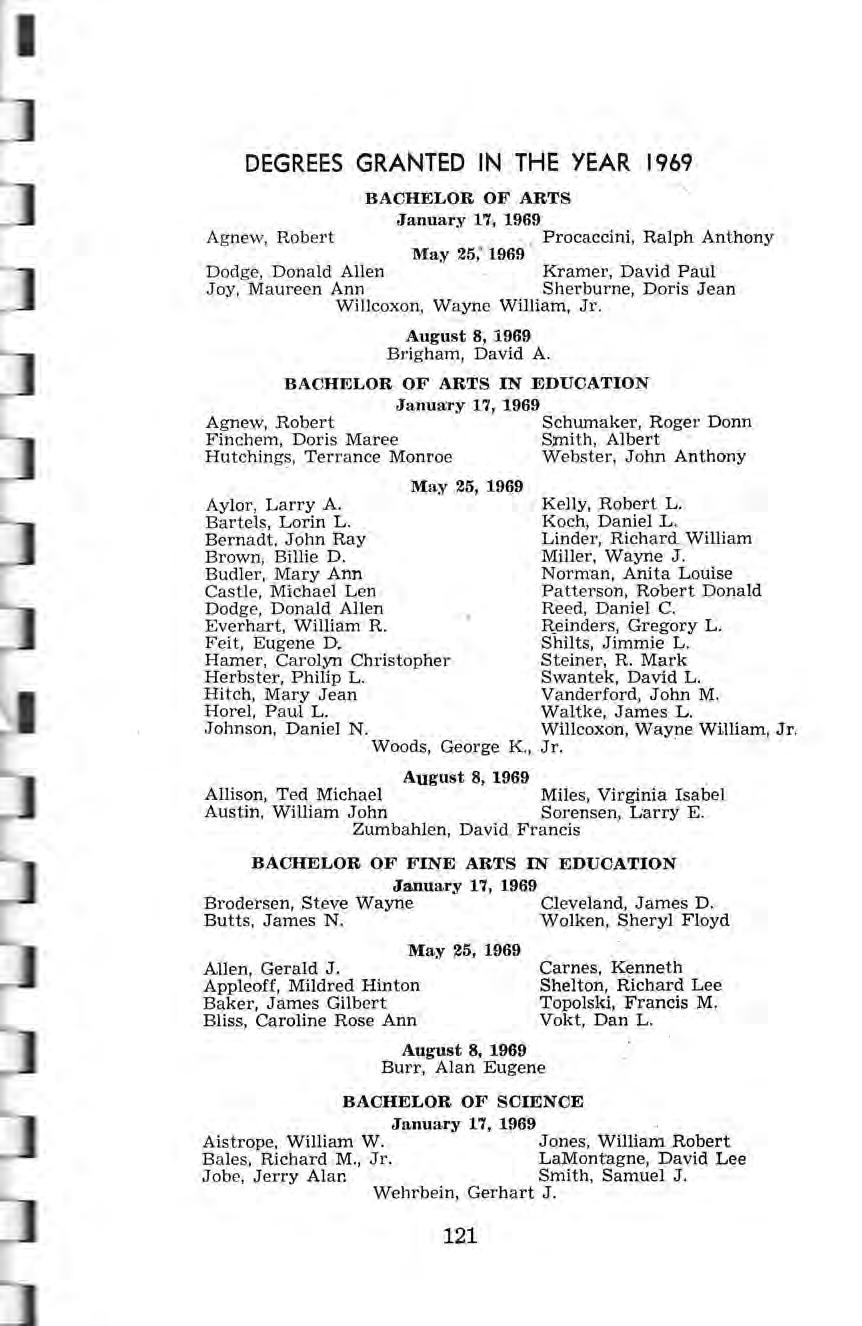
BACHELOR OF SCIENCE
May 25, 1969
Arnold, Charles Jay
Buchheit, John Peter
Burch, John W.
Cappel, Robert Lewis
Choung, Moo Young
Derrick, Barbara
Flannery, Rich a rd Paul
Hutchens, Larry Ray
McNew, Garry Bealdon
Meyer, John F.
Clark, James Edward
Hutson, James Chelton
Irwin, Michael Charles
August 8, 1969
Miller, Lynn H.
Racine, Willi a m Elmer
Reineke, Leslie Charl es, Jr
Retchless, Kenneth E.
Rowe , J a me s Ray
Schoenrock, Gary D.
Shipm a n, Lawr e nce Ray
Torpy , John Patrick
Townsend, P er ry Jay
Van Scyoc, Gary Lyl e
Kelly, Karlynn A.
Rabid ea u, De a n Paul
Smith, Richard Bryan
BACHELOR OF SCIENCE IN EDUCATION
January 17, 1969
Ahlin, Gary M.
O es tmann, Duey L.
Anderson, Carolyn Kay Pendergraft. Ronald L.
Anderson, Richard W a lter
Bohling, Patsy E.

Carbone, Rich a rd John
Cooper, Faye E.
Corwin, Edward Winston
Dietrich, Connie H
Fine, Ronald Douglas
Petsche, Terry Llynn
Rains , Cheryl Anne Seibert
Robert s, Donald Bruce
Roder, Larry Lee
Romick, Thomas Mich ae l
Schneider, Jan et Kay
Schuetz, Betty Jean
Glynn, Je a n Katherine Richardson
Haws, Cl a rence W., Jr.
Sears, Janice Elaine Wheeldon
Jobe, Jerry Alan Sears, Russell Lee, Jr
Kiekha efe r, P at ricia Ann
Kleveland, James D.
Lenker, Janene Ann
Slick, Walter Ritchey, Jr.
Sugden, Marilyn Kay
Turn e r, Rand a ll Jay
Maloy, Viola Watson, Jam es Howard
Marcusson, Larry Kenneth
Massoth, Alice Marie
McVicker, Virginia Mullen
Windels, Doris E.
Webb, Jane Maria
Wendt, Mark B.
White, Ann Marlene
BACHELOR OF SCIENCE IN EDUCATION
May 25, 1969
Achtemeier, Karen Kay
Anderson , Steven R.
Bedette, Linda K.
Bednar, Oren Lee
Benson, Shirley Jean
Bleich , Roy A.
Boatman, Judy Lee
Bohling, Lorin J. ,
Brettmann, Dwayne Ray
Bures, John E
Collingham, Diana Lynn
Copas, Kathleen Sue
Creamer, John Joseph
Crum, Nancy Lee Schulenberg
Dewey, Joyce Ann
DiCes a re , Robert Paul
Dieckhoff, Linda
Dodd, Marlene 'Ruth
Dorste, Kent L.
Eberhard, Renee Cerell a
Egger, Margar e t Ann
Eickhoff, Gerald L.
Engelman, Marjorie Kay
Everh ar t , Mary Straight
Givehand, J a ne Louis e
Grable, Roger W.
Grebert, Nancy Lorene
Greathouse, G. Carol
May 25, f969
Giwoyna, Carla Mae
Gyhra, Frances A .
Harpster, Patsy A .
Hays, Charles Coburn
Henderson, Larry L.
Hitzemann, LaVelle E
Hl a vac, Leslie Harold
Hoffman, E. Colene
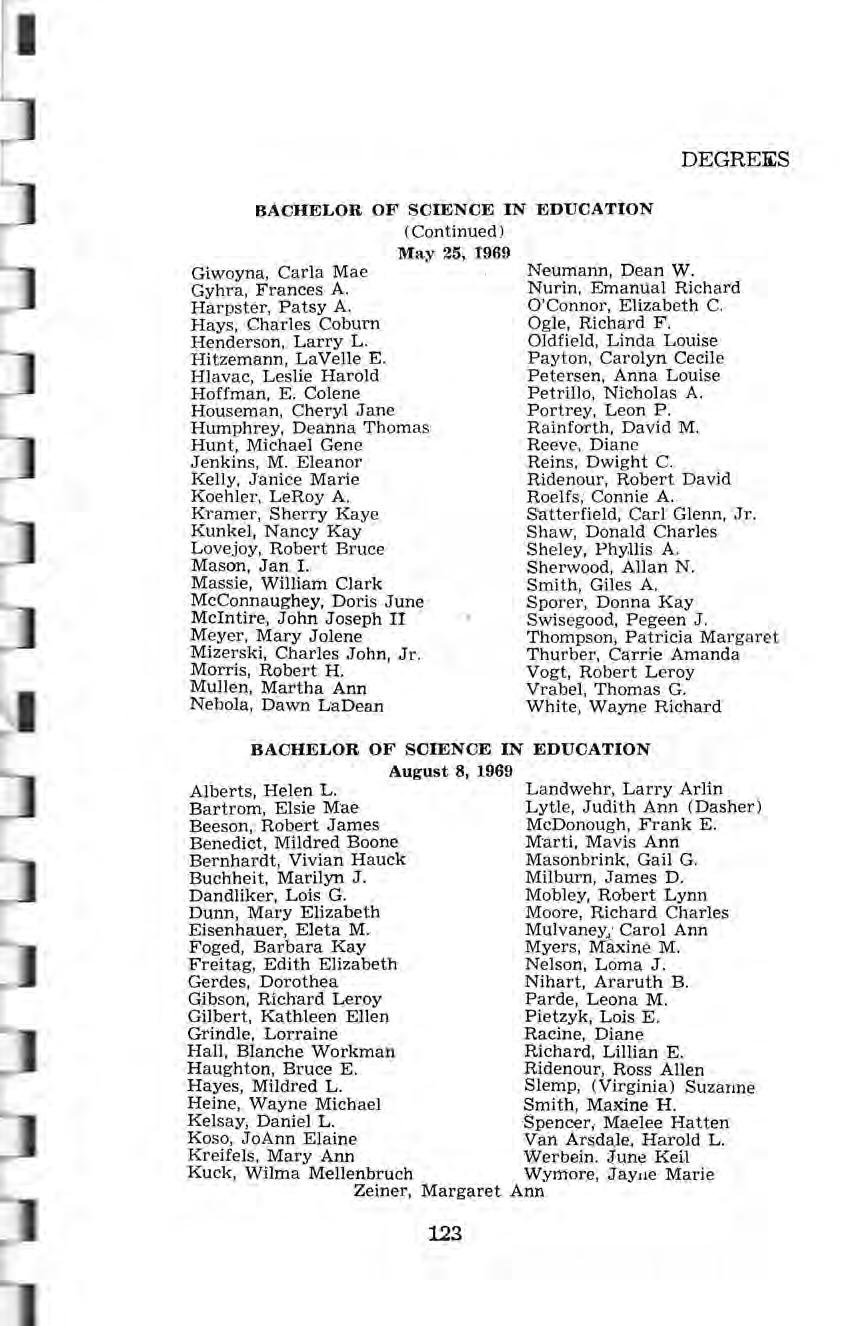
Housem a n, Cheryl Jane
Humphrey, Deanna Thom a s
Hunt, Michael Gene
Jenkins , M. Eleanor
Kelly, Janice Marie
Koehler, LeRoy A
Kramer, Sherry Kaye
Kunkel, Nancy Kay
Lovejoy, Robert Bruce
Mason, Jan I.
Massie, William Clark
Mcconnaughey, Doris June
McIntire, John Joseph II
Meyer, Mary Jolene
Mizerski, Charles John, Jr.
Morris, Robert H.
Mullen, Martha Ann
Nebola, Dawn LaDean
.Neumann, Dean W.
Nurin, Emanual Richard
O'Connor, Elizabeth C.
Ogle, Richard F.
Oldfield, Linda Louise
Payton, Carolyn Cecile
Petersen, Anna Louise
Petrillo, Nicholas A.
Portrey, Leon P
Rainforth, David M.
Reeve, Diane
Reins, Dwight C.
Ride nour, Rob e rt David
Roelfs ; Connie A.
Satterfield, Carl Glenn, Jr.
Shaw, Donald Charles
Sheley, Phy.llis A
Sherwood, Allan N.
Smith, Giles A .
Sporer, Donna Kay
Swisegood, Pegeen J
Thompson, Patricia Margaret
Thurber , Carrie Amanda
Vogt, Robert Leroy
Vrabel, Thomas G.
White, Wayne Richard
August 8, 1969
Alberts, Helen L
Bartram, Elsie Mae
Beeson, Robert James
Benedict, Mildred Boone
Bernhardt, Vivian Hauck
Buchheit, Marilyn J .
Dandliker, Lois G.
Dunn, Mary Elizabeth
Eisenhauer, Eleta M.
Foged, Barbara Kay
Freitag, Edith Elizabeth
Gerdes, Dorothea
Gibson, Richard Leroy
Gilbert, Kathleen Ellen
Grindle, Lorraine
Hall, Blanche Workman
Haughton, Bruce E.
Hayes, Mildred L.
Heine, Wayne Michael
Kelsay, Daniel L.
Koso, JoAnn Elaine
Kreifels, Mary Ann
Kuck, Wilma Mellenbruch
Landwehr , Larry Arlin
Lytle, Judith Ann (Dasher)
McDonough, Frank E.
Marti, Mavis Ann
Masonbrink, Gail G.
Milburn, James D.
Mobley, Robert Lynn
Moore, Richard Charles
Mulvaney; Carol Ann
Myers, Maxine M.
Nelson, Loma J.
Nihart, Araruth B.
Parde, Leona M
Pietzyk, Lois E.
Racine, Diane
Richard, Lillian E.
Ridenour, Ross Allen
Slemp, (Virginia) Suzanne
Smith, Maxine H.
Spencer, Maelee Hatten
Van An1da.le , Harold L.
Werbein. June Keil
Wymore, Jay;1e Marie
Zeiner, Margaret Ann

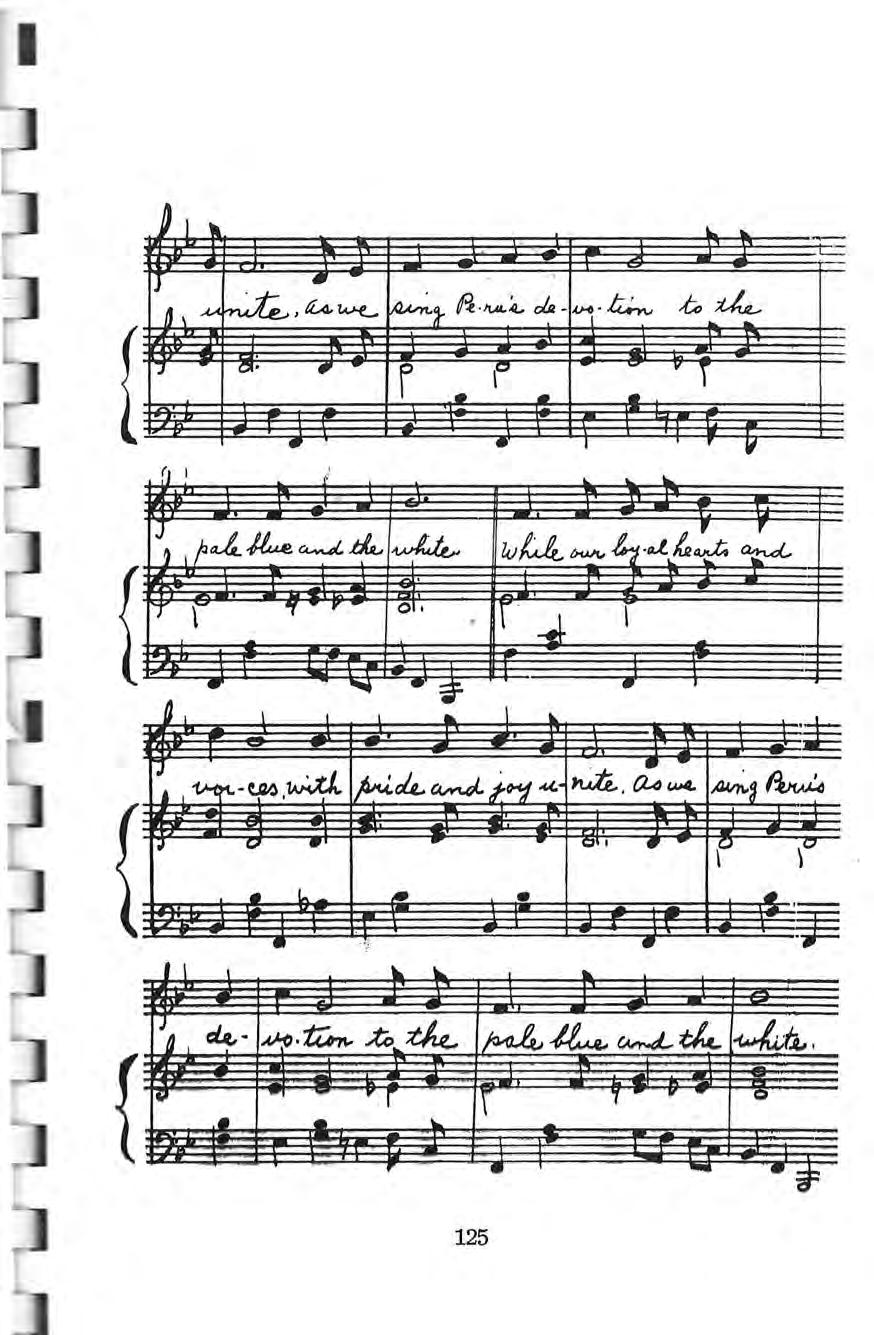
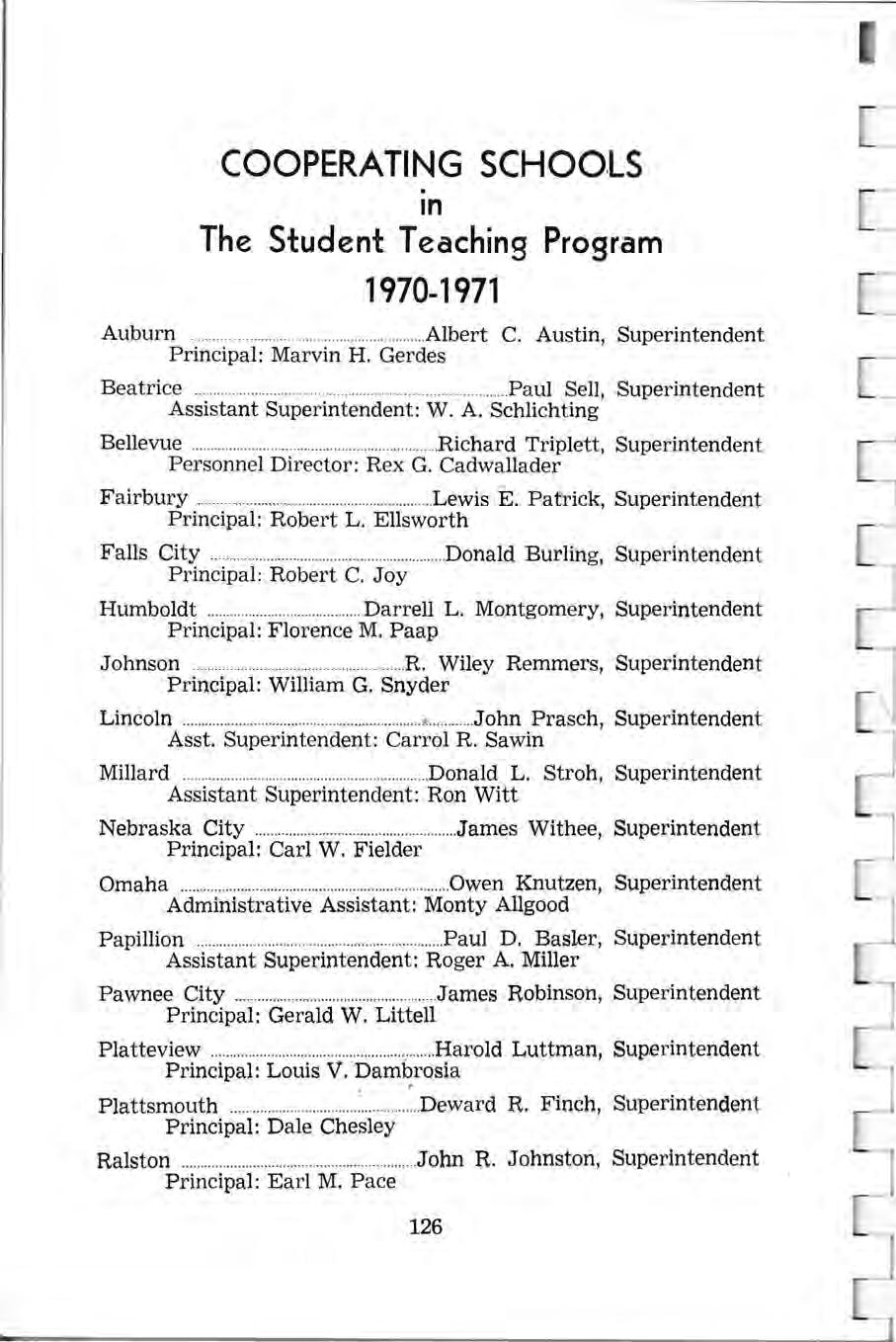
Auburn ....... .... ..... ....... ........ ..... .. .. ... .. ......... .... .. ...Albert C. Austin, Superintendent
Principal: Marvin H. Gerdes
Beatric e .... .. .... ..... ......... .... .. ...... .... .......... Paul Sell, Superintendent
Assi stant Superintendent: W. A. Schlichting
Bellevue ................ ................ ... ........ .. ..... .............. Richard Triplett, Superintendent
P ersonnel Director: Rex G. Cadwallader --,
Fairbury . . ..... ... ... .... ...... ........ .......... ..Lewis E . Patrick, Superintendent
Principal: Robert L. Ellsworth
Falls City ...... .. ..... . ........ .. ..... . ................. ..Donald Burling, Superintendent
Principal: Robert C. Joy
Humboldt ................... ... ....... .......... Darrell L. Montgomery, Superintendent
Principal: Florence M. Paap
Johnson R. Wiley Remmers, Superintendent
Principal: William G. Snyder
Lincoln ........................ .. ................................. P.... John Prasch, Superintendent
Asst. Superintendent: Carrol R. Sawin
Millard . .... ... ..... .... ... ... ........ .... ... ........ Donald L. Stroh, Superintendent
Assistant Superintendent: Ron Witt
Nebraska City ......................................... ..James Withee, Superintendent
Principal: Carl W. Fielder
Omaha ....... .. ........... .. ............... ... .... ............... ........ Owen Knutzen, Superintendent
Administrative Assistant: Monty Allgood
Papillion Paul D Basler, Superintendent
Assistant Superintendent: Roger A. Miller
Pawnee City James Robinson, Superintendent
Principal: Gerald W. Littell
Platteview ........ . .......... ................ .. .. ... ............Harold Luttman, Superintendent
Principal: Louis V.I)am~rosia
Plattsmouth · : : Deward R. Finch, Superintendent
Principal: Dale Chesley
Ralston .. .. .. ........ .... ..... .... ............... .. .. ............. John R. Johnston, Superintendent
Principal: Earl M. Pace
Southea s t Nebraska ... .... ......... .. . . Wayne Cash, Superintendent
Principal: William Bohlken .
Sycracuse .. ..... ... . ............... .. .... .. . .. Dopald V'{. Craig, Superintendent
Principal: John Rhodus
Tecumseh ... .. Merle J. Beck, Superintendent
Principal: Virgil Blumhorst
Westside . ... .Vaughn G. Phelps, Superintendent
Asst . Superintendent: Robert M. Adams
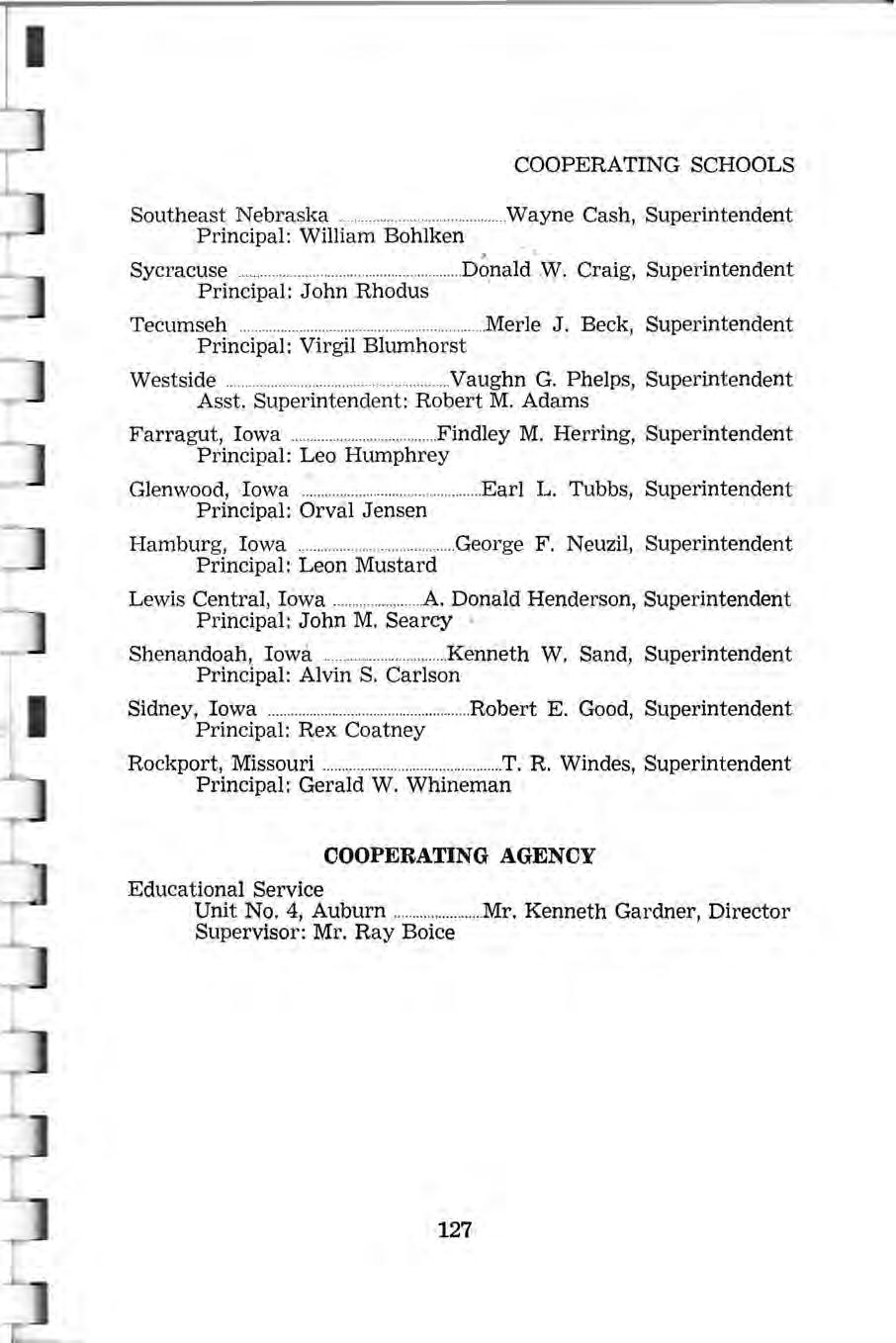
Farragut, Iowa . ....... .. . . .... Findley M. Herring, Superintendent
Principal: Leo Humphrey
Glenwood, Iowa .......... .. ............ ......... ...... Earl L . Tubbs, Superintendent
Principal: Orval Jensen
Hamburg, Iowa ........... ... ........... George F. Neuzil, Superintendent
Principal: Leon Mustard
Lewis Central, Iowa .. .... ..... .... ..... A. Donald Henderson, Superintendent
Principal: John M. Searcy •
Shenandoah, Iowa ..... ....................... Kenneth W. Sand, Superintendent
Principal: Alvin S. Carlson
Sidney, Iowa ............................... .... .............. ... Robert E. Good, Superintendent
Principal: Rex Coatney
Rockport, Missouri ...... ...... .. .... ............ ... ...... ... ....T. R. Windes, Superintendent
Principal: Gerald W. Whineman
Educational Service Unit No. 4, Auburn .... .............. .. ... Mr. Kenneth Gardner, Director
Supervisor: Mr. Ray Boice



